In some ways, making a magazine today is easier than ever. The internet puts free information at everyone’s fingertips, all instantly available through mobile devices. What’s more, every person online has the opportunity to create high-quality content if they so choose. From free magazine templates to stock image libraries, there are more options than ever. Still, there’s more to making a successful magazine than simply putting images and text together. In this step by step guide, we’ll explain how to make a magazine that will not only showcase your brand in the best light, but keep your audience hooked.
How to make a magazine in 16 steps
In this resource, we’ll walk you through the work that happens before, during and after production. The first stage is brainstorming, followed by creation and collaboration, and finally, distribution. There’s a lot to cover (no pun intended), so let’s dive in.
Before production: Brainstorming
1. Developing your business plan
Before you write a single word for your magazine, you’ll want to sit down and create a game plan. This includes your mission (the reason why your magazine should exist), your overall goals, and how you’ll attain them.
Here are some of the most important questions to consider
- What is the concept or focus of your magazine? This should be brief and concise, like an elevator pitch. For example, take a look at this copy from TIME’s “About” page:
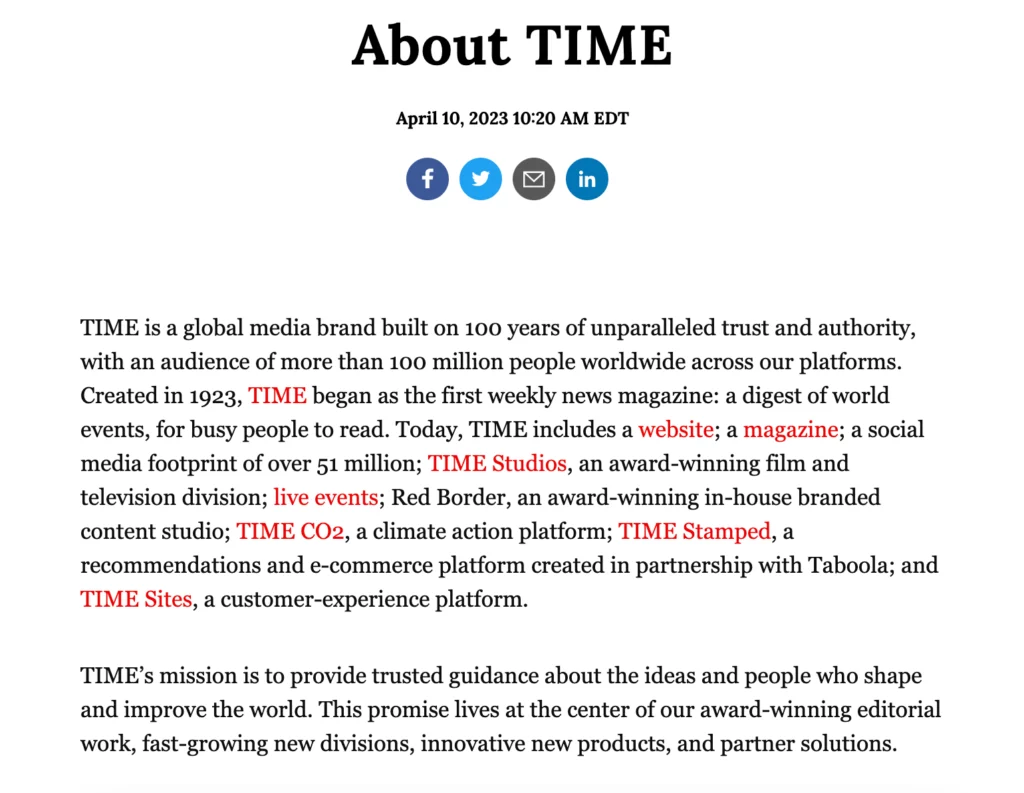
While their brand has ballooned over the past 100 years, their commitment to “unparalleled trust and authority” remains the cornerstone of the TIME brand today. And while your aspirations might not be as grand as TIME Magazine, it’s important to nail down the ‘why’ behind your publication.
- Which topics will you cover, and in what depth? You can’t have a magazine without a subject. Think about your area of expertise and the audience you’re aiming for. Whether you’re putting together a catalog showcasing handmade jewelry, or a glossy magazine with lush photography for your state’s tourism board, you need a clear, unifying topic.
- Consider your tone & voice—there is a big difference between The New Yorker and OK! Magazine. Consider your ideal audience and what they might resonate with. Also consider your topic. A university magazine might have more leeway to be less formal than say, a science publication.
- Will your magazine by physical or digital (or both)? While the thought of holding something physical in your hands may sound appealing, consider the cost of printing a physical magazine. Even if you’re a well-established brand, the vast majority of your audience will have access to the internet and will be able to easily access a digital magazine. Again, consider your audience, the purpose of your publication, and how much you’ll willing to invest in it.
Pros of physical magazines:
- Ability to add full page advertisements and inserts
- Limited stock could make your publication more valuable
- Tactile reading experience
Cons of physical magazines:
- High upfront cost
- Bigger carbon footprint
- Readership is limited to how many copies printed
Pros of digital magazines:
- Free or low-cost
- Accessible to a wider audience
- Can include immersive elements such as scrolling text or video
Cons of digital magazines:
- Less advertising potential
- More competition
Here are a few more questions to ask yourself:
- Who is the primary audience? Your magazine should speak to others, not just yourself. It’s also important that your audience has a “continuing need” for your content, so they’ll want to subscribe and read more. Think about your audience’s lifestyle, and cater to the issues and ideas they care about.
- What’s your title? Once you’ve thought about these other questions in depth, it’s time to start brainstorming titles. Our advice? Keep it short, simple, and relevant to your purpose/topic.
- How will the first issue be funded? Many magazines earn profit by selling advertising, but it can be hard to attract advertisers at first. Depending on your situation, we might suggest using personal capital to fund the first issue—raised by saving money, seeking investments, or crowdfunding.
2. Research the landscape
There are a lot of magazines out there (both online and in print). Spend some time exploring some publications that you’d like to emulate, and get an idea of any potential competition. This will give you a better idea of what’s already being covered and how you can differentiate your publication. Taking stock of your competition can also reveal any gaps and opportunities that are currently not being met in the market, which you can use to your advantage as you develop your concept.
Now’s also the time to dive deeper into your target audience. Are most publications in your niche print or digital? Consider the ways you can add more value for your intended readers.
If you’re interested in making a digital magazine, we recommend adding keyword analysis to your competitive research. Working with an SEO tool will help you find out what keywords and topics your competitors are ranking for, and can reveal gaps you can take advantage of in your own content.
3. Build your team
A magazine isn’t something you should undertake alone. Building a trustworthy team and dividing your workload will help you create faster, better results – with much less risk of burnout. The stronger your team, the stronger your magazine will be. Here are a few staff roles you might want to consider.
- Writers — Magazines are driven by great content, so of course you’ll need great writers to make it work. Depenging on the size and scope of your magazine, you might opt to keep things in-house or reach out to freelancers to submit pitches. Either way, be clear with writers about your editorial expectations and whether you’re offering any compensation for their work.
- Editor — At the end of the line, there should be one pair of eyes to give each piece of content the final yay or nay. A head editor ensures consistency and quality by reinforcing your editorial standards. This includes tone of voice, grammar, mechanics, and even the reach and scope of each article. When you have a strong editor at the helm, the finished magazine will be polished and cohesive.
- Sales manager — If your magazine will feature advertisements, a sales manager is indispensable. This person will serve as the point-of-contact for advertisers who will pay for space in your magazine. Having one person available to address their questions and concerns will help you build a better relationship with them, leading to higher, more sustainable profits.
- Marketing manager — Your magazine needs advertising too! A marketing manager will work to get attention for your magazine, making sure it’s present in all the right places. For example, If you’re launching a magazine in print, you’ll need distributors in bookstores, newsstands, and other public places. If you’re launching online, there are many channels for you to explore, from search engine ads to social media. Part of this person’s responsibilities will be deciding which distributors and channels are best for your magazine, and then creating materials like press kits and promotional content to support them.
- Publication manager — This is someone who gets down to the nitty-gritty of publication. This person will help you choose a printing partner who meets your needs, both in terms of quality and budget. What will the paper cost? How do the colors look? Are there any errors in the finished product? A publication manager will focus on these seemingly minor details that, in reality, make a huge difference when you’re creating a magazine.
- Partnerships / groups — These are helpful connections who aren’t necessarily part of your team, but can steer you in the right direction. Partnering with relevant brands that share a similar audience to you can bring more exposure. Additionally, you can find groups made up of local or indie magazines online to share advice and opportunities with one another.
During production: Creation & collaboration
Here’s where we get to the exciting stuff. Don’t get us wrong – this can be a very hectic time, but it’s where the real magic happens. If you’re inspired to make your own magazine, you’re likely familiar with the following steps—but let’s review them anyway.
4. Designing your masthead
Your magazine’s ‘brand’ is defined by its masthead. Think of Time, Vogue, and National Geographic, all publications with iconic, recognizeable mastheads. These publications use serif fonts. On the flip side, magazines like Billboard, GQ, and Glamour use sans serif fonts. Consistently using the same typeface issue after issue builds a consistent brand, while your designers can play with the color of the text to match the cover image.
5. Writing articles
Finally, time to create articles and stories for your magazine. Depending on your concept, this might mean a few different things: fiction or non-fiction, short stories, journalistic articles, how-to guides, reviews, or even a blend of all of the above. This step encompasses the writing process, from conception to pitch, and from researching to drafting.
When you’re planning each issue, you’ll also want to choose an attention-grabbing cover article. This is the ‘main event’, and will often be the story or feature readers are most excited about.

Take this cover story from the Rochester Institute of Technology’s campus magazine for example. “You do what?” is an attention-grabbing headline for this inside look into some of the most interesting careers RIT alums have – a cover story most students and parents would be very interested in reading.
Once you’ve written all of your articles for an issue, don’t forget to add a table of contents so readers can easily find what they’re looking for.
6. Editing
It’s not uncommon for articles to undergo more than one round of revisions. Far more than just catching style and grammar mistakes, editing will help the writer focus and elevate their writing. Editors can help with fact-checking as well. Together, writers and editors cooperate to make an article the best it can be.
7. Proofreading
After an article has been written and edited, careful proofreading is required to ensure quality and accuracy. Any typos or errors that made their way through the writing process will be squashed here. Unlike editing, proofreading is not an evaluation of the article’s style, tone, organization or effectiveness. The focus is solely on finding and eliminating errors, so the finished product reads professionally. The person who proofreads might very well be the editor too, but these are still two separate stages of production.
8. Graphic Design
The way we enjoy magazines is different from how we consume a book or a newspaper. Although each of these publications provides information, magazines in particular are known for being visual. From elegantly gorgeous to colorfully flashy, magazine design runs the gamut.

In the name of consistency, you’ll want to decide early on whether you want your graphic/cover design to lean more toward imagery or information – or a blend of both as pictured here.
Your graphic designer is just as responsible for your magazine’s tone and feel as your writers are—if not more so. It’s important for your graphics to match your words. Browse these magazine design templates for some inspiration.
9. Photography
Stock photos are okay here and there, but they’re no substitute for custom photography. Rather than searching for pictures to match your vision (and potentially settling for less), a photographer can work with you to capture the pictures you really want. Color, lighting, subject, quality… All of these photo elements contribute to the reader’s perception of your brand. After all, that’s why they say a picture is worth a thousand words. (Or, at least, it’s why we say it.)
10. Build out your back page
If you’re including advertisements in your magazine, a back page is a must. Among wide-circulation magazines, the back page is often a full-page advertisement – one that companies pay a lot of money to be featured in. When you’re designing each issue, don’t forget to leave room for this important page.
11. Make a prototype
Just like with any product, you can’t mass produce until you have a definitive, finalized version. All of the content, words and images must be firmly locked into place with no errors or further changes. Holding your first finished prototype (whether in your hand or on a tablet) is a proud moment. Savor it! You’ve put in a lot of work to get here, and there’s still work to be done. You are now ready to start sharing your magazine with the world.
12. Digitize
Regardless of where/how you’ve designed your magazine, you want to triple check that your digital file is ready to distribute. Different publishers and reading apps have their own standards in terms of file type, size, quality and so on. Make sure you’ve researched and complied with those standards in order to prevent delays.
After production: Distribution
13. Find a printer
Your printing partner is a critical ally on your way to distribution. If you’re only hosting your magazine online, well, you’re off the hook on this one. But if you intend to share hard copies of your magazine locally, regionally, or even nationally, you need a printer you can trust to deliver satisfactory results every time. Do your research, ask around, and interview printing partners until you feel confident that your pick is a good match.
When you’re considering printing, keep these things in mind:
- Paper quality — Magazines should be on glossy paper for the best image quality. Consult with a professional printer about the right weight and size for your project.
- Layout — Because of the nature of magazines, you will need to double check to ensure that your pages will be laid out as expected.
- Full-bleed — You can add a bleed to your document so there are no blank edges on your pages. A bleed is similar to a wider margin which is then trimmed in the printing process.
14. Establish your online presence
Perhaps more than any other step, this is paramount to launching a successful online magazine. Your online presence can take many forms, from a website to a blog to social media channels, and maybe even all of the above. What’s important here is building a community of people hungry for your content. Find out where your target audience ‘lives’ online, and make sure they can find you.
A few specific ways to drive more traffic:
- Use SEO best practices in your blog and social media to help more people find you
- Join industry or community groups on social media and share your articles
- Offer free print editions at industry trade shows or events
15. Decide whether to paywall
This is a tricky question in today’s publishing world. If you paywall all of your content, it might be hard to attract new readers. But, you can’t give it all away for free either. Striking the right balance between paid and free content might look different for every publication, so experiment to see what works for you. A good place to start is sharing free content and article excerpts on your blog but charging a flat price or subscription for each magazine issue.
16. Build a community around content
Your readers can (and should be) be your best brand advocates. When you foster a strong community on your blog, forum, or social media pages, it gives readers a shared sense of belonging. Discussions are far more interesting when readers get involved, and they can provide you with inspiration and direction. Beyond the pages of your magazine, there are many opportunities to get creative here. For example, you could start a branded YouTube channel to share vlogs and other video content.
Congratulations!
After months of work, you’ve finished the process of making a magazine, and you’re on the track to sustainable growth and success. Once you get to this point, there’s only one thing to do… Get started on the next issue!
Making a magazine, simplified
Want to start your own magazine? Marq will streamline the design process for your whole team. With our intuitive drag-and-drop interface, you can select from gorgeous templates and customize with fonts, colors, shapes, images and more. Invite others to collaborate in real time, and when you’re done, export in a variety of print-ready formats. Explore our templates and start growing your brand today.
Ever wondered how to improve your school or company newsletter? Follow these steps to take your mailing from “Meh” to “Wow!” To follow along and create a newsletter of your own, open the Citrus Splash employee newsletter template in Lucidpress—you can see the demo features right in the editor.
Newsletters are published on a recurring basis to keep readers in the loop. The details of a newsletter will depend on its audience. Above all, newsletters should be informative and add value for readers. Print newsletters focus on text content and are typically letter size (8 ½” × 11”). Email newsletters can vary in layout and size, but should be viewable from both the email message and in a browser.
Open this template in Lucidpress to follow along!
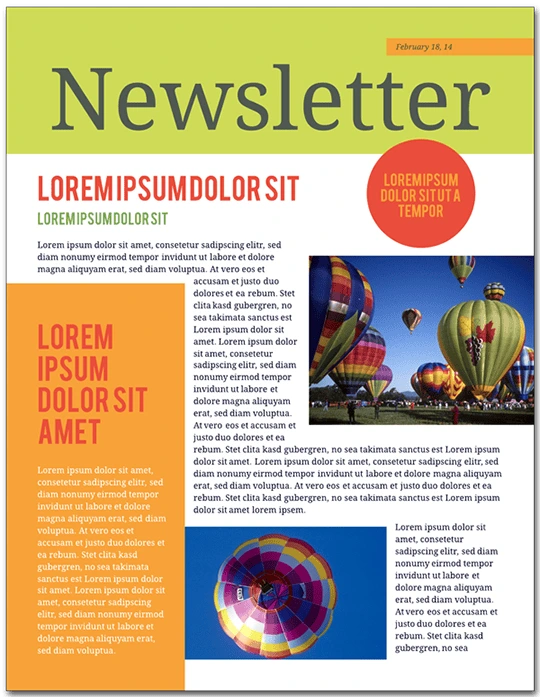
Related: 13 best newsletter design ideas to inspire you
How to create a newsletter
1. Produce good content
Make sure your content is engaging and useful. Don’t add fluff to your writing for its own sake. Before you use design software like Lucidpress, check to see that your pieces are copyedited, your photos are chosen, and your articles’ lengths are set.
This newsletter template is five pages: long enough to include a solid lineup of articles and photographs, but not so long as to be overwhelming.
2. Establish branding
Think about how you will create a consistent brand. Every aspect of your newsletter will reflect upon your corporate or academic culture and identity. Choose a succinct title, incorporate your business’s font (if you have one), and replicate your brand’s color scheme with Lucidpress’ color picker.
To place your logo onto the canvas in Lucidpress, drag the Image icon from the Content bar. From here, you can upload a .PNG file with your company icon.
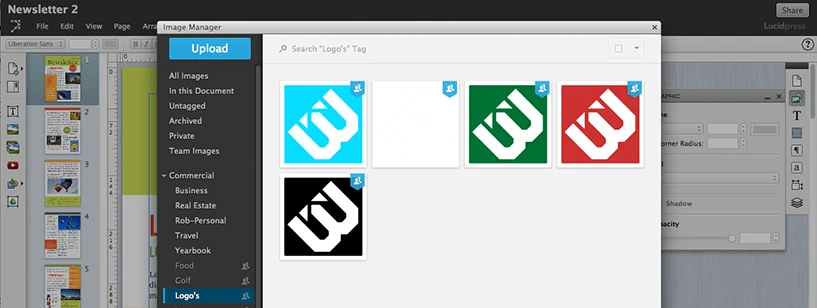
3. Brevity is the soul of wit
It’s important to have a strong opening article. This will often be a message from the principal or director, or a highlight of the most exciting feature in a product. Newsletter articles should be a page or less, with carefully placed images that visually break up the text. Splitting your articles into columns gives your content a suitably “newsy” feel.
On the bottom of page 3, there is a call-out box with a colored background. There are several ways you could use this section of the template for your own content. It could be a mini-article, a call for donations or a caption for the photo above.
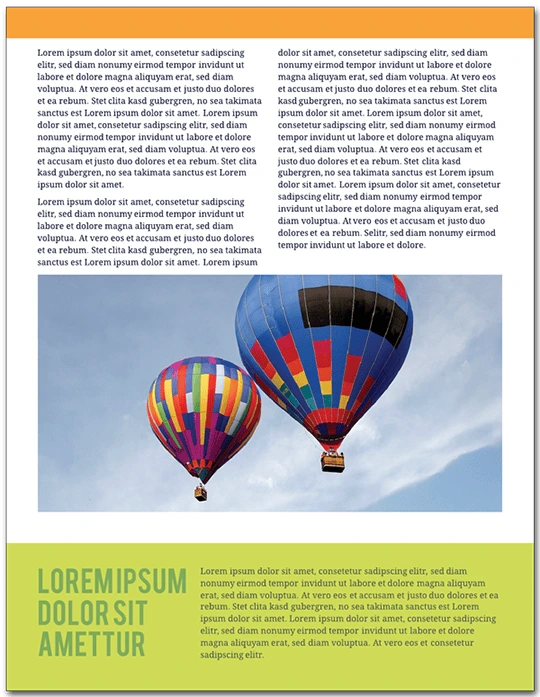
4. Be informative without being too salesy
Newsletters should provide value for their readers. If you used this template for a school, the audience should be able to tell what’s going on for alumni. Avoid too much of the hard sell; consumers are best persuaded with interesting content, not aggressive marketing.
On page 5 of the template, you’ll see an event calendar. To replace the preset dates with your own, double-click the text to edit.

5. Add photos and graphics
This newsletter is tied together by the images of brightly colored hot air balloons. Graphics like these provide visual consistency and make the newsletter fun to look at. A wall of unbroken text is not enjoyable to read, and it will not engage your audience as much as having well-placed images which complement your articles.
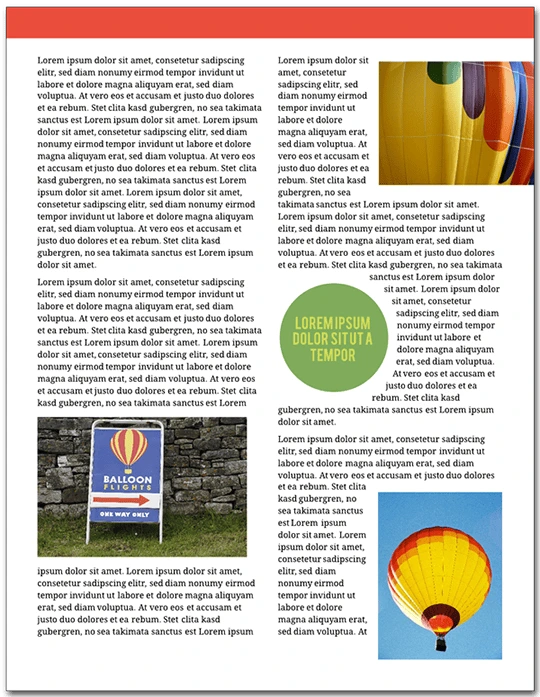
In the template, double-click an image to replace it with your own. This will bring up the Image Manager. From here, you can import images from your computer, Facebook, Dropbox or Google Drive.
6. Optimize your text formatting
Having consistent formatting is essential to your newsletter’s success. Limit the number of colors and fonts—less is more when it comes to readability. In general, use dark text against a light background. Standard usage calls for serif typefaces for the body of your articles, and sans serif typeface for captions, callout boxes and sidebars.

To change the font in Lucidpress, double-click text to select it, then choose a different typeface from the Properties bar. To change the font of every text element at once, press Ctrl+A. The font you choose reflects your brand: aim for consistency over eccentricity. A clean, modern design will earn your audience’s trust more than curlicues and Wingdings.
7. Use interactivity in Lucidpress
Lucidpress makes collaborating on a newsletter simple and straightforward. In Comment mode, your colleagues can weigh in on the content and design of your documents. You can use Lucidpress to invite feedback without the inconvenience of saving multiple drafts—it all happens in the cloud. The following video illustrates how:
8. Proofread your newsletter
Newsletters are text-heavy documents, and a grasp of spelling and grammar conventions will serve you well. Taking a few minutes to proofread your writing will pay big dividends in reader satisfaction.
In Lucidpress, select your text, choose Edit from the Menu bar, and choose spell check. You can also conduct a find-and-replace search for those times when you forget “i before e except after c.”
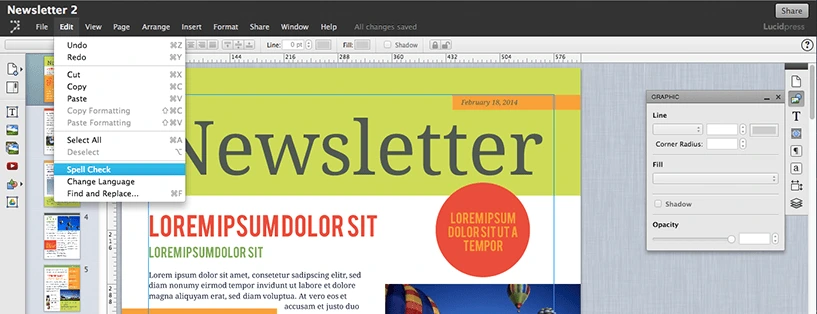
9. Be reliable and consistent
Decide how often you are going to send out your newsletter. This will affect the newsletter’s length, event calendar, and expected features.
Think ahead to the season your audience will receive your newsletter. If you are sending a winter holiday-themed mailing, you have to start designing weeks in advance. The same template can have a very different mood with different color schemes. Try using red and green for December, blue and white for midwinter, pastels for spring, and jewel tones for fall.
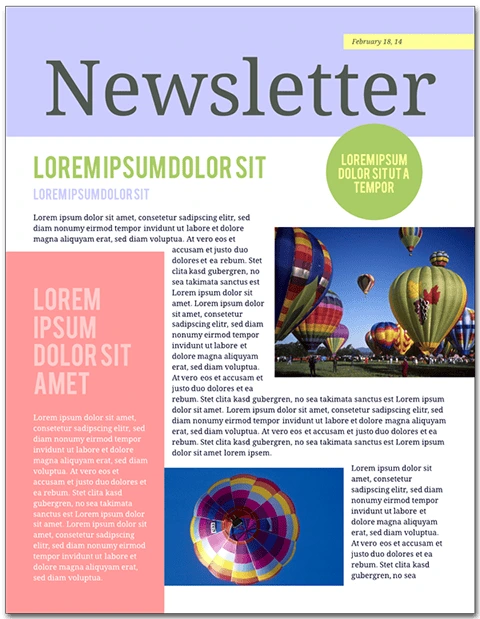
Newsletters are both popular and useful. They extend your brand’s presence, inform and entertain readers, and show off your expertise to the world.
Ready to wow your audience with beautifully designed newsletters? Lucidpress will help you send the right message.
With the right slogan, you can make people giggle at a pun, ponder the mysteries of the universe, or even experience a powerful craving. A poor slogan, on the other hand, risks making customers cringe. And forking over cash is usually the last thing someone wants to do after cringing.
This post will give you a 5-step guide to writing great slogans. So whether you need a brand new idea or you’re refining an existing slogan, you’ll be in business. Let’s get started!
Related: Learn more about the 10 assets you need to effectively manage your brand online in our free eBook.
1. Make your slogan ABC: Ambitious But Credible
Believability is the first test of a good slogan, because a customer’s belief or lack thereof largely determines how he or she will respond, and that response could very well be the difference between buying and walking away. No matter how much fun your slogan is to say, or how good it looks next to your logo, it won’t do any good if your customers don’t believe it. [![]() ]
]
For example, Nike’s command to “find your fast” comes across as completely believable. While having the right equipment isn’t the only factor in athletic success, it is a factor. Slogans like this one invite consumers to put their trust in a brand, which is a big plus.

Some key questions to ask about your slogan:
- Do I believe it?
- Is there good reason for my customers to believe it?
- Does it set a high standard for the product?
2. Appeal to emotional needs
Making a purchase is often an emotional experience. If a slogan can incite a strong positive emotion (think joy, excitement, sympathy, etc.), it stands a better chance of connecting people with the products and services that aim to fill those needs.
For example, major hotel chains go out of their way to convey comfort: Hilton claims to be “filling the earth with light and warmth of hospitality,” while Aston bids “welcome home” to each traveler who sets foot on their premises.
You can also tug at the heart strings without being sappy. When Kleenex launched a video ad about a boy who gives a tissue to a girl he spots crying on the school bus, the closing observation that “someone needs one” positioned Kleenexes as the universal response to tears everywhere.
Questions to consider about your slogan:
- What emotions does it invoke?
- Which of my target audience’s needs does it relate to?
3. Stand out with clever wordplay
Your slogan ought to be tricky or clever enough to make most readers think about your slogan for a minute or two, which makes it more likely that they’ll remember it. If it’s too tricky, however, it can go right over their heads and leave them confused.
There’s no easy way to come up with a clever saying, but you can start by listing words that have to do with your product, then searching for rhymes, synonyms, and alternate definitions for puns.
Those aren’t the only ways to make your slogan stand out—in fact, sounding too catchy in a clichéd way could be counterproductive. Reese’s “two great tastes that taste great together” follows an A-B-B-A structure that, intentionally or not, imitates the peanut-butter filled structure of the candy itself.
Nor does it have to be complicated to sound good. “Ace is the place with the helpful hardware folks” isn’t just easy on the tongue; it’s also a straightforward slogan that goes well with the down-to-earth nature of hardware stores.
Ask yourself:
- Are consumers likely to understand the slogan’s wordplay?
- Does the cleverness of the slogan distract from or reinforce its overall message and effect?
4. Just say no to clichés and superlatives
How do you know when you’ve crossed the line from catchy to corny?
If people can sarcastically cite your slogan to disprove it when they experience setbacks, you’ve probably crossed that line. [![]() ]
]
Another sign you may have gone too far is the use of tired clichés. Phrases such as “we do X so you don’t have to”; “for x, by x”; and “x of the future” are all used so frequently that consumers are used to tuning them out. If you really want to express the sentiment embodied in these phrases, find a unique way of doing so.
Some key questions to consider are:
- In what ways is my slogan different from most slogans?
- In what ways is it similar, possibly too similar, to most slogans?
- How likely are customers to roll their eyes at it?
5. Maintain a strong connection to your business
Can you match the following slogans to the product they represent?
1. Made like no otherA. beverages2. Rethink the daily grindB. women’s deodorant3. Live loudC. toilet paper4. Live life in full colourD. denture fixatives5. Bend the rulesE. 3D desktop scanners6. Designed to be forgottenF. ice cream
Having trouble making the connection? The point is that a slogan should strongly relate to the product it promotes. It if doesn’t, then it might catch people’s attention momentarily, but it won’t stay with them.
It’s best if there’s a strong, interesting link between your slogan and your product. For instance, Aquafina’s insistence that their water is “for happy bodies” makes good sense. Sunchips’ claim to be “unique in every wave” distinguishes their chips from their less curvy competitors. Finally, Paper & Packaging Board’s assertion that their products are at the heart of “how life unfolds” wouldn’t make much sense for, say, a burger stand.

(And if you want to know the quiz answers, here they are: 1. F, 2. A, 3. D, 4. B, 5. E, 6. C.)
Congratulations! You made it through Business Slogans 101. Once you’ve written a killer slogan of your own, be sure to sell it visually as well as verbally. Lucidpress templates can help you incorporate your new slogan into all kinds of marketing materials: social media graphics, digital magazines, company newsletters, and much more.
Despite how ubiquitous digital marketing has become, print collateral can still play an incredibly valuable role in your brand marketing stratgy. Businesses large and small can benefit from this versatile medium, from empowering sales teams at trade shows, to generating awareness through direct mail campaigns.
Still, brochures often get a bad rap for being lifeless, boring, and unengaging – a problem that can stem from bad design, ineffective messaging, and low budget. To help you avoid those common pitfalls, we’re going to take a deep dive into the ins-and-outs of effective brochure design. In this guide, you’ll learn how to design a brochure that people will actually want to look at.
When to use a brochure vs. other print marketing
If you can’t decide whether your brand would be best served by a brochure, or other printed material like a flyer or poster, we suggest looking to your buyer journey for some guidance. Flyers are great for attracting attention, building awareness, and sharing a short message. Brochures, on the other hand, tend to be far more effective down the road, when a prospect is in the information-gathering stage. Brochures offer you a chance to share more detailed information about your brand, products, and services.
Here just a few instances where a brochure can be helpful:
Marketing — Brochures can easily be included in direct marketing campaign, or handed out at trade shows or conferences.
Food service — Restaurants can create catering and to-go brochures for patrons to save for later.
PR — Public relations managers can include brochures in press releases and media kits, so the news media can craft better, more accurate stories about a company.
Sales — Salespeople can hand out brochures to business associates, partners, and potential clients after a demo or presentation.
Standard brochure sizes and layouts
The first step in designing a brochure is choosing the right size. When thinking about brochure size, think about portability, foldability, and how much written or visual information you want to include.
Below are the most common brochure sizes businesses use.

Once you’ve settled on a size, it’s time to think about the layout you’d like to use. From simple bi-folds to creative spiral folds, your choice of layout determines how readers will interact with and move through your brochure.
While there are many different creative brochure layout options to choose from, here are just a few of the most common brochure folds.

Now that you’ve chosen your size and layout, let’s talk about what to put in your brochure.
How to design an effective brochure in 5 steps
Create an outline
Before you start designing anything, you’ll need a detailed plan of attack. While brochures can vary in content and length, most follow a standard format.
- The front panel displays your headline and logo.
- The inner panels make a case for your product/service using
- The final panel contains your contact info and a call-to-action.
Identifying your target audience will help you build out an appropriate outline and flow to your brochure – and will inform your brochure’s tone, language content, and CTA.
Make note of where your target audience is in the buying cycle. Don’t waste space detailing the history of your organization if your readers have done business with you before.
Nail down these essential elements
Now it’s time to dive into the fun stuff. Like we mentioned before, every brochure is different, but all should include these 5 critical elements.
An eye-catching cover and headline – This is the first (or only!) chance your brochure has to give a strong impression, so make it count. A high quality, relevant image combined with a brief, easily legible headline will provide your reader with a strong understanding of what your brochure is about.
A compelling offer – Details aside, what you’re really providing with a brochure is opportunity. No matter what your product or service is, your brochure needs to offer just enough to make readers want to know more.
Valuable information – Brochures offer limited space to communicate your message, so prioritizing which information to include is key. The best rules of copywriting apply here: be clear, be concise, and tell a good story that makes your reader the hero.
A strong call to action – You can build a beautiful, convincing brochure that makes your audience feel exactly the way you want to… but it’s useless if you don’t set them up with a next step. A strong CTA will prompt your readers to call, visit, or connect with you in some way.
Detailed contact information – This goes hand-in-hand with your call to action. Not everyone will make a move right away. In fact, many people hold onto brochures to reference later, when the time is right. Make connecting with you easy by putting your contact info on the back.
Consider adding extra information & resources
Got extra room in your brochure and want to make a bigger impact? Think about adding extra information and resources for your readers. Consider where they might be in the buyer journey, and tailor these extra resources to meet any questions or hesitations they may have.
Some possible extra resources include:
- Answers to FAQ
- How-to guides
- Customer testimonials
- Product specs
- Pricing charts
- Pros and cons
Proofread & check for important details
No matter how much effort you put into your messaging and design, one small error or inconsistency can kill your credibility.
Before you send your brochure off to the printers, proofread everything (and proofread again). We also suggest making sure the tone of your brochure matches the rest of your brand messaging. Unlike informational brochures (which may take the third-person point-of-view), sales brochures usually use the second-person to build rapport with the reader.
Refer to your brand style guide for how to handle things like numerals, dates and titles in the text.
Test run your prints
The last thing you want is to waste time and money printing hundreds of brochures only to realize that the sizing is off, or your imagery is grainy. Do a small test run to verify that the finished product meets your expectations.
5 brochure templates to get you started
Don’t want to have to design a brochure from the ground up? Try customizing a brochure template instead. Here are just a few of our favorites here at Marq.
Redwood Coast Travel Brochure Template
This bi-fold brochure template has ample space to showcase immersive photography, with just enough space to introduce readers to your brand.
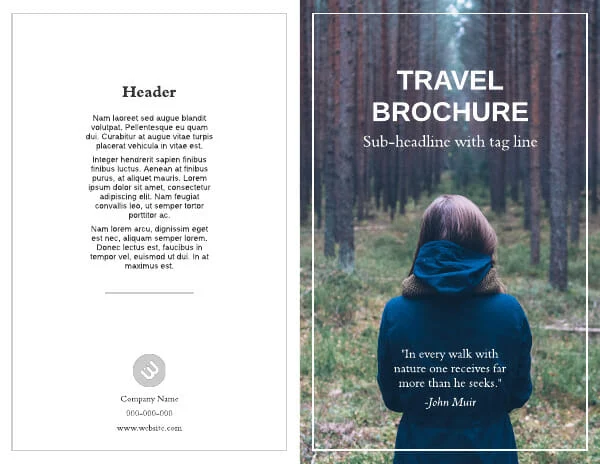
Visual trifold company brochure template
A traditional trifold layout makes it easy to describe your business while creating a compelling cover design.
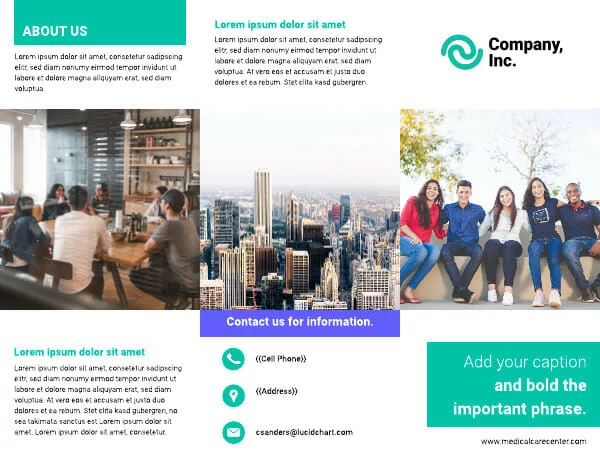
Health insurance company brochure template
Need to include detailed data and comparisons? This template is perfect. And with Marq’s data automation, you can auto-populate your own data by connecting your template to a Google Sheet.
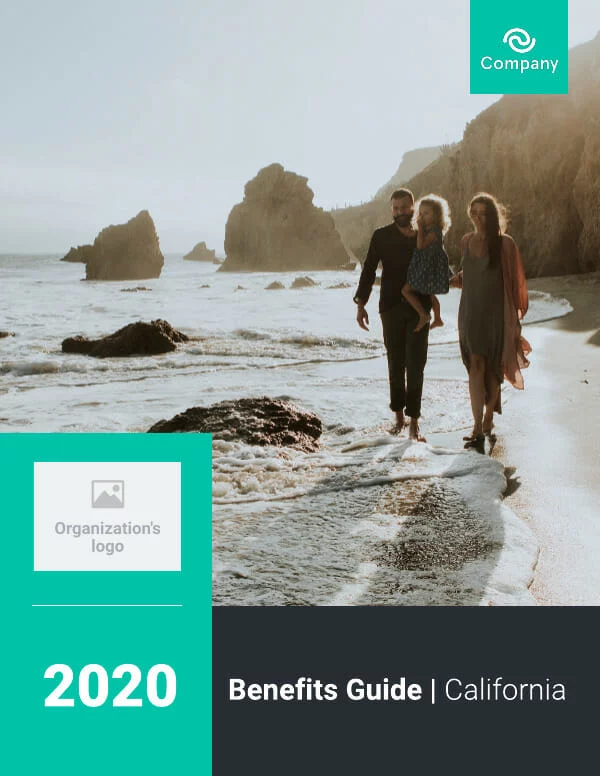
Wavy Shape College Tri-Fold Brochure Template
Update your marketing with a fun, fully customizeable brochure layout. Simply update colors, fonts and images to match your brand.
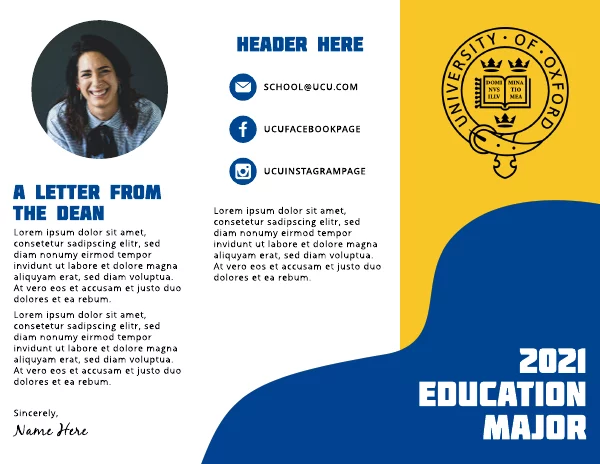
Navy Blue Wedding Photographer Brochure Template
Have a visual-first business? This template offers plenty space to showcase your photography, art, or graphic design.

Want to design your own beautiful brochure online? Marq makes it easy. With our intuitive drag-and-drop online brochure maker, just choose a template and customize it to fit your brand.
When I was first hired at Lucidpress, I was asked to handle nearly all of our content writing, including the monthly email newsletter. It was a terrifying prospect. Most marketers know that email is a specialized skillset, and it’s easy to screw something up. But not only have we avoided major newsletter snafus, I’ve been able to cut down my time creating a newsletter from one workday… to one hour. That’s a time savings of about 800%, and the newsletters look (and read) better than ever.
Related: How to make a newsletter in 9 steps
So, how did I streamline my process? Here’s how to write a newsletter in three easy steps.
1. Do your homework
I hate starting newsletters from scratch, so I always do research beforehand. If you’re at a larger company, attend important meetings and take notes a few weeks before you start writing. If you’re running a one-man shop, make notes throughout the month. You’ll want to record things like:
- Improvements or updates to your product
- Business initiatives, like a push for more customer feedback
- Random thoughts and ideas like “Are there any upcoming holidays we can capitalize on?” or “Should we start a referral marketing program?”
Always write down a point-of-contact’s name next to your notes so you know who to seek out for more details. As for the third point, you may not use all the random ideas that pop up, but before long, you’ll have a working list of future email campaigns to test.
2. Clarify your goals
Develop a clear goal, and make sure it’s displayed front-and-center in your newsletter. You might be trying to:
- Publicize new features or offerings
- Increase traffic to a store or website
- Boost sales with a newsletter discount or promotion
- Capture customer feedback on your product
- Get subscribers to tell their friends about you
- Remind customers what your product does
- Make an emotional connection with your audience
In all likelihood, you’re trying to do several of these at once. Pick the most important one, and make sure it’s represented at the very start of your newsletter. It should also be presented (in a compelling way) in your subject line. The other major points will fall into place and can often be accomplished without text (think strategically placed links, images and calls-to-action).
3. Make it pretty (and repeatable)
Now that you have notes and a clear goal, you can easily write the text of your newsletter. The most important step here is to format your text for maximum readability. You’ll also want a nice-looking layout that communicates your company’s professionalism. Here are my tips for making it happen in under an hour:
Distribution
Ask yourself where your audience is, then decide on your method of distribution. You can go old-school with a printed newsletter or distribute your content digitally; the latter is more common nowadays. Lucidpress’s company newsletter templates allow you to quickly build a professional-looking newsletter, then print or share with a URL. All of our templates can be customized to make school newsletter templates, Christmas newsletter templates and more.
You can push out the link via social media or a website, but remember that you’ll still want to use a dedicated email service to email it. That way, you don’t have to handle subscribes/unsubscribes, CAN-SPAM compliance, and other time-sucking aspects of email management. I’ve had good experiences with MailChimp and Hubspot, but there are many others to choose from.
Here’s how a Lucidpress newsletter looks when you embed it in MailChimp. Pretty snazzy, right? We generate the code for you—just copy and paste it in.
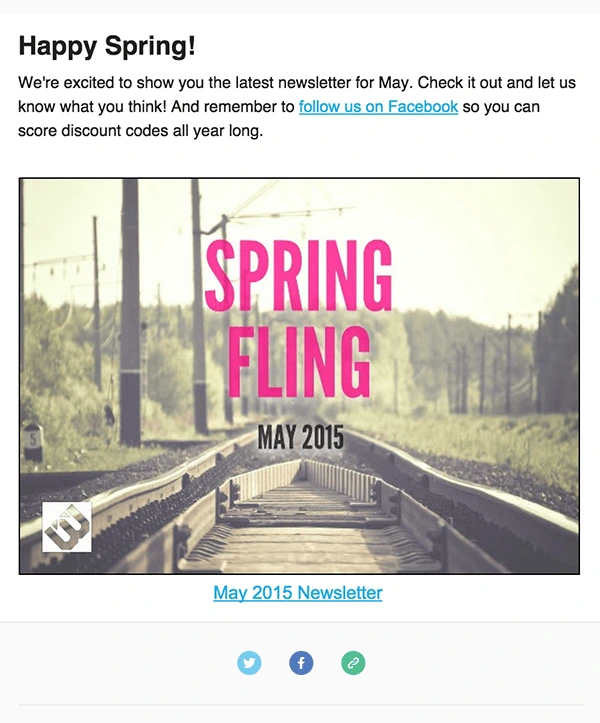
If you’d rather build a newsletter with HTML than embed a Lucidpress newsletter, pick an email service that offers prebuilt layouts. If you can’t do that, enlist the help of a professional web developer to create a few plug-and-play templates.
Text formatting
Lead with items that have the broadest appeal to your audience.
Keep it short, unless you have a good reason to do otherwise. My newsletters rarely exceed 400 words and are usually closer to 200.
This email from MURAL is a great example of how to use text sparingly to get your point across. The copy is brief and easy to read, while the images are carefully positioned to support the text. It all adds up to a highly consumable newsletter.
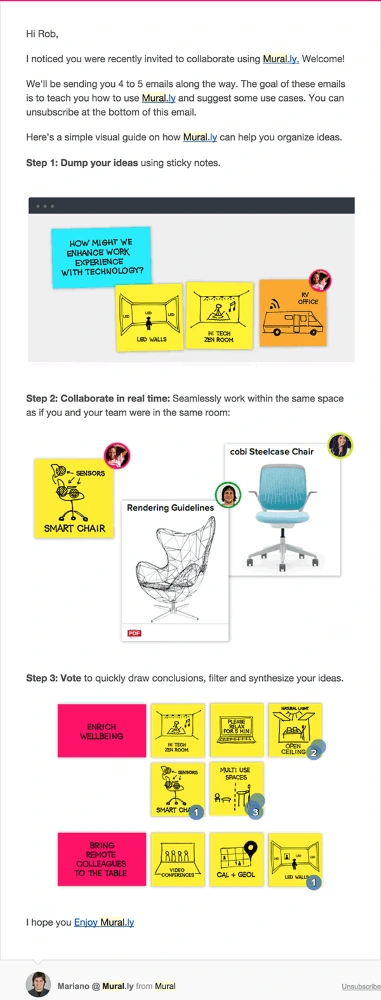
Design
Break up the text with relevant images, buttons and links. Use enough negative space to let all of your design elements breathe. This example from Litographs shows how striking a clean, roomy design can be.
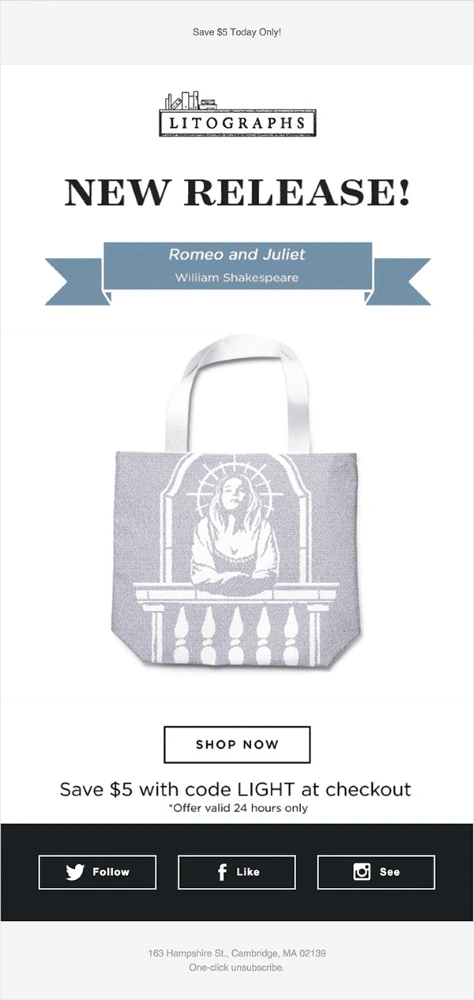
And that’s all, folks: how to write a newsletter in less time than ever before. We’d love to hear your own tips for maximizing effectiveness in marketing—just leave them in the comments.
Ready to make your own newsletter? These free newsletter templates are a great starting point.
Small Business Saturday will be here before you know it, so we’ve put together a 5-step marketing guide that will help your small business brand knock it out of the park this year.
Related: 10 best social media campaigns you haven’t tried yet
1. Focus on a single goal
There’s a lot of hype around the biggest shopping weekend of the year. But that also means you have a lot of competition from retailers both online and off. To avoid burnout, it’s wise to pick one goal and stay laser-focused on it.
Of course, that doesn’t mean you can’t use multiple tactics to achieve this goal. Let’s say you own a beauty salon that relies heavily on referral business. Your goal may be to collect 200 referrals from existing customers. To make it happen, you’ll probably use a combination of email reminders, social media posts, and an in-store event. As long as every tactic points to your goal, you’re golden. Just be wary of offering competing promotions or asking for too much from your customers.
2. Take advantage of free design resources
American Express, the sponsor of Small Business Saturday, is offering several resources to participating small businesses. That includes downloadable templates for promotional material. These templates are good for showing your support of Small Business Saturday, but they don’t do a lot to promote your brand.
So we created a free template pack for you to customize with your branding for Small Business Saturday. All you need to do is sign up for Lucidpress (it’s free!), click the links below, then add your own logos and content.
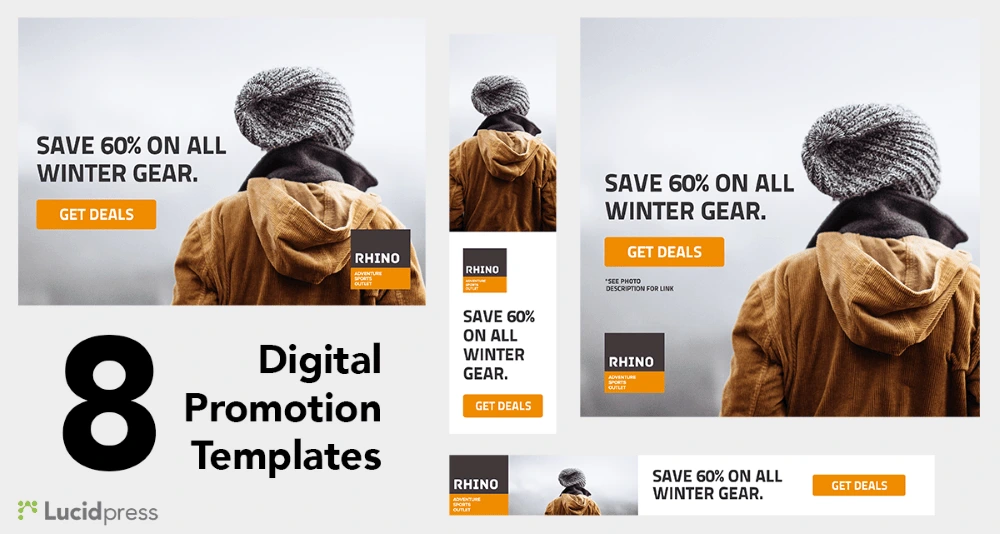
Free digital templates (click to access)
- Banner ad (160 x 600) template
- Banner ad (300 x 25) template
- Banner ad (728 x 90) template
- Webpage header template
- Facebook cover photo template
- Facebook photo post template
- Twitter photo post template
- Digital or print flyer template
3. Look far and wide for ideas
Every industry has its quirks. So instead of telling you which ideas are best for your business, we’ll show you how to find them yourself.
- Check with your local government and Chamber of Commerce. Often these organizations already have a plan for Small Business Saturday that you can easily piggyback on. For example, the state of Utah is running a “Shift Your Spending” campaign to encourage residents to allocate 10% of their holiday spending dollars to local businesses. Chambers of Commerce are also known to give out Small Business Saturday collateral, like postcards and storefront signs.
* Ask your peers for winning ideas. Do you belong to a trade organization? Connect with members to see what they’ve done in the past. Head to relevant subreddits and ask whether other business owners in your field have promotional ideas for the big day. Check out small business forums like Manta and see what fellow SMBs are planning. You can even request membership to a few groups on LinkedIn and join the conversation there.
* Sell for a season, not just a day. Recognize that your Small Business Saturday efforts should be part of a larger strategy for the holiday season. Sometimes googling “Small Business Saturday” yields the same ideas over and over. To get some fresh ideas, try searching for holiday-related keywords, e.g. [Industry name + holiday marketing ideas]. And be sure to check out the Small Business Administration’s list of holiday marketing ideas.
4. Ramp up your customer service
The biggest shopping weekend of the year is also your biggest opportunity to get new customers and lock in repeat business. Creminelli Fine Meats is a local producer of delicious artisanal meats in Utah, and no stranger to the importance of customer service.
Creminelli’s CMO Jeff Fuller says, “I have found that Black Friday, Small Business Saturday, and Cyber Monday are all fantastic opportunities to attract new customers. The combination of social media, outdoor media, and buzz-worthy deals drives a huge boost in sales. The key is to have amazing customer service during that long weekend, so you can earn a repeat visit from those same consumers—and hopefully another purchase at full price.”

Make your customers happy with personal touches like this birthday note from Creminelli’s team.
Hiring additional staff can create a smoother shopping experience for your customers. What are other ways to delight them? Try using live chat to offer online shoppers the same great experience you’re creating in-store. Send thank-you cards to loyal customers before the big day. Hire a photographer, grab some seasonal props, and invite customers to snap their holiday photos while they shop.
There are tons of possibilities. Just think about what your customers will value most, then plan an initiative around it.
5. Don’t forget to follow through
You should have a simple way to gather contact info from customers on Small Business Saturday. This will build your mailing list so you can stay in touch year-round.
In all the hustle and bustle, make sure you engage on social media. Use the official Small Business Saturday hashtag #ShopSmall as you promote your business and chat with followers. Engaging on social media the day of an event is important, but more frequent posting is linked to higher engagement and loyalty from customers. We recommend amping up your posts both before and after Small Business Saturday.
And finally, it doesn’t hurt to offer discounts once the new year rolls around. This will help you stand out in customers’ minds from every other retailer.
Try Lucidpress today to create beautiful promotional materials for your brand—no expert knowledge required.
You’ve got a great idea for a flyer: a new business service, a store’s grand opening, an upcoming concert, open house or event. And you’ve got Lucidpress to make designing your flyer a snap. Now all you need… is an audience. Welcome to Flyering 101, where you’ll learn how to nail (no pun intended) your flyer distribution.
Related: 17 flyer layout design ideas for your inspiration
According to our research, here are the top six issues to consider before distributing your flyers.
1. Consider your message.
Certain messages are better suited for flyers than others. Most of them can be grouped under the same umbrella—that is, most flyers are announcements. Maybe you’re trying to drum up interest for a new business or invite people to a local festival.
There are lots of occasions which call for an easy, low-cost form of direct marketing. Is your flyer ready for primetime? Make sure you’re completely satisfied with every aspect of your flyer, from content to design. Because once you print out hundreds or thousands of copies, there’s no going back.
2. Consider your timing.
Allow me to state the obvious for a moment: flyers are made of paper. They’re not incredibly durable, and they don’t tend to last very long. If you’re hanging flyers outside, their lifespan could be substantially shortened by the elements. Before you get out the staple gun, check your local weather forecast for rain, snow, and heavy winds. If harsh weather is on the horizon, you might have to adjust your plans.
While we’re on the subject, take holidays into account as well. Around certain ones, like Halloween and Christmas, your flyer will be competing with a lot of decorations. Space might not be as readily available as it was before. That doesn’t mean you shouldn’t advertise around a holiday—especially if your message is seasonal or topical—but you should still take note.
3. Consider your audience.
Who should read your flyer? Is it of general interest, or does it address a specialized audience? It’s important to consider this before you start flyering. It’s one thing to hand them out to people. It’s another thing to hand them to the right people.
Distributing flyers to random strangers who pass you on the street might not be as effective as targeting a specific audience. In fact, in many cases, you might as well be putting your flyers in the trash. But once you understand who your audience really should be, you can put together a smarter distribution plan.
4. Consider your distribution method.
How are your flyers getting to your intended audience? You have a few choices. The most popular methods are:
- Hanging the flyers in public/community areas.
- Handing the flyers to people directly.
- Keeping a stack of flyers in a high-traffic area.
- Delivering the flyers door-to-door (or car-to-car).
The method you choose will have critical ramifications on your distribution plan. For example, how many flyers will you need to accomplish your goal? How long will it take to get rid of them all?
No matter where you’re flyering, make sure you get the right permissions. Not all places that are open to the public are open to flyering as well. Parks have maintenance staff. Neighborhoods have soliciting policies. Storefronts and cafés have managers. Schools have approval forms.
Don’t give up hope, though. Many times, you can chat with property owners to determine whether they’re open to flyering. If you see shops with flyers already out front, that’s a good sign. Many places, like college campuses and laundromats, have corkboards especially for flyers and local ads. Take a look around, and don’t be afraid to ask!
5. Consider your distribution team.
If you’re hanging or handing out flyers all by your lonesome, it’s going to be a long ride. Flyering moves much faster in a team. Fortunately, you can call on your support network for help. If you’re announcing a new store, employees can help. If it’s a party or a concert, you can recruit family and friends. If it’s a club or organization, it shouldn’t be hard to find volunteers.
The lower the quantity, the easier it will be to get all those flyers out into the world. However, if your back’s against the wall, you still have options. If you don’t have the time—and no one else seems to, either—give a flyering agency a call.
There are specialized businesses out there who take care of the entire distribution process, from start to finish. They can help you create a smart plan that targets your audience in a timely fashion. Some even offer GPS tracking so you can watch in real-time. Just keep in mind that you can’t control how the staff does its job, so choose your agency partner carefully.
6. Target your distribution.
Finally, take a good hard look at your distribution plan and make sure you’ve accounted for all the steps up to this point. Now that you have all the basics in line, you can make some advanced adjustments. Targeting your distribution is the final consideration that will have a major effect on your success, and there are two ways to do it.
- Geographic targeting. If you run a local business, you can target specific areas who are more likely to benefit from your services. You can choose the zip codes, cities, streets, or even neighborhoods to flyer. Take into account the topography and landscape of these areas. Some terrain will be harder to cover than others, such as hills or neighborhoods where houses are far apart.
- Demographic targeting. If you’re announcing a new location for your business, you might target loyal customers who you know will be interested. Or if your flyer addresses a specific need, like babysitting or landscaping, you might be selective about who gets a flyer. The idea is to give flyers only to the people who actually benefit from your message, so your flyer has a higher chance of success.
Flyering may be a cheap way to advertise, but that doesn’t mean you want to throw your money away. With these six considerations accounted for, you can craft a smart flyer distribution plan that helps you achieve your business or personal goals.
If you’re serious about upping your social media game, then brand consistency is key.
Many new businesses underestimate the amount of time and effort that goes into creating a social media presence that counts, and social media marketing is often seen as a cheap and cheerful way to spread the word about your business. While social media can be a fun and cost-effective marketing tool, it does eat up a lot of time. If you’re keen to invest that time in developing social feeds that make a difference to your business, you’ll need to have social media guidelines for keeping your brand consistent.
Related: How to drive traffic with social media
5 benefits to brand consistency on social media
Accomplishing brand consistency on social media isn’t easy, but it is achievable. Before we tackle how you can achieve it, let’s first consider why it matters.
It makes you memorable.
There are 500 million tweets sent every day, with 6,000 going out every second. When users see online content from a brand they can easily recognize, they’re more likely to remember them in the future, both online and offline.
It increases customer engagement and loyalty.
If customers remember and recognize a brand, they’ll feel much more comfortable interacting with them. Likewise, customers are more likely to stay loyal to brands who deliver a consistent message.
It helps you stand out from the crowd.
Having a brand that is easily recognized will help to set you apart from your competitors. There are 6 Facebook profiles created every second, resulting in around 500,000 new users every day. If you’re not consistent in branding your business across the various platforms you use, it can be easy to get lost in the crowd.
It gives you authority.
Branding that’s done well looks professional. It builds trust because it tells your audience that you know what you’re doing and you care about the details.
It makes you relatable.
Using social media to show the unique personality of your brand is an effective way of helping customers relate to you.
Tips for branding your social profiles consistently
To achieve visual brand consistency when setting up your social profiles, there are a few key things you’ll need to remember.
Names & handles
If you want your customers to be able to find you easily as they move from one platform to another, it’s important that your name and handle is the same wherever you are.
Colors & logos
Even before they read your name or bio, visitors will register your logo and the colors you’ve used. Make sure that these two things represent your brand in the right way. They should match your website and any other communications that go out to your customers.
Taglines
If your business has a tagline, display it prominently on your social profiles. Taglines are memorable, and using yours consistently will help your customers recognize you.
Still working on your brand basics? Read more: The 7 key elements of brand identity design
3 questions to ask before you start posting
Next, we’ll look at keeping your brand consistent when you post on social media—but before we do, here are a few important questions you’ll need to have the answers to.
Who is your audience?
The internet has 3.77 billion users and 2.78 billion of those are active social media users. To ensure your social media content is directed at the right sort of people for your business, you’ll need to understand a few things about your target audience. How do they identify themselves? What are their interests? What motivates them?
Who is the audience on each network?
Not everyone is on every social network, and if they are on two or more, it’s likely for different reasons. Consider what your target audience expects when they visit each social platform and how you can provide the content they’re looking for.
Social media management platform Hootsuite predicts growth in the following themes for 5 top social platforms:
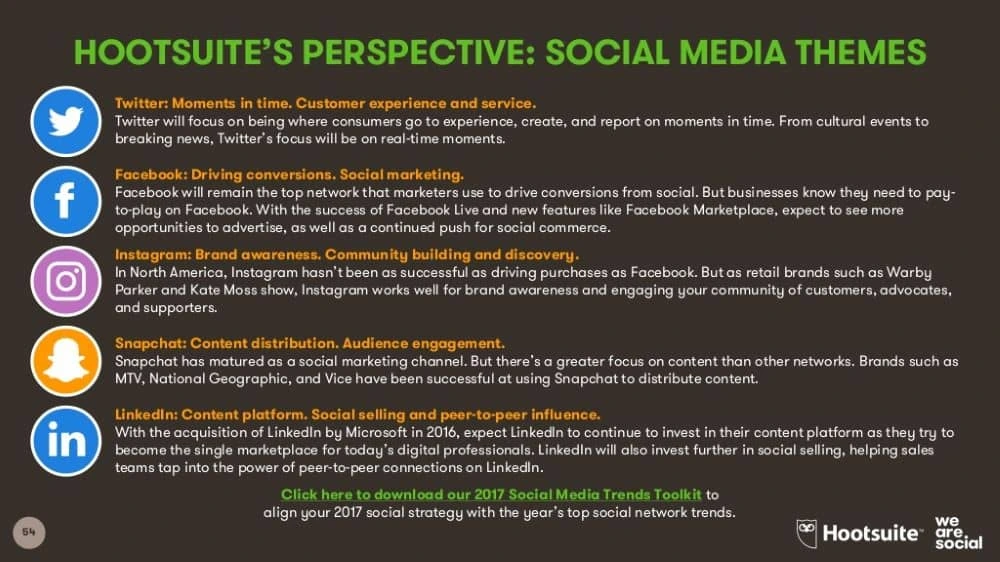
What language and tone will you use?
Deciding in advance whether you’ll use “we” or “I,” whether you’ll be funny or serious, and whether you’ll stick to perfect English or use slang and text-speak is an important move. There’s no wrong answer, it’s just about deciding what’s right for your audience. Once you know, make sure everyone in your business who posts is consistent.
Tips for social media posts with brand consistency
Once you’ve got answers to the questions above, you can start to think about when and how you’ll post and what you’ll share where.
Don’t just advertise.
The most successful brand accounts have a following because they offer something that their followers value. If you’re using social media just to promote and advertise, your audience will unfollow. What else will you offer: Promotions? Behind the scenes insight? Helpful information? Technical support? If you’re not sure where to start, check out the competition and see what works for them.
Post regularly and consistently.
Creating a social media account that stands unused can be harmful to your business. If a customer searches for you and sees that you haven’t posted for a while, they may assume that your business has closed.
Posting consistently can also help you develop a relationship with your audience and increase engagement. If they know when to expect a certain type of post from you that they appreciate, they’ll look out for it and may even begin to interact with you.
Consider your posting frequency per platform.
Posting regularly doesn’t have to mean posting all the time. It’s about quality over quantity. The frequency of your posts should depend on both the relevancy of your content and the platform you’re using. Do some research to find optimal times for posting based on platform and then set a schedule. There are free tools available online that will help you stick to it.
Curate content that fits.
Creating quality content for multiple social media platforms is a full-time job and, if your business is small, you simply might not have the resources. But you shouldn’t let that stop you from posting regularly. Sharing content from other people and businesses that echo your brand’s message is an effective way to keep the ball rolling while you’re working on other things.
Repurpose old content.
Likewise, there’s no reason why you shouldn’t repurpose old content. Share old posts that recent followers may have missed, or transform the content into something new. You could create an infographic from a long blog post, for example, or try breaking it up into smaller pieces and expanding on each one.
Don’t be repetitive.
While it’s important to post regularly, you should be aware of sounding repetitive. Don’t bombard your followers with the same message again and again, and be careful not to publish the exact same post across all your channels at the same time. Active social media users tend to jump from platform to platform within the space of minutes—if they’re seeing the exact same post from you wherever they go, they’ll start to feel overwhelmed by your content.
With that being said, if you’re running a big promotion or have an important announcement, you should certainly feature it across all of your social platforms. Instead of sending it out across multiple channels at one time, consider when the best times for posting on each channel are and stagger your message accordingly.
Link & cross-reference.
Don’t forget to link and cross-reference your social accounts. If you’re running a special promotion on Facebook, let your Twitter followers know. Likewise, if you have some content on Snapchat that you’re proud of, mention it on Instagram. Try only to do this when you have something your followers will appreciate—do it too much and you risk being repetitive.
Document your brand guidelines
There’s a lot to understand and remember, isn’t there?
If you’re committed to developing a social media presence that is both beneficial to and consistent with your brand, it’s worth considering documenting your brand guidelines.
Learn more about brand guidelines: 10 examples of great brand guidelines
Key takeaways
To achieve brand consistency on social media:
- Take care to ensure your profiles look similar and that they match your overall brand identity, including your website, newsletters and any other communications that go out to your customers.
- Make sure you know exactly who your posts are directed at and how you’ll communicate consistently with those people.
- Develop a social media content plan that outlines when and where you’ll post and how often. Work on ideas in advance and don’t be afraid to repurpose and curate, as long as you’re sticking with your overall brand message.
Ready to drive more brand awareness with social media? Grab a copy of our free eBook: How to adapt your brand to social media
Productivity is not easily achieved—and when you do achieve it, it becomes even harder to maintain. As a team leader, your guidance will be the driving force behind your team’s productivity. If you plan on increasing your team’s effectiveness, you’ll need to implement some key management solutions.
Related: Productivity tips for businesses
Let’s move on to the practical steps you can take to improve your team’s productivity.
Implement clear communication
Effective communication is one of the key prerequisites for a thriving workplace. It drives fast, clear and precise flow of information between individuals and groups. A lack of proper communication can greatly decrease productivity. According to research, employee productivity is expected to increase if you implement direct lines of communication, both in terms of software application and personal relationships.
How do you do this? First, your employees should have a clear set of communication guidelines. These will include communication hierarchy and conduct guidelines that cover tone of voice, language, brevity, etc.
Communication needs to be transparent and to the point. To be succinct, provide your employees instructions for how information is handled, who are the correct recipients, and what are the key elements that every communique should contain.
Failing to establish these guidelines will lead to decreased performance due to noise and redundancy.
Finally, always keep your team connected. Inspire social media bonding and connect the team within a unified business platform or program. Encourage them to share their opinions and support every employee by showcasing their strengths and qualities within the network.
Develop trust
True productivity within a team is rarely achieved without mutual trust. And trust is earned, rather than demanded or expected. Your team needs to trust your judgement and decision-making as much as you need to trust your team.
Additionally, support trust and camaraderie within the team itself. Two heads are better than one—but if one doesn’t trust the other, then they won’t work together for the common goal.
How do you do this? First, earn the trust of your team by showing true leadership in the form of smart quick decision-making, honesty and attentiveness towards others. Learn as much as you can about your employees and help them reach their goals. In turn, they will respect you and feel they can rely on you.
Once you’ve earned their trust, you can start building a bond between them. By giving them a push here and there, helping out from behind the curtain and orchestrating their workflow, you can encourage the team to grow closer and develop a trusting relationship. This will lead to better collaboration and productivity.
Manage funding
Constant cash flow is important not only for productivity and security but also for the long-term development of the company. While it’s good to have employees who are passionate about their work, passion and love will not pay the rent.
You can nurture your team’s productivity by assuring that they will be rewarded for their work. This is how you create a thriving collective. The way to secure funding is, of course, to get clients. This is the main determining factor of your company’s success.
When working on acquiring new business opportunities, you’ll need secure funding to keep your business afloat and your team working productively. You can’t be burdened with slow-paying customers, so you will definitely need a flow of cash to get the project going. One of the best solutions is invoice factoring, which can secure your cash flow and provide immediate funding.
As we all know, money makes the world go ’round. That’s why, by securing funds ahead of time, you can raise employee productivity and set high goals right from the start.
Impose deadlines
Deadlines are a key tool of productivity. While everyone would like to have as much time as they comfortably need to finish a task, it can actually be detrimental to their performance. People tend to thrive under pressure, but too much pressure can make them crack, so it needs to be carefully balanced.
What is carefully balanced pressure? It’s the fine line that you as a leader must draw between peak productivity and diminished performance. For your team to work at peak performance, they need to have the right kind of stimuli. And deadlines are one of them.
Deadlines should be imposed seamlessly and calmly. Always present a deadline as achievable, and give your team an inspiring pep talk to set the tone.
Next, deadlines need to be prioritized. You can’t simply impose twenty deadlines and expect people to remain calm and avoid panicking. No, deadlines are like tasks—they need to follow a hierarchy. It is the leader’s job to carefully plan out every deadline and put it in hierarchical order. This will give your employees a clear sense of direction and an action plan, and they will feel empowered to tackle the tasks with clear and precise guidance.
People say that there is no “I” in team, but every team is comprised of unique individuals, with unique sets of strengths and weaknesses. Everyone is susceptible to distraction and procrastination, and maintaining top team performance is quite a challenge. Luckily, with these powerful solutions, you can create a productive working environment.
You don’t need rocket science to see how social media has changed the dynamics of business. It’s almost impossible for a new brand to establish itself without a prominent presence on social media channels. Companies these days use popular platforms like Twitter, Facebook, Instagram, Pinterest and others to boost their online profiles.
Most of us already know how to use these channels, and we see how businesses use them to their advantage to build a strong social media following.
For example, check out this round-up of 10 highly effective social media campaigns.
But there are still effective tactics and strategies that not everyone is aware of, and even now, few brands apply them all to their own online presences. Let’s review a few tried-and-true ways to drive traffic (and leads) with social media marketing.
1. Informative content
We’ve all heard by now that content is the king. We know this in theory, but in practice, it’s more complicated than a simple maxim. Well-crafted content that speaks to a specific target market’s questions and pain points can bring amazing results. A regular cadence of posts will build a bond of trust between a brand and its followers. Interaction through social media also builds that trust, and those long-lasting relationships translate into loyal sales and strong word of mouth better than most mediums.
There are lots of ways to build informative content:
- Case studies
- Ebooks
- Infographics
- Webinars
- White papers
According to research, 78% of customers find custom content useful and believe that companies providing content are interested in building long-term relationships with them. To create amazing social content, search for trending keywords on platforms like BuzzSumo, Social Animal or Sprout Social—then create informative blogs & pages around your findings.
2. Visual appeal
Visitors to a website decide in a split second whether they want to check out the whole thing or leave it. Visual appeal is all about capturing their attention and curiosity, which in turn will improve their engagement and boost the number of pages they visit. These principles apply to social media, too.
There are many ways to add visual appeal to your social content:
- Custom photography
- Artistic designs
- Screenshots
- Infographics
- Data visualization
- Trending memes
As a savvy social brand, it’s up to you to decide how to use these visual assets across the social media channels that would be most effective for your audience. Make sure you understand the culture and purpose of each platform, so that the content type you choose fits the context.
3. Vibrant video
Depending on how a visitor feels in the moment, reading an 800-word blog post might be too much—so they skip it. Alternatively, a strong 20-second video is easily understood and highly effective. That’s why many brands use video to grab attention from social media followers. But know this: the idea, message and execution of the video must work well together, otherwise the effect will be lost.
To make a strong video, create 2 to 3 drafts of the content and ask your team to choose the best one. Then decide where to host the video, keeping in mind that many social platforms (like Facebook) prioritize native video over external links. But, also consider that video-sharing portals like YouTube, Vimeo or Dailymotion can extend your reach.
If you strike gold, your video might even go viral. Just imagine what that could do for your brand!
4. Brand personality
In today’s brand-driven marketplace, it’s all about image and perception. No one stays loyal to a brand simply for the sake of buying a product—the brand’s reputation, the company’s philosophy, and the lifetime value it gives to the customer are all taken into consideration. For a small or medium-sized business, it can be difficult to compete with big, established brands. That’s where the power of social media can make a huge difference.
Quality products and services are vitally important, of course—but the way a company builds its community and nurtures its relationships really does matter. The marketing team must think deeply about the brand’s personality and purpose to achieve brand consistency on social media, which in turn will empower the company to have more meaningful, authentic interactions with its customers.
5. Communication tips
There are a lot of social principles to remember when building a strong online presence. Some can be used across various social channels, and they can be the catalyst a company needs to get the brand up and running.
Here are a few communication tips that can be applied across the board:
- Reply to all comments, quickly if possible.
- If someone shares a complaint, apologize and follow up when the issue is resolved. Visitors can grow angry if their grievances are not addressed in time.
- If someone reports an error or bug, thank them for reporting and investigate the error to resolve it as quickly as possible.
- Approve invitations and friend requests to grow your list of followers (and potential customers).
- Maintain a healthy balance between posting original content and sharing content curated from others. Both serve a valuable purpose in building your brand and attracting followers.
By following these strategies and tactics, you should be well on your way to building a strong, active brand presence on social media—and driving traffic to your site. Give these a try and let us know what’s worked best for you!
Eager to adapt your brand to social media channels? Grab a copy of our free eBook: How to adapt your brand to social media
Managing a client’s expectations is not an easy task, especially if you are a designer. As much as you want to keep clients happy and live up to their expectations, things don’t always go according to plan.
While designers rely on their creativity to deliver great results, clients sometimes undervalue the effort or attempt to control the process. It’s a cycle that can make even the most ambitious projects crumble in a matter of seconds. This is why maintaining good rapport with clients is instrumental to a project’s success. Although there’s no one-size-fits-all solution, we have some ground rules that can help you manage client expectations and take your collaboration to a whole new level.
Related: Essential client onboarding checklist
1. Communicate your ideas clearly
Communication is an integral part of any successful project. To maintain good communication, keep it simple. Communicate your ideas without using professional terms or slang that your clients might not be familiar with or understand. Also, don’t depend only on words. Share examples and visuals to help clients conceptualize the goal you’re trying to achieve. This way, you set up clear ideas from the start—and leave less room for misinterpretation down the road.
2. Set clear boundaries
No matter how smoothly we try to meet a client’s expectations, there will always be a few bumps in the road. For example, after sending over your first mockup, clients will nearly always request changes. This is an expected part of successful collaboration. If, however, they continue asking for alternatives time and time again, this may lead to revising the entire design, extending deadlines and causing frustration on both sides.
While it’s perfectly normal to listen to your client’s feedback and answer their needs and requirements, falling into a never-ending cycle of revisions will not have a positive effect on the project—or your relationship. To avoid this scenario, set clear boundaries; be transparent about what you can achieve and how much time you can dedicate to revisions. Otherwise, the client might undervalue your knowledge and skills and eventually stop trusting you.
3. Define your communication channels
The easiest, most efficient way to nurture a client is to keep them regularly updated about your progress and any changes. However, thanks to the inbox overload we all face, communicating with your client via email may no longer be enough. Build trust with your client by letting them become an integral part of your project, follow its different stages, comment and give feedback. Here’s a comparison list of the best project management tools that give clients a clear view of what you’re working on.
4. Identify your key contacts
While keeping your client regularly updated is important, too many messages between your team and your client may lead to annoyance, confusion or burnout. To prevent this, select one point of contact between the client and the design team. This will streamline communication so it’s straightforward and easier to prevent any misunderstandings or conflicts from bubbling over.
5. State your payment terms
Whether you need more resources to complete a project or you’ve run into an obstacle that you must tackle before moving forward, there are many reasons to extend project deadlines. If this happens, it’s better to ask your client to pay in parts rather than the entire sum. This makes it easier to add late payments and fill any gaps before it’s too late. Make sure you state your payment terms clearly and as early as possible so it’s a win-win situation for you and your client.
6. Make it personal
Small gestures can do wonders. If you’re working with a client who’s willing to pay for your services and appreciates your work and time, you should nurture the relationship by going above and beyond. For example, send them a personalized thank you card. Whether you provide advice that might have a positive impact on the brand, invite them to a fun activity or take them out for lunch, it will encourage ongoing collaboration in the future.
7. Have a detailed contract
A clear and concise contract is a major prerequisite to successful communication and collaboration with a client. Your contract should cover the following items:
- Expected working hours
- Procedure for feedback & revisions
- Project milestones
- Budget & payment
Keep in mind that besides delivering a contract to your client, you must carefully review it with them to make sure they understand and agree to all the details.
The best projects are a result of clients and designers working together to achieve a common goal, and the expectations you set will influence how the project’s success is perceived. By following these 7 guidelines, you’ll create a respectful, collaborative environment that will encourage everyone to do great work together.
A friend of mine says she could not help but be swayed by what people were saying about the importance of social media for increasing sales. Some people kept rhapsodizing about how they were able to achieve rocket sales by establishing brand recognition and strengthening their brand’s presence in social networking sites.
So this friend opened an account on Facebook, created a blog, squeezed in a post here and there, and sent out newsletters to introduce her product—and generated no significant increase in sales at all. Why?
Related: 7 serious social media mistakes brands still make
The truth about the use of social networking sites
My own research shows that I should not rely on luck to sell my brand—not even when I use social networking sites. I cannot expect mere presence in social networking sites to work magic and automatically land me great sales.
How can I successfully market my brand in social media? How can I increase customer conversion rate?
I looked into case studies and marketing research. I read up on what the technical marketing experts had to say. Here’s what I found.
Put your brand where your target market is
Alex Chris is an author and Digital Marketing Consultant. He is an expert in Internet Marketing and SEO. He says that based on updated surveys, Facebook dominates the social media scene today. A massive 1.79 billion people actively use the site monthly.
Alex says that you have put your brand where your target market is. With 60% of people on the Internet using Facebook, there is no greater tool to promote your brand, find new customers and gain a loyal following.
He suggests that you create an optimized Facebook page, add friends to your personal Facebook page, and get as many “likes” as you can. He suggests putting a “like” box in your website. You have to put this “like” box in a conspicuous, readily accessible spot.
Create relevant content
Alex and a great number of other marketing specialists, say that it is not enough to create social presence. You have to create high-quality content for your followers. If you are able to do this effectively, you have a greater chance of turning your followers into constant website visitors, and eventually to customers.
Connect with your audience before selling your product
Kristen Matthews is a creative digital strategist. As an influencer marketing consultant, she has worked on a variety of case studies with innovative brands.
A Huggies case study highlights the need to create not just any content, but one that emotionally connects to your target market—even before you push your brand.
Speak, listen & respond to your audience
Brittany Berger heads the Content & PR Division of Mention.com. She says that when you send out newsletters as part of your marketing campaign, you speak directly to your target market.
Make your audience feel that you are listening to them. You create positive vibes when you respond as soon as you can to any queries or points that they want to clarify.
Do not be too promotional
When I create posts, I am representing a vision, specific objectives, and explicit principles. I am also creating awareness and recognition of my business brand.
I am not simply selling. I am informing and educating my audience.
If I become too promotional and focus exclusively on trying to sell my brand, people may see my posts as self-serving. I may lose my audience.
Online entrepreneur, writer, and founder of UpFuel.com Chris Guthrie agrees that you have to find the right blend of marketing and educational values. The right mix provides true value for your customers. It will also give you the opportunity to sell your brand.
Cater to your audience
I have a website on social media. I have a responsibility to my followers. I have to come up with content that has to do with my particular niche. I have to create posts that are engaging and useful to my audience.
If I want to maintain a loyal following, I have to go out of my way to share relevant posts in a variety of interesting ways that include written articles, videos, info graphics, images, and charts.
I want my followers to feel that they are important to me. If I send out e-mail, I have to respond to queries as soon as possible.
If I do not think my content through and create posts that do not offer anything substantial, I may end up hurting my business reputation instead of helping spark brand awareness.
In a nutshell: what to do
- To sell a product or service to people, build a strong social presence.
- Elicit interest. Build trust.
- Provide appealing and relevant content.
- Use storytelling effectively.
- Find out your audience needs and wants. Tell your story based on these.
When you are able to do these, you will be able to generate more traffic to your website. You will be able to create a bigger following. And you will be able to enjoy a higher conversion rate.
Ready to drive more leads with social media? Grab a copy of our free eBook: How to adapt your brand to social media
When done well, flyers can be an incredibly effective (and inexpensive) way to promote your business, no matter your size. In fact, 89% of folks remember receiving a flyer, more than any other form of advertising. What’s more, 45% hold onto the flyers they receive for future reference.
Still, while flyer distribution is one of the most widely used marketing strategies, simply copy and pasting something together isn’t enough to stand out in today’s busy marketplace. If you want to grab people’s attention long enough for them to actually read your flyer and then act on it, you’ll need to be intentional in your messaging, design, and distribution.
Below you’ll find our comprehensive guide to flyering. From how to design a flyer for maximum impact to tips on distribution, we’ll help you create the perfect piece of print marketing for your business.
How to design an incredible flier
1. Create an attention-grabbing focal point
What’s the first thing that you want people to notice? Intentionally designing your flyer around a singular focal point will catch people’s eye and make sure your message comes across loud and clear.
Using unique, professional imagery, bold colors, and easy-to-ready fonts will help you stick the landing.
For example, we love how this Cinco de Mayo flyer immediately draws your attention in with a beautifully drawn taco that conveniently tells you exactly what the flyer is about. Fun colors + a casual, handwritten lettering style make this super easy on the eyes and a joy to read.

2. Speak to your target audience
Who’s your target audience, and how do you want them to respond to your flyer? For example, you might want them to stop by your shop, visit your website, or call for more information.
Knowing your target audience will help you craft messaging that appeals directly to them.
The goals of this flyer’s messaging and design are clear:
- To highlight the event is one night only, so people should act now to buy tickets/mark their calendars
- To catch the attention of film and poster enthusiasts
- To establish legitmacy by including the names of well-known print artists who will be featured

3. Focus on the benefits
It’s not enough to grab your customer’s attention. You need them to stick around so you can convey your whole message. Keep them interested by rewarding their attention. Answer their main question, “What’s in it for me?”
4. Keep the content simple
When it comes to creating flyers that stand out, less is more. Remember that you only have a couple seconds to capture the attention of your potential customers, and only one or two more seconds to hook them in with your product. That’s why you need to be straight-to-the-point content when describing what your product/service/event is, its benefits and other important details.
This funky design let’s people know exactly what kind of guitar lessons are being offered, what level they’re for, and how to get in contact.
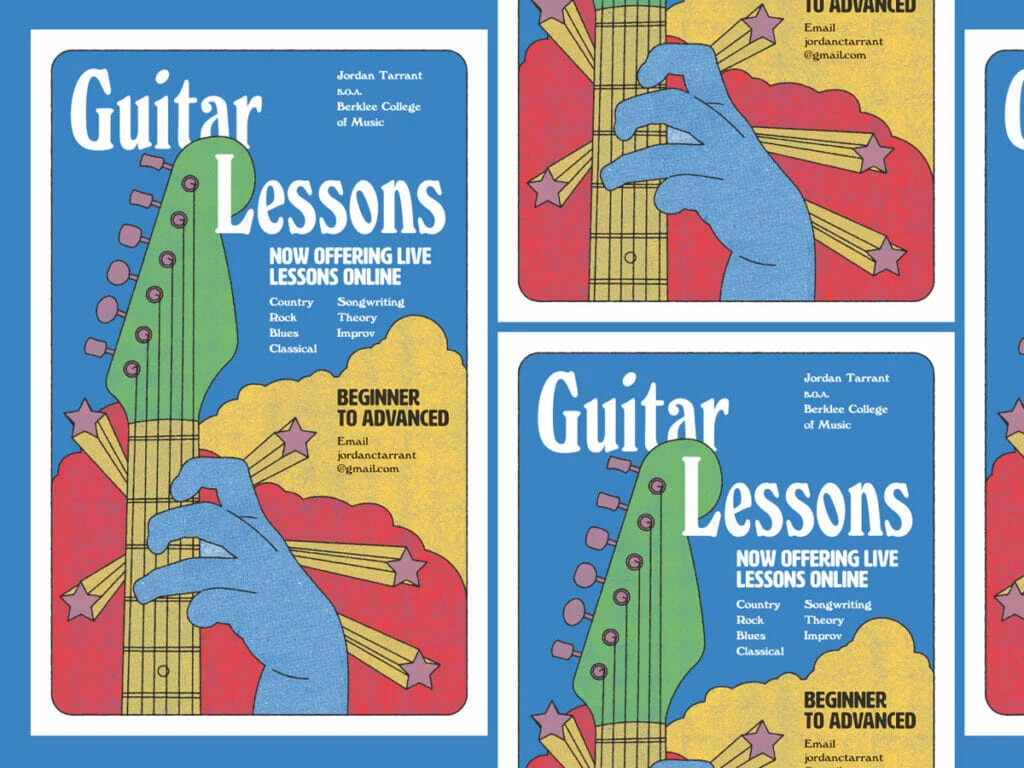
5. Include a call-to-action
After conveying your message, tell readers exactly what to do next, whether that’s to order now, call now, visit your website, etc. Get them excited about what they’ve learned on your flyer.
Be clear how you want them to interact with you by including important details about your business, like your website, contact info, location and more.
6. Print in high quality
Another vital element to creating attention-grabbing flyers is the final print. A quality print finish can be just as important as everything else you put on your flyer. Using a glossy finish and quality paper for your flyer creates a great first impression and can reflect the same quality of your products or services. Need a printer? Marq delivers high-quality prints of any design you create in our software.
7. Consider the impact of folds
Different folded finishes can create a unique impact and lasting impression. F Adding folds to your flyer will not only make it stand out but can also guide your audience through your intended information flow. Just remember to plan how you’re printing your flyer before you start with the design.

How to nail flyer distribution
Now that you’ve learned how to design a flyer, we want to make sure that flyer gets as much attention as possible. Design is only ‘half the battle’ so to speak – nailing your distribution strategy is key.
Here’s how to make sure your flyers get the attention they deserve:
1. Consider your timing.
We might be stating the obvious here, but flyers aren’t known for being particularly durable. If you’re hanging flyers outside, their lifespan could be substantially shortened by the elements. Before you get out the staple gun, check your local weather forecast for rain, snow, and heavy winds. If harsh weather is on the horizon, you might have to adjust your plans.
While we’re on the subject, take holidays into account as well. Around certain ones, like Halloween and Christmas, your flyer will be competing with a lot of decorations. Space might not be as readily available as it was before. That doesn’t mean you shouldn’t advertise around a holiday—especially if your message is seasonal or topical—but you should still take note.
2. Consider your distribution method.
How are your flyers getting to your intended audience? You have a few choices. The most popular methods are:
- Hanging the flyers in public/community areas.
- Handing the flyers to people directly.
- Keeping a stack of flyers in a high-traffic area.
- Delivering the flyers door-to-door (or car-to-car).
The method you choose will have critical ramifications on your distribution plan. For example, how many flyers will you need to accomplish your goal? How long will it take to get rid of them all?
No matter where you’re flyering, make sure you get the right permissions. Not all places that are open to the public are open to flyering as well. Parks have maintenance staff. Neighborhoods have soliciting policies. Storefronts and cafés have managers. Schools have approval forms.
Don’t give up hope, though. Many times, you can chat with property owners to determine whether they’re open to flyering. If you see shops with flyers already out front, that’s a good sign. Many places, like college campuses and laundromats, have corkboards especially for flyers and local ads. Take a look around, and don’t be afraid to ask!
3. Build your distribution team.
If you’re hanging or handing out flyers all by your lonesome, it’s going to be a long ride. Flyering moves much faster in a team. Fortunately, you can call on your support network for help. If you’re announcing a new store, employees can help. If it’s a party or a concert, you can recruit family and friends. If it’s a club or organization, it shouldn’t be hard to find volunteers.
The lower the quantity, the easier it will be to get all those flyers out into the world. However, if your back’s against the wall, you still have options. If you don’t have the time—and no one else seems to, either—give a flyering agency a call.
There are specialized businesses out there who take care of the entire distribution process, from start to finish. They can help you create a smart plan that targets your audience in a timely fashion. Some even offer GPS tracking so you can watch in real-time. Just keep in mind that you can’t control how the staff does its job, so choose your agency partner carefully.
4. Target your distribution.
Finally, take a good hard look at your distribution plan and make sure you’ve accounted for all the steps up to this point. Now that you have all the basics in line, you can make some advanced adjustments. Targeting your distribution is the final consideration that will have a major effect on your success, and there are two ways to do it.
- Geographic targeting. If you run a local business, you can target specific areas who are more likely to benefit from your services. You can choose the zip codes, cities, streets, or even neighborhoods to flyer. Take into account the topography and landscape of these areas. Some terrain will be harder to cover than others, such as hills or neighborhoods where houses are far apart.
- Demographic targeting. If you’re announcing a new location for your business, you might target loyal customers who you know will be interested. Or if your flyer addresses a specific need, like babysitting or landscaping, you might be selective about who gets a flyer. The idea is to give flyers only to the people who actually benefit from your message, so your flyer has a higher chance of success.
Key takeaways
No matter your level of experience, flyers can be a powerful tool to grow awareness around your brand or business. Just make sure to follow these tips and you’ll be set.
Check out our extensive library of flyer templates and get started designing yours today!
New to content marketing? Start off on the right foot with Lucidpress.
Want to super-charge your brand visibility? The best way is through great content.
Now, hear me out. I know you’ve probably heard the old phrase, “Content is king.” It’s a hackneyed aphorism, but it does give us a reason to chat about how brands use content to get ahead—and how you can follow those same practices to earn more visibility for your brand.
How brands use content to get ahead
- Content marketing: Content marketing is creating content specific to the industry you’re in, without directly promoting your own brand. So if you’re a store selling wooden floors, for instance, you could use your expertise to write and publish articles like “7 creative examples of parquet floors.”
* Thought leadership: Also a form of content marketing, thought leadership goes the extra mile. It aims to take a brand representative and position them as an expert and visionary—someone who shapes the industry and whose words are important. Think of thought leadership as a cross between content marketing and public relations.
* Everything else: From press kits and ads (both traditional & digital) to pamphlets, hoardings, brochures, newsletters and email marketing—content is literally in everything.
The owned, earned & paid tripod
Another way of looking at content is through the trifecta of owned, earned and paid media. In a nutshell, owned media is what you put up on your own digital property or website. This is the first destination for the articles & feature content you generate.
Earned media is what happens when people like what you share, then re-share and re-blog it. Think of it as online word of mouth. Remember all those kitten videos that went viral? That’s earned media.
Paid media is fairly straightforward. It’s when you buy ads or pay to promote content. Google Banner Ads are an example. Most social platforms—like Facebook, Twitter & LinkedIn—have tools where you can pay to promote your content and run ads.
Any cohesive content strategy usually has a mix of all three.
3 super-charging content tips
Now that we’ve described the playing field, let’s delve into a couple of playbook ideas on how to use content to boost brand equity.
1. Decide on a strategy
A single piece of content can’t be all things to all people. Decide whether you’re doing content marketing, authoring a thought leadership piece, or writing a press release for distribution. All these pieces of content have their own styles and best practices—and their own goals and metrics for success.
You also have to decide which types of content you’ll be creating for your campaign. There are many possibilities, and you can repurpose ideas across different content types.
2. Have a distribution plan
Content that just sits there in your owned media isn’t much use. It doesn’t boost your search engine rankings, it doesn’t attract more eyeballs, and it doesn’t increase sales. The trick is to turn that static block of words into a flowing river of shares and likes.
Most marketers have a handy funnel that they push their content through. You can start by posting on your own website. Then, the next step is to share on your social pages. Here, you might decide to give it a boost by paying for extra promotion. A day or so later, start submitting to content aggregators like StumbleUpon. Eventually, re-blog on social blogging sites such as Medium.
By following a planned distribution strategy, you’ll have a far better chance of turning your words into traction-grabbing content.
3. Figure out your audience
So you’ve got your strategy in place, and you know whether content marketing or thought leadership, or both, is the way forward. The next step is to figure out the audience you want to tap, and what they might be interested in. If your audience is composed of silver-haired retirees dreaming of Caribbean cruises, chances are they won’t read a blog about buying their first home. So, pick topics that are relevant, timely and valuable for your audience.
Use these techniques as you build your next content marketing plan, and you’ll have a far better chance of resonating with your audience and reaching your content goals. Make sure that everyone who creates content for your brand understands these concepts. Finally, ensure brand consistency with a tool like Lucidpress, which uses smart lockable templates to keep everyone on-brand.
Ready to get started? See how Lucidpress can streamline your content marketing efforts today.
What is a research poster?
A scientific research poster (or conference poster) is a tool that researchers use to present information in a structured way.
It may be used instead of a talk and can often prove more effective, particularly in a situation where a researcher doesn’t feel confident presenting in front of large audiences.
Related: 18 cool and creative poster design ideas
One of the key advantages to using a scientific research poster is that it allows the researcher to interact with their audience in a one-on-one or small group setting. This gives the researcher plenty of opportunities to measure the reaction to their findings and listen to important feedback from their audience.
That audience might consist of colleagues within the same field, fellow scientists in a different field, or members of the public who have no background in conducting or analyzing scientific research. It’s crucial that the researcher tailors the information within their poster to suit the intended readers’ level of ability.
While a scientific research poster may be primarily used within a conference setting, where the researcher is on hand to elaborate and discuss their method and findings, the poster should also be able to stand alone. It might be left on display following the event, so it needs to include all the relevant information that a reader could be looking for.
What to include in your scientific research poster
To meet the expectations of your audience and provide them with thorough but concise insight into your work, your scientific research poster should include:
- A heading
- An introduction
- Your research method
- The results
- Your recommendations/conclusion
- Your name
- Your contact details
- Funding acknowledgements
- Institutional affiliation
You should also prepare:
- A short verbal explanation of your research
- Handouts that accompany the poster
Design tips for your scientific research poster
Now that you have a good understanding of what a scientific research poster is and what it should include, it’s time to look at how to design one that’s appealing and effective.
Your scientific research poster should be a simplified version of your full research paper. But, rather than just cutting and pasting sections of text from your paper, you should carefully consider how best to present the information in a visually appealing way.
Your poster should be attractive and attention-grabbing, but you also need to ensure that it’s easy to read and follow.
Try to focus on just two or three major points, and limit the word count. Leave plenty of white space, and use charts and visuals wherever possible.
Here are our top tips and tricks for designing an effective scientific research poster that stands out:
1. Catch their attention with a big headline
It’s important that you stand out among your rival researchers if you want to arouse interest in your work. To catch the attention of passers-by, use a large, bold font and leave plenty of white space around your heading. Choose a heading that highlights the most interesting aspect of your research.
2. Keep it simple with a plain background
When a document contains too much clutter, it can cause confusion and distract us from where we should be focusing our attention. Use dark type on a light, plain background, and your scientific research poster will be easy to read.

Here’s an example of a poster with dark text on a light background.
3. Use no more than three colors
Too many colors can wreak havoc on our eyes. The rule of three is simple to follow, and it produces stunning results. It’s simple: pick one key color, then pick two other complementary colors. As long as you don’t put three strong colors together, you can’t really go wrong.
4. Choose easy-to-read fonts
Fonts like Georgia, Helvetica, Open Sans and Verdana are all popular choices for print materials. Try running a test print of your poster and looking at it from a few steps away. If you can’t read the text, try a larger size or a simpler, bolder typeface.
5. Use small blocks of text
Your scientific research poster should tell an engaging story, but it’s essential that you keep it brief. Long rambling paragraphs and big clumps of data won’t make anyone happy, especially not when they’re standing in a crowded conference room. Use short sentences and paragraphs, and keep your text blocks small. If you need to, you can go into more detail in the handout and the short verbal explanation you prepare for the event.
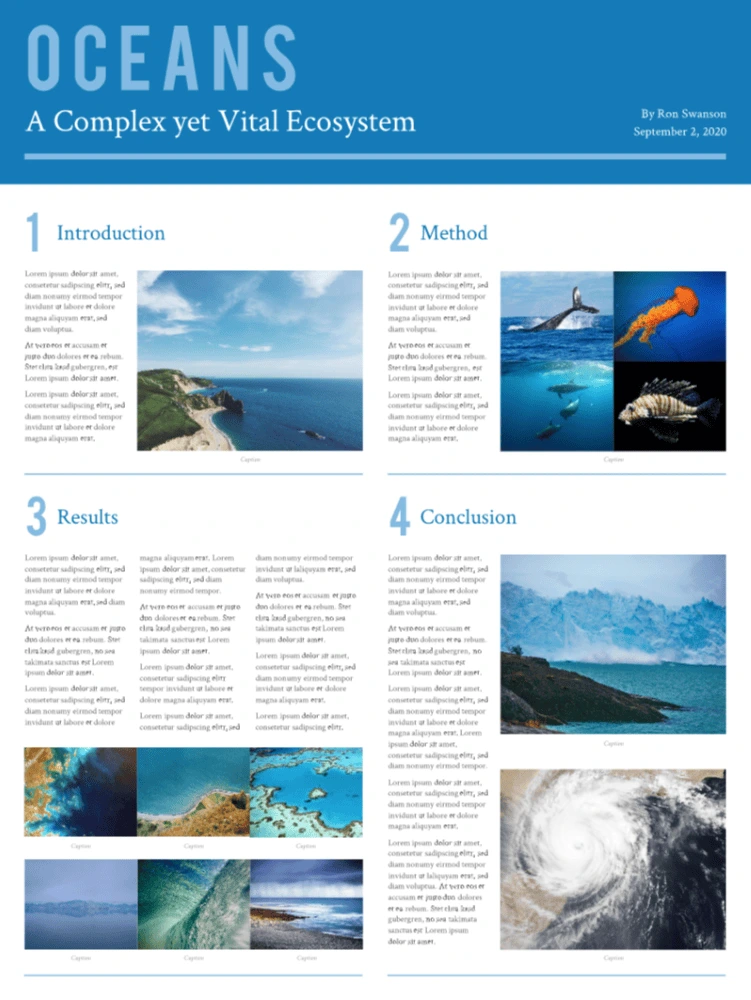
Here’s an example of a poster with small blocks of text.
6. Add simple data displays and visuals
Any scientific research poster that’s worth its salt will contain photos, visuals and charts that present the data in an appealing way. Many of us are visual learners, and it is these details—the graphics—that will really help your reader understand and appreciate your work. Ensure all graphics are a high resolution and are captioned with a brief explanation.
Make it simple with Lucidpress
To get started designing your scientific research poster now, sign up for a free account with Lucidpress. Our drag-and-drop editor makes it simple for anyone to customize our free, professionally designed templates or create their very own design from scratch.
As if that wasn’t enough, our cloud-based storage makes collaborating easier than ever before. You can forget the hassle of sending PowerPoint, InDesign or Illustrator files back and forth—with Lucidpress, your team can make updates in real-time and you’ll each have access to the latest version at all times. Once you’re done, you can download your poster in print-ready files or order a glossy print version directly from Lucidpress.
You’ve already worked hard on your research. Let us simplify the design process.
Feeling inspired? You can design and order your brand new poster right here in Lucidpress.
Jeff Bezos once said, “Your brand is what other people say about you when you’re not in the room.”
Your brand identity is the essence of your brand. It’s who you are, what you do, and how people describe your brand, based on the way you make them feel.
Related: 5 content tactics to ignite brand engagement with millennials
The problem is, people don’t always trust brands. They inherently don’t believe the identity you’re selling them is who you really are. That’s why you need to reach out to relevant influencers to validate the brand identity you’ve built.
Influencers reflect your brand identity
Just as you use a consistent voice and imagery across your content, the way influencers talk about your brand should sound like they are talking about the same person.
If multiple friends shared posts about a single friend online, you’d be able to tell who that person is. Likewise, when multiple influencers share posts about your brand, your brand identity should be clear.
When a person zooms out and views your various influencers as a group, the picture should make sense. Maybe they are all in the same age group, from the same city, or share a similar interest.
The most basic influencer marketing program would have a Venn diagram with one thing in the middle that all the influencers share. However, as your influencer marketing program grows and matures, you can envision several chains of interconnected circles that all tie together.
Lululemon’s ambassador program includes a diverse group of individuals from foodies to snowboarders to dance instructors, but they all share one thing in common: a life devoted to being fit.
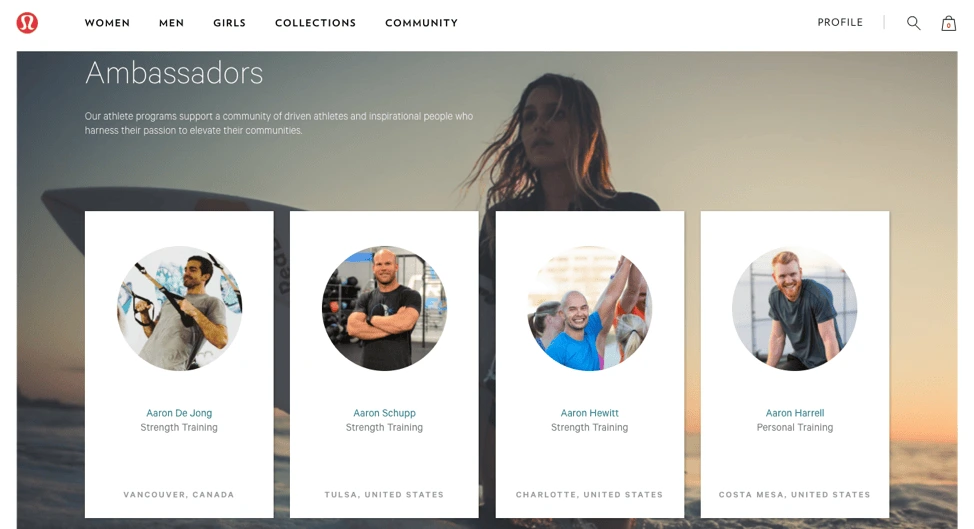
Work with the right influencers
You know the saying, “You can tell a lot about a person by the company they keep”? The same goes for brands. None of your influencer choices should seem jarring to someone who heard about you from another influencer.
That’s why it’s critical to do your research up front. This keeps you from running into problems of discrepancy; if you sell business software, it will come off as insincere—or worse, desperate—if you have a fashion blogger chatting you up. Your influencer’s personality and niche should match, or at least mesh with your brand, as someone you would associate with.
If your brand was a person, would they run in the same social circles as your influencer? Even if they might not do everything together, it makes sense for a fitness vlogger to promote a pet-sitting service if they regularly travel to weightlifting competitions.
Align your brand with specific types of influencers
If your brand is suffering from a case of poor brand identity, one way to fix that is strategically partnering with a targeted set of influencers. Of course, these influencers should overlap with your customer audience, and their values should jibe with your brand’s. But, a focused campaign can help your brand become known as “that one all the [fill-in-the-blank] bloggers love.”
This is a good strategy for breaking into a new niche or vertical. If your product is extremely specific, this strategy can work wonders. Your association with a niche set of influencers will quickly spread your name among potential customers and solidify your legitimacy within the community.
Take Royal Caribbean for example. Cruises have traditionally been viewed as a travel option for the over-50 age set. The cruise line wanted to attract more millennials, so they partnered with Periscoping travel bloggers via an influencer livestream campaign.
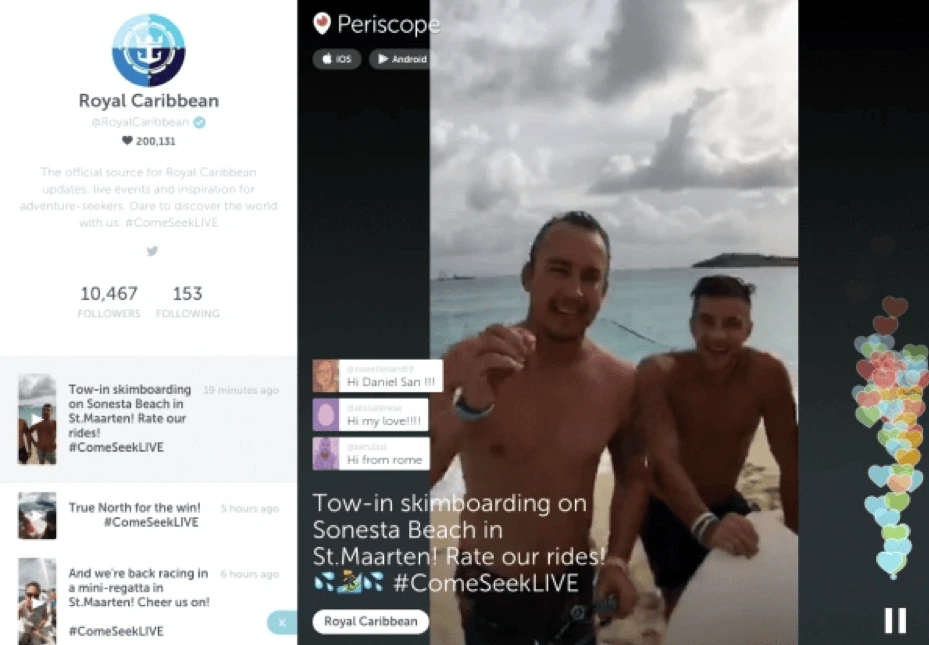
Give influencers what they need
The better that influencers understand your goals, as well as the ins and outs of your service, the better they can promote you. Give them what they need to understand your product. Then, they can create promotional content that feels authentic, rather than a one-size-fits-all sales pitch slapped on a pretty picture. You can guess which one is more effective.
Use influencers to make your brand real. Ask them to highlight how your free sample felt personalized to their needs or was delivered in a special way. Suggest that they talk about how your product solved a specific problem for them, or request that they mention an employee they spoke with at a store or over the phone.
Just as the laughs you share with a new friend help your relationship blossom, these little details are what shape a consumer’s relationship with your brand.
Key takeaway
The great thing about brand identity is that the more people talk about it, the stronger it becomes. [![]() ] And when those people are influencers, it becomes stronger even faster. If you have a solid brand identity, it might be time to find influencers who can help you drive awareness and adoption.
] And when those people are influencers, it becomes stronger even faster. If you have a solid brand identity, it might be time to find influencers who can help you drive awareness and adoption.
For brands, few objectives matter more than creating an impactful, positive impression. Because, if you can make a favorable first impression, it’s inevitable that good conversation — about your brand — will follow.
Now, keeping that conversation in your favor can be tricky. Ultimately, you want to maintain a consistent brand message and voice across all content. If the tone, voice, or visual experience is at all inconsistent, your target audience will likely become confused and you’ll lose their attention, thus impacting sales and customer retention. When your target audience doesn’t know who you are or what you do, it’s tough to expect them to remember or come back to you.
So what should you do to make sure your brand doesn’t take an unintended fork in the road? Well, here are a few strategies that make developing brand consistency easy for your sales organization.
Share a message that resonates
Want to stand out from the crowd? Start by zeroing in on your target audience with a message that speaks directly to what they want and what they need. Take customer feedback, pushback, pain points and reviews seriously — these are all goldmines for messaging information.
Communicate a clear brand message across the board with marketing (from print ads to social media) to sales (from initial pitch to closing time). Figure out who you want to reach with your message, then focus your energies on reaching that audience again and again.
Once you find a message that works, you ought to stick with it. Oftentimes, brands will tinker with a message too much and everything gets lost in translation, meaning the messaging loses focus and purpose.
Personalize the content experience
You want to highlight why your brand is uniquely positioned to solve the problem your prospective customer is experiencing. In other words, you want to give your customers good reasons to go with your brand over a competitor.
For instance, if your brand voice feels unique, you can progress up the sales food chain. If you don’t find ways to be unique, you get devoured by the latest trendy new thing. Alternatively, we’d recommend personalizing your customer’s content experience. Not only does this help you stand out in a crowd, but it showcases that you “see” your customers.
In your sales enablement content, be sure to focus on your strengths. A big mistake with branding is trying to do too much. It isn’t an effective strategy to be a jack-of-all-trades with all people. Your brand’s voice and content experience should be clear, compelling, unique and believable in each interaction with its target audience.
Offer influence and support outside of the buyer’s journey
Your brand voice is defined by how people see it. Influencing how people perceive your organization or your products is as important as getting consumers to buy from you — everything from demos to packaging impacts your brand’s overall perception.
Social media can be a powerful tool for crafting and shaping your relationships. Interacting with consumers and potential consumers can make it easier for you to create a conversation or gain quick insights about what you can do better. Social media channels are an incubator for ideas and will spur growth for your organization if used in the right way. They’re a great way to engage with customers and make your brand feel accessible.
Be prepared to enforce brand guidelines
If your marketing team is worth its snuff, it’s already created brand style and usage guidelines to ensure all messaging and visuals stay consistent. These guides cover how to use various brand assets in internal and external communications — including which fonts and colors to use, or the correct logos and slogans.
Guides like these not only help your organization’s marketing team, but they also serve as a useful reference for other employees, managers and departments — including sales — looking to create their own content. Ultimately, brand guides should align with your organization’s overall vision and mission. Brand consistency is much easier to achieve when grounded in the core principles that drive your organization.
So, always refer back to your brand guidelines and be prepared to enforce them when developing sales content and planning your outreach efforts. Customers will find you through more than one channel, which means multiple avenues exist to make an excellent first impression. Creating brand consistency across all of these channels is essential to ensure your brand stays memorable and top of mind.
Streamline branded content creation with Lucidpress
Lucidpress makes it a simple task to create a uniform brand identity and empower others in your sales org to create on-brand, professional-looking content. Plus, easy-to-use features like a drag-and-drop editor and advanced template locking take the learning curve out of designing.
So whether you’re publishing or updating a brochure, newsletter, one-pager, slide deck — or any other material your sales team needs — you can count on Lucidpress to ensure materials get to where they need to go, quickly.
Learn more about how to achieve consistent storytelling across your sales org in our free sales enablement workbook.
In real estate, it matters a lot what people think about your agency. We can all agree that, as businesses, we crave trust and loyalty from our customers. If these two traits are absent, success becomes much harder (if not impossible) to achieve.
Related: Real estate marketing guide & ideas
The consistency of your brand has a huge impact on what people think. If your real estate brand is constantly changing, people will see you as less honest and reliable. On the other hand, if your message is consistent and validates your brand promise, it’s easier to build trust with your audience and earn their loyalty.
So, where can you deliver this messaging? In real estate, there are several areas where you can achieve remarkable brand consistency. Here are five of them.
Property listings
Great property listings contain three elements: property data, description and photographs. Of these, the description accounts for the largest portion of the listing, so focus your efforts there. Write compelling descriptions complete with all the features and benefits anyone looking for that specific property would find valuable.
Each potential buyer has a particular set of expectations. If the description you write helps them evaluate the property against their expectations and make better decisions, that will set the foundation for a solid relationship with your real estate brand.
As you write, remember that brand assets like tone, voice, taglines & logos should always be consistent, and that your message should align with your brand’s goals as well as the needs of your target audience.
Neighborhood & home search
If you want to be the go-to real estate agency in your area, show your audience that you really know and understand the communities you serve.
Sometimes you’ll encounter potential home buyers who aren’t familiar with the area, and if you can become a dependable local resource for them, you’ll develop a trusting and loyal relationship.
Focus on what makes the neighborhood special and what homeowners usually consider when looking for a property. This could mean schools, hospitals, weather, culture, parks and local attractions. You could also request testimonials from people who live in the area and include them in your listings. Videos and photographs are great additions, too.
Responsive web design
Build consistency into how your website functions across all devices, from phones and tablets to computers. Regardless of how a person accesses your real estate website, the user experience should be cohesive and well-designed. If it’s not, your visitors could easily turn away.
Remember, your brand largely depends on how people view your business. If they can’t comfortably access your website on their tablet or mobile device, they will likely feel impatient and turn to your competition to get their needs met.
Without responsive design, visitors will wonder whether your real estate brand is old-fashioned, and they might assume you’re not up-to-date with new trends and technology. Instead, keep those visitors coming back by offering a consistent, excellent browsing experience tailored to their needs.
Pictures & video
We live in a visual culture. In real estate, this is supported by the fact that 83% of home buyers expect to view pictures of available properties, whether it’s through print marketing, a website or social media. [![]() ]
]
Your brand stands to benefit if your visuals come across well and emphasize points of interest. Photos should always be high quality and leave a strong, positive impression. Spend a little time learning best practices for real estate photography before hiring a photographer or taking photos yourself.
Video has evolved with trends like personalization and technology like interactive videos, 360 videos, and VR videos that are more immersive for the viewer. For maximum visibility, you can share them across multiple channels: your website, online video platforms, and social media. For example, here’s a video we made with the help of a few real estate clients:
Social media profiles
There’s no doubt that a huge portion of realtors (91%, in fact) use social media—and so do your potential buyers. Your social media presence will inevitably have a significant impact on how your brand is perceived.
The logos, colors & visuals used on your social media profiles will affect how your audience perceives and remembers you. Tone and voice are important, too—conflicting messages will confuse customers and dilute your brand.
Of course, authenticity and humanity are also important to social media users. Make it your goal to give your brand a unique identity and personality that your followers can easily relate to. This will help you cultivate a loyal following and stand out from your competitors.
Key takeaway
Brand consistency is about getting your audience to trust you. The five areas covered here hold a great amount of power to keep your brand consistent. Each plays a special role in getting clients to call you, to pay attention to your message, and to look forward to working with you again.
Your brand matters. Learn how to protect and elevate your real estate brand in this branding essentials guidebook.
Brand management is one of the most important parts of marketing. It can take a long time and a lot of work to create a brand image that people like and trust, but in an instant, all that work can be completely undone. There are certain situations businesses have to deal with that, if not handled properly, can severely damage the brand’s image. Here are a few common situations and how you should respond.
Related: Why brand equity is important & how to measure it
Problem #1: Having poor customer support
If you look up any public polls or surveys that list companies with the worst ratings, one of the biggest reasons is due to poor customer support. If someone calls you with a problem they’re having with your brand’s products or service, you will make a bad situation worse by making it difficult for them to get help from you. [![]() ]
]
Bad support is a good way of burning a bridge not just with that customer, but with their friends and family, too. After that, there’s more damage to worry about if they vocalize their discontent on social media.
To respond to this situation, you need to overhaul and clean up every line of communication between you and your customers:
- Make it easy for your customers to find your phone numbers and/or email addresses for support.
- Create a functional process flow to handle customers through your support channels.
- Make sure your customer support team adheres to that process.
The longer customers wait to get the help they want, the more annoyed they’ll be. They should be able to contact you quickly and easily. Most importantly, they should receive a useful response that resolves their problem. Auto-response emails and phone messages are simply not good enough in situations where your real customers are involved.
Problem #2: Failing to live up to your brand image
If you build your brand image around certain promises or guarantees for your customers, you had darn well better deliver on those promises and guarantees every single time. If you say you have the cheapest products, you’d better have the cheapest products. If you offer the quickest service, your service had better be very quick. If you have a satisfaction, money-back guarantee, then you need to take your customers’ dissatisfaction seriously and mitigate their concerns or issue a refund. Nothing can ruin a brand’s image like being inconsistent in living up to its own standards and promises.
If your company’s brand is starting to take a hit due to this, you need to take immediate steps. Get all hands on deck and start generating as much positive brand awareness as you can. The best way to do this is by delivering on the promises you make.
In the short term, that means doing what you can to raise your brand’s reputation, and in the long term, it might be shifting your brand’s image to something more realistic. For instance, if your business is not able to offer the cheapest products, change your marketing to start offering the friendliest service instead.
Problem #3: Getting negative attention from an employee
It is an unfortunate reality that how your employees behave, even when they’re off the clock, can reflect back on your brand. If they’re caught on the news, in a newspaper, or online behaving in an unethical manner—or even just in poor taste—your brand can get negative publicity from it. That’s why so many businesses include clauses in the employment contract regarding “off-duty conduct.”
From a brand image perspective, what should you do in this situation? First, be open and transparent to the public so they don’t think you’re covering anything up. Apologize to anyone affected by your employee’s actions, both publicly and in private. Second, look into how you are legally allowed to handle the employee based on that specific situation.
Finally, you need to be seen responding against the negative behavior in question. For example, if the employee went on a racist rant online, you can donate or form a partnership with an anti-racism organization and/or hold special seminars and training to improve tolerance in your company.
Problem #4: Offering a poor website experience
In today’s world, you cannot afford to have a bad website. The design can’t look old and dated; the navigation can’t be poorly structured so customers can’t find what they’re looking for; and the functionality can’t be compromised so they’re unable to perform important actions, such as completing a lead form on your site, completing an online purchase, or simply entering the buying cycle.
Even if your business is running smoothly otherwise, having a bad website that creates a poor user experience can really hurt your brand’s image. It can set a bad first impression if your users’ first interaction with your business is through a dysfunctional website.
The first thing you need to do is fix your website, of course. Upgrade the design or fix your theme and template, rearrange the navigation (site architecture) so it makes sense for your end-user, and fix any bugs or broken pages so that your visitors don’t get any site errors telling them your website pages cannot be found (404).
The next thing is investing in search engine optimization (SEO), then promoting the heck out of it. Create special promotions for the re-launch, start digital paid ad campaigns intended to drive new traffic to the new website, and retarget traffic from your old site back to the new site so they can see the difference.
Problem #5: Receiving a bad customer review
All of the above situations often lead to a customer leaving a bad review for your business online—on Yelp, Google, TripAdvisor, and other websites where customers review businesses. The worst thing you can do is ignore a bad review.
If reviews pile up and you don’t respond properly, your customers will assume you don’t care about them or their business, causing other people who look up your reviews to form a bad impression of your brand.
Make sure your business has an account on every major review website that your business gets reviewed on, and monitor them regularly.
When you see a bad review, take the information in the review and find out what happened before responding to it. Sometimes, the customer could be lying or omitting the truth, and you can point that out to tell your side of the story. Other times, your business legitimately failed the customer, but you can respond in a way that offers an apology and makes the situation right for them.
Want to know more about how to build your brand? Download our free ebook on how to build a brand in 2020.
Protecting your brand—not only how it looks but also how it’s perceived—is essential.
Your brand is everything that makes up how your customers see you, and if you’re not presenting a consistent message across the board, you run the risk of confusing, alienating or even frustrating your customers. On top of that, you’re missing out on the opportunity to establish your brand and grow recognition, authority and trust.
If you’re operating in a multi-location company with staff working in various departments, establishing a process to ensure brand compliance is key.
Related: 10 examples of great brand guidelines
Where once a central marketing team might have created and controlled all marketing output, we’re now working in a much more democratic and fast-paced world. Branding, content and communications can’t just sit with one team anymore; it’s become a multi-player, multi-platform game that almost everyone in your company is involved in.
So when artistic license, so to speak, is given far and wide, how do you ensure consistency across the board—especially when it comes to multi-location branding?
How to ensure brand compliance
For many companies, frequent barriers to brand compliance include:
- Overworked designers with too many requests and slow workflows
- Wasted time for designers when things move too quickly or changes aren’t communicated
- Content that isn’t on-brand (usually arising from the need for a quick turnaround by a rogue team or individual)
- Outdated brand assets where the latest versions haven’t been made available, aren’t centrally stored, or don’t exist
- No brand manager who’s enforcing the guidelines and implementing smarter processes
- Over-complicated branding that’s difficult to follow
Luckily, with a growing list of new approaches to these old problems, the future of your brand looks bright.
Ramp up your brand compliance efforts by employing these two fail-safe strategies.
Create and implement brand compliance guidelines
With the creation of effective and detailed brand compliance guidelines, you’re dramatically improving your company’s chances of consistency.
Our report on the importance of brand consistency revealed that companies are twice as likely to see a consistent presentation of their brand when formal brand guidelines are in place and enforced.
A typical set of brand guidelines will cover:
- Logo variations & dimensions, plus details on when and how to use them
- Brand colors for both digital & print
- Brand fonts, sizes & suggested uses
- Tone of voice & brand messaging
The goal with your brand guidelines isn’t to limit the creativity of your marketers and designers, but to give them a set of guidelines to work within. There should still be plenty of opportunity for them to come up with new and exciting ideas that comply.
When it comes to enforcing brand guidelines, you’ll do a whole lot better if you can take away the challenges your people face.
As an absolute minimum, make sure the guidelines are easy to follow and centrally stored so that everyone—including partners—can access them without hassle.
The next step is to support all your people (not just your designers) by providing the resources they need to comply. With clear guidelines and easy processes, you’re leaving little room for error.
Create shared resources & customizable content templates
This strategy—known as distributed marketing management—is becoming an increasingly popular option for growing organizations who take brand compliance seriously.
Rather than relying on an overworked design team to churn out request after request (often with a lengthy turnaround time), customizable templates put some of the responsibility back with the individual or local team.
A modern brand management system such as Marq will empower local marketers and salespeople to create their own content and campaigns that still adhere to brand guidelines.
With the introduction of innovative software like Marq, you’ll get the following benefits:
- Shared access to a single platform with permission controls
- A central resource bank where only the latest versions are available
- Access from anywhere with cloud-based storage
- Lockable templates, so edits can be made without compromising branding
- Intuitive software that’s easy for everyone
- Simple multi-channel distribution across print & digital
With a system like this in place, you’re giving your people the power to act quickly and take advantage of local opportunities without compromising brand compliance.
Further, by opening this process up to your partners and affiliates, you see even more rewards. When you can give them access to brand guidelines and templates that are locked down, they’ll have more independence when it comes to collaborating and cross-promoting. All without putting extra pressure on your marketing team.
Sounds like a dream, doesn’t it?
Key takeaway
Total brand compliance is achievable, but it takes forward-planning, smart software and well-thought-out processes. To give your brand the best chance of success, create and enforce formal brand guidelines and implement a central system for sharing on-brand resources and customizable templates.
Instead of trying (and failing) to do everything for your people, give them the guidance and tools they need to do things for themselves.
When shopping for a new home, real estate buyers want to know what it’s really like to stroll through the kitchen, stand on the balcony or lounge in the backyard. Since they’ll be investing years in a house or apartment, they want to imagine themselves in the space before they contact a real estate agent. Next to physically being there, listing videos provide the best experience for persuading buyers that their dream home is just a click away.
Related: Guide to an effective real estate listing marketing strategy
Although listing videos are big in real estate marketing, few real estate agents actually take advantage of the power of video to immerse and move buyers to purchase. The National Association of Realtors found that 85% of buyers & sellers prefer to work with a real estate agent who offers video marketing… but only 15% of agents actually use video to market their listings.
High demand and low supply gives those real estate agents willing to invest in video an edge in finding potential buyers. With a little practice, it’s easy to create real estate listing videos that’ll get your properties moving.
Planning shots in a listing video
You should already be familiar with the property, so make a shot list of all the rooms, outbuildings, porches, pergolas, and other pertinent features you want to capture beforehand. Focus on the interior first. Plan your shots like you would plan an actual walkthrough with a prospective buyer. Start with the entryway, then move into the living room or the next logical place. This will make the final edit feel natural as you take the buyer from shot to shot.
As a general rule, you’ll want your video to contain around 75% interior shots and 25% exterior. You don’t need to show every nook and cranny of the property. Concentrate on the most visually appealing and emotionally moving parts—the selling points.
One must-have is the “hero shot” that will be the climax of the story you’re telling. It may be a beautiful vaulted ceiling, an indoor pool or a breathtaking mountain view from the backyard. Whatever it is, your hero shot should be the star of your listing video, and you’ll want to place it where it has the biggest emotional effect.
Pro tip: Take still photos from all the vantage points you use to shoot video. Use the images to create a storyboard of your video. The images will work as reminders and guides for the best angles and spots to put your camera. You can import all of your images into a storyboard template and organize them how you want.
Estimating video length
Your video’s length depends on the size of the property. A video for a small, 2-bedroom apartment should be shorter than a sprawling 6-bedroom estate with 10 acres. To estimate length, take the number of planned shots and multiply them by 5 seconds per shot. That’ll give you an approximate run-time.
Ultimately, your video’s length should be dictated by the shots that you capture. You don’t want to rush past the selling points of the property, but you also don’t want to induce yawning. Remember, it’s a video, so prospects can play it back or press pause for closer examination, so err on the side of shorter. For quality control, enlist friends and family to critique the video before you publish it.
Using professional video equipment
Editor’s note: This section contains links to products on Amazon.com. These links are provided for reference only, and should not be taken as endorsements for any of the brands or products listed. Also, Lucidpress does not receive any payment or commission from sales of these products.
At minimum, you’re going to need a camera, a tripod and some editing software. Many of today’s smartphone cameras work well enough to produce decent video footage, but a DSLR camera is a better choice for quality and flexibility.
A fluid head tripod is a must-have. A good tripod keeps your camera steady and lets you produce smooth, fluid movements. Jerky camera movements distract viewers and make your videos look amateurish.
If you’re using a DSLR, buy a zoom lens with a focal length around 17mm-40mm or 16mm-35mm. Wide-angle lenses like these will capture a good chunk of a space without distorting or barreling the image. If your image is too rounded at the sides, your lens is too wide.
For basic video editing software, many operating systems already come with free versions, like iMovie or Windows Movie Maker. These programs are easy to use, but they’re also limited in their color-correction abilities, number of transition choices, and audio enhancement capabilities. To up your post-production game, invest in professional editing software like Final Cut Pro or Adobe Premiere Pro. Both come with powerful video tools but are harder to learn.
If you plan on capturing dialogue with your video, snag a lapel mic or shotgun mic and an audio recorder. However, recording dialogue is a difficult task, especially for beginners. It’s better to find stock music that creates a powerful, emotional effect in the background. Besides, you should assume that a large portion of people will watch your videos on mobile phones with the sound muted.
Pro tip: Handheld gimbal systems aren’t cheap, but they offer the ultimate in flexibility, compactness and convenience, letting you capture smooth, professional video without a tripod. Gimbal systems keep your shots steady even when you’re walking around, so you can create sweeping shots in any direction that look like scenes in Hollywood blockbusters.
Lighting the scene
You can go all out and invest in a basic photography lighting kit to make your listing videos look their best, or you can just shoot on a nice, clear day. Most of the rooms you’ll want to feature will be well-lit on sunny days, so take advantage of nature and show your properties in their true light.
For exteriors, shoot during the “golden hour,” that time just before sunrise or sunset when the sun is in the horizon and casting warmer colors. The warmer light makes exteriors more attractive.
Pro tip: Some of your interior lighting will come from tungsten bulbs, which produce a warmer color than daylight or fluorescent bulbs. When possible, replace tungsten bulbs with ones that have a color temperature of 5500K. When you keep a consistent color temperature in your scenes, it’s easier for your camera to maintain its white balance.
Prepping the area
Before you start shooting, take your shot list and walk through the house. Stow away any distracting objects. If the house is unoccupied, this might be stuff like cleaning supplies, drop clothes or painting equipment. If it’s still occupied, put away any clutter on kitchen bars, pick up dirty clothes on the floor, and take down family photos. If possible, also take down any mirrors that would show your reflection while shooting. Turn on interior lights when appropriate and open window coverings for better lighting.
Pro tip: Don’t shoot towards an open window. Your camera will struggle to balance the intense brightness of the window with the relative darkness of the interior rooms, and your images will suffer. Shoot with the camera pointing away from open windows, or cover them.
Shooting the video
You’ll only need two to three shots per room. You’re not shooting a film, so just get the best angles in the best lighting and move down the shot list.
For interior shots, get a few good tilts (up and down movements) and pans (left and right movements) of each room. If you have a tripod slider or steadicam system, also grab a few dolly shots, moving slowly from left or right. Multiple takes of the same space gives you more choices during editing. You don’t want every shot to be the same pan from left to right. That bores viewers. Instead, mix it up and provide them with a variety of views to hold their interest.
Set up your tripod so the camera is at waist height, not at eye level. Interior spaces look more attractive from a slightly lower perspective. Any pans, tilts or dollies should be slow and smooth.
For a pan shot, start the camera pointing at one side of the room, then use the tripod handle to slowly move it to the other side. Start and stop each camera movement with a five-second pause. This will create a “head” and “tail” for the shot, giving you some room to work with when editing them together.
For exteriors, you’ll need two to three shots that show the front and back yards, any separate structures, and any hero shots. But, don’t just piece together the whole property through multiple images. Prospective buyers want to see the entire home within the context of its surroundings, which could include the lawn, nearby structures or a body of water. Get at least two shots that show a more encompassing vantage point.
If you include shots that are static, use them sparingly. The viewer’s attention is captured by movement and color. You’re making a video, not painting a picture. Keep the action going.
Pro tip: If you want Hollywood-style shots that will really wow house hunters, consider renting an aerial lift for the shoot. These professional lifts get up to 60 feet above the property to capture high-angle aerial shots. They’re safe, easy to set up, and give you the platform to grab dramatic footage that will make your listing stand out.
Video storytelling in real estate
To really sell a piece of real estate, you have to connect with viewers on an emotional level. Good cinematography and editing is key, but without storytelling and music, you’re just presenting moving images. Storytelling can involve following a character as they move around the home doing domestic things, as in this listing video from Savvy + Co Real Estate or this one by The Boutique Real Estate Group.
But, storytelling doesn’t have to include actors or characters at all. It can simply suggest feelings and emotions that connect with viewers. For example, if the residence is occupied, use the existing furnishings to tell the story of the absent individuals who inhabit it.
That doesn’t mean going into personal details, but you could suggest how the spaces are being used by including a close-up of a child’s toy sitting on a dresser, or a porch swing as it moves in the wind. These personal touches tell the story of lives being lived in the home. Such images connect with viewers, letting them imagine their own lives there, turning a house into a home.
Pro tip: If you really want impressive exterior shots, consider investing in a drone. Every year, drones get smaller and cheaper, and the image quality for prosumer models works great for these projects. You could even use them to shoot interiors… if you’re brave enough. They’re challenging to learn, and you can’t just fly them anywhere (per the FAA guidelines), but their sweeping movements and intense aerials create emotional connections with viewers.
Related: Real estate video marketing — The ultimate content marketing tool
Publishing listing videos
Even if you produced a video that could make the list of top 10 stunning real estate listing videos, it won’t matter if no one sees it. Video hosting platforms like YouTube or Vimeo are the best places to store your listing videos. While YouTube provides unlimited storage, Vimeo only lets you upload a specific number of videos at a time. Both let you embed videos on your own website.
After uploading your real estate listing videos to YouTube or Vimeo, optimize them for search engines. Here are some things to include:
- Descriptive titles. Don’t just call it “Farm House Video.” Include more descriptive words like “Property at 1132 N Elm St.”
- Video descriptions. Include a short explanation of the video and property. Add your name, business address and website.
- Free or licensed music. Use either public domain music or licensed stock music so YouTube doesn’t flag your videos.
- Suggested videos. Set your channel to display “suggested videos” so viewers can see your other properties.
Pro tip: Hosting platforms are only one avenue for distribution. Digital lookbooks are mixed-media catalogues made from still images and videos that can showcase your properties in fuller detail. You can create and host them directly on the web for free.
Key takeaway
While these tips are helpful for getting started, rising above the competition means upping your game over time. Listing videos are getting less expensive to produce as equipment and software prices come down. Staying above the fray means finding creative ways to engage potential buyers. The best training is to stay current with video trends in the real estate space. They’ll show you where the benchmark is, and you can use your creativity and skills to exceed it.
Visual representation of your brand matters. Learn how to protect and elevate your real estate brand in this branding essentials guidebook.
In 2014, Marketing Sherpa published a report on customer acquisition costs (CAC) in e-commerce. According to this report, the median CAC is somewhere between $12 to $25. These costs add a lot of overhead to your business. If you’re a low-margin business, like most e-commerce stores, high customer acquisition costs can sink you fast.
Related: 8 killer email marketing tools for e-commerce
One way to bring CAC down is by building a bigger brand for your business. Branded e-commerce stores attract a lot of loyal customers. Such customers tend to shop several times throughout the year and are instrumental in improving profitability.
Let’s take a look at some strategies that can help e-commerce businesses establish themselves as a brand.
Establish stringent brand guidelines
The first step in the brand-building process is to establish stringent brand guidelines. These guidelines must include parameters like the “tone of voice” used in your messaging, logos, color palettes, fonts, photography style, and so on. Basically, it should cover anything used in your marketing materials.
To establish better brand equity, it’s important to accomplish two specific objectives. First, invest in building a style guide that will set you apart from the competition. This includes picking unique fonts and colors that aren’t common in your industry. You could also invest in creating unique image filters that will give your photos a distinct identity. Second, follow these guidelines across all your marketing channels: social media, website, TV, print and any other form of marketing.
A good example of this is Frooti, an India-based fruit juice brand. Although it’s not strictly an e-commerce brand, you can see that all their visuals adhere to a brand philosophy that includes flat design and a limited color palette.
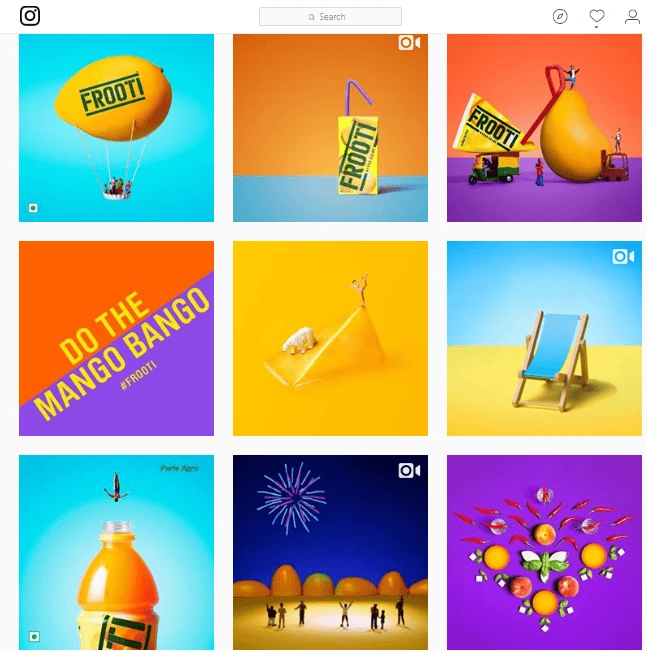
Source: Instagram
The reason this works is because your target audience tends to associate these visuals with your brand. This contributes to better recall and builds loyalty over time.
Pro tip: Lucidpress has a template-locking system that can help you adhere to brand guidelines consistently. Read more about it here.
Find your competitive advantage
There are many factors that contribute to an e-commerce sale. One of the most powerful ways to establish a brand is by identifying one factor where the rest of your competition sucks and mastering it. For instance, if you’re in a niche where the leading sellers take at least a couple days to ship, you might invest in overnight shipping. Alternatively, if all your major competitors charge for shipping, you could choose to offer free shipping.
This is exactly what Zappos did to establish themselves as the online shoe seller of choice. CEO Tony Hsieh realized early on that customers tend to have unique tastes for shoes, and in order to succeed, they’d have to make the return process ridiculously simple. The company provided its customers with prepaid return shipping labels that they could print for free returns. In doing so, Zappos outdid all competitors and established the most well-known brand in online shoe commerce.
The reason this works is because doing something better than others gets noticed by customers who then associate your brand with it. [![]() ] In addition to bringing word-of-mouth publicity, this strategy also gets your customers to return for future purchases. While such strategies can cost a lot of money, they also help to establish a brand name and improve customer loyalty.
] In addition to bringing word-of-mouth publicity, this strategy also gets your customers to return for future purchases. While such strategies can cost a lot of money, they also help to establish a brand name and improve customer loyalty.
Know your customers’ values
Learning your customers’ values means building a relationship with them that goes deeper than just producer/consumer. When people recognize and trust your brand, it’s because they see their own values reflected in it.
One of the easiest ways to learn about your customers’ values is simply to ask them. You could do some informal research on social media (or your blog) by covering certain topics and testing the engagement. Or, you could be even more scientific by conducting surveys and focus groups to learn more about the audience you’re pursuing.
After you’ve done this research, look back at your company. What do you already do that’s aligned with the values of your customers? These are the messages that will ring out the loudest.
When you can back up what you say with what you do, people will trust you and be drawn to your brand. [ ] Begin by looking for the values you already share with your target audience, then find ways to embody the others.
Know your brand story
For as much as things have changed in the world, people still love a good story. Whether it’s the story of a hero, an underdog, or simply the shared challenges and pleasures of the human experience, a good story moves people’s hearts and minds.
Every brand out there has a story—every one. The challenge is to share that story in a way that’s authentic and relatable. It might take some time to discover the best way to communicate your story to your target audience.
Start by zeroing in on your company’s purpose, or more specifically, the problem you solve. Let’s consider an example.
Say you manage an e-commerce brand that sells eco-friendly furniture and clothing. What’s your story? In short, you provide people with comfort and security in an environmentally friendly way.
But there’s something larger going on: climate change and the movement to address it. Your role in this global story is to meet people’s basic needs at a significantly lower cost to the environment. Your brand creates better harmony between humans and the earth, and people who care about the planet will want to help your cause.
In this example, your story represents and exemplifies your brand’s values. Positioning your brand as an environmental activist, or as a lover and defender of nature, will help you connect with your target audience. This powerful brand image comes from digging into the story, bringing to light what it really is.
L.L. Bean is a good real-life example of this. It started with a man designing his own pair of boots to make it easier and more enjoyable to walk around outside. But the larger story is about humanity’s love of nature. Through this narrative lens, you can easily recognize L.L. Bean’s brand. This is no coincidence.
Of course, your history might not be as deep as L.L. Bean’s, but it’s still meaningful. Take some time to find the best way to communicate your story, and it will clarify and reinforce your brand in the eyes of your customers.
Investigate influencer marketing
When it comes to ecommerce branding, customer trust is heavily influenced by the testimonials and referrals your business receives. Influencer marketing is one of the most effective ways to impact trust. This strategy involves hiring niche influencers (that is, social media users with thousands of followers in your industry) to spread the word about your brand.
Success with this marketing strategy relies on how targeted your influencers are. It’s a good idea to start small and reach out to influencers who have small audiences of less than 10,000—such influencers cost less and have a highly targeted audience.
Measure the impact of such a campaign and use the lessons to deploy larger campaigns. While partnering with large influencers outright might seem like a good idea to scale fast, these influencers appeal to multiple demographics and are thus not as targeted. The conversion rate from such campaigns tends to be lower.
The reason influencer marketing works is that prospective buyers tend to associate the credibility of the influencer with the brand they endorse. This makes it a much quicker way to establish a brand presence than growing your followers organically.
Pay attention to content authority
A typical customer goes through several stages of research before they land in your store for a purchase. Your store could miss on some real branding opportunities by not investing in content that the prospective buyer uses for research.
So, why is this important? First, it helps establish your brand as an authority in the industry. Customers trust authority sites which they return to for future product research. A comprehensive directory of articles could potentially make your website their “go-to” source.
It also provides your brand the opportunity to shape readers’ opinions and nudge them towards products in your store. Additionally, a comprehensive content directory helps your business rank better in Google searches, which reinforces your brand authority.
One of the best ways to do this is called the pair-up strategy. Essentially, marketers are advised to create a comprehensive content page that’s mapped to each of their product pages. Prospective buyers land on this central page during their research phase and are nudged toward the product pages through the content.
Key takeaway
Building a brand for your e-commerce business is an investment, but it’s one with dividends. By enforcing brand guidelines, finding your competitive advantage, and influencing buyers with great content, you’ll lower customer acquisition costs and develop an impressive reputation for your brand in the process.
Where to go next? Learn more about building & managing an online brand in our free eBook: How to build your brand in 2020
Higher ed is getting social. With such a large audience, from students, prospective students and faculty to alumni and sports fans, the potential for social media in higher education is huge.
Benefits of social media in higher education
Student recruitment
It’s a well-known fact that younger generations use their phones more than older ones. This is where they conduct research on products, services and organizations. Universities can (and should) take advantage of this for recruiting. If universities want to attract students, then they need to have an engaging brand presence online.
Related: How to take charge of your university’s branding
Build your brand
Social media can be a powerful tool for building brand awareness. From highlighting new research to showcasing student projects and achievements, higher ed social teams can play a powerful role in attracting potential students, faculty and donors to the university.
Boost student engagement
Engaged students are more likely to stay enrolled and graduate. They are also more likely to become brand advocates encouraging their friends, family and children to participate with your university in the future. Taking a fun or lighthearted approach with content on Instagram or Tik Tok will resonate with students in a way that official announcements won’t.
Higher ed social media strategies
Establish your brand
Whether your higher ed team has been using social media for a while or is completely new to it, you should make sure that your brand is well-represented on your social media accounts. You never want potential students to come across your profile and wonder if it’s the university’s actual account. It should be obvious. Some things that will help establish your brand on social media are:
- Username/handle: Keep usernames the same across all platforms. This way, students can easily find you on Twitter, Facebook, Instagram and any other platforms you’re on. If you’re concerned about being able to register the same username across all platforms (and don’t want your handle to end up like @Lucid_press0018), here’s a tip. You can create accounts on new social media platforms, even if you don’t want to use them yet. Later on, if you find that your audience is using that platform, you’ll already have the username.
- Images: Just as usernames should be the same across platforms, your profile pictures should be easily identifiable. Along with your profile picture, using similar colors (such as school colors) in your images will further affirm your identity. A tip regarding the images you post: choose one or two photo filters that fit your brand, then only use those filters on any images you post. This creates a uniform look for your content that will be recognizable to your audience.
A great example for establishing your brand on social media is Coca-Cola. All of the Coke accounts feel familiar. Each picture uses a similar filter that’s cohesive with their branding, and you can see red in all of their images.
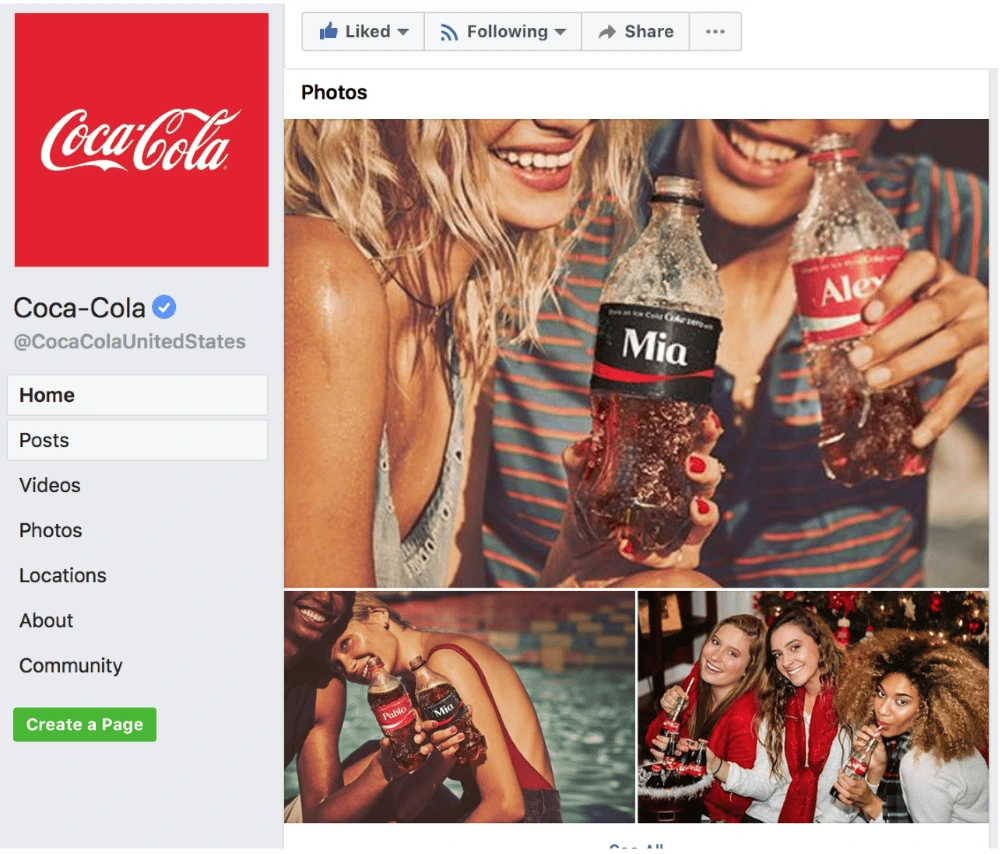
- Bio: Most social media platforms offer a place to include a bio for your university. Don’t waste this space. Bios are an excellent opportunity to show students what’s important to the school. You can even include a link to a page where interested students can learn more about the university (for example, by signing up for a newsletter).

- Tone & voice: Before you start posting, decide what your brand voice will sound like online. Will you be dry and professional? Will you use slang? The same goes for finding the right tone to use in your posts. Will you be happy, neutral, silly, snarky or witty? These decisions will shape your brand as people come to associate that voice with your university.
Speak to your audience
When it comes to social media, go where your audience is. Post content that’s designed for the platform and meaningful to them.
- Use the right networks: Are prospective students using Instagram, Snapchat or Facebook? Find out where your audience is, and start building a presence and community there. Some platforms might seem difficult to use as a university, like Snapchat. This is where you get to be creative and connect with students in innovative ways that no other universities are using.
- Create content specifically for your audience: What do potential students want to know? Share successes your school has experienced, student activities on campus, tips for prepping for college, what to bring to a new dorm room, what research is happening at your university, etc. Find out what your students are curious about, and create content that’ll be interesting and useful to them.
Harvard University’s social media often posts student-related stories that are relatable to other students. By focusing on the students, it shows that they come first at Harvard. Here’s an example of a personal story that was shared on the Harvard Facebook page:

Key takeaways
Social media is no longer a “nice touch” for your higher ed marketing plans; it’s essential to establishing your brand online. Build your profiles with consistent usernames and imagery. Create a guide for staff members that includes the colors, photo filters, logos, tone and voice to use in university-branded social media to maintain consistency.
Finally, make sure that you’re on the right platforms, sharing content that’s engaging for your audience. Use the same voice in comments, personal messages and public posts. Be where your future students are, and give them a reason to notice your university.
Every business owners’ hope is that their business will grow. Whether it’s a small, medium or large business, there’s always room for growth. It’s an exciting process, but it might be short-lived if you’re unable to manage your brand consistently.
Related: Brand consistency—the competitive advantage and how to achieve it
As you add more people to your team and start producing more content (such as landing pages, social media posts and ads), how do you keep everyone on the same page? How do you maintain brand consistency to keep your brand’s message clear and strong?
Here are five tips on how to do just that.
1. Create a brand style guide
With more employees and less time to look over every piece of content, it’s difficult to catch off-brand materials before they go out.
Create a brand style guide that shows employees how to use your branding properly. This will help your employees create on-brand content that shares a consistent look and feel.
Your brand is more than just the logo and colors that you use, so naturally, your brand style guide will cover more ground than that. Here’s a list of useful sections to include.
Mission
What does your company do? Lay the foundation for your style guide by first addressing your company’s goals and what you hope to accomplish in the future.
If you haven’t written a mission statement or want to spice yours up, here are some powerful examples.
- Patagonia: “Build the best product, cause no unnecessary harm, use business to inspire and implement solutions to the environmental crisis.”
- Walmart: “Saving people money so they can live better.”
- Wendy’s: “To deliver superior quality products and services for our customers and communities through leadership, innovation and partnerships.”
Target audience
Discuss who your target audience is. What’s most important to them, and why do they use your product? This will help your employees better understand who they’re talking to and why it’s important to communicate with your audience in a consistent way.
Values
When someone reads through your brand style guide, they should be able to relate to your brand and anticipate how your brand will respond in certain situations. This is why it’s important to have a section dedicated to the values of the company.
What values must come first in your company? By including these, your employees will know how to communicate with your customers.
Brand personality
Your brand personality comprises the characteristics you use to describe it. If your brand was a person, what would they be like? Professional, witty, funny?
If you’re struggling to think of characteristics that describe your company, survey your customers and ask them what personality traits they feel your brand has.
This helps bring your brand to life and give better depth to your brand’s voice, tone, messaging, and even its visual elements.
Visual elements
This section is where you put all the specifics regarding your logo, colors, typography and imagery. Provide as much direction with these elements as possible. For example, show each version of your company’s logo and describe how it should be used, where it should be located, when to use certain colors, etc.
For more help in setting up your brand style guide, check out our post on great examples of brand guidelines. You can also look at this 99designs blog post that goes into more detail about brand guidelines.
2. Pay attention to messaging & tone
Communicating with customers is often achieved through writing. Text appears on your advertisements, in your product, in blog posts and on your website—just to name a few examples.
Imagine how confusing it would be if you had a friend who always spoke with a Midwestern accent, but then one day, they showed up talking like a Californian surfer or a seasoned New Yorker? All of these accents are great, but you’d be pretty confused about what was going on with your friend. Could you even trust them anymore?
This is why consistent messaging is important for your customers. If the writing on your website uses a formal tone, but they receive emails from you that sound like a casual conversation, they’ll be wary—and rightfully so.
While creating your brand style guide, focus on describing your company’s tone and provide writing examples that fit your company’s voice.
When you read what other employees have written, give specific feedback about what is on-brand and what is not. Over time, they’ll learn which words, phrases and punctuation are appropriate for the brand.
3. Regularly train your team
Now that you have a brand guide for your employees, show them how to use it. If you don’t, your brand style guide will likely end up being ignored. If you can get your employees excited about your brand, they’ll be inspired to represent it well by following your style guide.
The opposite is also true. If you fail to get your employees onboard with your branding efforts, they may reject these new “restrictions.” This will promote more inconsistency and upset employees.
Keeping your brand consistent is a team effort that requires everyone to be onboard. Prepare an engaging presentation to introduce the brand style guide and strategy. Listen to their feedback, but make sure everyone understands the importance of consistency.
There might be a need for additional training for employees who are more involved in branding efforts such as writers, designers, marketers, customer service reps and managers. Once these employees are ready to build up your brand, ask them to share the same training with new employees as they onboard.
Keep an eye on the enthusiasm surrounding your brand. As it fades, you’ll have to recalibrate with reminders and additional training. It’s important for employees to know that you will champion the brand over the long term.
Key takeaway
When you focus on building a brand, the most important thing is to commit to it. No matter how well thought-out your brand is or how clever your messaging is, if it’s inconsistent, consumers will lose trust in you.
Create your brand guidelines, train your employees, find the right messaging and stick to it. The best companies in the world have championed their brands for decades. This consistency is part of their success—they’ve become familiar, beloved names for millions of customers. Lay the foundation for your brand today, so it can reap the benefits for years to come.
Want to know more about the impact of brand consistency? Download our free 32-page report, chock full of stats & great insights.
Have you spent thousands of dollars on direct mail campaigns with no luck?
You shouldn’t chalk it up to failure just yet. Every great marketing campaign has a solid follow-up campaign behind it.
Sending out three months of direct mail, expecting a deal to happen, and giving up is not creating a business. It’s dabbling.
On average, it takes 12 touches for a deal to happen. However, 44% of people trying to get a deal under contract give up after the first follow-up.
Related: 5 best practices of highly effective direct mail marketing campaigns
I see a lot of real estate investors sending direct mail to find off-market deals. The biggest hurdle most have is that they spend hundreds or even thousands of dollars on a direct mail campaign without obtaining any leads. Then, they send out the same campaign again the following month with the same results.
This is when most people either quit sending direct mail or buy a new list to mail because the old list “wasn’t working.” Not getting any leads from mailing a list doesn’t mean that the list didn’t work—it just means the people you were mailing weren’t ready to sell. Direct mail marketing in real estate is all about timing.
To get a consistent pipeline of deals, you have to implement a great follow-up campaign. This article will walk you through how to set your follow-up strategy.
Following up across multiple channels
The strategy outlined below uses multiple channels to complement your direct mail campaign.
Don’t worry, it’s not going to cost you much more. In fact, it’s going to make those 12 touches a little less burdensome on your budget. Let’s dive in.
Build the right list for direct mail
The first step, of course, is to send out your direct mail. To get rolling with this, start by pulling the list that you’re going to mail.
You can use a list service company like ListSource to purchase a list of people to mail. The types of lists you should be targeting are problematic lists like:
- Probate
- Foreclosure
- Tax-delinquent
- Divorce
- Vacant house
Make sure that you’re filtering out people who have little to no equity. To do this, set your filters to include people with 60-100% equity in their property. This will give you enough breathing room to get the property at a discount.
The other criteria you need to meet is Last Sold Date. We’ve had people call us and say, “I just built this house for retirement three years ago. There’s no way I’m selling it.” Granted, this may not always be the case, but we set our Last Sold Date to 8 years ago or more.
Figure out your farm area
Figure out what your farm area will be starting out. Remember that you have a smaller budget, team, and amount of time as you build momentum. Your farm area will grow as your deal flow grows. Focus on mailing an area that you can comfortably mail consistently every month.
If you work in an office, figure out the radius you want to farm around your home and work. Starting out, we chose a 20-mile radius. The distance isn’t what’s important—it’s how long it takes you to get to the houses within this radius. You don’t want to miss deals because you’re spreading your leads out too far and can’t get to all your appointments quick enough.
We recommend keeping it within 45 minutes. This will give you time to schedule multiple appointments each day as you consistently mail homeowners over time and the lead volume increases.
There’s a cool trick on Free Map Tools that lets you drop a pin, set your desired radius, and get a list of all zip codes within that radius. With this, you can easily pick the zip codes for your farming area around your workplace and home.
Optimize your postcards
What you put on your postcards is up to you, and how postcards perform in each market varies. For our market, plain white postcards with a handwritten font perform the best. (When your prospect has a stack of ten postcards that look like ads and one that looks like a hand-written note, which do you think will stand out more to that person?)
Regardless of the design, make sure you include your company’s name along with your website. The people receiving these postcards will check to see that you’re a credible company before doing business with you. We put Breyer Home Buyers and www.eastatlhomebuyers.com on all our postcards to make it easy to find us online.
If you’re sending direct mail solely to people who are going through a divorce, then you can create a divorce landing page with a URL like www.yourcompany.com/divorce. This gives you the option to retarget visitors using Facebook Ads and Google AdWords. You can do this with any mailing list: tax-delinquent, vacant houses, foreclosures, etc.
Call recipients about your postcard
Your list provider can give you phone numbers for contacts within your farm area. If you keep them in an Excel spreadsheet, you can upload them into a dialer like MOJO. MOJO lets you call hundreds of people in a very condensed timeframe. For our business, we average 71 calls per hour. Of those 71 people, we reach around 30 per hour. We use virtual assistants to call for us, which saves our company significant amounts of money.
To use MOJO, you’ll need a Skype account. MOJO connects to Skype so you can make calls within the U.S. for free, even if you use a virtual assistant.
Remember that when you’re calling prospects to follow up on your direct mail, you should mention your company’s name and that you sent them a postcard. This will jog their memory and make it more likely that they’ll look at the postcard again.
Retarget prospects with Facebook
You can use Facebook and Google Ads to retarget your prospects. Retargeting is cheaper than marketing to cold prospects with these channels. And these prospects have already seen your direct mail, landed on your website, and received a call from you. When they see your ad and click on it, they’re more likely to convert, which provides you with a higher ROI.
The other benefit is that most of us are too busy to immediately respond to marketing. Maybe your prospects were taking their kids out to eat when they drove by the mailbox and got your postcard. Maybe they were waiting on a meeting to start when they looked up your website. Maybe they lost your postcard and couldn’t find you again. Regardless, retargeting helps you pop back up in front of your prospect when they need it most.
Send an SMS blast
There’s no replacing a phone call, but sending a text message is a great way to get in touch with people who don’t like talking on the phone. We use EZ Texting to follow up with people through text. We simply upload an Excel spreadsheet of our contacts, then blast the same message to the entire list.
We usually send out open-ended questions like “Have you sold your property yet?” But, there’s no magic message. The goal is to start a dialogue, so you can make an offer to buy their property.
We’ve gotten several properties under contract without ever speaking to the homeowners on the phone, by doing all the rapport-building and negotiation over text.
Leave voicemails on landlines
Tools like Sly Broadcast let you pre-record a voice message and send it to the phone numbers on your list. It’s important to note that this service only drops voicemails to landlines, not cell phones. Using this in conjunction with the text blast will make sure you’re touching all phone types.
MOJO Dialer also drops voicemails when you’re power-dialing, but the key difference is that you are actually calling someone and will have to speak with them if they answer. With Sly Broadcast, the phones don’t ring, but a voicemail shows up on their answering machine.
Schedule your follow-up campaign
When we’re planning our direct mail campaigns, we schedule the arrival date of those mail pieces—meaning that we know (within one day) when those mail pieces will be delivered. We usually have our mail dropped on Tuesday because our response rates are higher on Tuesday.
Here’s what our follow up campaign looks like:
- Week 1: Direct mail delivered on Tuesday
- Week 1: Begin Google AdWords and Facebook retargeting
- Week 2: Cold call prospects
- Week 3: Text prospects
- Week 4: Voicemail drop
- Week 5: Repeat mailing to the same list
- Week 6: Repeat cold calling to the same list
- Week 7: Repeat texts to the same list
- Week 8: Repeat voicemail drop to the same list
With retargeting, you set it up once and keep it running. We don’t stop the Facebook and AdWords campaigns. Your goal should be to contact each prospect with a phone call, a postcard, a text, and a voicemail drop each month.
Why you should always follow up
Homeowners usually aren’t ready to sell when you first reach out to them. Granted, sometimes we do get lucky and close a deal on the first mailing. But, it usually takes us at least three mailings to get a deal from a campaign.
If you label your direct mail campaign a failure because you haven’t gotten a deal right away, then you risk missing out on future leads and give yourself zero return on your investment.
If you look out over the year and set a goal for 5 deals to get the real estate investing ball rolling, you’ll create a marketing plan to reach that goal. However, if you keep changing your marketing strategy because you haven’t given yourself enough time to make it work, then you’ll never reach it.
Ready to create your own direct mail designs in minutes? Check out our direct mail postcard templates.
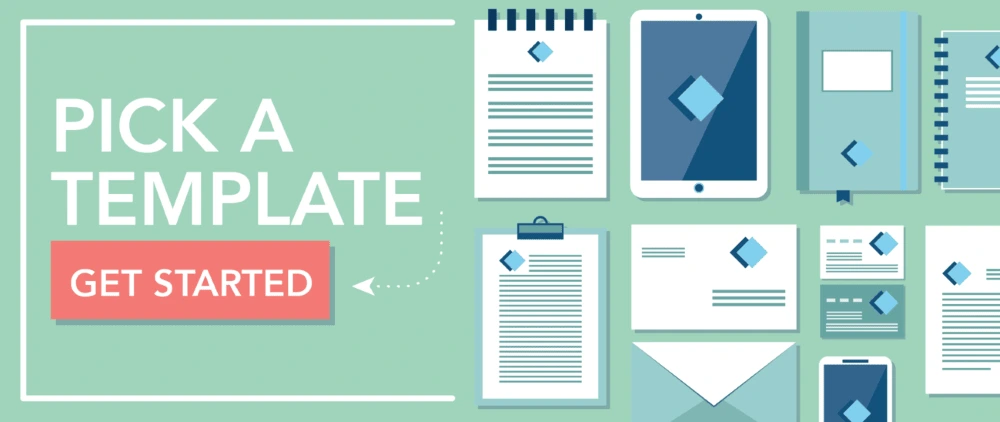
Or, learn more about the new direct mail features in Lucidpress and give it a test drive.
You’ve built a great website and have an impressive email database, and you’ve even built a decent following for your brand by following tips you’ve read in real estate marketing guides.
Now you want to know what content you need to keep you at the front of the pack.
Related: Real estate branding—a comprehensive guide
First, while it’s true Google likes fresh content, mediocre fresh content will not help you. Prospective clients look for informative, valuable or entertaining content that prioritizes high-quality visual design.
If you’re searching for ways to do that, here are our tips on how to post great real estate content for your audience.
Why content marketing in real estate?
Content marketing is a valuable tool for building up brand awareness and driving leads. Blog posts optimized to show up in search engines can drive organic traffic to your website saving you from paying for ads and media buys month after month. Building up a presence on social media as a skilled real estate agent can help drive referrals and help potential clients to think of you the next time they are considering buying or selling a home.
Generating real estate content marketing ideas
In content marketing quality is better than quantity. Agents will see a much higher return on investment by focusing on generating content that potential business leads will be interested in. Before sitting down and coming up with a list of ideas, think about what your overall content strategy will be. How will potential business leads find your content? Is there a particular content marketing platform you will use?
Some common channels include:
- Search engine optimization (SEO)
- Social media
- Communities such as Facebook groups
- Content co-creation
By selecting one or two channels to focus on you will be better able to come up with content ideas that will perform well. If you are focusing on SEO, use keyword research tools such as SpyFu, Ahrefs or the Google Ads planner to identify topics people search for that are relevant to your industry. If you’re focusing on social media, communities or co-creation, get to know what members frequently discuss and brainstorm content you can create that will be relevant and useful to that audience.
Hire a good writer
We’ve all been drawn to some click-baity content at some point, often because we’re drawn in by an enticing headline.
By now, however, most of us realize that anything that claims to be jaw-dropping (like “You won’t believe what happened to this third grader when he opened his lunch”) isn’t actually worth clicking. Your real estate clients want content with more substance—information that relates directly to the industry—and to get that, you need to find a good copywriter.
You might already have a talented writer on staff who knows how to write good articles about rent rates, homeownership and mortgage financing. Otherwise, you can reach out to a PR firm or real estate marketing agency that specializes in content.
What should you publish?
Whether you’re marketing an apartment unit in Chicago, Illinois, or a New York City micro-apartment, the place to start is with website copy, blogs and newsletters.
If your website has been around for a few years, make sure it’s up-to-date and that the copy is fresh.
Publish a blog post at least once a week, and make it better than all the regurgitated content out there. Newsletters can help you spread the word, and there are still many real estate pros who send newsletters by snail mail.
For a look at a few shining examples in the real estate industry, check out this list of the top real estate blogs.
Once you’ve mastered the basics, remember content marketing is more than just blogging. Visual content such as infographics, photos and videos perform well on social media and can better communicate ideas that are difficult to describe.
Repurposing a blog post into an infographic or video is also a great way to spruce up your email marketing and send engaging content to readers who don’t have time to read an entire blog post.
Long-form content such as ebooks or webinars are also effective lead generation tools. Provide a guide to buying your first home or investing in a rental property and ask for a name and email to access it. Then place your new contacts in an email campaign and nurture those leads into your next client.
What should you say?
Your website should clearly and cleverly explain who you are and what you do. Blogs can cover a variety of subjects that your clients are interested in, like:
- Saving energy
- Lawn care tips
- Home winterization
- Interest rate trends
- Financing pitfalls
Your newsletters should be more specific, covering:
- New listings
- Market trends
- Financing trends
- Economic projections
- Recent sales
Each month, you can highlight a relevant, timely subject like:
- Summer pest control
- Preventative HVAC maintenance
- Cleaning out the gutters
- Lawnmower winterization
Remember: You’re the expert
A client who’s trusting a real estate agent to sell their home or purchase a new one will feel far more comfortable if you can show you know the neighborhood inside and out.
That’s why your content should cover local interests like reviews of new restaurants, lists of local daycare centers, and articles about any subject that make it clear you thoroughly understand the community.
Expert guides are a great way to establish credibility. Try researching and writing about things like:
- How to finance your first home
- Cleaning up your credit score
- What to do after your offer has been accepted
- Avoiding the bad-faith offer
- How to market your first property
- Marketing tools you must use as a real estate agent
Key takeaway: Content rules
It’s a digital world, and content is king.
While there’s still plenty of room for traditional marketing, most of your content will be published online. Make sure it’s timely, well-written, and of course, original.
Most of all, your content should be engaging and informative. If you can provide value to your readers, they’ll remember you any time they need your services, because you’ve already established yourself as a professional who they can trust.
Learn more about building a strong brand with this free guide to real estate branding.
When you send out direct mail to prospects in real estate, it’s inevitable that you’re going to get calls from seemingly unmotivated people. If you’re not drawing motivation from your leads, then your competition will be converting your leads instead of you.
Related: How to follow up your real estate direct mail campaigns
Based on the process I use for my own business, this article will teach you how to answer calls from inbound leads and how to handle appointments.
Follow a call frame
A lot of gurus will provide everyone with a script, but if you’re following a script and the conversation steers away from it, you’re going to sound salesy and unnatural to your leads. You need to have a frame to work with rather than an exact word-for-word script, because the nature of your calls will be dynamic.
We follow a call frame that looks like this:
- Set your time frame.
- Set your agenda.
- Determine your outcome.
This makes your conversations feel more natural, giving you room to implement strategy as the opportunity occurs (instead of trying to bend the conversation to your will).
Set your time frame
Whether someone calls you in response to your direct mail campaign or you’re just returning their call, the prospect has no idea what to expect. Our goal is to inform them, so we put them more at ease.
Of course, sometimes the timing isn’t ideal. What if your prospect was taking a break at work when they called you, and by the time you call back, they’re hiding in their cubicle and whispering to avoid being overheard? You won’t be able to take them through the entire sales process on the call, cutting yourself short.
To avoid being cut off, we always begin the call by letting them know it should only take about 5 to 10 minutes, and we make sure that works for them. Most of the time, it does. On the rare occasion that it doesn’t, we schedule a time to call back when they’re able to talk. We want their full attention—so they aren’t focusing on when they have to get off the phone.
An example of how this introduction might sound:
“This call will take me 5 to 10 minutes to answer all of your questions, ask you some of our own questions about the property, and explain what the process will be moving forward if we decide that this house would be a good fit.”
Set your agenda
Along with setting the time frame, the introduction needs to tell the prospect what will be happening on the call. Remember, they don’t know what to expect. Most likely, they’re on guard.
We set the agenda of the call by acknowledging that they probably have a few questions for us, assuring them that we will answer their questions. We add that we have a few questions for them, and that if we are a good fit for them, we’ll proceed to the next step in the process.
When you set an agenda with your prospect, you’re building credibility and trust. You’re handling the call in a professional manner that sets you apart from your competition—especially when they’re getting handfuls of direct mail saying “We buy houses.” We’ve gone to appointments where homeowners had stacks of direct mail from real estate investors. Going the extra mile to build trust will definitely help you stand out.
Acknowledge their questions
When you mention that you’re aware they probably have questions, you’re giving them permission to ask all the questions they want. After all, selling a house to an investor is a big deal.
People traditionally sell houses through a realtor, which can take months to close. With an investor, it could take only a couple of weeks. There are lots of questions lingering in a seller’s mind, and they deserve to ask and be reassured that this is right for them. Transparency will only help you.
Inform them of the next step
Near the end of the call, we usually know whether or not it makes sense to move forward. This is where you remind them that, if this isn’t a good fit, it’s totally okay to say no. People love being able to say no because it gives them a sense of freedom and comfort in the process. They know that you won’t pressure them if they decide this isn’t the route they want to take. Once you take the pressure off, you can really dig into the motivations of the seller.
“If you’d like to get our best offer on the property, we’d have to come out to see it and verify that the conditions match our repair estimates. The appointment should only take 30 minutes to an hour. We’ll just walk through the property and check out the condition. After that, we can make you an offer, down to the penny. If that works for you, I can schedule the appointment for Monday at 1 p.m. or Tuesday at 9 a.m.”
Determine the outcome
Do you ever find yourself hanging up the phone with an inbound lead, wondering how the phone call went? Determining your outcome on the phone and setting expectations provides clarity on what you need to do next in the process—whether that’s determining it’s a dead lead, dropping them into the follow-up process, or going to an appointment.
So, you’ve determined that the prospect needs your services while on the phone. You’ll want to explain what the process looks like at the appointment. This includes how long it takes, what you’ll do at the property, when they can expect to receive an offer, and what their options are. After explaining this process, set the appointment. Now you and the homeowner have a clear idea what’s going to happen next.
If you determine that your services don’t align with the homeowner’s needs, then explain to them that you don’t want to waste their time and you don’t believe you’re the best solution for them. Always genuinely offer to point them to a service provider who could help them. Offer your network of real estate agents, property managers and contractors to see if you can help them further.
Determine their motivation
The goal of any call with a prospect is to determine their level of motivation. One way to gauge this is to “go negative.” This simply means to pull back from them throughout the conversation.
The analogy goes that, if you chase a dog, they will run away. But, if you run away from a dog, they will chase you. Going negative will help you determine if the person is a legitimate lead, meaning you’ll know whether they have a problem your company can truly solve. Simply put, you just act a little less interested in your prospect to see if it makes sense to do business together.
Examples of going negative:
- “It seems like a great property. I’m not sure why you would want to sell it.”
- “It seems like this property would make a great rental. Have you considered just keeping it and renting it?”
- “It sounds like you’re looking for top-dollar on the property. Have you considered listing it with a realtor? It’ll take a little longer, but you’ll get the most money.”
There are two benefits to using this strategy. One, you’ll flush out all the normal objections a potential seller could have by bringing them up first (prompting them to justify why that won’t work). For example, you might hear something like, “No, I hate working with realtors. I just want to sell it and be done with it.”
Flushing out the objections will clear a path for you. As investors, we have to make lower offers so that we can turn a profit for our business. If you don’t flush out the objections, you will get responses like, “You know what? That’s a little low. I think I’ll just keep it as a rental or list it with a realtor.” After you’ve flushed out these objections, they can’t use them anymore. They just told you they didn’t want to keep it, rent it or list it.
The second benefit is that you determine their motivation. Sometimes, we cover so many objections that sellers just say, “I don’t want to do any of this. I just want to sell it to you guys and be done with it. Give me an offer.” In the seller’s mind, you’ve become their best option.
“Just give me an offer.”
We encounter it daily. People will put on their negotiation mask and demand an offer over the phone. When we started up our business, we’d always try to justify why we need to see the property to verify its condition. It hardly ever worked.
So, we switched up our approach. When someone demands an offer from us right away, we ask, “Would you rather have an offer, or would you rather have our best offer?”
The obvious answer is that they want our best offer. At this point, sellers usually quit hassling us about getting a quick offer. We explain that, to make an intelligent offer, we need to see the property and make a list of repairs needed to get the offer down to the penny. This flushes out people who are simply shopping offers, and it saves your company time and money when you avoid them.
Key takeaway
Now you have a call framework to draw out motivation from your direct mail inbound calls. Don’t get caught up in the nitty-gritty of a script. Instead, focus on getting your prospect’s guard down, setting expectations, going negative to gauge their motivation, and setting an appointment with them.
Want more great tips on how to set up real estate marketing campaigns? Check out our comprehensive real estate marketing guide for ideas & inspiration.
One of the biggest challenges realtors face in today’s market is the planning and implementation of an effective real estate listing marketing plan.
The opportunities and expectations have changed and grown exponentially over the past decade or so, and with so many avenues and moving parts, it’s not easy to nail down a real estate marketing plan and stick to it.
Related: How to build a social media campaign for real estate (with templates)
The benefits of getting it right, however, can be huge, so it’s a challenge that every determined broker or agent needs to overcome.
Components of an effective real estate listing marketing plan
First, as a small or medium-sized real estate agency, you need a listing marketing plan that’s high-impact.
Why? Because you need every dollar to count. You don’t have the budget for this to be solely about brand identity—you need to move real estate listings consistently.
By building an intentional and strategic marketing plan, you’ll increase your chances of getting that tenfold. So, where do you start?
The important thing to understand is that every element that makes up your real estate marketing ecosystem should be connected, usually in more ways than one. That’s how you move your audience through the sales funnel.
To achieve that, you’ll need to start with an overview: a top-level view of how each aspect of your plan links together. A simple diagram will do the trick here, so long as it gives you a clear view of how everything is connected.
Start by creating a goal and measurable objectives for your marketing plan. Think of your goal as your overall vision for the plan. For example, a listing goal could be selling a listing at above market value. Measurable objectives could include having a certain number of attendees at an open house or a certain number of emails or phone calls from a direct mail campaign.
Once you’re goals are in place, it’s easy to identify which marketing strategies and tactics you should focus on in your plan. In your diagram, start with your goals up top. Then link to your objectives and list each strategy under that.
Once you have that, you can begin to look at each element individually to ensure you’re maximizing its effect. More on that shortly.
First, a reminder that this isn’t about throwing out the feelers to see what sticks, only to try the same thing again next year because you’re not sure what really worked.
For everything you do, you’ll need to follow these three critical steps:
- Measure
- Analyze
- Refine
If you’re serious about making this work, you must implement processes for measuring your efforts. Then, once you’ve got the data, sit down with all key decision makers to analyze what’s working. From there, you’ll be able to refine your plan and make improvements for the next phase.
Creative marketing ideas for your listings
Now, let’s look at some of those individual elements of the real estate marketing plan in more detail. And remember, in everything you do, look for ways to connect your activities and move your leads through the sales process.
Door-knock in the local area
To get ahead of the game before your listing gets published, why not canvas the surrounding properties?
Your sellers’ neighbors might know someone who’s looking to move into the area. They may even be interested themselves.
Briefly describe the house or property, or show a flyer if you already have one, then open up a conversation about any potential interest.
Don’t forget to leave them a card in case an idea comes to mind later, and be sure that this card connects them with other elements of your marketing.
Post a “coming soon” photo online
Another way to get a head start with marketing listings is to preview the property online or on social media before the full feature goes out.
Take an appealing, well-lit photo showing off one of the property’s best aspects or features. Post it with a caption that drives curiosity and engagement.
To ensure this element fits within your strategically connected marketing plan, you’ll need to think carefully about when and where you’ll release further information. How will you make sure any early interest is followed up on? Perhaps you could ask your audience to subscribe to a mailing list to be the first to find out more.
Hire a professional photographer
An absolute must, if you want to compete in today’s real estate market, is quality photos. With so much competition for consumers’ time, especially online, publishing quality images is a good tactic for capturing attention.
Invest in professional shots that show your listing in its best light and you’ll stand a far better chance of attracting buyers.
Use as many photos as possible
Similarly, your listings will carry more appeal if you include at least 12 photos. In fact, the more the better. Don’t be afraid to use upwards of 20 or even 30 if you can.
Try to show each room from different angles, as well as the exterior from various viewpoints. You could even include photos of the views from the front and back of the property, as well as capturing the outside spaces.
Do everything you can to help potential buyers visualize themselves in the property.
Use video
Reports from the National Association of Realtors show that 85% of buyers and sellers prefer to work with an agent who offers video, yet only 15% of agents use video when marketing listings.
Get ahead of the curve and take your listings to the next level with video tours and 360-degree images or clips. Not only will this help you stand out and attract more interest online, it’ll help potential buyers feel more familiar with the listing from the start.
Related: How to create stellar videos for real estate listings
Be descriptive and emotive
Take the guesswork out of it and help buyers connect with the property by including detailed, descriptive summaries of your listings.
Look for opportunities to add character and memorable details. Use language that evokes positive memories and emotions.
Most of all, remember that good advertising copy doesn’t just list the features, it sells the benefits. Paint a picture of how good life or business could be for your potential buyer and you’ll be helping them form an emotional connection.
Produce quality marketing materials
Though it might seem like it sometimes, it’s not just the online channels that matter. Direct marketing (that’s flyers, brochures, letters or postcards sent to mailboxes or posted through doors) still has its place. In fact, it can even yield higher results.
But, like with any investment you’ll make in marketing collateral, it’s only worth adding it to your real estate marketing plan if you’re going to do it well.
Choose high-quality paper, use professional photos, and keep your branding consistent across all channels and materials. When it comes to adding a call-to-action, think carefully about what you want the reader to do next. Should they visit the website or call you directly? How will you move them through the sales process?
Related: How to follow up your direct mail campaigns
Feature the listing in your newsletter
When it’s maximum exposure you’re looking for (which is most of the time when you’re marketing listings), you’ll need to take advantage of every channel you have.
Your agency’s newsletter, if it’s been managed well, should be a direct line to your most engaged audience, meaning there are potential buyers on that mailing list waiting to hear from you.
Take advantage by featuring your listing in the next edition and be sure to let all recipients know where they can go to find out more. Remember—a connected marketing strategy is what you’re aiming for here.
Related: 8 tips to get more responses to your email marketing
Send the listing to other agents
Make use of your network to enhance the success of your listing marketing by sending out an email to introduce the property.
Ask your contacts if they have any buyers who might be interested and offer them the same support in return.
It’s through building relationships and partnerships like this that some agents are able to maintain a consistent income.
What if it still doesn’t sell?
When you’ve completed every strategy in your marketing plan and a listing still isn’t selling?
While the seller might expect you to spend more on advertising, you know deep down that it’s the price that needs to change.
Remember this phrase and use it to help explain your position to your clients: “If it’s not compelling, it’s not selling.”
There are typically three types of listings that can be compelling at a higher-than-average market price. These listings are opportunity properties, exclusive properties, and turnkey properties with no competition.
For everything else, the price matters, and if it’s not compelling, it’s not selling.
To soften the blow of a drop in price, make an effort to understand your seller’s point of view. Often their ideas will be based on what they’re hearing in the national media, which you know doesn’t always translate locally.
Break down the data for your clients by showing them the statistics in four different subsections:
- National
- State
- City
- Community
Once they see the difference laid out in front of them, they’ll find it easier to accept your push for a more compelling price.
Once they’re convinced, you can make it compelling, create excitement and then—potentially—you’ll have a bidding war on your hands.
Key takeaway
The key to building an effective real estate marketing plan is to connect the many elements and moving parts. If you can do that well and use those connections to guide potential clients towards your end goal, you’ll see consistent results and a strong ROI.
Want more great tips on how to set up real estate marketing campaigns? Check out our comprehensive real estate marketing guide for ideas & inspiration.
In some ways, starting a magazine today is easier than ever. But in others, it can be more difficult. All of this is due to the internet. The web puts free information at everyone’s fingertips, instantly available through mobile devices, which has transformed the magazine industry. It also gives every person online the opportunity to create high quality content and express themselves to a wide audience.
Related: 5 ways to monetize your online magazine
In this beginner’s guide, we will discuss how to start a magazine online. The guide is broken into three stages, outlining the work that happens before, during and after production. The first stage is brainstorming, followed by creation and collaboration, and finally, distribution. There’s a lot to cover (no pun intended), so let’s dive in.
Ready to start producing your magazine? Dive in right here with Lucidpress’s free online magazine maker.
Before production: Brainstorming
1. Develop your business plan
Before writing a single word for your magazine, sit down to develop a business plan. This includes your mission (the reason why your magazine should exist), your goals, and how to attain them.
Important questions to consider in your plan:
- What is the concept or focus of your magazine? This should be brief and concise, like an elevator pitch. For example, take a look at this copy from TIME magazine’s “About” page:
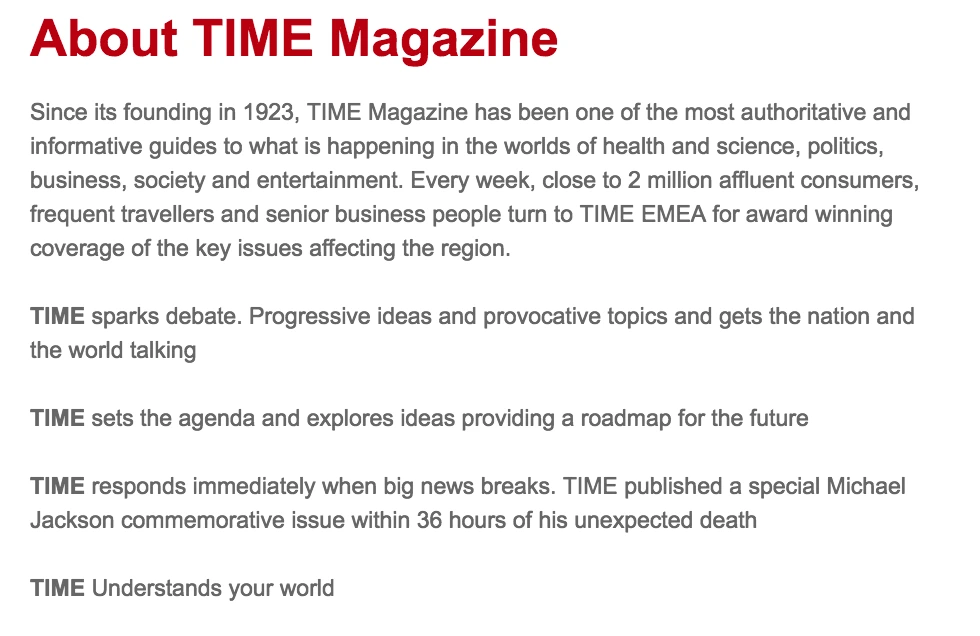
- Which topics will you cover, and in what depth? Consider your tone & voice—there is a big difference between The New Yorker and OK! Magazine, and you should be consistent.
- Who is the primary audience? Remember, your magazine should speak to others, not just yourself. It’s also important that your audience has a “continuing need” for your content, so they’ll want to subscribe and read more. Think about your audience’s lifestyle, and cater to the issues and ideas they care about.
- How will the first issue be funded? Many magazines earn profit by selling advertising, but it can be hard to attract advertisers at first. Some suggest using personal capital to fund the first issue—raised by saving money, seeking investments, or leveraging the power of crowdfunding.
2. Research the landscape
There are lots of magazines out there already, both digital and in print. Now is the time for you to spend some time at the newsstand (or in your reading app of choice) to evaluate the competition. This will give you a better idea of what’s already being covered and how you can differentiate your publication. It can also reveal gaps and opportunities that are currently not being met in the market, which you can use to your advantage as you develop your magazine concept.
3. Build your team
A magazine is a heady endeavor, one that you shouldn’t undertake alone. Build your team and divide your workload in order to prevent burnout and deliver faster, better results. Your magazine will be stronger for it. Here are a few staff roles you might want to consider.
- Writers — Magazines are driven by great content, so of course you’ll need great writers to make it work. Maybe you keep it in-house with a few trusted authors, or maybe you reach out to freelancers to submit pitches. Either way, be clear with writers about your editorial expectations and whether you’re offering any compensation for their work.
- Editor — At the end of the line, there should be one pair of eyes to give each piece of content the final yay or nay. The head editor ensures consistency and quality by reinforcing your editorial standards. This includes tone of voice, grammar, mechanics, and even the reach and scope of each article. When you have a strong editor at the helm, the finished magazine will be polished and cohesive.
- Sales manager — If your magazine will feature advertisements, a sales manager is indispensable. This person will serve as the point-of-contact for advertisers who will pay for space in your magazine. Having one person available to address their questions and concerns will help you build a better relationship with them, which in turn will lead to higher, more sustainable profits.
- Marketing manager — Your magazine needs advertising, too! A marketing manager will work to get attention for your magazine, making sure it’s present in all the right places. For example…If you’re launching a magazine in print, you’ll need distributors in bookstores, newsstands, and other public places. If you’re launching online, there are many channels for you to explore, from search engine ads to social media. Part of this person’s responsibilities will be deciding which distributors and channels are best for your magazine, and then creating materials (press kits, promotional content, etc.) to support them.
- Publication manager — Here is someone who gets down to the nitty-gritty of publication. This person will help you choose a printing partner who meets your needs, both in terms of quality and budget. What will the paper cost? How do the colors look? Are there any errors in the finished product? A publication manager will focus on these seemingly minor details that, in reality, make a huge difference.
- Partnerships / groups — These are helpful connections who aren’t necessarily part of your team, but can steer you in the right direction. Partnering with relevant brands can bring more exposure to your magazine, as they share their audience with you. Certain groups made up of local or indie magazines exist to share advice and opportunities with one another, harnessing power in numbers. Take a look around in your community and introduce yourself.
During production: Creation & collaboration
Now it’s time to start creating content and collaborating with your team. This can be a very hectic time, but it’s where the magic happens. If you’re inspired to publish your own magazine, you’re likely familiar with the following steps—but let’s review them anyway.
4. Writing
Finally, time to create articles for your magazine. Depending on its concept, this might mean a few different things: fiction or non-fiction, short stories, journalistic articles, how-to guides, reviews, or even a blend of all of the above. This step encompasses the writing process, from conception to pitch, and from researching to drafting.
5. Editing
It’s not uncommon for articles to undergo more than one round of revisions. Far more than just catching style and grammar mistakes, editing will help the writer focus and elevate their writing. Editors can help with fact-checking as well. Together, writers and editors cooperate to make an article the best it can be.
6. Proofreading
After an article has been written and edited, careful proofreading is required to ensure quality and accuracy. Any typos or errors that made their way through the writing process will be squashed here. Unlike editing, proofreading is not an evaluation of the article’s style, tone, organization or effectiveness. The focus is solely on finding and eliminating errors, so the finished product reads professionally. The person who proofreads might very well be the editor too, but these are still two separate stages of production.
7. Graphic design
The way we enjoy magazines is different from how we consume a book or a newspaper. Although each of these publications provides information, magazines in particular are known for being visual. From elegantly gorgeous to colorfully flashy, magazine design runs the gamut. Your graphic designer is just as responsible for your magazine’s tone and feel as your writers are—if not more so. It’s important for your graphics to match your words. Remember, magazines are less about the information and more about the lifestyle. Browse these magazine design templates for some inspiration.
8. Photography
Stock photos are okay here and there, but they’re no substitute for custom photography. Rather than searching for pictures to match your vision (and often, settling for less), a photographer can work with you to capture the pictures you really want. Color, lighting, subject, quality… All of these photo elements contribute to the reader’s perception of your brand. After all, that’s why they say a picture is worth a thousand words. (Or, at least, it’s why we say it.)
9. Make a prototype
Just like with any product, you can’t mass produce until you have a definitive, finalized version. All of the content, words and images are firmly locked into place with no errors or further changes. Holding your first finished prototype (whether in your hand or on a tablet) is a proud moment. Savor it! You’ve put in a lot of work to get here, and there’s still work to be done. You are now ready to start sharing your magazine with the world.
10. Digitize
You probably created your magazine using computer design software, but that doesn’t mean your file is ready to distribute. Different publishers and reading apps have their own standards in terms of file type, size, quality and so on. Make sure you’ve researched and complied with those standards in order to prevent delays.
After production: Distribution
11. Find a printer
Your printing partner is a critical ally on your way to distribution. If you’re only hosting your magazine online, well, you’re off the hook on this one. But if you intend to share hard copies of your magazine locally, regionally, or even nationally… you need a printer you can trust to deliver satisfactory results every time. Do your research, ask around, and interview printing partners until you feel confident that your pick is a good match.
12. Establish your online presence
Perhaps more than any other step, this is paramount to launching a successful online magazine. Your online presence can take many forms, from a website to a blog to social media channels, and maybe even all of the above. What’s important here is building a community of people hungry for your content. People who share the lifestyle and values of your magazine, so they’ll appreciate its message. Find out where those people are online, and make sure they can find you.
13. Decide whether to paywall
This is a tricky question in today’s publishing world. If you paywall all of your content, it might be hard to attract new readers. But, you can’t give it all away for free, either. Striking the right balance between paid and free content might look different for every publication, so experiment to see what works for you. A good place to start is sharing free content and article excerpts on your blog but charging a flat price or subscription for each magazine issue.
14. Build a community around content
Your readers can (and should be) be your best brand advocates. When you foster a strong community on your blog, forum, or social media pages, it gives readers a shared sense of belonging. Discussions are far more interesting when readers get involved, and they can provide you with inspiration and direction. Think about how you can use various types of content to delight your audience. Beyond the pages of your magazine, there are many opportunities. For example, you could start a branded YouTube channel to share vlogs and other video content.
15. Congratulations!
After months of work, you have started an online magazine, and you’re on the track to sustainable growth and success. Once you get to this point, there’s only one thing to do… Get started on the next issue.
Ready to begin?
Want to start your own magazine online? Lucidpress will streamline the design process for your whole team. With our intuitive drag-and-drop interface, you can select from gorgeous templates and customize with fonts, colors, shapes, images and more. Invite others to collaborate in real time, and when you’re done, export in a variety of print-ready formats.
Inspired to create your own digital magazine? These free magazine templates are a great starting point.
Marketers are getting inventive with their opt-in freebies, offering software, interactive quizzes, and entire video trainings in a bid to grow their email lists and generate interest for their products or services.
But in spite of all these creative possibilities, there’s still one type of lead magnet that hasn’t lost its rustic charm: the PDF download.
Related: Save time with these 5 amazing eBook templates for content marketers
It’s easy to see why. PDF content, such as ebooks & white papers, is cost-effective, easy to produce, and—believe it or not—still converts.
Did you think PDF downloads were dead?
Overthink Group did a study of HubSpot’s most popular lead magnet types in 2017, and eight of the top ten included PDF-type content—whether ebooks, how-to guides, slide presentations or templates.

Aside from ebooks, here are a few other PDF content types that are as popular as ever:
- Cheat sheets
- Checklists
- Case studies
- Industry reports
- Expert interviews
- Resource lists
All of these formats are easy to digest, offering new subscribers the instant gratification they seek. As a bonus, they’re less expensive and time-consuming to produce than a full-blown video course.
Today, on-brand lead magnets are easier to create than ever. With a desktop publishing tool like Lucidpress, you can start with an existing template or create your own using the drag-and-drop editor.
After you’ve created your lead magnet and a landing page to host it, it’s time to get some eyeballs on it. Here are nine ways to do just that.
Tell your audience about your latest free offer
Lead magnets make handy tools for building an email list, but they can also be shared with your existing audience to generate more buzz or segment email subscribers based on their interests. Incorporate your ebook into your full content strategy.
Your existing audience includes your clients or customers, social media followers, and current subscriber base. Ask them to check out your latest resource and to consider sharing it if they find it useful.
Don’t forget to link to your lead magnet in the following places:
- Social profiles
- Pinned tweets on Twitter
- Pinned Page posts on Facebook
- Facebook Page CTA button
- Gravatar profile
- Forum signatures
Feature it throughout your website
Your website can be your best promotional tool. By strategically placing opt-in forms and links to your free offer throughout your site, you can control which type of visitor sees your offer and when.
If you want to get a bit more creative, here are a few more ways you can showcase your lead magnet on your site:
- Link to your landing page from your website’s main navigation (e.g. “Free Stuff”).
- Create an attention-grabbing sidebar graphic and link it to your landing page.
- Announce your lead magnet using a floating notification bar.
- Experiment with slide-ins, welcome gates and lightbox popups.
Certain types of opt-in forms, such as those that obscure the content, can be frustrating for mobile users, so consider displaying a different type of form depending on the device a visitor is using.
Link to it in your email signature
How many emails do you send in a day—or a week?
Your email signature is prime real estate for promoting your latest offer.
Create a professional and eye-catching signature with a link to your landing page and a bit of text enticing your email recipients to click. Using a free email signature generator like WiseStamp, you can easily add a CTA to your sig:

Promote it via your blog
Indirect promotion of your lead magnet via your blog can be a more effective long-term strategy than repetitively plugging your free offer.
The bottom of every post is a logical place to include a call-to-action. For example, you might add a post-footer opt-in form or invite readers to visit your landing page.
You can also link to your freebie within the body of your posts when it makes sense contextually. Use an attention-grabbing callout box or try the subtle (but highly effective) two-step opt-in form, which doesn’t display a form until the user clicks on the link.
Whenever you publish a new post, notify your audience via social media and your email newsletter. You can expand your post’s reach with some additional promotion techniques:
- Share your posts in relevant online communities.
- Answer questions related to your industry on Quora, and include a link back to your article for people who want to learn more.
- Reach out to the other websites linked to in your posts.
- Comment on popular blog posts in your industry, and include a link back to your post when it makes sense to do so.
Link to it in your guest author bio
Guest posting is still one of the best ways to reach new audiences and generate powerful backlinks to your content. In exchange for a well-written article, many websites will let you include a call-to-action and a link to a landing page of your choice.
To help you narrow down which blogs are worth writing for, use free tools like SimilarWeb and Alexa to get estimations of a domain’s traffic, and the MozBar Chrome extension to compare the domain authority of guest post prospects.

If you plan to do a lot of guest posting, it’s worth investing in a keyword research tool to help you choose article topics that 1) are relevant, 2) people are searching for, and 3) the host website has a good shot at ranking for. This will boost the visibility of your guest articles and the quality of referral traffic to your landing page.
Share it in relevant online communities
There’s a group for every professional subject.
Online communities—Facebook and LinkedIn groups, Google+ communities, subreddits, public Slack channels, etc.—offer a place to get support from experts, develop business relationships, and share your latest work.
Instead of trying to be everywhere at once, you can get more mileage by choosing a small handful of high-quality groups and being active in them. Get to know the group culture and participate in the discussion before attempting to drop any links.
In many groups, self-promotion or links are not allowed, although some group admins have a weekly “show-and-tell” day as an exception to this rule.
If group admins seem strict about self-promotion, don’t automatically write it off as a bad group. Often, heavily moderated groups are higher quality—and they tend to relax the rules for members who regularly contribute to the community.
Drive traffic to it with Facebook ads
With Facebook ads, you can generate sign-ups right on Facebook or drive traffic to a page on your website, like Marketo is doing with this ad:

If you’re curious to know the average CPC, CTR and conversion rates for your industry so you can see how your Facebook campaigns stack up, check out this study by WordStream.
Repurpose it
Repackaging your lead magnet into other formats and distributing it across multiple platforms is an economical way to generate more interest and exposure.
For instance, you could share pointers from your ebook in the form of YouTube videos, SlideShares, Medium articles or social media graphics, with a link to the download page.
PDF content can also be repurposed into offline marketing collateral—such as brochures, booklets, newsletters and flyers—and distributed to prospects at networking events and trade shows. (Not to brag here, but Lucidpress can help you transform your digital creations into on-brand print collateral and even send them via direct mail.)
Once you’ve created your first lead magnet and begun to collect subscribers, try creating a few new offers and see what resonates best with your audience. By targeting your lead magnets to specific blog posts or types of website visitors, you can continue to grow conversions while offering individual prospects and customers the best possible experience.
Ready to wow your marketing leads with beautifully designed eBooks? Lucidpress will help your brand send the right message.
When you’re selling properties with a hefty price tag, attracting new customers isn’t the easiest thing in the world—especially since they’re only likely to buy if they’re actively looking for a new home.
Despite the fact that the number of leads generated for real estate companies has increased by 65% since 2016, the conversion rates of those leads are tanking. It’s not as easy to take a prospect from initial meeting to sale completion as it once was.
Related: 8 tips to get more responses to your email marketing
However, there’s one thing you can focus on to change the story: Email marketing. In an industry where high-ticket items are a huge investment, email marketing could be the perfect channel for you. That’s because consumers who purchase through email spend 138% more than those who don’t receive email offers, on average.
That’s right: By diving into the inbox of your potential clients, you’re etching your real estate brand in their mind. Then, when they’re ready to take the next step and purchase a new home, they’ll come to you—rather than the other way around.
If you fancy making that dream a reality, follow this guide to real estate email marketing.
How real estate companies can use email marketing
Are you ready to hit “send” on your emails and fire off a message to everyone who’s contacted your real estate company?
…That might not be the wisest idea.
There’s a whole list of things you need to do before sending an email marketing campaign, and here, we’ll cover a few of the major ones.
1. Collect information on potential customers
You can’t email people who might be interested in your properties if you don’t have their contact details. Sounds obvious, right? However, you don’t want to contribute to the 79% of marketing leads that never convert to sales.
So, start your real estate email marketing campaign by making sure you’re emailing the right people. You could attract potential clients (and convince them to handover their email address) by:
- Creating a free ebook on a relevant topic but asking for their email address in return.
- Asking people who’ve inquired about a property whether they’d be interested in receiving your newsletter.
- Running Facebook ads which ask target customers to fill in a form and receive a brochure via email.
Just take a look at this ebook, created by The Kingdom Real Estate, which helps to collect leads from their website:

Because the free ebook is gated and requires an email address to access, it’s a fantastic way to add warm leads to your email marketing funnel.
But, this step comes with a warning: Always make sure you’ve got permission to contact the person you’re emailing—especially if they’re located in the EU. You don’t want to land yourself a hefty fine for going against GDPR regulations.
2. Create a perfect subject line
When you’re sending an email, the subject line is almost—if not more—important than the email itself. Why? Because 47% of email recipients decide whether to open an email based on the subject line alone.
If you’re not crafting an interesting subject line that piques your audience’s attention, there’s a high chance your email will head straight to their virtual trashcan. Research has found that the best subject line:
- Contains 6 to 8 words (source)
- Includes the recipient’s first name (source)
- Has a sense of urgency (source)
Use these best practices when piecing together the tagline of your real estate email marketing campaigns before hitting send.
3. Write (or share) something valuable often
Think about the last time you opened an email in your inbox. (It doesn’t have to come from a real estate company.)
What made you open it?
Chances are, the message didn’t land in your trashcan because it contained something of value to you. Whether it contained a discount code for your favorite store or a free guide to something you’re struggling with, your customers are the same.
They’ll only open and respond to emails they get value from.
Your real estate business can use this concept by asking yourself, “What value am I providing in this message?” before hitting send on your latest campaign. That could be:
- A message to let them know about a discount on a property they’ve inquired about.
- A discount on realtor fees if they’re looking to sell their current home.
- A solution to one of their pain points.
In short: If you’re not giving value to your subscribers, think twice about sending it. You don’t want to be seen as the annoying company who constantly sends self-promotional messages. That’s only going to lead to an unsubscribe.
4. Analyze what’s working
You’ve built up the courage to hit “send” on your email after working hard to perfect the subject line and email copy. What happens next?
Well, like any new real estate marketing campaign, you’ll need to analyze whether your new strategy is working. It’s the only way to know whether it should play a key role in your marketing plan, going forward.
To do this, head to your email software and analyze key metrics like:
- Open rate. What percentage of people received your message and opened it?
- Click-through rate (CTR). Did many people click the link in your email?
- Response rate. How many people hit the “reply” button and started a conversation off the back of your newsletter?
- Conversion rate. How many people made a purchase as a result of your email?
Your goal here is to find a common denominator across high-performing emails and replicate that moving forward. For example, if the emails with the highest click-through rates contained emojis, build this into your set of email marketing best practices in the future.
Tools for real estate email marketing
Using the right tools will help you be more efficient and effective at your email marketing. To start, you will want to select an email marketing tool that can collect contact information, segment lists and schedule emails. For agents starting out with smaller lists, a service like MailChimp or Constant Contact will provide the basic functionality you need.
In addition to managing your email list, you will need a tool to help you design your emails and generate content for your email campaign. Lucidpress offers an easy-to-use design tool with social media templates, infographic templates and flyer templates to get you started. You can also design the entire email in Lucidpress with one of our email newsletter templates and use our ConstantContact integration to send your emails straight from Lucidpress. Or generate HTML code and paste it into any email provider of your choice.
Bonus: Free real estate email marketing template
Are you ready to put these tips into practice?
If you’re still hesitant, don’t worry. Writing email messages to your potential customers can feel daunting—which is why we’ve created a free email marketing template you can use to push subscribers back to your website.
Simply edit the capitalized text, add your own personal touches, and you’re good to go.
Subject line: ? NAME, here’s a free guide to BLOG POST TOPIC
Message:
Hey NAME,How’s it going?
Here at COMPANY, we’ve been working hard on RECENT ACTIVITY. In fact, we’ve listed X new properties this week! (That’s no easy feat.)
To top it off, we’ve just published a guide to BLOG POST TOPIC.
Including DETAIL #1, DETAIL #2 and DETAIL #3, it covers some of the most common issues we see with home-buyers-to-be.
Click here to give it a read: LINK
If you’ve got any questions, ideas or suggestions for this guide (or anything we talked about in it), drop me a line. I watch my emails like a hawk, and I’ve always got time to chat with you, NAME.
Best,YOUR NAME
Key takeaway
As you can see, email marketing is a fantastic way for real estate companies to generate more leads—and turn those people into paying customers through your email workflows.
By committing to a weekly newsletter or regularly sharing free value with your subscribers, there’s no reason why a few tweaks to your email marketing strategy couldn’t be the best thing you’ve done for your business lately.
(At least not when you’re using our templates.)
Your brand matters. Learn how to protect and elevate your real estate brand in this branding essentials guidebook.
It’s something you’ve been told to do for years, as far back as your high school English classes: Define your voice. Voice is sometimes talked about as some ineffable je ne sais quoi. It’s something that’s felt more than defined.
Related: Branding? Follow this template for creating a brand platform
But in reality, voice—the elements of personality that make a brand or person so distinctly themselves—can and should be defined. In fact, according to the Nielsen Norman Group, voice can have a huge impact on how much consumers trust or care about a brand. And that matters, because customers are far more likely to spend money with a reliable brand than an unreliable one.
What is brand voice?
Brand voice specifically refers to the content your business publishes online, in print, and anywhere else. It’s made up of the words you use and how you choose to use them—in other words, it’s the voice with which your business speaks.
Not sure what your brand’s personality is or should be? Here are five tips to help you define and sustain your brand’s voice.
1. Spend time putting words to your brand voice
While this step might look simple on the surface, it’s something a lot of companies overlook. If you want your brand’s voice to be consistent and scalable for growth, you have to clearly document it.
Begin with a voice tool as a starting point, or simply play through a few improv-style scenarios, feeling out how you and other stakeholders would expect the brand to respond in a given situation. As you launch new products, would your brand message contain more excitement or confidence? When customers write in for support, is it more important for your staff to be appeasing or authoritative? Which main values or interests do you want your messaging to regularly drive home?
Carefully document the responses, then identify any patterns or trends. Narrow down your list to a core set of descriptors (between three and five). From there, you can construct statements highlighting what your brand identity is and isn’t. By establishing and documenting the foundation of your company’s voice, you have a point of reference for any future communication or branding.
MailChimp’s voice and tone guidelines are a great point of reference for how to do this. The description is fairly brief, but each word gets a lot of work done.
2. Create consistency in every bit of content and copy
A truly effective voice requires consistency across all messaging. No piece of copy, content or communication should stray from that core persona, or you risk hurting how consistent your brand is perceived. And given that consistency can provide a 23% revenue increase over brands that lack it, inconsistency is one mistake you really can’t afford to make.
Take Cards Against Humanity. Every piece of writing in its games and on its website bursts with snarky sarcasm. The company has even set up training to ensure that support staff can meet customer needs without losing the signature sass that has come to define the brand’s voice.
If you want to follow this model, share the brand guidelines you established in the point above so all staff members know what is and isn’t allowed. Set up QA processes to make sure that everything aligns, from your social voice to your customer support voice. Specific tone can differ to suit different situations, but the central voice that defines your brand should remain constant across all communications and posts.
3. Raise your brand’s voice through proper channels
Everyone has that one extended relative—a grandma or a great aunt—who uses Facebook in a way that’s just a little bit off. And that’s exactly what you want to avoid. Because in a lot of ways, where you share your message matters almost as much as what you’re sharing.
The reason for this is twofold: First, it makes good financial sense to put brand resources and time where they will have the most impact. Second, and maybe more importantly, the platforms you use can impact how your brand’s voice is perceived. A teen-focused brand posting primarily on LinkedIn will confuse a lot of people; the platform lends itself to more formal business voices. Forcing a casual, slangy brand into that mold could be a recipe for failure.
Influencer marketing and advertising deserve attention here, too. If your strategy involves partnering with influencers or celebrities to sell a product—and there are plenty of good reasons to go this route—pay careful attention to how and where they share their messages. You can’t demand that an influencer change their persona to advertise your product without defeating the point of influencer marketing. Instead, spend some time listening to and watching the people you want to partner with to find someone who naturally matches your brand’s voice.
For a great example, look to underwear brand TomboyX. The brand works hard to speak to the LGBTQ+ community in a voice that feels human, confident and aware. TomboyX found an ideal voice pairing in Cameron Esposito, with an influencer-esque ad that plays during Esposito’s podcast, QUEERY. The ad, which involves Esposito giving a positive review of her own experience with the brand’s product, sounds genuine and real, perfectly harmonizing with TomboyX’s voice.
4. Walk the talk
As we’ve discussed, content and copy are huge parts of brand voice definition—but that’s not where consistency ends. For a voice to feel honest and genuine, it has to be backed up by other brand elements, including visuals and products.
A lot of beauty and fashion brands have pivoted to include more “natural” messaging in recent years. “Organic,” “pure,” “unretouched” and similar terms have gone beyond slogans and now feel baked into brand personas. But, how many brands succeed when it comes to backing up those words with concrete action, both in terms of visual advertising and product offerings? Not many.
That’s part of what made American Eagle’s recent #AerieREAL campaign so refreshing: The brand translated its voice and values into its ad campaign photography. For many consumers, this was the first fashion campaign they’d seen that included models with disabilities—real bodies wearing the product they were advertising.
If you really want to sell your brand voice, you have to back it up. Otherwise, even the strongest voice will start to ring hollow.
5. Don’t be afraid to—consciously—grow and adapt
Finally, adjust your voice as your brand grows.
That’s not a call to revamp everything at the drop of a hat—constant rebranding won’t do much to help encourage company recognition or loyalty. But an occasional and purposeful shift to respond to a growing market or changing attitude can and should be encouraged.
A particularly relevant example of voice evolution is Soylent. It started out as a niche, DIY-focused product with a voice that spoke primarily to busy engineers and developers who cared more about the function than the form of what they were eating. The creator himself said that even the brand name was designed for “encouraging further discussion and thought,” solidifying the brand’s methodical, analytical voice.
However, as the product picked up new followers and expanded into new markets, that voice changed. It holds on to some of its original directness but now brings friendlier reassurance to the table. What once read as intentional austerity now feels more palatable.
Since the change, Soylent has seen more commercial success, moving into markets on Amazon and college campuses. It’s unlikely that it would have seen that level of success without some voice adjustment to better speak to its newer, larger audience.
Key takeaway
There’s no denying that it can feel daunting to establish your brand’s voice in a world that already seems saturated with a lot of noise. But, it’s not all about volume. Use the tips above to build a voice that resonates with your audience, and reap the benefits of better brand recognition and a better bottom line.
Before the rise of social media platforms, marketers relied on evergreen content. Evergreen content is content that’s always interesting, valuable or relevant to readers.
In contrast, ephemeral content is content that’s designed to last for only 24 hours. Snapchat, Instagram Stories and Facebook Live are all examples of places to post ephemeral content.
Related: How to use memes for social media marketing
The psychological concept of FOMO (the fear of missing out) makes ephemeral content great at increasing customer engagement.
Here, we’ll discuss how you can take advantage of FOMO to build your brand with ephemeral content.
Why should brands create ephemeral content?
When Snapchat came to smartphones, many people didn’t get it. What was the point in making a video or a photo that would disappear?
At that time, content creators focused on creating evergreen content to capture the interest of readers and stand the test of time.
Although evergreen content lasts, ephemeral content offers a sense of exclusivity. If you miss it, you miss it for good.
By making content ephemeral, you can keep your audience on its toes. They don’t want to miss out, so they pay attention. And on the internet, attention is king.
Large brands are already taking advantage of FOMO with their content. In 2016, an estimated 21% of BuzzFeed’s total traffic came from Snapchat views. As of 2018, Instagram Stories has an estimated 400 million users.
If you don’t get in on this trend soon, you’ll be the one who ends up with a bad case of FOMO.
How to use ephemeral content effectively
Ephemeral content offers unique ways to engage an audience. There are several different strategies you can use, depending on your preferred platform. Here are a few of them.
Reach out to your users and make them feel special
First, you have to reach out to your users. There are two good ways to do this: remarketing and influencer marketing.
If you’ve already established contact with your users, you can try remarketing. Use remarketing to announce new products, sales or discounts on products or services they’ve bought before to keep your audience engaged.
If you haven’t reached your audience yet, you can tap influencers to attend expos or invite-only events. Provide opportunities for them to take great pictures and try out your product. These influencers can then share their experiences with your brand via their social media accounts.
Keep in mind that not all fans have the clout or money to go to these events. Instead, you can give your regular users a “sneak peek” that not only makes them feel special, but also makes your brand feel real and authentic.
Be authentic and humanize your brand
Speaking of authenticity, one of the things that makes ephemeral content attractive is that it feels more real. However, to do this, you first have to know who you are and what you want to do as a brand.
According to Shopify, putting to paper the intangible facets of your brand (e.g. principles, philosophies, etc.) “should provide an ample introduction of why you’re in business, why you’re different, what you have going for you, and why you’re a good bet if you’re asking for an investment.” These will give you a guide for how to appear more authentic in your social media posts.
But, it’s not enough to know who you are and why. You also have to run your brand in line with your identity. When you have an identity and stick to it, it’s reflected in your content. Users like seeing employees at work behind the scenes—or real people using products in their own way. Take advantage of this and show users the unpolished side of your brand.
Keep your audience on its toes with live video
Live video is one way to show your audience that you’re authentic. But aside from that, it hooks them immediately.
When you use live video, your users are the seeing it at the same time as everyone else. According to Facebook, users spend up to three times more of their time watching live videos than non-live videos.
Here are a few ways to use live video:
- Show what goes on behind-the-scenes. You can show snippets of processes in your business, or company culture by showing staff in their element.
- Training videos. These videos are great for technical or creative brands. You don’t have to do full training sessions. Instead, you can treat users to related tips & tricks, Q&As or how-to guides.
- Contests or giveaways. These would not only reward loyal customers, but they can bring in new customers, too.
- Share live events. Not everyone has the chance to attend exclusive events. Live video lets you share memorable event moments with all your users.
Facebook Live is a popular platform for live video streaming. If you plan on using Facebook for your live videos, make sure you know when the best times are to go live so you can get the most engagement.
Get your users involved with a call-to-action
In the end, you want your users to do something. That’s why you include a call-to-action.
With ephemeral content, the call-to-action is usually a link to a landing page. Because ephemeral content doesn’t last forever, you need to make your CTA clear and concise.
Make sure you tell your audience exactly what you want them to do. “Click this link!” and “Swipe up!” are good examples of clear calls-to-action.
Best platforms for ephemeral content
Now that you have an idea of how to maximize ephemeral content, it’s time to decide which platform to use. Each platform has its own features and user base. Here’s a short breakdown of three popular platforms.
Snapchat
Snapchat is popular with younger users, so you should consider Snapchat if they’re your target market. Snapchat uses Snapcodes, which are QR codes users can scan to follow brand profiles. Snapchat also has geo-filters, which can be used for time- and location-sensitive events or promotions.
Facebook has a huge user base that’s varied in demographics. If you plan on integrating ephemeral content with a brand page, Facebook is the way to go. Facebook Stories gives users a way to enjoy ephemeral content without clogging up their newsfeed. It also allows you to supplement your ephemeral content with posts on your main page.
Instagram has a huge user base. In 2017, Instagram Stories had more than 200 million daily active users, a number that’s doubled since then. If your brand is visual in its marketing style, Instagram is worth a look. You’ll be able to supplement your photo feed with Stories. Instagram also allows in-story links, making calls-to-action easier for users to follow.
Key takeaway
Ephemeral content is a trend that isn’t going away soon, even though these posts only last for 24 hours.
If you’re looking for a new way to engage your users and keep them interested, ephemeral content is something you should think about. Are you already using ephemeral content? How is it working for your brand? Show us your favorite examples on Twitter by mentioning @lucidpress.
Why talk about sustainability?
You’re probably fed up with the terms “millennial” and “Generation Y,” but they’re still helpful when describing that particular group of consumers.
For example, one trend that keeps popping up is their desire to buy from brands brave enough to set standards of behavior and live by a set of principles.
Related: 5 content tactics to ignite brand engagement with millennials
I’m a millennial, and for the first time this year, I was able to go to my local zero-waste store and buy travel toiletries for my summer vacation. I even paid a lot more for the privilege and left the store with a fuzzy feeling and a huge smile. Does this sound unusual? Trust me—I’m not the only one in my peer group who looks for opportunities like this.
If you’re looking for more reasons to build your brand around sustainability—and examples of brands that are doing just that—read on.
Boosting that bottom line
If you want to show the market that your company is in it for the long haul, having a sustainability strategy is a case of when, not if.
We know that 75% of millennials millennials say sustainability is a shopping priority, more than any other group. [![]() ] Yes, we came of age during the Great Recession and aren’t the richest generation (hello Boomers), but we are getting wealthier. And, importantly, we are willing to pay more for things that matter.
] Yes, we came of age during the Great Recession and aren’t the richest generation (hello Boomers), but we are getting wealthier. And, importantly, we are willing to pay more for things that matter.
The problem with sustainable business practices is the misconception that being good equals less revenue.
Even Forbes agrees that you can earn better returns from investing in good companies. If you’re not positioning your company to look after the planet and its people, you’re already behind. The time is now.
Leading from the front
Do you want your brand to be on the cutting edge, forming relationships with international audiences? Or do you want to be trying to figure out why your quirky social media campaigns aren’t getting the engagement they used to?
The United Nations are fully focused on achieving their Sustainable Development Goals by 2030, and your brand can be part of that through the work of the Global Compact division.
Of course, this is step one in the process. Your brand won’t survive on goodwill alone. It has to produce a steady profit to grow and spread your positive message further.
Step two is telling your story, integrating sustainability into your brand and making sure the entire company is on board and proud of the work you’re all doing.
Telling your “triple bottom line” story
If you’re not familiar with the triple bottom line, it’s the idea that your business should be measuring and reporting not just a financial bottom line, but social and environmental bottom lines, too.
This is how you truly integrate your business with sustainability. There are several ways to get started on this, but some useful resources are:
- B-Corporation. This is a framework any business can pick up and follow. It guides you on best practices for triple-bottom-line business plans, and you get a certification at the end.
- Global Reporting Initiative. The GRI is the go-to resource for sustainability reporting. Using GRI, you can easily figure out what you can report and how to report it.
- Integrated Reporting Council. Integrated reports are becoming increasingly necessary, bringing together financial and non-financial data in one place. It helps your stakeholders get a fuller picture of your company’s performance.
You can use these frameworks that are already created and layer them throughout your business. It’s a time-consuming process to get all of the data in place, but once you have it set up, it’s well-worth the effort.
What’s important to you?
The next part is understanding which issues are important to you and your audience. For smaller brands, your audience will include customers, employees and management teams. For bigger brands, that list might also include governments, local residents and other organizations.
A great place to start with your sustainability efforts is to pick an issue that you all feel strongly about. This will get everyone excited to transition, and while we all know that change can be difficult, successfully launching one project makes it easier to do more.
If you’re thinking of starting a business or just launched one recently, this can still apply to you. Think about your processes as you build them, and ask the question: “Can I repeat this action for the next five years and feel good about it?” If the answer is no, then you have an opportunity to future-proof.
Now that you have an amazing project going on—whether you’re off-setting your carbon output, adding mental health support to your team’s healthcare packages, or engaging your local community in a social development project—it’s time to tell the world.
Using social media
We’re past the point of debating whether social media is relevant. It is. It’s also a fantastic place to tell your brand story in an authentic and engaging way.
The number-one rule here is not to just throw out a few posts about sustainability and expect them to get the engagement they should. Create a new marketing plan with your project at the heart of it, and find ways to tie more of your posts back to sustainability.
The power of Instagram and live-streaming
For Instagram, consider using longer captions. If you have a good reason for a long post, then don’t be afraid. Yes, social media is often about standing out, but that in itself is not a sustainable business practice. If you’re just using pictures of puppies because research shows that puppies get the most likes, then you’ve missed the point of marketing.
Make your social media pages (especially Instagram) reflect your authentic self. Check out @ErinOutdoors or @SophieHellyer, who’ve both attracted loyal communities with their authenticity. Let it showcase the values of your brand so you can attract an audience who cares about those same things.

A post shared by Erin Sullivan (@erinoutdoors) on Oct 12, 2018 at 8:00pm PDT
If you have someone who’s particularly good on camera, give them a platform to talk about your project in a live stream. Most social platforms now have a solid live-streaming option. Take advantage and give your audience access to backstage conversations about your brand. Be brave and be there for your community.
Building a community
Having worked in marketing for a long time now, the most common thing I see is a fear to stand up for something important because it might upset some of your customers. You could sell anything to anyone, but that’s not building a brand legacy—that’s trying to make a quick buck.
If you consider community-building to be part of your marketing strategy, then you need to have a positive message. Brands that build positive messaging in their content and communication are the ones that stand out against the negative cycle of mainstream news.
Examples of great sustainable storytelling
There’s nothing like seeing examples that work, so we’ve curated a few samples of brands we absolutely love.
TRIBE — Sports nutrition with a conscience
At Conscious Creatives, we try to encourage physical activity as part of a healthy lifestyle, getting our team healthy through running, cycling, surfing and more. One of our biggest forms of inspiration in this respect is Tribe—a brand dedicated to making sports nutrition products with natural ingredients.
What we love about Tribe is that their marketing plans are based on creating a community. They’re a collection of people who love being outdoors, brought together by sporting events all over the world and a combined effort to rid the world of human trafficking.

A post shared by TRIBE (@the_tribe_way) on Oct 15, 2018 at 12:46pm PDT
Tribe is a community of nutrition experts who care about the world. It just so happens that they also sell nutrition products.
Lewis Pugh — Swimming to save the seas
An example of someone who definitely fits the definition of inspirational is Lewis Pugh: swimmer, speaker and general mind-boggling human being.
He’s just completed The Long Swim, a 560-kilometer effort spanning the length of the English Channel.
Why would a person attempt such a thing? To raise awareness of the sorry state of our oceans. Lewis’s feat is the start of a worldwide campaign that aims to fully protect 30% of our oceans by 2030.
A real-life hero and conservationist, Lewis defies all logic and pushes himself to the limits to earn media coverage of the cause. See this photo of his encounter with a plastic bag during his long swim. He used a powerful image, a long caption and specific instructions to make our oceans cleaner.

A post shared by Lewis Pugh (@lewis.pugh) on Aug 22, 2018 at 7:19am PDT
That is how sustainable marketing will change the world.
rCUP — Recycling reusable cups
I am proud to share a hometown with these folks. They discovered that only 0.4% of recyclable coffee cups were actually being recycled. So, they set about designing a product made from precisely those cups.
The rCUP is a reusable coffee cup that is affordable, looks great and has some wonderful little design elements that make it really easy to use.
A post shared by rCUP (@rcuponeplanet) on Jul 21, 2018 at 11:32am PDT
Sustainable marketing is so much easier when you’ve got products that make a real difference.
How to get started
If you’re reading this and are equal parts excited and confused, you are not alone. I suggest finding a community of like-minded business folks who are also looking to make more money by doing the right thing.
LinkedIn is a great resource for finding sustainability professionals, and our community is strong in voice. We’re all so proud of the work our peers are doing and the causes that we stand for.
Look into your industry to see which organizations support sustainability. You’ll be surprised to discover wonderful groups ready and willing to help, no matter what stage you’re at. For example, if you work in fashion, the Ethical Fashion Initiative is a wonderful example.
The key, though, is to start.
Don’t be afraid to try. Know you aren’t going to do it perfectly, but also know that simply trying is a great thing. Watch as your community grows and rallies around your brand for years to come.
In the digital age, we are constantly surrounded by bleeping phones and notification alerts. The onslaught of incoming communications can seem incessant and unceasing. Most modern consumers are surrounded by distractions, and marketers have a tough job helping their brands catch the attention of prospects.
Related: Create strong emotional connections with your brand story
Often, an effective approach is to add to the stream of information and hope to outdo competitors by offering big discounts and exclusive deals. These quick wins can help your business reach its short-term goals, but they won’t lead to long-term loyalty from consumers. Brands need to build trust with customers so they come back time and again—a one-off discount can’t achieve this.
Instead, the best-known and longest-surviving brands create and nurture emotional connections with their customers—turning them into faithful followers. To do this, marketers use emotional branding. It can take some time to reach the point where your customers’ actions are fueled by emotion, but it is worth the investment, as repeat customers are extremely valuable.
Why invest in emotional branding?
It costs more to acquire a new customer than it does to keep one. The exact figures vary, with different studies suggesting it can be between 5-25x more costly to attract a new buyer than to retain one. One Harvard Business School study suggests that improving customer retention by 5% will increase a company’s profits by between 25% and 95%.
Every marketer knows that building a strong brand is hugely important in distinguishing a business from its competitors. But, they may not realize just how much it can impact their bottom line. A successful brand goes much deeper than its logo; it creates an emotional connection with customers.
Emotional branding defined
Emotional branding is about building a brand that appeals directly to consumers’ emotions, needs and ambitions. With emotional branding, marketers aim to trigger an emotional response in consumers.
By provoking emotions, marketers can create a bond which disrupts traditional consumer decision-making models. These models are largely based around the idea that consumers make a purchase based purely on logic, but these models are changing.
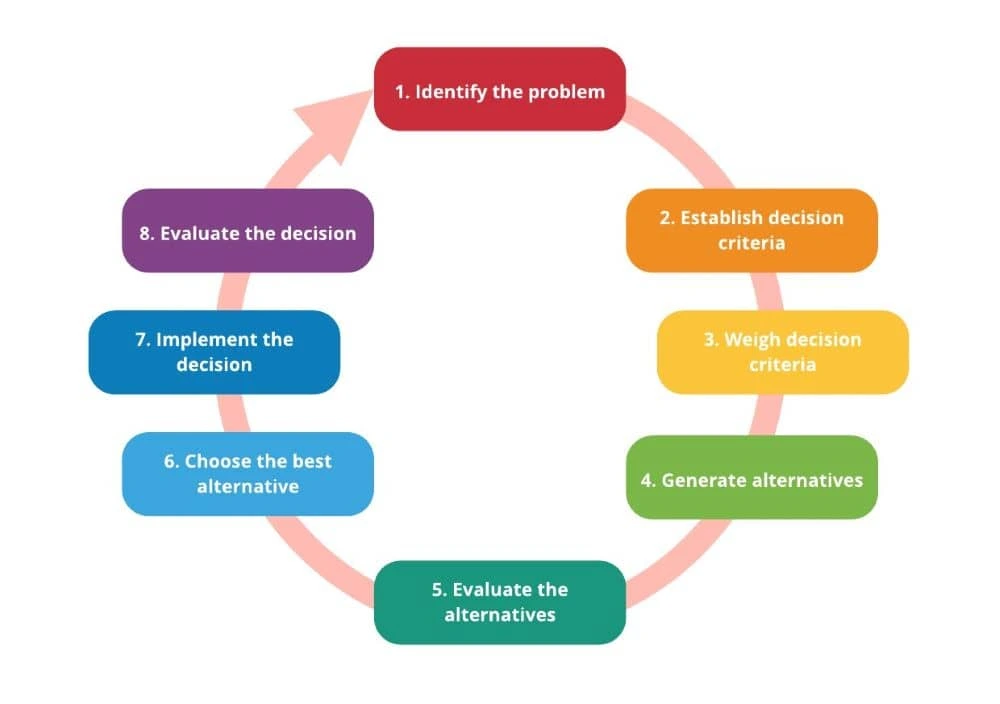
Quizlet’s rational decision-making model,lovingly recreated in Lucidpress
When emotional branding comes into play, decisions can become irrational. When given the choice between two similar products, a consumer may simply follow logic and choose the cheapest or most convenient option. However, when emotion is in the mix, they may choose to buy the brand they relate to most.
It’s easy to see how building an emotional bond with consumers can increase profits and why premium brands like Nespresso and Coca-Cola engage in building emotional connections with their customers.
Often, people choose purchases based on ego rather than necessity. Consumers can show who they are through the brands they choose—and they are willing to pay more and go out of their way to do this. It is up to marketers to position their brands in a way that will connect and resonate with their target audience. When done right, cutting through the distractions of the modern world will come easy.
How to incorporate emotional branding in your marketing strategy
The likes of McDonalds, KFC and Disney employ a number of methods to connect in a meaningful way with consumers. The longer a business is around, the easier this becomes, and many brands take advantage of anniversaries and nostalgia to bond with their market.
But, newly founded businesses don’t need to miss out. Here are just some of the approaches to emotional branding that can be used to bond with consumers.
1. Show your customers you care
To succeed at emotional branding, it’s essential to thoroughly know your audience. You need to treat your customers as people rather than faceless consumers. Do your research, conduct surveys, then decide how you can connect with your audience.
What do they value? What triggers them emotionally?
Once you’ve decided which emotion you want to tap into, this should consistently be evident in your marketing messages. From social media to customer care, a brand should constantly address customers’ emotional needs.
Over the years, e-commerce site Zappos endeared itself to customers by going above and beyond to provide great service. From providing free overnight delivery to a customer in a sticky situation to assisting a hungry helpline caller in need of pizza, the site has built up a loyal following.

While Zappos provides an extreme example of customer care, creating an emotional connection by meeting and exceeding customer service expectations doesn’t have to be so extravagant.
Apple has built a cult following simply by demonstrating that it understands the needs of its users. Nike recognizes its customers’ dreams and ambitions, and the brand uses marketing to show how it can help with the journey.
French beauty brand L’Occitane simply provides customers with beautifully presented deliveries and free gift-wrapping—making a memorable impression which, for many of its customers, is more appreciated than a discount.
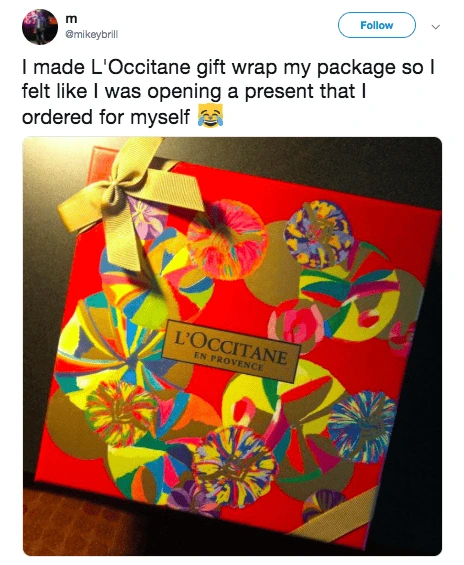
2. Be consistent
For online marketers, consistency is key. Sharing content which demonstrates a consistent tone and style builds both visibility and trust for a brand.
Without the trust of your audience, there is no way you’ll be able to build a strong emotional bond that will keep customers coming back.
Here are some practical ways to ensure brand consistency:
- Set out your brand values. Share them with the whole team to help employees at every level stay on-brand and make decisions that reflect your brand’s true personality.
- Create a set of brand guidelines. Outline your brand’s tone of voice and key design elements like font, color palettes and correct presentation of the logo.
- Put together a social media style guide. This will reinforce some of the elements set out in the brand guidelines, but it will also advise the social media team on which content they should post and how to respond to criticism.
- Use a branded URL shortener. Customize your short links so they are on-brand. This will improve brand consistency and build trust with your audience. For example, Rebrandly links receive up to 39% more click-throughs because consumers trust them.
- Create design templates. From presentations to social media images, make it simple for everyone to create high-quality, on-brand content. Then, make them accessible to the whole organization through a brand templating platform like Lucidpress.
- Monitor brand mentions. Keep an eye on what’s being said about your brand online using Google Alerts or another brand monitoring tool. Determine if your brand is coming across as intended and connecting emotionally with consumers.
3. Give customers an experience they won’t forget

Beyond providing great customer care, consider what other kind of experiences your brand can use to build an emotional connection with customers. Big brands often sponsor concerts and sporting events—or run their own. What could be your brand’s Disneyland?
If you have a brick-and-mortar location, could you host an entertaining event? If you’re working with a smaller budget, could you provide an Instagrammable installation in-store? This is a simple, but impactful, way to connect with consumers in today’s digital world.

Source: Redemption Bar
Provide a positive experience as customers use your product or service wherever possible. UX is growing in importance for online businesses and is intertwined with the overall brand experience.
Companies like Slack impress customers by providing a helpful and supportive experience through friendly reminders, convenient app integrations, and cleverly auto-populated gifs.
Alternatively, you can use marketing campaigns to align your brand with a particular lifestyle or emotional experience. Coca-Cola’s “Open Happiness” campaign is a clear example of this.
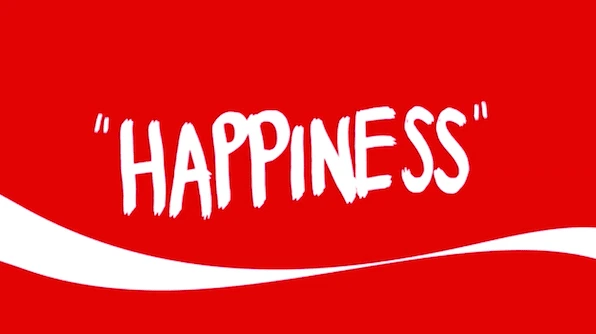
4. Put a friendly face at the center of your brand
Whether it’s a celeb, an Instagram influencer, or an employee-turned-brand-ambassador, sometimes the best way to connect with consumers on an emotional level is through a warm human personality.
Female consumers don’t go through enormous lengths to get one of Kylie Jenner’s lip kits just because of the product’s quality. They do this because of their love for the company’s CEO.
You don’t have to have a famous face to build a close relationship with your audience. Many charismatic CEOs have become the heart of their company’s brands.
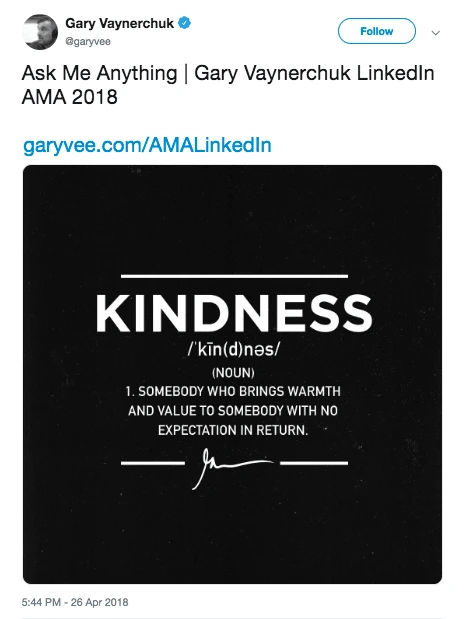
Think of Gary Vaynerchuk or Neil Patel, who have both built strong personal brands and businesses through social media. Their willingness to share knowledge and expertise with consumers has helped them to connect with audiences on an emotional level.
On a smaller scale, it’s very possible for a friendly waiter to drive customer retention by creating personal connections with diners. Brand ambassadors can come in many forms, and they’re a great way to reinforce brand values and build rapport with customers.
Key takeaway
Emotional branding builds lasting relationships with your audience and can improve the profitability and longevity of your business. You want to bring your customers to a point where they can’t imagine going to anyone else to get the products or services you provide.
Big brands are leading in this area, but small businesses can get in on emotional branding through the smallest of gestures and actions. As social media algorithms change and internet browsers seek out online communities, connecting emotionally will become a key strategy for cutting through the distractions of the modern world and reaching audiences.
Learn more about the power of emotional branding & storytelling in our webinar with branding expert David Brier.
At the onset of building a business, branding might not seem like the first thing to conceptualize. Establishing the foundations of your brand by creating a brand book could be a tedious process, but its long-term benefits are well worth the effort.
Related: Branding? Follow this template for creating a brand platform
To help you get started, let’s review what a brand book is, what it does, why you should take the time to build one, and how to best go about it.
What is a brand book?
A brand book can also be called a brand bible, a brand style guide or a brand guide, among other similar terms. Essentially, it’s the document that sets distinct guidelines for maintaining brand identity across all aspects of the business.
From designers to marketers to sales teams, a brand book helps align different departments in communicating consistent messaging.
Some of the things included in a brand book are:
- logos
- color palette
- typography
- design system
- imagery
- tone of voice
Why do you need one?
One of the biggest benefits of having a brand book is that it gives the business a framework of consistency and cohesion. This consistency and cohesive messaging serve as great tools for defining your company’s personality—which, when committed to over a period of time, breeds trust. Strong, consistent brands are valuable; we know from our research that consistent brands expect to earn 23% more revenue annually.
When your audience sees that there is consistency in color scheme, tone of voice, and logo usage across all platforms, it delivers a level of professionalism that tells your customers you’re a brand they can trust.
Pros of having a brand book
As pointed out by Mayven, having a detailed brand book establishes the voice and personality of a company, governing virtually every aspect of company communication. From in-house communications to marketing messaging, having a well-made brand book ensures everyone is on the same page, consistently delivering a unified message that’s always on-brand.
Cons of not having a brand book
On the flip side, the inconsistency that easily creeps up when you don’t take the time to create a brand book can confuse and, eventually, alienate your customers.
Imagine a coworker who’s always well put-together: perfectly ironed shirt, neat haircut, clean shoes. Now imagine if, out of nowhere, that same person came to work with unkempt hair, ripped jeans and a neck tattoo. You’ll inevitably feel uncomfortable because it’s just not something you’re used to from that person. Chances are, you’ll be wondering if everything was okay with that coworker or if there’s some inner turmoil going on.
Essentially, the same instinct applies to brands and the way they present themselves to their audiences. You don’t want to confuse your audience with mixed messages.
How to create a brand book: Setting up the brand
Before you create a brand book that guides all aspects of the business, you need to envision what you want the brand to be. This means understanding four key components: the brand’s mission, its vision (which includes core values), target audience and brand persona.
Mission
When you’re crafting your brand mission statement, don’t fall into the trap of stringing together buzzwords that merely result in empty concepts and vague statements. As noted by Branding Strategy Insider, settling for a mission statement of that ilk does little to guide the company or employees toward having and maintaining a competitive edge. On top of that, it doesn’t provide motivation or a daily mission to make each workday matter.
Instead of vague concepts, your mission statement should clearly establish:
- your company’s purpose
- its reason for existing
- the difference it strives to make in the world
Establishing these does a number of things for your business: it immediately helps employees figure out whether they fit what the company wants to be, it creates strong brand differentiation from competition, and it inspires consumer passion and engagement.
Vision
As noted by Goalcast, a strong vision statement will serve as a guiding force for all of your business decisions. It’s a virtual compass that points the company towards where it wants to be and what it wants to become.
To help craft your vision statement, you can ask questions like:
- How big do you want your company to get?
- Do you plan to branch out with products and services not currently offered?
- What kind of legacy do you want your business to leave behind?
Paired together, your mission and vision statements serve as important start and stop points—tools that will guide you as you make strategic business decisions that refine your brand.
Brand persona
Establishing a brand personality is a key element in setting the tone for your brand messaging across all communication channels. Mixed messages make it harder for customers to connect and identify with your brand.
One age-old practice is thinking about what kind of person your brand would be. Do you want your brand to be straightforward and to-the-point? Or would you rather it be playful and witty?
There’s also the old is/is not exercise. This involves listing three to five adjectives that your brand is and three to five adjectives that it is not.
Whatever collection of traits you decide to incorporate into your brand persona, it’s best to turn those into a statement that guides your overall messaging.
Lucidpress—a brand templating platform—uses this:
Lucidpress is the intuitive brand templating platform that empowers anyone to easily create on-brand materials.
In this statement, you can see a number of descriptive branding words:
- intuitive
- empowering
- easily
- on-brand
These traits drive our messaging and many other branding decisions, from how our software should feel to who would benefit from using our platform. Speaking of which…
Target audience
Just as you need to understand your brand, it’s likewise important to understand your target market. What types of people do you want using your products? Which ones do you want to visit your website, consume your content or subscribe to your emails?
To identify your audience, you need to have a solid understanding of what their needs, wants and values are—and how you factor into all of those.
The process of identifying and understanding your target market allows you to narrow down your audience focus. Your messages are always tailored to your audience, and it gives you a clear picture of what you need to be for a specific group of people.
How to create a brand book: Visual guidelines
Logo usage
Coming up with a distinct, identifiable logo is one thing. Ensuring that it remains optimized in different environments is another. This part of your brand book should include all approved versions of your logo and how it will be used in different platforms, from placement to acceptable alterations.
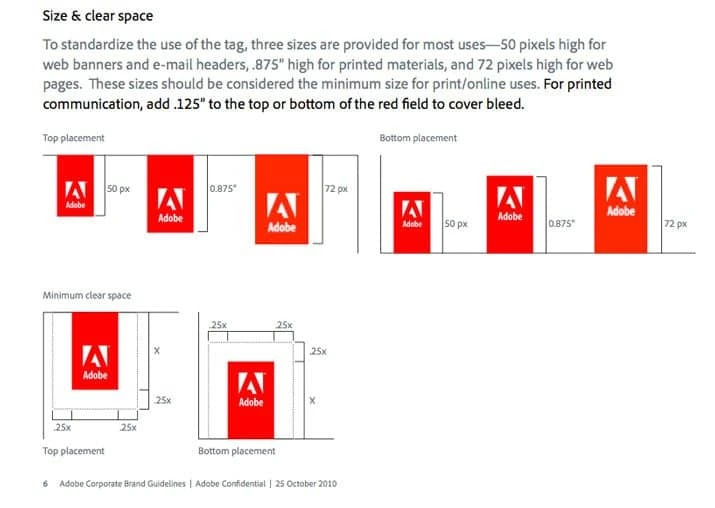
Source: Design Shack
As you can see with Adobe’s brand guidelines, it’s very clear how the logo should be used, including its placement, size and white space.
Color palette
Your brand’s color palette is another element that gives your business a consistent look and feel. Most brands choose four or fewer main colors that don’t stray too far from the hues of their logo. As you can see with Heineken’s color palette, they picked one light color for backgrounds, a darker color for text, a neutral hue, and one that gives design elements a bit of pop.
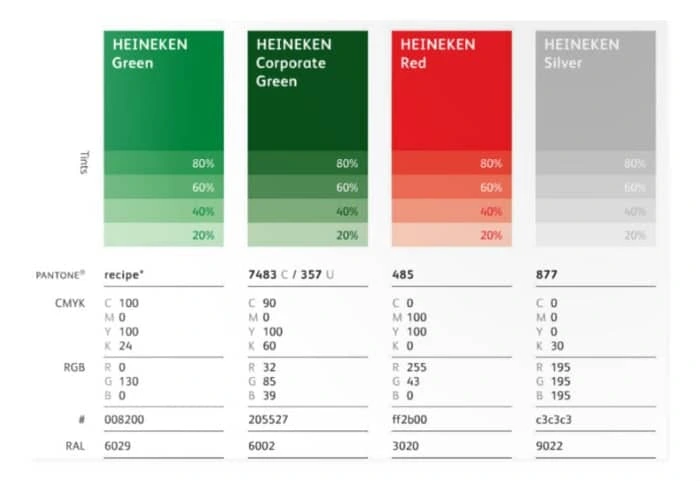
Source: 99designs
And just as it is with your logo, you need to outline how and when each color should be used (Which ones are for text and design elements? Which are for the logo, and which are for backgrounds?). Mayven also points out that you should define the following:
- color names
- color values (CMYK for print, RGB & HEX codes for digital, and PANTONE name & number)
- primary, secondary & alternate colors
Typography
Similarly, there should be a defined font style for both print & digital applications. In your brand book, typography should cover how and when certain fonts are used, which typefaces are acceptable, as well as guidelines for additional styling, size, and use of color.
As pointed out by Mayven, most brands use one or two primary typefaces, a complementary typeface, and substitute typefaces.
Tone of voice
As with all the other elements on this list, your tone of voice needs to be consistent across all communication channels—email, social media, press releases, blog posts, ads, etc. Your voice should be aligned with your brand’s persona, mission, vision, values and target audience.
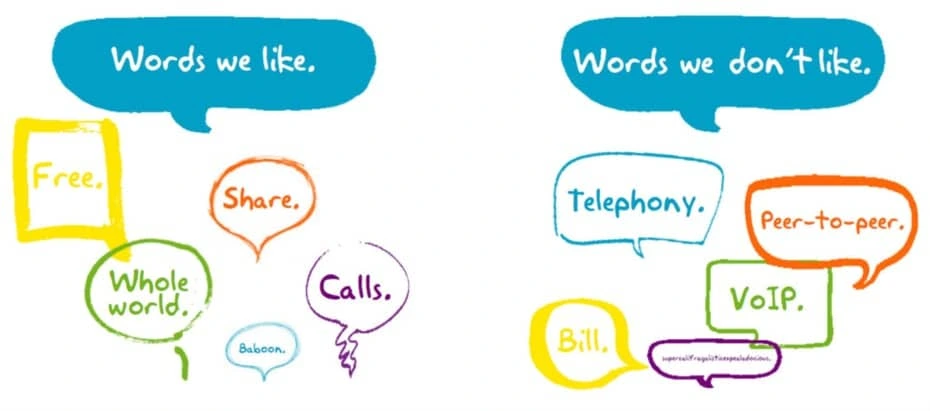
Source: 99designs
You can start by identifying words you like and don’t like to be associated with. Then, decide what type of language fits your brand persona and your target audience. Go back to your list of adjectives describing your brand personality to come up with language that is on-brand.
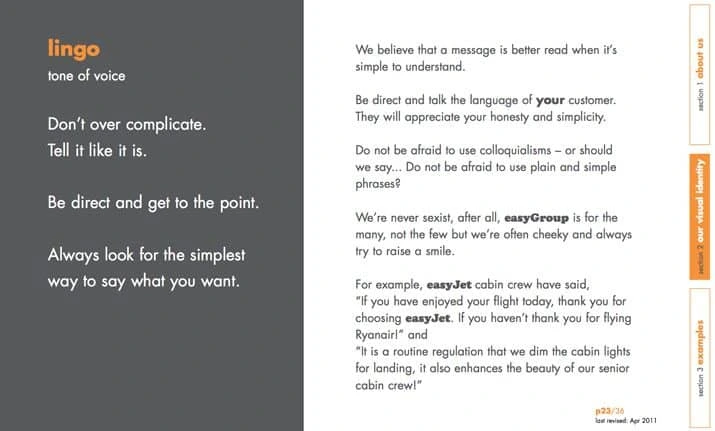
Source: Design Shack
Imagery
Apart from indicating whether you’ll be using photos, illustrations and other types of graphics (as well as when and how you’ll be using them), your brand book should also detail how images will be edited, which colors to place them with, and any other design elements related to image use.
Collect inspiration from successful brands, particularly those that have similar brand messaging as yours. You can also create a mood board with images that convey the feelings you want people to get when they interact with your brand.
Key takeaway
A thoughtfully crafted brand book will bring your business consistency, alignment and cohesion. To avoid confusion, your brand book needs to be detailed, covering all possible bases to ensure everyone’s on the same page. It will give every employee in the company a concrete framework to work with, while still giving them the freedom to do what they do best.
If you’re among those who think email marketing is too old-school to be effective these days, you’ve got the wrong idea. Email marketing is still a powerful tool that can help your brand shine.
Related: 8 tips to get more responses to your email marketing
What makes email so effective is the fact that it’s a permission-based marketing channel, one that gives you a chance to reach customers in a personal place—their inbox.
When a prospect signs up for your emails, they’re expecting a welcome email that introduces them to the brand. As this is the first email your subscriber will receive after being added to your email marketing list, it’s crucial to do it right.
9 best practices for your welcome email
1. A timely introduction
Your new subscriber wants to know more about your products & services at the time they sign up for your emails. Take advantage of their interest by sending out a welcome email as soon as they sign up. If you miss out on this opportunity, there’s a real possibility that the subscriber will forget about you and lose interest in your brand.
2. Crisp subject lines
All the work you put into crafting an engaging email will be for naught if your email doesn’t get noticed in a crowded inbox. Add an extra zing while crafting the subject line for your welcome email.
To make your email feel more personal, try using personalized subject lines. People are attracted to their own names, so this will lead to higher open rates. Here’s an example from Google:
Subject line: Smiles Davis, Welcome to your Google Home Mini

3. A pleasant greeting
Greet your new subscribers with a warm welcome email that’s personalized to their interests and preferences. Even when you’re sending automated emails, you can write them in a way that feels personable and real—like they’re coming from a human being and not a robot. Consider using an employee’s name and picture, so subscribers can visualize who’s behind the emails they get from you.
4. Guiding them through the next step
Making your customers wait too long isn’t good practice. You’ll have far better results if you intentionally build brand loyalty and guide customers through the purchase process.
For example, if you’re an online cosmetics brand, tell them why they should choose your brand over the many other brands in the market. Give them an overview of your products and how they can browse your app or website to find the cosmetics they want. If there are other actions you want them to take, spell those out as well—like in this example from nDash.
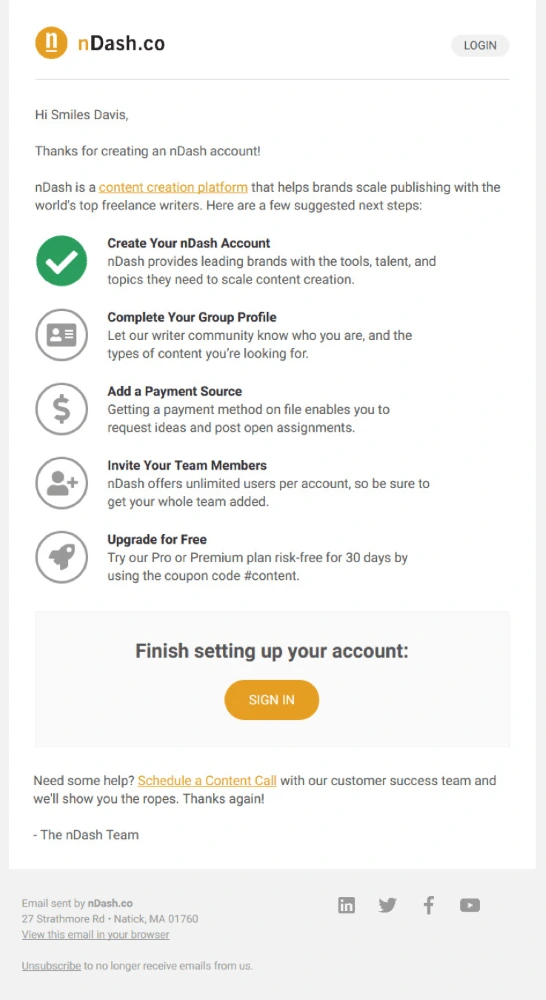
5. Include freebies in your welcome email
This is your chance to win over new subscribers with low-cost goodies. People love free stuff, so this will endear your brand to them right out of the gate. If you can’t afford to give away items for free without a minimum purchase, consider including a discount or promotion instead—such as a percent-off coupon or a buy-one-get-one promo code.
6. Hit two goals with one email
According to email marketing best practices, it’s recommended to include links to your social media profiles in your email. Ask them to like or follow you on the platforms you use most.
This is an especially clever move for e-commerce brands, since they need a strong audience to build their reputation and provide social proof. Even if you’re not an e-commerce brand, you can build buzz and loyalty by directing subscribers to your social channels.
7. Ask to be whitelisted
Being whitelisted can enhance your deliverability rates and make it easier for subscribers to find your emails in the future. It also helps to keep your emails out of the Spam folder. See how Travelocity asks people to whitelist them in the section titled Subscription Information:
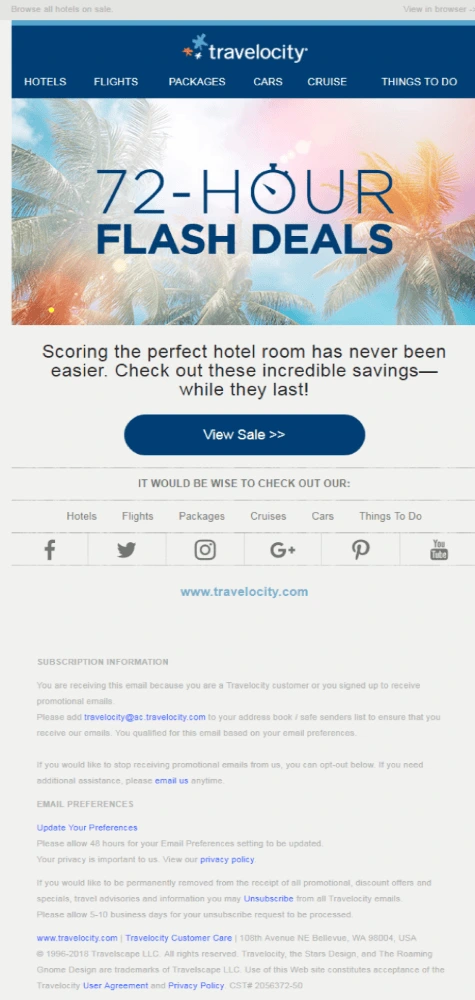
8. Give them a way out
You should always give your customers the option to unsubscribe from your emails at any point. By doing so, you’ll retain genuine subscribers in your list—people who are actually interested in reading your emails. In turn, your engagement metrics will rise, because you’ve eliminated those who aren’t interested in purchasing from you. (Also, unsubscribes are always better than spam complaints.)
9. Include free shipping
For e-commerce brands, one major obstacle your subscribers face while shopping online is high shipping charges.
Ease that friction and encourage first-time buyers by offering free shipping on their first order. Try mentioning it in your welcome email to delight your new subscribers. Creating a happy customer at the onset goes a long way toward building loyalty for your brand.
Mantras to keep your welcome emails engaging
- Pin your top content
Play your cards right with a welcome email that features your best content and gets them excited about your brand for the long haul.
- Avoid no-reply
Do not send your emails with a no-reply email address. It feels impersonal, and it’s important to assure your subscribers that you’re listening to them. They should know there’s a person behind the email ready to hear their problems and feedback.
- Make it compelling
Make your email compelling with content. Welcome emails should catch the subscriber’s attention from the moment they open it. If you’re struggling, try adding a dash of fun or humor to your email. Include interactive elements like GIFs, accordions, cinemagraphs or videos to make it more visually appealing.
- Build anticipation
Create a sense of anticipation with your welcome email. Don’t spill all the beans right at the beginning. Each email should leave the subscriber waiting for the next one. Find a way to highlight your best content and maintain curiosity in your subscriber’s mind so they look forward to hearing from you.
- Try a welcome email series
Instead of just sending one email for the sake of formality, consider sending 2-3 welcome emails as a series to initiate your subscribers. In a welcome series, you can introduce and explain different pieces of your business and entice subscribers to purchase from you.
- Write accessible emails
With one billion people in the world living with some form of disability, it’s incredibly valuable to write accessible emails that can be understood by everyone who receives them. Think about all the ways people might interact with your content—for example, different devices and browsers. How does your email sound when it’s read out loud to a blind audience? What does your plain text email look like? When your message is more inclusive, you have a wider audience to nurture.
Key takeaway
Welcome emails are an excellent opportunity to introduce subscribers to your brand, encourage purchases, and lay the foundation for loyalty down the road. Make sure you include all these essential elements in your welcome emails to set your brand up for success.
Kickstart your next email marketing campaign with our free newsletter templates.
If it seems like new Starbucks locations are popping up faster than weeds in your backyard, there’s a sound reason behind it. Successful franchises rapidly expand their reach because they begin with an effective business plan and focus on growth.
Related: Franchise development—what you need to know
Creating a business plan is the necessary first step for any business owners who want to bring a franchise into a new market. Well-crafted franchise business plans are the equivalent of an elevator pitch. Business owners can use them to convince others to invest the capital they need to hit the ground running. Lenders also require a business plan before they will sign off on any loans to a prospective franchise owner.
Creating your franchise business plan
A typical business plan includes four main sections. You can touch on these sections in an executive summary, then break down the details in each individual section. Each section functions like a signpost on the roadmap you’re drawing for your new business to reach its goals. Here’s an overview of those four sections and what they should include.
Business description
The purpose for this section is basically self-explanatory. It offers basic and essential information on the franchise itself. For example, it describes the products and services your business offers. You can also identify your customers and how your business will help them.
You should evaluate the market where you wish to set up shop and include information about it in this section. This includes an analysis of your direct competitors, identifiable challenges or risks that come with doing business in that market, and a breakdown of your target demographic. Discuss how you will approach and manage each of these factors within your business operations.
Management
Your business plan needs to detail your company’s management structure and any related core values or philosophies. Which positions will be responsible for managing day-to-day operations? Who will fill these positions? What qualifications and skills are required for each position? How will you hire and train the necessary personnel? What salaries and benefits will you offer to these employees?
Discuss the individuals who will be filling management and leadership roles on your team. Explain—in depth—what makes those particular individuals qualified to succeed in those roles. Franchising is only as successful as the management team doing the work behind the scenes, and the people reading your business plan will look over this section carefully.
Marketing
A new business can only succeed if it uses the right formula to reach potential customers and turn them into real customers. This is where your marketing plan comes into play. Your business plan should detail how you will reach customers and convince them to walk through your door.
Doing thorough market analysis is critical in this part of your overall planning. You need to identify your customers, assess their needs, and determine how your business will fulfill those needs. How will this data shape your pricing? What is your potential market share? Outline how you will market your business to reach that target demographic.
Financial projections
It takes a significant investment of capital to get any business off the ground, and franchises are no exception. Investors and lenders will be most concerned about turning a profit. They don’t want to sink funding into a business that will end up folding like a paper airplane at the first sign of trouble.
Your plan should outline a realistic budget that includes both startup costs and operating costs. These financial projections should cover your cash-on-hand, franchise purchasing fees, startup costs and operational costs. The budget should cover operational costs over a three- to six-month period.
Discuss how much capital you’ll need to cover these costs until your business turns a profit. You also need to demonstrate the accounting and inventory control systems your franchise will use. Include income statements, cash flow projections, and data sheets to project how your business will do once it opens its doors. Financial projections should be conservative and take into account as many variables as possible.
Getting to work
There are many great resources available to help you structure your business plan so that it conveys the message you intend with confidence. Franchise business plan templates can help you see what works best and how to put your vision into the right words. You can pick from assorted stock images, fonts, colors and other design elements to make it visually appealing and reflect your franchise’s brand voice.
If you’re not a professional designer, Lucidpress can help you start out on the right foot. We offer plenty of templates suited to meet your business document needs. Our intuitive online editor makes it easy to design traditional printed documents or embrace the virtual realm with interactive digital documents. Check out our template gallery for a dose of inspiration, then sign up for a free Lucidpress account to take one for a test drive.
Your brand matters. If you’re ready to build your franchise brand into a consistent, compelling force that drives your business, this guide will show you how to get started.
One major challenge many four-year colleges and universities face today is student retention. A substantial number of students are starting college only to drop out at some point. When students don’t make it to graduation, it’s costly for both the students themselves and the universities they leave behind.
Related: Higher education marketing—crucial strategies & trends
Data from the NSC Research Center found on average 61.6% of entering freshman in 2016 returned to school the following fall semester. 73.9% of freshman returned to the same university or transferred to continue their studies. Retention rates among white and Asian students tend to be higher while black and hispanic students fall below average. Among black students, only 52.5% continued school at the university they originally enrolled in.
But before you create a plan to address student retention, it’s important to first understand what’s causing students to drop out.
- Cost. The costs of higher education have been rising continually, and if students can’t receive financial aid, then staying enrolled at college can be difficult for many to afford.
- Homesickness. When students begin their college careers, many don’t know anyone else at the university. If students have difficulty making connections with peers around them, homesickness and loneliness can cause students to drop out.
- Unclear expectations. Adjusting from high school to university can be difficult for many first-year students with certain expectations regarding academic success as they discover different expectations in college.
While these three challenges merely scratch the surface of student retention concerns at universities, there are solutions that can help any college create a student retention plan. These five steps will help you to create a retention plan that will fit the unique needs of students at your university.
Know your students
To help your student body overcome the obstacles they encounter during their educational journey, you first have to know your student body. What are the biggest issues facing the students at your university? Finances, mental health, isolation, lack of resources? It’s hard to find a solution if you don’t first find the root of the problem.
To figure out what your students need, collect data on which programs and resources on campus are already being used. Poll your student body to find out what challenges they’re facing. Create an open dialogue with your faculty so they can address the problems they see affecting their students. By gathering this information, you can brainstorm and try new approaches to helping your students succeed.
Define student success
Based on your research, define what student success looks like at your university. This could include the rate of students making it to graduation, the time it takes students to graduate, improved learning outcomes, experiential learning, or more employed students at graduation. This definition will vary for each school, depending on the different programs available.
Once you’ve crafted this definition, share it with your faculty, staff and student body. This gives the entire campus a common goal to work toward. When students understand what success looks like within your institution, they’ll be more prepared to do the things they need to reach success. Many students enter college unsure of what it means to be a successful college student, and creating this clear goal for them can help them better adapt to college.
Empower your students with resources
Many college students move away from home to attend school and may feel isolated in a new, possibly foreign environment. They’ll be learning to live on their own while also handling research projects and trying to pass their finals. When faced with these overwhelming difficulties, it might seem easier to the student to drop out. By providing resources to your student body, you give them the power to overcome these challenges.
Some resources that can be invaluable to students include:
- Financial services
- Writing center
- Tutoring center
- Counseling
- Workshops for test-taking skills
- Outreach and engagement centers
- Student unions and clubs
- LGBTQ+ support organizations
The options for resources are limitless, and by understanding your student body, you can create organizations that help your students feel empowered.
Set up an intervention network
The earlier students get help when they’re facing problems, the better their chances are for overcoming challenges and finding success at school. This is a process that takes everyone contributing to be effective. This means that professors might need to receive training on how to recognize students who are beginning to struggle.
As a university, you need to establish warning signs for professors to watch for in their students. Professors can then refer these students to counselors or advisors who can reach out with resources and information that can help them.
It’s encouraging for students to know there are people at the university who care about them and who notice when they’re missing class or struggling to keep up.
Create a community
Many first-year students come to college knowing very few people there, if any at all. It’s vital to help those students make connections and friendships that make them feel like they belong at the university. Helping students find their community can keep homesickness at bay.
Creating learning communities and clubs while providing volunteer opportunities in the community can help students make valuable connections with others. Getting involved on and off campus also gives students the opportunity to gain experience for their future career.
“It’s important for students to figure out what they don’t want to do, so they can figure out what they want to do. College is a great time to experiment by volunteering with local organizations and highlighting some potential career paths. Students have so many different pathways that they can take as they begin their own lives and make their own choices.”
Dustin Ramsdell, Helping College Students Build Community Connections
Key takeaways
First-year students and transfer students from community colleges often feel overwhelmed by the challenges of starting their academic career at a new university. Universities can help smooth that transition and increase the success rates of their students by implementing a student retention plan.
These retention plans should encompass ideas for the following five areas:
- Know your students
- Define student success
- Empower your students with resources
- Set up an intervention network
- Create student communities
By focusing on these five areas as you create a student retention plan, you can increase your students’ success rates and create happy, successful alumni.
Is your school delivering a strong, consistent message with its brand marketing? Learn more in our free ebook: Branding in student recruitment
Running a business, in any capacity, takes hard work and perseverance. Specifically, though, for a franchise, there’s a whole different set of unique challenges for both franchisors and franchisees.
The primary challenge comes down to providing a consistent experience. It’s simple: A franchise must provide a consistent brand experience across each of its locations.
Related: Franchise development—what you need to know
What’s not so simple is ensuring that every part of operations is being done the same way. How can you ensure that brand messaging and logos are easily accessible and up-to-date, or that the service is as good as it should be at every single one of your locations?
This article should provide you with a start on how to achieve brand consistency in your franchise.
Make sure franchisees know the importance of reputation management
Let’s first discuss your online brand image. This directly affects how customers feel about your brand.
A positive reputation is something that’s hard to get back once it’s ruined. There are a variety of different platforms in which customers can communicate with other customers about your brand including Yelp, Google, and other forms of social media.
Chris Conner, president of Franchise Marketing Systems, advises, “Right from the initial training with the franchisee, the franchisor should be educating and informing franchisees how brand management and reputation management are important and part of their operational responsibilities in running the franchised business.”
Conner adds: “Once a franchisee is operating and running day-to-day, the franchisor should have regularly scheduled calls with franchisees where reputation management is part of that discussion and addressed in each interaction.”
“Franchisors who are able to grow their networks effectively typically have incredibly strong and consistent mechanisms in place to monitor, respond and execute brand management responsibilities,” he concludes.
Maintain digital consistency
In order to maintain consistency where franchisees communicate with customers online, you need a clear-cut digital marketing plan. The plan should include guidelines for how franchisees communicate via social media, blogs, emails and webpages. Make sure you provide franchisees with easy access to logos, font style, imagery & photos, brand tone and language.
Social media is an integral part of our daily lives. Each location should have a separate Facebook and Yelp page so customers can visit locations and leave reviews. Whether each location needs a separate Twitter, Snapchat, LinkedIn, Google+ or Instagram account is truly dependent on the brand.
Create a detailed social media policy answering questions like: What type of content should be posted—and what should not be posted? How should complaints and negative reviews be dealt with? You can streamline social media with a process to approve anything that goes out, create templates, or offer pre-approved content. That way, you don’t have to micromanage content for too many locations.
Let your franchisees know what your brand is
Franchisors need to feel confident about the brand before communicating what that brand is to franchisees. This encompasses everything from company-wide goals to how everyday operations are run.
Ask yourself the following questions, and once you’re confident in your responses, make sure your franchisees know it, too.
What is the brand?
Your brand includes the characteristics of your company that make it relatable to people. For example, popular sandwich franchise Subway is a casual, no-frills restaurant where customers can expect consistent, fast service with fresh ingredients.
What is the company’s mission? What are its values and goals?
Subway strives to serve fresh, delicious sandwiches that are made-to-order right in front of the customer. The team at Subway lists out three core values and principles on their website.
- “Always provide exceptional service to your valued guests.”
- “Provide the highest quality menu items at a price everyone can afford and enjoy.”
- “Keep operating costs low and ensure you have great systems in place and never stop improving.”
What story do you want to tell?
Subway offers healthy sandwiches at convenient locations around the world. Subway shows their customers that they have nutritional & community responsibility by “building stronger societies,” according to the company.
Who is buying your product or service? How do you market to them?
Today, it’s easier to understand who your customers are and what they’re looking for. According to customer identity company Signal, personalization is an important part of marketing for brands. When it comes to franchises, that means being able to speak to people in different markets on a personal level. For example, franchises can offer personalized online communication experiences (e.g. paid advertising, personalized emails, etc.).
Don’t forget the details
It might be obvious, but staying consistent in a franchise is about every little detail.
Gary Findley, CEO at Restoration1 and established franchise sales expert, writes that consistency is the most important factor when it comes to business success.
He writes, “Balancing brand uniformity while respecting franchisee independence and regulating brand messages while effectively targeting local communities are two of the struggles that often arise.”
To help achieve this balance, there needs to be a consistent aesthetic, product & experience at each location.
- Aesthetics. From the color of paint on the wall to the uniform staff is wearing, there should be consistency to how a business looks and feels. If you walk into a Subway in the state of New York, chances are it’s going to look the same as in Colorado, Washington and anywhere else.
- Product. If people are seeking one of your locations, it’s because they crave that same product they know and love. People don’t go to Subway because they want a local sandwich. They go to Subway because they crave the taste they’re familiar with.
- Experience. Just as customers want the same product or service they can find at all of your locations, the same is true for the experience. Experience encompasses everything—the music playing in the background, the seating, how to place an order or make a purchase, and the behavior of the employees. Employees have to be trained consistently on daily operations, including how to interact with customers, how involved they are, and how to handle complaints. For example, if a few locations are taking too long to prepare food—and your brand is known for speed—that will be a problem for your customers.
- Marketing. Each franchise needs to be consistent with how they market and who they market to. Determining which types of marketing campaigns & advertising techniques work best for your brand is the first step in implementing consistent franchise marketing. This includes having specific brand guidelines for your franchise and what you want your franchise to look like.
Strengthen franchisor / franchisee communication
Determining how each franchisee should operate and what brand consistency looks like is only half the battle. The real challenge comes in longevity: making it last. To build long-lasting marketing and operations, use the following process.
- Set clear expectations. Whenever a new franchisee opens a location, hold a thorough training where franchisees gain an understanding of your expectations. Outline everything in a manual to reinforce the goals. This includes everything from hiring procedures to aesthetics.
- Illustrate why this is important. Don’t just leave instructions on how to do things, but be sure franchisees understand the reasoning behind it. Staying consistent is going to create customer loyalty, brand recognition, and ultimately, a more successful business. Explaining the benefits will encourage everyone to stay on target.
- Communicate regularly. Plan to talk as much as necessary to succeed. Offer positive feedback when you see a franchisee doing things right, and of course, provide constructive criticism and encouragement when things need to get back on track.
Key takeaway
It can be difficult for a franchisor to maintain consistency across marketing and operations within a franchise… while also targeting local customers in different communities. Don’t give up on making your franchise marketing consistent.
For the best results, make sure franchisees know the importance of reputation management. Stay consistent with messaging across digital platforms, educate franchisees about your brand, pay attention to the details, and keep the lines of communication open.
Give your new franchisees a head start with our free ebook: The franchise owner’s field guide to success
What is brand authenticity? Well, generally speaking, it’s when brands act, illustrate and feel (or be) genuine to their customers.
The byproduct of brand authenticity is more important than brand authenticity itself — i.e., brand loyalty. Brand loyalty is the emotional affirmation of your brand’s authenticity. And brand loyalty is what drives your revenue.
Related: 7 Key Elements of Brand Identity Design
But brand loyalty requires hard work and patience. And it involves understanding your customers’ core values and delivering on them.
So, what makes a brand authentic?
- Reliability
- Respect
- Realness
Brands that do all three are brands that customers prefer and trust. How can you adopt these qualities and make your brand more authentic?
We gotcha!
TIP 1: Be reliable – Quality over quantity, and keep your promises
Seems like a no-brainer, right? Unfortunately, there’s an authenticity deficit in the global marketplace today. Not all brands keep the promises they make, not all communicate honestly, and not enough place the customer’s interests above their own.
Take any variety of tech companies for instance (with admittedly the exception of large-scale corporations like Google, Facebook and so forth… kindly ignore those!) PayPal comms SVP Franz Paasche said: “Tech brands combine the excitement of innovation with [making] the everyday living of life easier, and that gives you a trusted role in people’s lives.”
For example, even when Microsoft felt customers brand loyalty wane after the launch of its disastrous Vista operating system, they hit the ground running to find out why it let their customers down and focused its efforts on trying to right the wrong.
Kathleen Hall, advertising and marketing VP of Microsoft, said: “We went back to our consumers and did a global study, visualizing what the brand meant to them. There was consistency worldwide: Microsoft means opportunity, access and connection, a combination of strength and possibility.”
Ten years later, the company is still enjoying the fruits of that study. The idea is to take stock of what people need and expect from you, then deliver on your promises. What you do on the ground can sometimes speak more than your marketing dollars ever could.
TIP 2: Be respectful — Customer-centricity is key to revenue growth
By far, the most important aspect of a brand’s authenticity is its customer-centricity.
It’s crucial to treat your customers as the most pivotal part of your business. You don’t need a major PR push to show the world how much you care, instead what you need are genuine efforts to deliver the basics and help your customers.
Take the Patagonia brand as an example. The company mission statement is to “build the best product, cause no unnecessary harm, use business to inspire and implement solutions to the environmental crisis.” To that end, the company has many checks in place to ensure it hits on that mission statement. Such as:
- Environmentally-friendly production practices
- Educational programs and initiatives for the public
- Fair pay and wages for it direct employees and partner employees
Now, that’s just the beginning. To see for yourself, check out Patagonia’s core value page!
TIP 3: Be real – Personalize customer communications
Authenticity doesn’t come from the product or service you sell, but from how, why and where you sell it.
Winning brands take great pains to communicate with customers in ways that feel personal. They see themselves as a productive part of the customer’s life, and each marketing message is personalized for them. They nail practices like cross-cultural marketing, localization, creating dedicated websites for different countries, and identifying as a local brand despite being a global brand.
By being real, you inevitably build trust and rapport with your customers. And to establish that trust, you need to be honest in your words and actions. Michael Boychuk, the former executive creative director of Amazon, said: “You can say whatever you want, however, you want to say it, but if you’re not interacting with people authentically, advertising is nothing.”
Be really reliable, respectful — and really real
Be reliable, be respectful and be real. That’s what gets customers to trust you and perceive you as an authentic brand. Revenue and profits are a byproduct of customer-centricity. Always remember that a good brand serves the customer. If you can take these ideas to heart, you’ll build better brand authenticity than millions of marketing dollars ever could.
Want to know more about the power of a strong brand? Download our free 32-page report, chock full of stats & great insights.
Attracting a steady stream of new customers is one thing, but building customer loyalty is integral to a brand’s long-term success. And it begins with making a good first impression.
Think about it: when looking up a brand online, what do you remember about the ones that stand out? More than likely, it’s their logo or their overall style—like meeting a person wearing a great suit. When you run across that brand again, that image can stick with you—more so if you keep on seeing it in different places. This is a brand’s visual identity, and it’s what you want potential customers to remember.
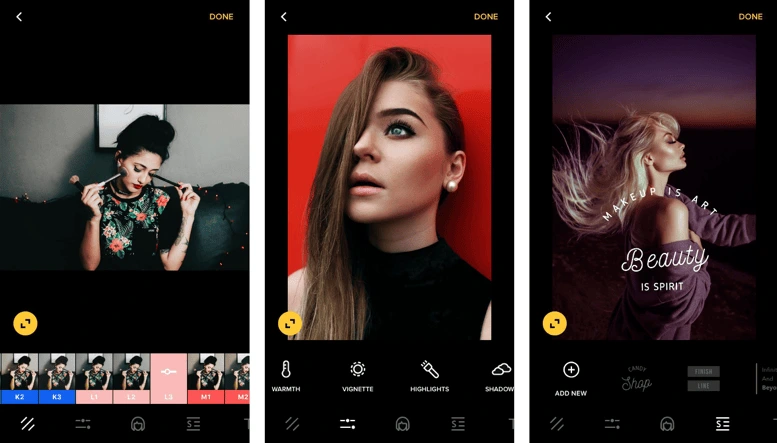
Related: 6 Instagram post ideas to boost sales
Having a memorable visual identity is important for social media, now a standard tool in the digital marketer’s arsenal. Instagram in particular is a powerhouse for using visual content to promote products and services, with Instagram stats showing 71% of U.S. businesses have an Instagram profile (25 million business profiles total). Standing out and earning engagement and followers depends on how well-defined your visual identity is. Here’s how to do it.
1. Know your brand inside and out
Before you create a visual identity, you need an actual identity first. Know the key aspects of your brand you want to communicate to your audience, then translate them into a visual medium. [![]() ]
]
Essentials for this step are copies (in writing!) of your brand’s mission, vision and values. These should be easily accessible on both your official website and any internal marketing documents. When you have them, answer the following questions to figure out what you’ll need to base your visuals on.
- Why was my brand made?
- What does my brand value the most?
- What words would I use to describe my brand?
- What does my brand offer in terms of products, service and experience that others do not?
- What kind of people do I want my customers to be?
Using your answers to the questions above, you can isolate a set of keywords closely associated with your brand.
2. Create a set of branding guidelines for social media
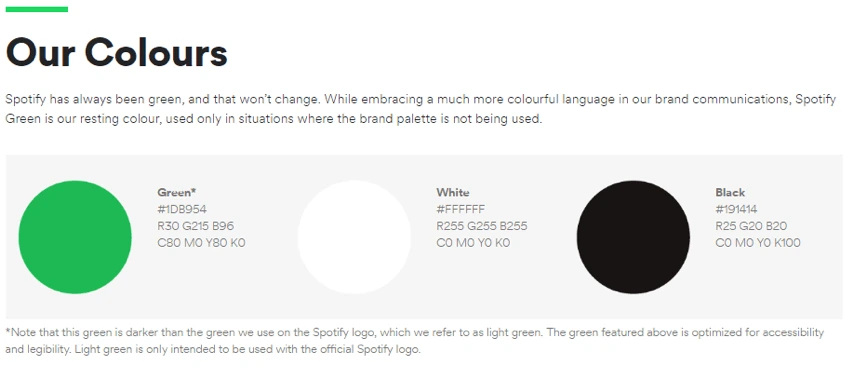
Source: Spotify
Do not underestimate the logistical power of good documentation. Brand guidelines enforce consistency in your branding, graphic design and marketing—keeping everything together so that everyone is on the same page when it comes to how to visually present your brand.
While it does take time and effort to create, having all these details in one place saves more time in the long run. It’s also a mark of professionalism: no having to go back and forth, emailing each other files and instructions every time you design something new.
Looking at some great branding examples, here’s what to include in your brand guidelines:
- The theme of your brand
- The feel and philosophy of your company
- Relevant taglines
- Font styles & typefaces to use
- Acceptable ways to use your brand logo, including its size & placement
- Color palette to use when associating with the brand
- Guidelines on composing imagery
3. Make social media post templates
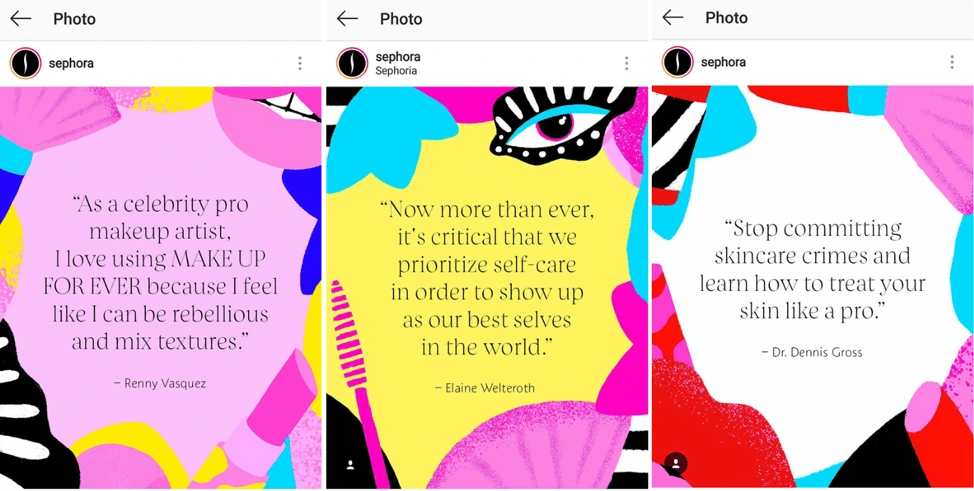
Source: Sephora
If you want to be remembered for a certain color or type of imagery, or if you want your logo to be visible on the feed and not just in your profile photo, turn to Instagram post templates. Some examples are backgrounds for text posts or borders to place around photos. They might include your logo, brand name or slogan and should be used when appropriate—not all the time, but just enough to be noticed.
You can use these templates when you share some of your favorite quotes to Instagram, which can make an otherwise plain text post look interesting. You can also place template borders on user-generated content that you’d like to share on your profile—especially useful if you’re running an Instagram giveaway or photo contest using a particular hashtag that can be incorporated into the template.
Remember to mix it up once in a while as well. While you want it to be memorable through retention, you don’t want it becoming stale. Try mixing it up every month or two and changing it according to season or campaign.
4. Have a consistent photo-editing style
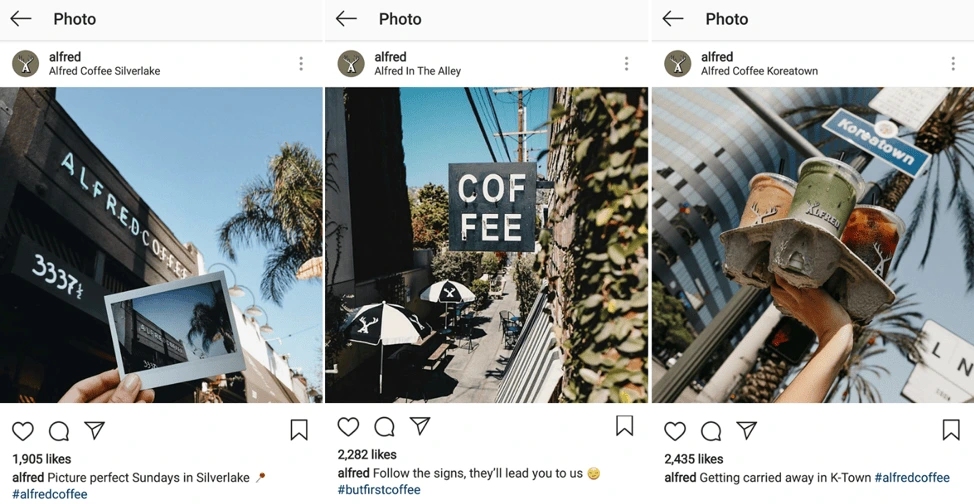
Source: Alfred
Once you’ve identified the feel of your brand and the colors you associate it with, fold that into the way you edit photos. Color has long been known to be a powerful force in marketing, and by post-processing images before you post them online, you can influence what they convey.
Use a similar editing style with your pictures so they all communicate your message—and slowly, users will connect that feeling to your brand. Away from your computer and need something quick? For extensive editing on the go, download a reliable photo application like Instasize to your mobile phone.
5. Do social media right
Last but definitely not least, make the effort to use Instagram right.
What does this mean? No matter the amount of content you share, and no matter how elaborate your photo editing is for each image, your efforts won’t matter if you don’t make use of the rest of the platform. Instagram has boomed—and so has its features.
One of the biggest don’ts of Instagram right now is to post strictly to the feed only. Instagram also has Stories and IGTV, the former of which can be an informal way to connect with your customers, while the latter gives space for long-form videos that followers would otherwise miss.
Of course, don’t let all your efforts towards keeping your visual identity end with social media. After all, using Instagram is just one step in the marketing funnel. Creative consistency builds trust, showcases reliability and improves customer perception—especially in visual branding. Keep your branding consistent across touchpoints before, during and after purchase, and you’ll be crafting a brand story customers won’t forget any time soon.
Want to know more about the power of brand consistency? Download our free 32-page report, chock full of stats & great insights.
You’ve answered a request for proposal (RFP), attended a couple of pitches, and now you’ve landed that new client you worked so hard to convert. Congratulations! …Now what?
For any agency (and client), a new relationship can be a daunting prospect—especially when you’re in the early stages. But with a solid client onboarding process in place to kick-off your first campaign, you can easily bring them up-to-speed with your typical engagement.
Related: How to write a creative brief (with examples)
So, what exactly should your onboarding process look like?
In this post, we’ll show you a simple 8-step client onboarding checklist to help you kick things off on a positive note—and make sure every new campaign starts on the right foot.
Let’s dive in.
What is client onboarding, anyway?
Client onboarding is the process of welcoming a new client onboard to your agency.
Whether you’re selling a service like graphic design or marketing, or a product like a software subscription, onboarding is essential for ensuring the relationship runs smoothly from the beginning.
Think about it: You’re unlikely to be impressed with an agency if they don’t have a streamlined way to get your first campaign rolling, right?
Your clients feel the same way. They want an easy, stress-free way to start working together—not one that takes six weeks of back-and-forth before your agency begins delivering the work they’re paying for.
A solid onboarding process is an important part of your client retention strategy, too.
Selling other services and making additional revenue from existing clients is much easier than attracting new clients. In fact, according to Lobster Marketing, there can be an up-to-70% chance of selling to an existing customer, compared with as little as 5% for a new prospect.

Source: Lobster Marketing
Get your client onboarding process right, and you’ll improve the chances of having a long-term relationship with them.
However, get it wrong and you run the risk of losing the client before you have the chance to impress them with your work—leading to higher churn, and of course, lost potential revenue.
A successful client onboarding checklist
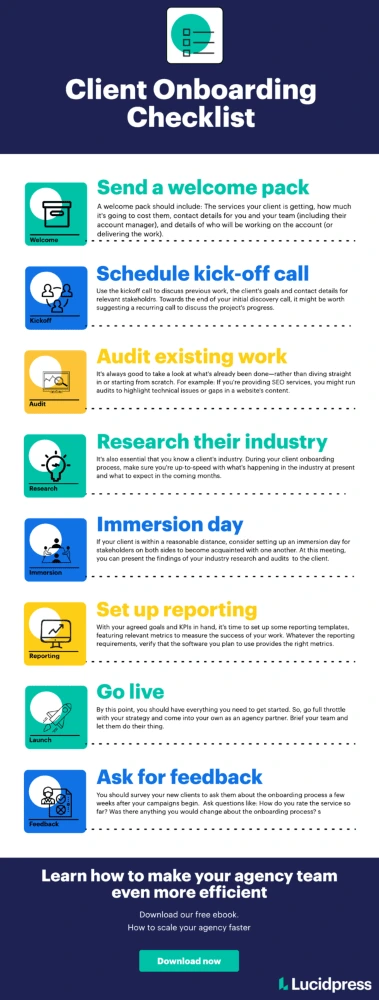
Now, you understand the importance of offering a great service to retain your clients, and you know that it starts from the very first day of working with a new customer. But how do you ensure the onboarding process goes smoothly?
Here are eight things you’ll need to do when bringing a new client onboard.
1. Send a welcome pack and questionnaire
Your client onboarding process starts as soon as they’ve signed your contract. So, send out a welcome pack and questionnaire to bring them fully up-to-speed with your way of working, and answer any questions they might have before your agency starts delivering the work.
A welcome pack should include:
- The services your client is getting
- How much it’s going to cost them
- Contact details for you and your team (including their account manager)
- Details of who will be working on the account (or delivering the work)
You might also wish to include some timescales and turnaround times for the services provided. This helps to set boundaries and confirms expectations between the two parties.
Send a questionnaire at the same time, which asks key questions that are relevant to the work you’ll be delivering. Some of the things you might need to know include:
- Their target audience, customer or demographic
- Their budgets for the year
- Who they consider to be their main competitors
- Any upcoming development roadmaps or business campaigns
The questionnaire responses can help you tailor your offering to meet the client’s needs—and make sure you’re focusing on things they’re expecting results from.
2. Schedule a discovery kick-off call
A kickoff call is a great way to get some one-on-one time with your new client.
Whether you’re picking up the phone or planning a Zoom meeting, use your discovery call to go through the client’s questionnaire responses and learn more about why they’ve chosen to use your services.
The kickoff call can also be a great opportunity to discuss:
- Previous work, and any issues that occurred. (This might include asking what a previous agency did and whether there was anything the client didn’t like, so you can avoid similar roadblocks.)
- Your client’s goals and any KPIs you’ll use to report on your activity.
- Access to your client’s website, content management system, and Google Analytics or Ads accounts to prevent permissions from slowing down your first campaign.
- Contact details for relevant stakeholders on the client side, so you can get in touch with the right person at the right time.
Towards the end of your initial discovery call, it might be worth suggesting a recurring call—perhaps on a weekly or fortnightly basis—to discuss the project’s progress.
This is especially important in the onboarding stage, as you and the client get to know each other better. You want to prove you’re reputable, trustworthy and doing a good job, right?
3. Audit their existing activity
We know the feeling of being so excited to work with a new client that you’re itching to get started. But whether you’re delivering marketing or design services, it’s always good to take a look at what’s already been done—rather than diving straight in or starting from scratch.
You can get some great ideas on how to boost results, and identify potential strengths or weaknesses, just by doing just a little digging.
For example: If you’re providing SEO services, you might run audits to highlight technical issues or gaps in a website’s content.
If you’re delivering a social media campaign, however, browse their Twitter profile to see whether they’ve already got the foundations of a strong presence and just need a little tweaking to see an influx of results.
It’s a fantastic way to tailor your strategy to each client and search for low-hanging fruit that could deliver short-term results.
4. Research their industry
Sure, it helps to understand the products or services your client sells. But, it’s also essential that you know a client’s industry.
During your client onboarding process, make sure you’re up-to-speed with what’s happening in the industry at present and what to expect in the coming months.
Not only can this help you predict and plan around potential issues, you’ll also know what you’re competing with—and the tactics you’ll need to use to make their company stand out.
You can research a client’s industry by:
- Using social listening tools (such as Mention) to understand trending topics.
- Searching the topic in Buzzsumo and identifying industry influencers who may be helpful as part of a marketing campaign.
- Investigating what their competitors are doing with their SEO, content marketing and PPC activity using Ahrefs.
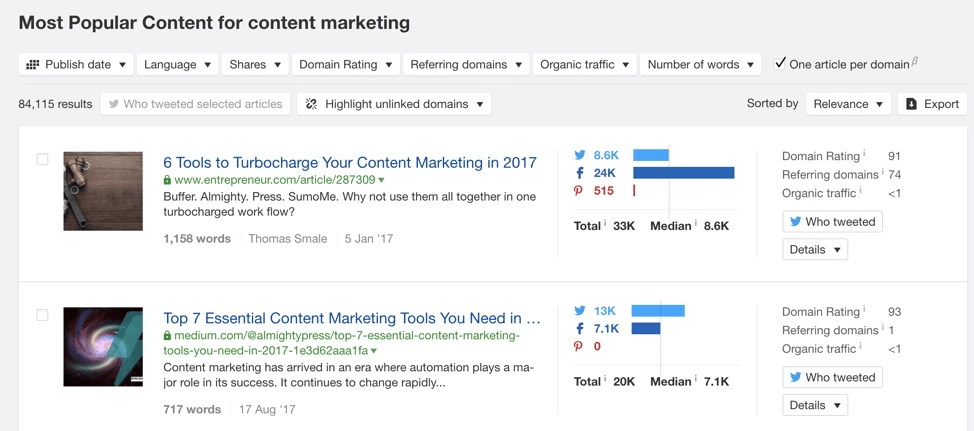
Source: Ahrefs
Prove to them you’re committed and eager to learn more about their industry—particularly if you haven’t worked with similar clients before.
5. Hold an immersion day
Granted, online calls are good if your client is on the other side of the world—but nothing can beat face-to-face meetings for getting to know people.
If your client is within a reasonable distance, consider setting up an immersion day for stakeholders on both sides to become acquainted with one another.
Take members of your team who will be working on the account. This will help them to get a feel for your client and their business—and more importantly, the boundaries your proposed strategy needs to fall within.
At this meeting, you can present the findings of your industry research and audits, as well as discuss next steps with the client. You could even take along some examples of your agency’s previous work or campaigns to show the client—especially if you’re unsure whether they’ll agree to out-of-the-box marketing ideas.
The immersion day is also a fantastic opportunity to get hold of essential documents you might need to deliver your work. This could include brand documentation such as:
- Buyer personas
- Brand guidelines
- House copywriting style guides
- Tone-of-voice documents
Remember: You’re trying to make a good impression. Don’t be afraid to go the extra mile if you’re hosting. Make it comfortable for your new client and reaffirm in their mind that they’ve chosen the best agency.
6. Set up reporting templates & tools
Following your discovery call and immersion meeting, you should now have a good idea of what your client wants to achieve.
With your agreed goals and KPIs in hand, it’s time to set up some reporting templates, featuring relevant metrics to measure the success of your work.
Let’s say you’re providing paid media services, for example. If your client’s goal is to reduce media spend and boost revenue, you’ll want to look at metrics like cost-per-click, revenue and ROI, and find a software that can report on all three.
For an SEO client, on the other hand, you’ll likely be monitoring keyword rankings and organic search traffic—which requires totally different software.
Whatever the reporting requirements, verify that the software you plan to use provides the right metrics, and that your in-house templates (where you’ll provide data from the software) are suitable for the client and tailored to their needs.
7. Go live!
Now that the majority of your client onboarding checklist has been checked off, let’s move on to the exciting part: launching your first campaign.
By this point, you should have everything you need to get started. So, go full throttle with your strategy and come into your own as an agency partner. Brief your team and let them do their thing.
During these first few weeks, make a conscious effort to double-check any deliverables to ensure they’re on point. Regular follow-up calls are a great way to keep everything on track and make sure everyone is on the same page.
Communication is key. You want to make a good impression early on, so it’s essential that you get it right—and that you’re open to feedback if the client has any suggestions.
8. Ask for feedback
After the initial onboarding stage has passed and you’re delivering work for the client, it can be tempting to focus only on the future. But, it’s important to take stock for a moment.
You should survey your new clients to ask them about the onboarding process a few weeks after your campaigns begin. It doesn’t have to be a long survey—remember, your client is probably ultra-busy.
But, you can ask some key questions to identify your strengths and areas for improvement, such as:
- How do you rate the service so far?
- Was there anything you would change about the onboarding process?
- Would you recommend our services or products?
Sending out a simple survey is a great opportunity for you to get feedback on your practices and adapt your onboarding plan for future clients to make it even more seamless next time.
Add a reminder to your client onboarding to-do list to make sure you don’t forget to ask for feedback. It’s likely that your current clients can suggest improvements to your onboarding process, which could help you convert new leads. Don’t shrug it off.
Key takeaway
Winning a new client is an exciting thing—and it should always be celebrated. But, you don’t want all the hard work that went into getting them onboard to be wasted.
A streamlined and sensible approach to onboarding new clients will help you deliver a great service, and it delight your customers at a crucial stage of your working relationship. Put these guidelines into practice to see the difference it makes first-hand.
Looking for ways to make your team even more efficient and grow your agency brand? Check out our free ebook: How to scale your agency faster
Open source learning. A global economy. Shifting demographics. These are just a few realities impacting your college recruitment strategy.
According to the National Student Clearing House Research Center, Spring 2018 college enrollment across U.S. campuses was down from the previous year. University and college recruiters have shifted to overdrive in response.
Related: How to improve higher ed student retention
Some focus on radio ads, alumni referrals and online recruiting fairs. Others build interest on social media and at live events.
Regardless of the outreach method, one thing is clear: In today’s higher education landscape, recruiters must be increasingly creative and strategic to attract new students.
A varied college recruitment strategy
“The times, they are a-changin’,” sang Bob Dylan. Want to keep up? Pay attention to your audience.
Today’s students don’t want a cookie-cutter version of their parent’s university experience. They’re also not impressed by (pun alert) old-school marketing tactics.
Instead, create a varied strategy that will reach your top prospects on multiple channels. Essentially, you want to provide engaging information that helps your college sell itself.
Use multi-channel enrollment marketing
Most colleges and universities know their target demographic well, and they market to basically the same audience year after year.
However, success also depends on reaching new targets via a multi-channel approach:
- Website — a branded, responsive hub that’s easy to navigate and engaging to use
- Blog or vlog — where interested prospects go for bite-size information
- Social media — critical online outreach, both locally and internationally
- Email campaigns — important tactic for lead generation and nurture
- Direct mail — still relevant and effective marketing for certain audiences
- Phone calls — an effective, if time-intensive, method for personal outreach
- Brand ambassadors — relatable outreach by faculty, students & alumni
- Parent outreach — critical influencers of your target audience
- Campus visit days — highly successful recruiting events, up close and personal
- High school visits — successful outreach that meets students where they are
- College fairs — key events that can market your institution both off and online
- International markets — a growing segment of your target audience
Now, for a few of the most helpful enrollment marketing strategies…
Recruiting college students online
It’s no surprise that most prospective students live online, particularly on mobile technology.
So, today’s recruiting strategies must be mobile-friendly. End of story.
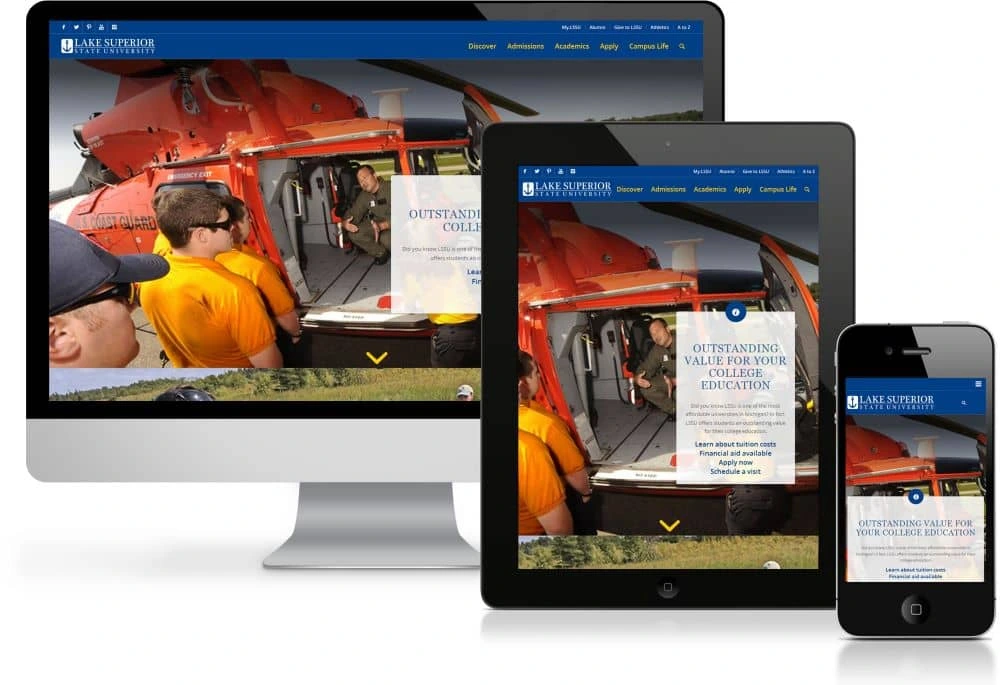
Source: Lake Superior State University
Responsive web design is no longer optional. But, you’ll stand out even more by offering mobile-friendly instruction and interactive pages.
For instance, students are wondering what they’ll learn on your campus. Why not show them instead of tell them?
Continuing education is common enough. But, standout institutions are experimenting with AR, game-based platforms and social learning models. Just one interactive feature on your site can put you ahead of the curve.
Even without all the technological bells and whistles, you can still provide value to new recruits.
Offer valuable resources
Don’t just throw a bunch of content on your website and call it good. Instead, create a user-friendly path that puts visitors at ease.
Which resources are clicked on the most? These might include:
- A catchy, above-the-fold video
- A listing of popular majors
- Programs and career opportunities
- Student and alumni testimonials
- Admissions deadlines
- Financial aid information
- Data-rich infographics
Simplify the application process
Of course, what you don’t include on your homepage can be equally important.
Generally, anything that simplifies your navigation and motivates would-be students to apply online is a good thing. Often, it means including more white space in your webpage design.
Face it—applying for college can be a daunting task even for the initiated. So, a user-friendly interface is essential.
Why not include a pithy video tutorial or a colorful step-by-step checklist to make the application process less painful?
Also, non-traditional students (e.g. adult learners, international students) generally want to know about credit transfers, flexible course listings, and financial aid options.
Build your blog
Most colleges today have a blog. What about your college?
More importantly, does your blog cover the topics your prospects care about most?
Boston University’s blog regularly shares pithy thoughts and videos by faculty members.
Likewise, Cornell University publishes “life on the hill” posts that help wannabes sample current students’ daily academic routines.

Source: Cornell
Your blog might also feature guest posts by alumni, video tours, listings of popular courses, and user-generated content.
And of course, the most popular blog posts should factor into your upcoming email campaigns.
Direct interaction with prospective students
As you can see, a successful recruiting strategy contains many moving parts. But, personal interactions (phone calls, campus visiting days, etc.) are still the most powerful of these.
According to Hanover Research:
“Despite increased digital activity, a recent survey found that the most effective marketing strategies for universities are nevertheless events‐based and involve direct interaction with potential students.”
After all, sometimes it really is about your newly upgraded facilities, swanky campus and student perks.
Most prospects who’ve gotten this far already know about your tuition costs, financial aid options, and faculty-to-student ratio. A successful campus visit just helps close the deal.
International student recruitment
Quick—what’s the Chinese version of Twitter?
If you’re recruiting students from China, you already know the answer to this question. (It’s Weibo, by the way.)

Source: Statista
As you can see, international student recruitment is alive and well at American colleges and universities.
As discussed earlier, your website needs to be user friendly and easy to navigate. This is particularly important if you’re appealing to international students.
Your site should help this target demographic understand the advantages of studying in America—and at your institution specifically.
Simple videos and infographics can also help smooth potential cultural barriers.
Do you already feature international students in your recruiting videos? If not, now’s the time to help them share their story—in their language.
As appropriate, include video links in your email campaigns. Share these on international social media channels.
Your website should also include pages dedicated to the specific needs of international students and recruits.

Source: Cornell
Reduce educational jargon
Higher education is adrift in educational jargon, which can be painful even to American-born students.
All those acronyms can be excruciating to international applicants. Whenever possible, cut them out and use a simpler description.
In the end, remember: Every positive interaction with a brand depends on clear communication.
Key takeaways
Now that you’re familiar with what it takes to build a successful recruiting strategy, let’s wrap things up by considering the real-life example of Western Colorado University. WCU’s creative team struggled to manage their recruiting strategy and materials, as they were too busy trying to keep their head above water.
Read Western Colorado University’s full case study here to learn how they dealt with their recruiting and marketing problem.
Is your school delivering a strong, consistent message with its brand marketing? Learn more in our free ebook: Branding in student recruitment
Every sales manager knows how difficult responding to an RFP can be. From wrangling subject matter experts to formatting your responses, getting everything together without an efficient process feels like a race against the clock.
Related: How to respond to an RFP (request for proposal)
The pressure is enough to make you think about abandoning the proposal altogether. But before you give up, there is a way to help things go smoothly without pulling your hair out. RFP software helps you manage the process without having to start from scratch with each new request that comes in.
Benefits of RFP software
When it comes to responding to requests, time is of the essence and automation is key. [![]() ] A good RFP tool helps you build a knowledge base of past responses and assign questions to staff for review.
] A good RFP tool helps you build a knowledge base of past responses and assign questions to staff for review.
The best RFP software:
- Saves time in generating answers to common questions. Since your company is likely to work on several similar proposals, you’ll be able to reuse past responses.
- Keeps you organized. No more merging multiple documents, copying and pasting from emails, or having to transcribe verbal answers. Responses are saved in a common library where you can tag and organize them in a way that makes sense.
- Accommodates multiple users. Your RFP response is a team effort. You’ll likely have multiple contributors, as well as reviewers who need to approve things before submission. Being able to collaborate seamlessly in the software is critical.
- Makes it easy to update outdated content. The right RFP tool shows you how old your answers are, so you can update responses as needed to keep content fresh. Some software gives you the ability to create review cycles so you don’t have to think about how often to update information.
Tips for a successful RFP
Even the best RFP management software won’t fix a broken proposal process on its own.
If you’re looking to improve the procurement process, here are some tips on how to make your next RFP a success.
1. Have a kickoff call
Start the process with a call that includes all members involved in the procurement process. This includes SMEs, reviewers, and marketing team members formatting the final proposal.
2. Set clear expectations
Make sure everyone knows what their role is and how to do their job. This includes training new members on RFP software.
3. Stick to the plan
Don’t overcomplicate things by straying off-course. Every member has a job to do, and they need to be willing to follow the same process and timeline as everyone else.
4. Create internal deadlines ahead of the RFP closing date
Plan for the unexpected. Internal deadlines should be far ahead of the final due date. This way, problems can be addressed before submission.
5 Best RFP Softwares to Choose From
1. PandaDoc
Rating: 4 stars and above
PandaDoc offers RFP generation software and eSign technology. The RFP software offers reusable proposal templates, customizable design elements and custom pricing tables. The software also integrates with Hubspot, Salesforce, PayPal and Insightly.
2. Qwilr
Rating: 4 stars and above
Qwilr RFP software offers design blocks with text, videos and other embeddable features that can be saved and reused in every proposal. The software also includes interactive pricing, so prospects can learn about additional line-items and upsells related to their initial proposal. Teams can use real-time collaboration features to coordinate on a proposal, and the software offers several integrations and security features.
3. Proposify
Rating: 4 stars and above
Proposify offers templates, e-signature capabilities and a content library with case studies, product descriptions, images and bios. It also offers interactive quoting capabilities and analytics metrics on which proposals were viewed and when.
4. ClientPoint
Rating: 4 stars and above
ClientPoint also offers templates and a master content library to quickly pull RFPs together. It integrates with Salesforce, HubSpot, ZOHO and other CRM tools. A live dashboard tracks whether proposals have been sent, viewed or signed. Analytics data shows how long a prospect viewed a document and if they shared or downloaded it.
5. Lucidpress
Rating: 4 stars and above
Lucidpress is a brand templating platform that makes it easy for sales teams to quickly create on-brand proposals. The software offers pre-designed templates, a brand asset library with saved colors, fonts, logos and images and you can quickly auto-populate information with data automation features.
Creating on-brand proposals for your RFP
While RFP software is great at orchestrating the process and saving time, one thing it may not be so great at is creating branded proposals that match other company documents.
Your marketing team invests a considerable amount of time into building your brand. Instead of creating a generic proposal using templates provided by your RFP software, tap into their creative genius and use a branded proposal instead.
Lucidpress makes it easy to create beautifully branded proposals, and getting started is easy. You can design a new template from scratch, choose one from the template library, or import an existing file from InDesign.
Next, add smart fields to your document. These dynamic fields auto-populate information (like name, job title and contact details) to save proposal creators time.
Once you have all static elements and smart fields in place, lock down the parts of your proposal that don’t change (e.g. brand logo, fonts and colors). This keeps editors from accidentally changing information that is essential to your brand identity.
After document setup is complete, save your template so others can use it.
Proposal editors can now access the files they need and share proposals directly with the client when complete.
Key takeaways
Creating RFPs is hard work. Using RFP management software streamlines response time by providing a knowledge base to reuse winning answers and empowering team members to collaborate in real-time.
Once you have your responses in order, ditch the cookie-cutter files provided by your RFP software and create beautiful, on-brand proposals with Lucidpress.
Want to get a head start on your next RFP? Take a look at these sales proposal templates.
When you’re managing a busy sales team, you might fall into the trap of “anything goes.” It doesn’t really matter how your reps take someone from stranger to customer; it matters that they’re doing it, right?
Not necessarily.
A mismatched sales team could deliver promises they can’t keep, fail to convert leads, and be generally unproductive—something that costs companies at least $1 trillion every year, along with poorly managed leads.
Related: How to create engaging assets for your sales team
What if I told you all of those issues could be prevented by spending a few hours creating one single document?
Spoiler alert: You can. It’s called a sales playbook.
In this guide, we’ll show you how to create a winning sales playbook, with tips & tricks to help you format your own.
What is a sales playbook?
A sales playbook is a document that outlines everything your sales team needs to know to succeed.
It covers basic elements like a rundown of the products or services they’re selling, while also diving into detail with things like your brand’s tone of voice, cold email scripts, and information about the people they’re selling to (i.e. buyer personas).
In a nutshell: A sales playbook is the one document your entire sales department needs to close deals… and close them often.
Why bother creating a sales playbook?
I know where you’re at right now: You’re sick of creating boring documents that lurk in the bottom of your Google Drive, never to be seen again a few weeks after you initially introduced them.
Trust me when I say sales playbooks aren’t like that.
These documents contain everything your sales reps need to make a sale, which is bound to lead to more efficiency.
A report by HubSpot found that salespeople spend just a third of their day talking to prospects. The other time is spent writing emails (21%), entering data (17%), and prospecting or researching leads (17%). [![]() ]
]
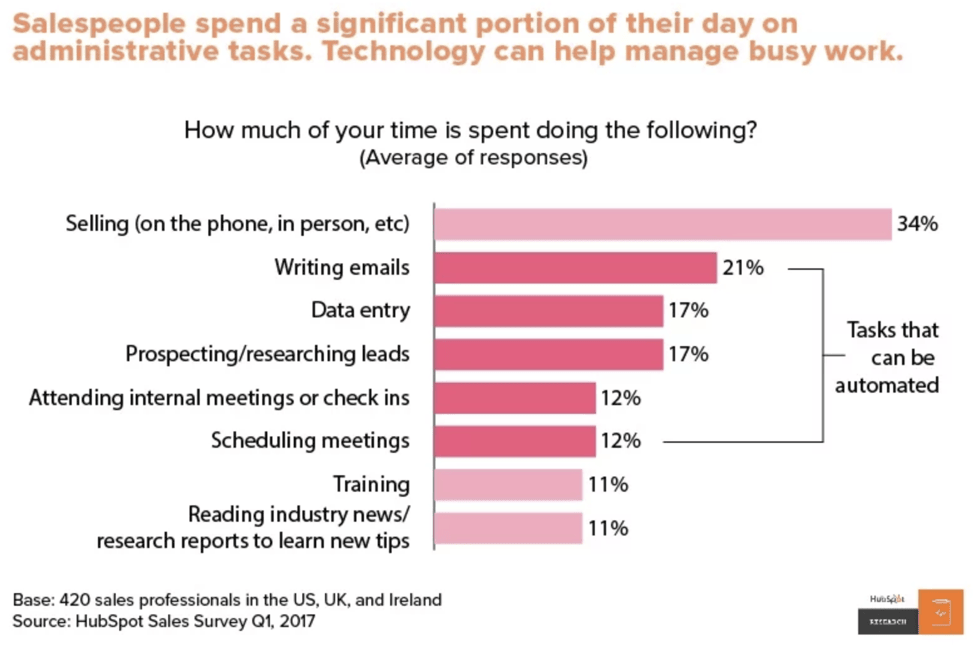
Source: HubSpot
A sales playbook will solve all three problems because:
- It contains scripts for cold emails.
- It shows sales reps how to use their CRM more effectively.
- It specifies the step-by-step process for finding warm/hot leads, while detailing buyer personas so they don’t spend time trying to convert irrelevant people.
That’s over half of their daily schedule that could be better-spent talking to customers.
But if that’s not enough to convince you, remember that a sales playbook is the “ultimate guide” for your entire sales team.
Think about the reputation your business gains when your sales representatives are discussing your brand to the public day-in, day-out. You want to make sure they’re giving a good impression, right?
Sales departments who reference an in-house sales playbook are always on the same page. They know what’s expected of them, understand how to communicate without going against your brand values, and stick to sales processes you know aren’t too pushy or forceful.
That’s bound to lead to brand consistency—and the chance to increase overall company revenues by as much as 23%.
You’d be mad to miss out.
What should my playbook include?
Are you convinced it’s time to create your own sales playbook?
Before you rush off and hold a sales department meeting to run through the notes you’ve put together, think about what actually needs to be included in your document.
That usually includes the answers to these questions:
- Company info: Why did your company start? Who owns or manages it?
- Your products/services: What does it do? Why does someone need it?
- Brand guidelines: Are you a cheeky brand known to tell the odd joke, or are you serious and professional?
- Buyer personas: Are your typical customers aged 55+, live in California, interested in expensive cars and own a software company?
- Sales & buying processes: Do you typically offer a free trial before convincing someone to buy? Or is your product a one-off, low-value purchase that usually converts after sending 3-5 targeted emails?
- Selling methodology: Do you use cold emails or account-based marketing tactics?
- Pre-made content: What should your emails, follow-ups & cold call scripts look like? What additional sales enablement content do you need?
- Tools they’ll need (with access details): Which CRM do you use and how can they access it? Do you use any other sales tools or software?
- KPIs: How does a sales rep know they’re performing well? How many sales are they expected to close per week? When do they need to improve? Learn about specific sales KPIs in this post.
- Payment for commission: What percentage does your sales team earn on deals they close? Do all sales generate commission? If not, what’s the qualifying criteria?
How to create your own sales playbook template
By this point, you’ve got a solid idea of what your sales playbook should include. What you might not be so certain about is how you’ll package so much information in one document.
It’s a tricky situation: You don’t want it to be overwhelming (to the point where it becomes a chore to read), yet you also want to arm your sales department with enough information to be productive.
The good news? You don’t have to start from scratch.
There are hundreds of other sales templates that you’re able to customize by simply searching for them in Lucidpress—like a proposal or presentation, for example.
Simply add your information and create more pages, and you’ll create your own professional sales playbook that’s almost ready to distribute across your entire team:
Source: Bright business ebook template
The sales playbook you create in Lucidpress is totally secure. Links are protected, meaning only your team can access it—and it’s not visible to Joe Bloggs if the link accidentally goes public.
3 tips for maximizing the value of your playbook
By this point, you’ve got a fancy-looking document that’s in review—and almost in the hands of your sales team.
Take some time to check whether your sales playbook is easy to read. Nobody is going to extract value from your document if they can’t understand it, right?
Here are three incredible tips you can use to maximize the value of your sales playbook.
1. Deliver a mini-training when introducing your playbook
Chances are, your sales team won’t read your playbook if they aren’t motivated to do it. But, you don’t want to be jumping down their throats or sending daily reminders to open your playbook. Both of those are a total waste of time.
That’s why you should consider delivering a mini-training when you’re introducing it. Bring your playbook up on the big screen and invite the entire department to see it. Then, run through the entire playbook from start to finish, and end with an ask for questions.
That way, you can spot areas that need improving before they start regularly referencing it.
2. Don’t start from scratch
It’s easy to get carried away with your sales playbook template and want to overhaul your entire sales process. However, starting from scratch could do more harm than good.
Start by analyzing the content you already have, instead.
Does your team already use email or phone call templates? Do you have a branding guidelines document that you send to freelancers? Did your CEO record a video on why they started the company in the first place?
Each of these sales playbook features can be copied and pasted—saving time and effort.
3. Ask for feedback
Whether your cold email script has an extra comma or you’re missing a key trait your typical customer has, some issues are easier to spot when you get a second opinion.
That second opinion should come from your experienced sales reps, because they’re the people who know your target customers inside out, and they likely have their own techniques proven to nudge a lead into purchasing your product or service.
However, you should get feedback from all staff, not just your best sales reps.
Why? Because other members of staff are likely experienced with each part of your sales playbook. For example: While a sales rep might have a cold email template, it’s wise to have a copywriter look over it for any spelling mistakes or recommendations to make it easier to understand.
So, invite your:
- CEO or founder
- Copywriting team
- Product marketers
…to glance over your sales playbook template before you begin to roll it out.
It sounds simple, but it’s a fantastic way to prevent small mistakes from becoming big, conversion-blocking problems.
Key takeaways
As you can see, creating a winning sales playbook isn’t an easy task for any sales manager.
You’ll have to dive in and analyze your sales process, create solid buyer personas, and give a full rundown on how to use your product or service before it becomes a lead-dripping ultimate guide.
But as hard work it is, remember it’s the only document your entire team will need to become a sales powerhouse—and grow your business at a rate you’ve never seen before.
Color is a big part of our world.
The colors we surround ourselves with can impact our mood, change our energy levels, invoke memories, and even influence our decisions. As you can imagine, color is a powerful player in people’s perceptions of your brand as well.
A blog post on Elle & Co. says 60% of people decide whether they’re attracted to a message based on the color alone — and color reinforces brand recognition by up to 80%.
Point is, color makes a big impact on customers.
This is why Google has reportedly tested 41 different shades of blue in its logo to see which blue performed best. The winning color, according to dozens of charts and graphs, was not too green and not too red.
“It’s interesting to see how you can change the way that people respond to the Web in ways that are not intuitive,” Google executive Marissa Meyer explained.
Color branding is about your customers
Many brands have a signature color (or colors) that makes them easily recognizable.
In many cases, it would be odd to see their logo in a different color. Can you imagine McDonald’s golden arches in a bright purple instead? What if Starbucks’ logo wasn’t green & white, Pepsi’s logo wasn’t blue & red, and Target’s wasn’t red all around?
When we see that bubblegum-pink writing, we know it’s Barbie — and when we see the tiny blue f, we know it’s Facebook.
But, it’s not just the logo. As an article on SpellBrand suggests, there are many ways to incorporate color into your branding:
- advertising
- business cards
- employee uniforms
- interior design at retail locations (and in the office)
- letterhead
- marketing materials
- product packaging
- signage
- social media graphics
- website
According to Aprimo, marketing activities should focus on customers to create positive experiences each time they interact with your brand. Color will be part of those interactions, so deciding which color to use often comes down to who your customers are.
Emma Foley, design lead at Clique Studios, says, “As much as you might want them to, everyone is not going to be your audience. So, if you focus in and build a strong community of people you want to talk to, you can do a lot with using color as the first interaction with those people.”
For example, color has the power to make your website stand out among similar websites.
“One of your website visitors might think, ‘They are using this hot pink in a world of traditional blue and that’s really interesting. I want to learn more about this company’,” Emma explains.
She says there are really two schools of thought about how companies should manage color: 1) this is our brand color so we have to use it or 2) play around with colors because the rest of the brand is strong.
Before deciding which color makes sense for your brand, it’s important to take a step back and think about what colors mean.
What is color psychology?
Simply put, color psychology is the study of colors and their impact on human behavior. Sometimes color can influence unexpected things like our sense of taste. According to Neil Patel, “Color is 85% of the reason you purchased a specific product.” Sounds like good enough reason to implement a couple color psychology tricks into your own branding efforts.
However, keep in mind that our feelings about certain colors are personal and depend on both life experience and culture. For example, while the color white is used in the Western world to represent purity & innocence, in Eastern countries white is a symbol of death & mourning.
Types of colors and their impact on human behavior
The color wheel features two types of colors: warm tones & cool tones. Warm colors include red, orange & yellow and are associated with energy, passion & creativity. These tones are great for adding life to your designs. Cold colors include green, purple & blue and have a calming, soothing effect on people. (This is why you never see flashy colors in hospitals and waiting rooms.)
There’s another type of color which isn’t represented on the traditional color wheel: neutral tones. Neutral tones include white, grey & brown. In design, these colors are mostly used for backgrounds. To make those colors stand out more, you can add texture to your artwork.
Color psychology in branding
The concept of branding is based on the belief that colors (and other design choices) can evoke specific reactions & feelings. Despite the ubiquitous use of color in marketing, there’s not enough research to back up every assumption. However, over the years, marketers & designers have identified patterns that appear to influence customers’ purchase decisions.
If chosen correctly, your color palette can influence how customers feel about your brand.
Red

Source: Unsplash
The color red is associated with intensity, emotion, and a sense of urgency. It can invoke feelings of active energy, passion, trust, love, intensity, aggression, excitement and appetite.
McDonald’s uses red to provoke the appetite and a feeling of urgency. (Good move for a fast-food chain.)
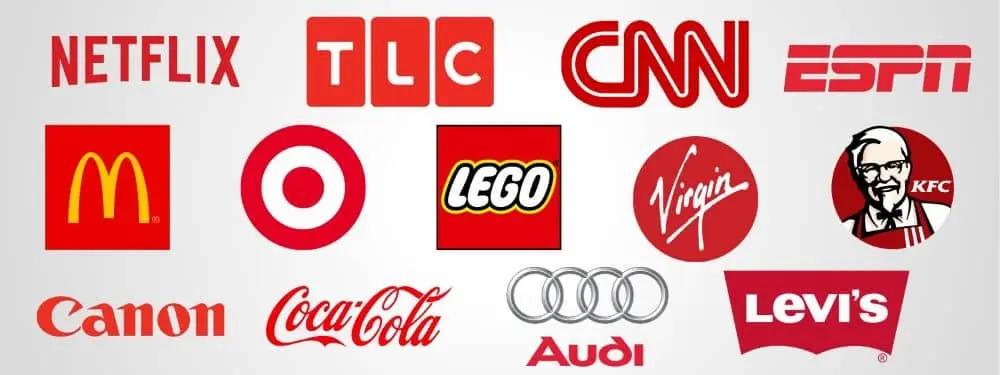
Made in Lucidpress
Brands that use red: McDonald’s, Audi, Coca-Cola, CNN, Lego, Canon, KFC, TLC, ESPN, Target, Levi’s, Virgin and Netflix.
Blue

Source: Unsplash
While there are many shades of blue that mean different things, blue is generally associated with depth and stability. It’s associated with conservative judgment, confidence, truth, order and understanding.
Invoking feelings of peacefulness & reliability, blue is the favorite color of tech & finance companies. For example, look at Facebook and Twitter. Those two companies use different shades of blue to portray trustworthiness & authority.
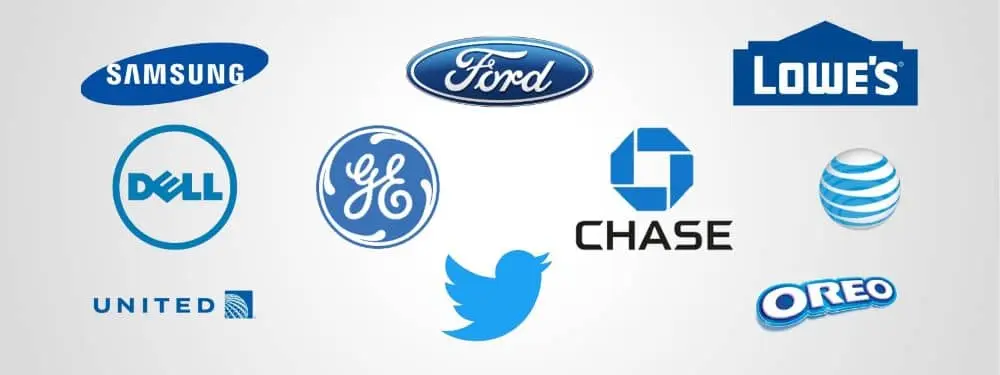
Made in Lucidpress
Brands that use blue: United Airlines, Chase Bank, Dell, Ford, General Electric, Twitter, Oreo, Lowe’s, AT&T and Samsung.
Yellow

Source: Unsplash
Yellow is a bright & vivid color associated with positive energy, sunshine and freshness. It can make people feel alive, energetic, cheerful and optimistic. In branding, yellow tends to grab attention as a very bright color that stands out. Snapchat uses yellow to appeal to younger generations and make their experience light & fun.
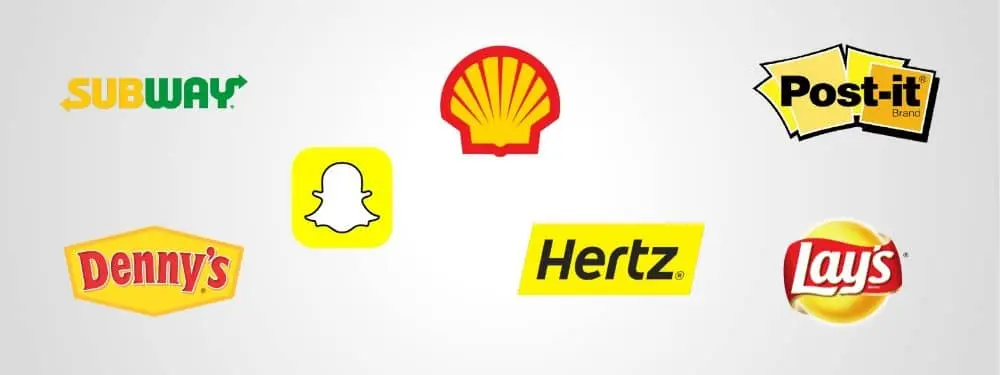
Made in Lucidpress
Brands that use yellow: Subway, Shell, Post-it, Lay’s, Denny’s, Hertz and Snapchat.
Beige & ivory

Source: Unsplash
While it’s not used too often, beige and ivory can invoke a feeling of simplicity, calm and pleasant stability.
Tilemark is a great example of a brand that uses beige & ivory.
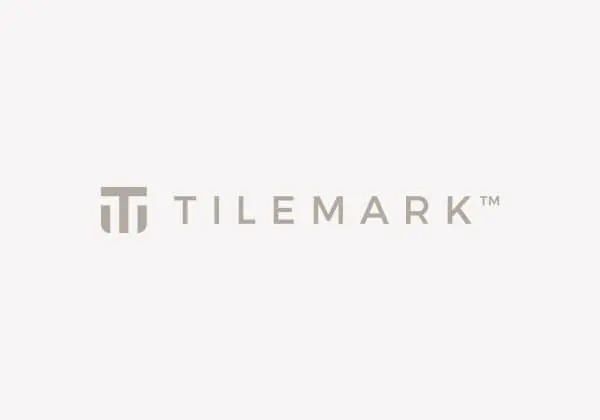
Source: Tilemark
Gray

Source: Unsplash
Gray is associated with security, reliability, dignity, practicality, conservative judgment, calm and intelligence.

Made in Lucidpress
Brands that use gray: Wikipedia, Swarovski, Lexus and Nissan.
Green

Source: Unsplash
The color green is associated with the harmony of nature, the environment and renewal. When looking at green, people often feel calm, relaxed, trusting, peaceful, hopeful and healthy.
Green is all about nature and is used by bio-friendly, organic and sustainable brands. If you want to portray your services as environmentally safe, green is your color of choice.
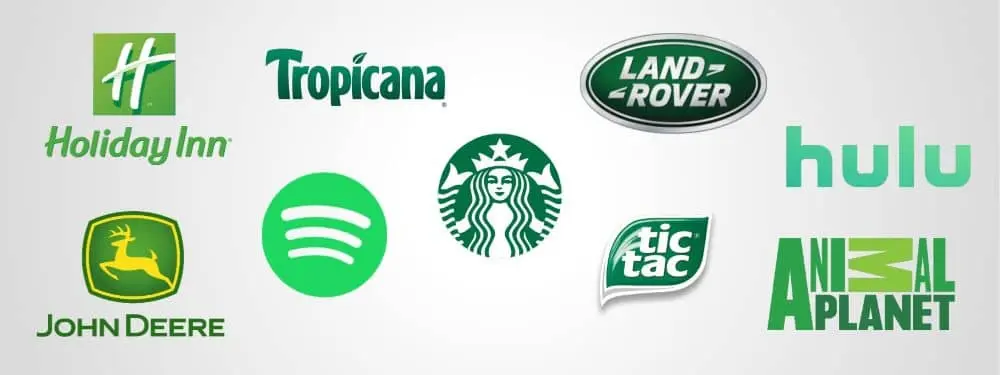
Made in Lucidpress
Brands that use green: Holiday Inn, Starbucks, Animal Planet, Spotify, Land Rover, John Deere, Tropicana, Tic Tac and Hulu.
Purple

Source: Unsplash
Purple is symbolic of luxury, royalty, glamour, power, nostalgia, romance, introspection, nobility, spirituality and wisdom. It also stimulates creativity and problem-solving.
For centuries, purple has been the color of royalty. (Before the modern age, purple dyes and fabrics were both expensive and rare.) With its history, it’s not surprising that companies use purple to portray their brands as expensive & luxurious.
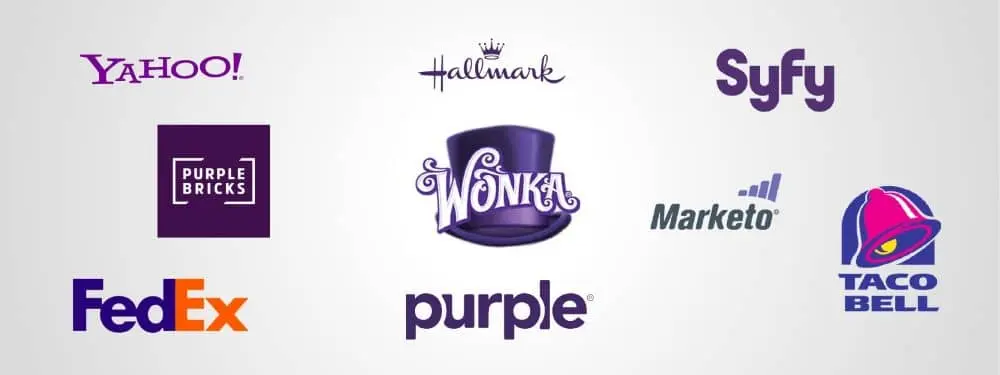
Made in Lucidpress
Brands that use purple: Yahoo, Marketo, FedEx, Syfy, Taco Bell, Purplebricks, Purple, Hallmark and Wonka.
Orange

Source: Unsplash
The color orange is associated with happiness, sunshine, citrus and the tropics. Orange is a playful color that makes people feel enthusiastic, creative and determined. It stimulates mental activity and supports energy, vibrancy and warmth.
Orange can be also associated with fire, combining the warmth of red with the happy brilliance of yellow. Orange tends to communicate energy & optimism. Usually, orange is associated with youth and creativity. If you want to look adventurous & competitive, orange is your color!
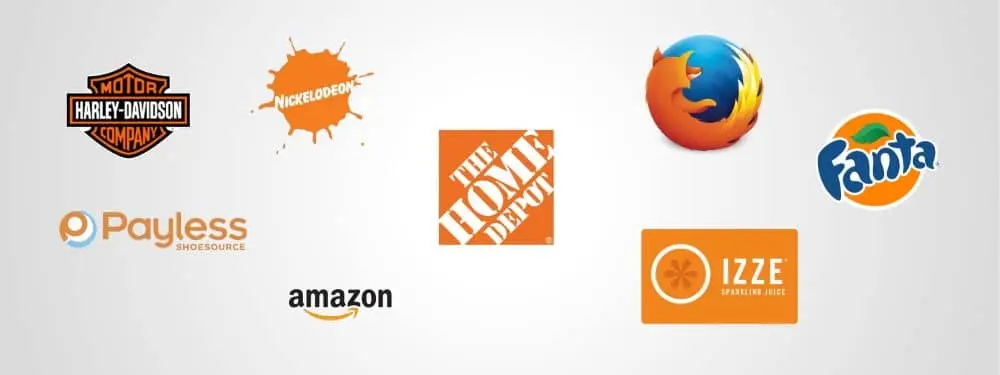
Made in Lucidpress
Brands that use orange: The Home Depot, Nickelodeon, Firefox, Izze, Amazon, Fanta, Payless and Harley Davidson.
White

Source: Unsplash
White symbolizes cleanliness, peace, innocence, youth, simplicity, purity and safety. As a reminder that colors mean different things in different cultures, it’s interesting to note that white carries connotations of death and mourning in many Asian cultures.
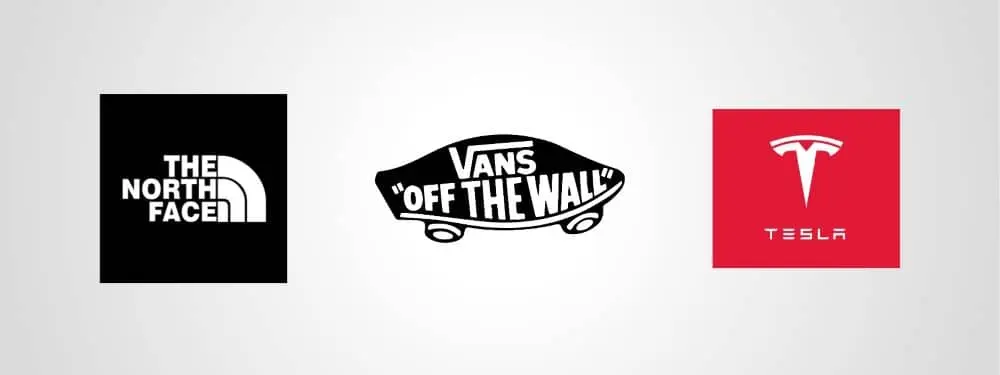
Made in Lucidpress
Brands that use white: The North Face, Tesla and Vans.
Black

Source: Unsplash
Black symbolizes luxury and the mystery of the night. It’s bold, serious, powerful, elegant, wealthy, stylish and sophisticated.
Like red, black can convey both positive & negative emotions. It can invoke associations of power & minimalism, or on the other hand, it can portray something dangerous or gloomy. Depending on the context, its meaning can differ. In branding, however, black usually comes across as exclusive & luxurious.

Made in Lucidpress
Brands that use black: Chanel, Nike, Adidas, Louis Vuitton, Prada, Puma and Lamborghini.
Pink

Source: Unsplash
Pink symbolizes love, romance, tenderness, caring, sweetness, warmth and youthful fun.
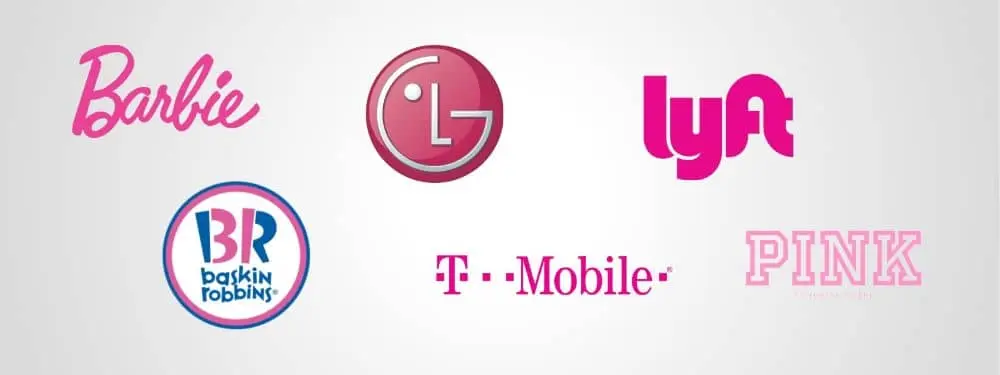
Made in Lucidpress
Brands that use pink: Barbie, Baskin Robbins, T-Mobile, Lyft, LG and PINK.
Brown

Source: Unsplash
Brown is associated with the earth, reliability, support, dependability, the outdoors, simplicity, endurance and support.

Made in Lucidpress
Brands that use brown: UPS, Hershey’s, M&Ms, Gloria Jean’s Coffee and Cracker Barrel.
Key takeaway
While color has the power to affect people’s moods, choosing your brand colors shouldn’t be based on emotional response alone. As Emma Foley of Clinique says, “There’s so much more that goes into a brand than a logo and color.” Once you understand your brand’s customers and values, you can create a brand color palette that speaks to them.
Ready to start testing your new brand identity? Try creating a few logo variations in Lucidpress, using your brand colors.
Have you ever worried that your brand messaging is a bit… generic? Does your copy sound flat and uninteresting? Do customers feel like your brand is speaking at them, not to them?
These are questions many brands grapple with on a daily basis. Some focus so much on pleasing everyone that they end up pleasing no one. Either way, the results are a tired brand and conversion rates that hit new troughs every week.
Related: How to create a voice for your brand
As any seasoned copywriter will tell you, it’s much easier to convince a single person to choose your brand than to convince a large group. By personalizing your campaigns, you add intimacy, authenticity and trust—vital ingredients for improving conversion rates.
To personalize effectively, however, you first need to understand who your buyers are. The best way to do that is to create buyer personas.
In this guide, I’ll show you why buyer personas matter for B2C brands and how to make them.
Buyer personas: Not just for B2B marketing
What does your ideal customer look like? What websites do they frequent the most? What are their likes and dislikes?
A buyer persona helps you answer these questions and more. Think of it as a fictional portrait of a specific customer that helps you understand their mindset and create better targeted campaigns.
What is a buyer persona?A buyer persona is a fictional portrait of a specific customer that helps you understand their mindset and create better targeted campaigns.[![]() ]
]
This specific customer doesn’t actually exist. Rather, they represent an entire consumer group. If your brand targets men aged 25-35, for instance, your buyer persona might focus on a 28-year-old single male who works in finance and enjoys playing video games.
Essentially, you create buyer personas so you can create campaigns that are more relevant and personalized. Instead of speaking to everyone’s concerns, you can tailor your messaging to address the concerns of a specific group.
This sample persona from the Buyer Persona Institute should give you a good idea of what we mean:
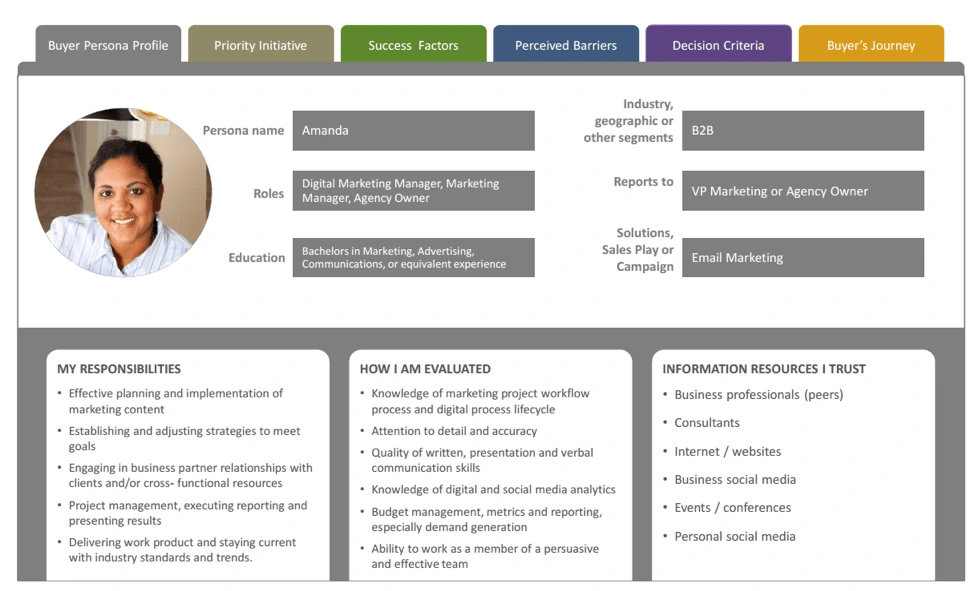
Your buyer personas should target customers who:
- want to buy your products, i.e. have clearly expressed a need and desire to buy from you.
- would buy your products, i.e. are a good fit based on their demographics & psychographics but need to be educated about the product first.
How many buyer personas you’ll have is up to you. A new startup with a single product might have just one buyer persona. A huge corporation like Microsoft might have dozens—even hundreds!—of personas.
How better buyer personas impact conversion rates
Have you ever landed on a website and felt that it spoke just to you? That it mirrored the values you believe in and addressed the exact problem you hoped to solve?
This likely wasn’t an accident; it was probably the result of meticulous buyer persona research.
While there are many ways to improve conversion rates—storytelling, design choices and website speed, to name a few—much of it eventually boils down to the same thing: the clarity of your messaging. When you can identify your customers’ deepest desires and address them directly, you won’t suffer from low conversion rates (and you won’t have to depend on design hacks to save you).
Take Apple’s MacBook Air landing page as an example.
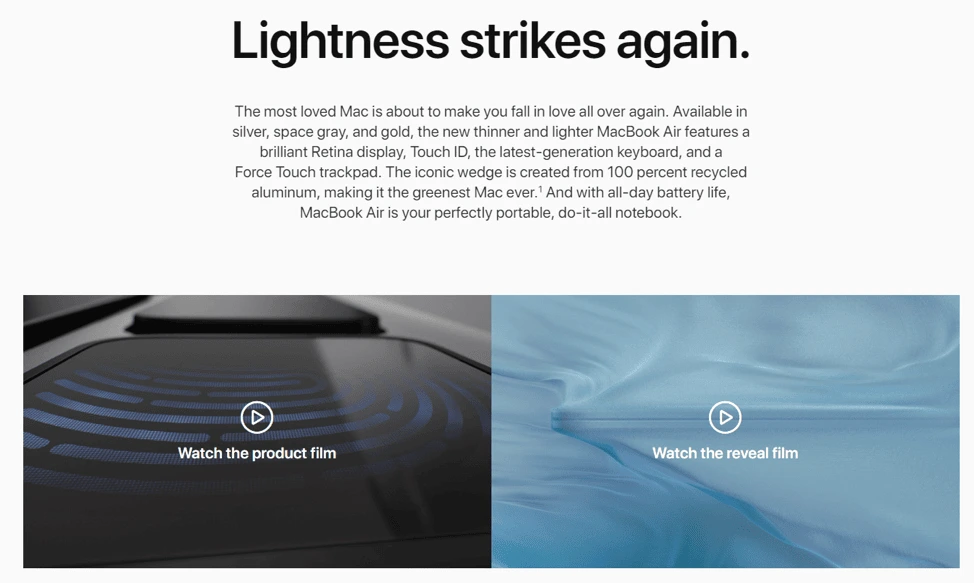
Right away, the copy addresses all the things MacBook Air customers care about:
- Low weight (“Lightness strikes again”)
- New features, especially Retina display
- Environmentally friendly design (“recycled aluminum”)
- Portability and battery life
The repeated use of “again” calls out to current MacBook users, using a bit of nostalgia to entice them to upgrade.
Without a detailed buyer persona, it would’ve been difficult for Apple’s copywriters to know which features to highlight and which to ignore.
This is the true value buyer personas bring to conversion rate optimization. By changing your copy to focus on the things your target audience cares about, you can achieve significantly better conversion rates.
Moreover, accurate personas help you understand your customers’ preferences, from the language & writing style to the visual elements.
If you have detailed buyer personas, you can create personalized landing pages (which convert better) and offer better recommendations to customers.
The question now is: How exactly do you go about creating these buyer personas? I’ll share some ideas below.
Gathering the information
A strong buyer persona is based on data & insight from market research. This first-hand information reveals demographic & psychographic information about your customers.
There are a variety of strategies you can use to collect this information, and here are a few examples.
1. Run surveys
Hosting surveys is a good way to gather information right from the source.
You can either run a survey on your existing customer base or place a pop-up survey on your website for visitors to participate in.
Make sure that you have a large-enough sample size for the data to be accurate. Don’t over-rely on survey results—self-reported data tends to be biased.
You can use software such as Qualtrics, SurveyMonkey or Qualaroo to help you create a survey.
Additionally, consider reaching out to your customer support & sales teams for insight, since they interact with customers on a daily basis.
2. Use your competitors’ data
If you don’t have a large customer base or heavy traffic on your site, you can look to your closest competition.
For example, you might use Google Alerts to know each time your competitor is mentioned online and analyze the source.
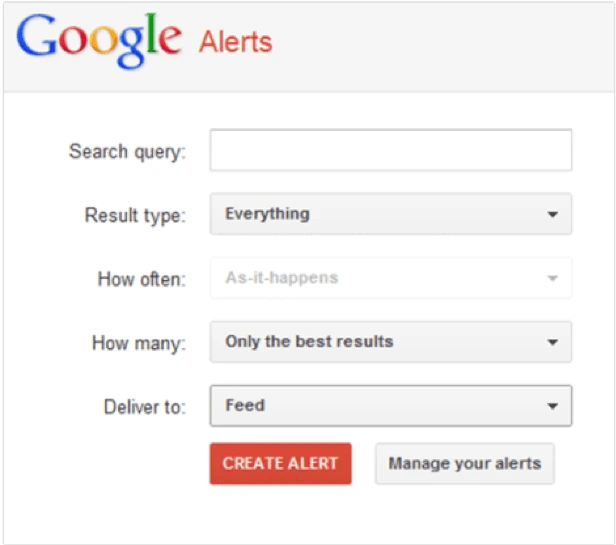
When any mentions pop up, ask yourself:
- Who is writing about my competitor?
- Which other topics, products and issues do they write about?
- What are the demographics of the audience leaving comments or sharing the article?
You can also visit your competitors’ Facebook, Instagram & Twitter pages to see how people interact with their brand (and what those people are like). Pay particular attention to their geographic location, ages and shared interests.
This kind of research is often subjective, but it can still give you a good indication of your competitors’ audiences.
3. Hang out where your customers are
Put yourself in the shoes of your ideal customer.
Hang out where they do and listen to what’s being said. It’s a direct way to discover insights about the language they use and the challenges they face.
You can also read through comments on blogs, hang out on forums, or even attend in-person trade shows and events.
For example, if you’re an athletic shoe brand, you might use Reddit’s search feature to find questions potential customers are asking about running shoes. This can help you zoom in on the problems these customers face and how to address them in your messaging.

Bring your buyer persona to life
Now that you’ve gathered the data, it’s time to make sense of it and bring your ideal customer to life.
Buyer personas are open-ended in terms of what you can or can’t include in them. Virtually anything that helps you understand the customer better is fair game. This includes everything from the customer’s (fictional) background & education to their favorite movies & brands.
Since you’re targeting B2C customers, you can let go of some B2B buyer persona conventions such as including the customer’s title & job duties.
That said, there are a few things every buyer persona should have:
- Name. Give your ideal customer a name to humanize them and make them easier to reference. This can be a first name or a full name; the choice is yours.
- Demographic information. Include basic demographic information about the customer, including their age, location and gender.
- Education level. The complexity of your copy and the features you choose to highlight will often depend on how educated your customers are.
- Background. Create a background story for the buyer. If they already know about your brand, explain how they came to find you.
- Psychographic information. What does the customer like? What do they dislike? Psychographic data can reveal a great deal about your customers, so pay special attention to this section.
- Motivations & values. What motivates your ideal customer? What do they want—from life, from work and from your brand? If you’re a value-based brand, what values will you highlight to appeal to them?
- Picture. Although it’s optional, putting a face to the buyer makes it much easier to visualize them and relate to their problems.
Bring it all together into a single Lucidpress document. You can keep it text-heavy or use a visual design—it’s up to you. For reference, check out this sample buyer persona:

Source: Shopify
Key takeaways
Creating buyer personas helps you speak directly to your customers.
By knowing the traits, values and priorities of your customers, you can craft personalized messaging that feels more relevant to them. The results are highly targeted campaigns with higher conversion rates.
Try it yourself by gathering data on your customers and summarizing it in a well-designed Lucidpress document.
What’s the best way for businesses to generate leads even with an empty pipeline?
You guessed it: cold calls.
That said, cold calls aren’t what they used to be. Today’s reps often rely on cold-calling scripts to do the conversational heavy lifting for them. Not only does this ensure that reps respect their prospect’s time, but it also helps reps overcome obstacles, build trust, and ultimately schedule a meeting.
Related: 10 cold-calling tips & techniques for your sales team
A brief history of cold-calling
Traditionally, cold calls are unsolicited phone calls to prospective customers — with the term cold indicating that you’ve had zero prior contact with the prospect.
So, why do cold calls wind up falling short? Well, there are a few reasons:
- Sales reps are not ready for the call — 42% of sales reps say that a lack of info and preparation is the reason why they don’t perform well.
- Sales reps don’t engage with the prospect’s pain points — According to Salesforce, 85% of prospects expressed dissatisfaction over how sales reps conducted themselves during cold calls.
However, there’s no reason that reps should make blind cold calls. With a little help from the ole internet and the sheer number of prospecting tools at your disposal (e.g., Salesforce, ZoomInfo), otherwise ineffective cold calls are transformed informed, effective cold calls, which is a cold-calling script comes into play. A cold-calling script helps bridge the gap between off-the-cuff and on-the-nose, and in turn, guides the conversation no matter the objection or hiccup.
The benefits of cold-calling scripts
Scripts are essential in successful cold-calling strategies and serve as the foundation in structuring your cold calls and, ultimately, improving conversations with prospects. To effectively leverage scripts, sales reps and teams ought to use them as conversational guides instead of repeating the content word-for-word. Think of cold-calling scripts as you would a foundation for a new home: the design is entirely up to you, but a house can’t be a home without the structural integrity of a foundation.
How to prepare for cold calls
The best cold-calling scripts are the informed ones. In other words: doing a little digging (about your prospect) prior to the call makes all the difference. Jeb Blount, the author of the renowned sales book, _Fanatical Prospectin_g, strongly believes that preparing (also known as prospecting) is the number one factor in successful B2B sales.
Combine prospecting with in-depth research, and you’ll have a recipe for success. The goal of your research is to know your prospects like the back of your hand — nearly 70% of buyers are more likely to make an order if the sales rep has made an effort to build a relationship and rapport with the customer. Be sure to make a note of essential company details, recent developments, or potential pain points that could aid your conversation.
- Company details
- Names
- Industry
- Product or service offerings
- Recent developments
- Social media updates
- Current events
- PR notifications
- Pain points
- Company reviews
How to draft the best cold-calling scripts
But before you or your reps hit the Net or phones, there are a few things you’ll want to keep in mind when crafting a cold-calling script.
- Be considerate with your greetings — respect your prospect’s time.
Today the average person has an attention span of 8 seconds — so you want to capture your prospect’s attention right off the bat. Provide your prospect with a brief introduction (name and title at the company) followed by a concise statement to explain why you’re calling. Ideally, in less than 8 seconds, your prospect should be able to know who you are, what your company is doing, and that you’d like to help them solve a pain point.
Sample script:
“Hi, Erin. I’m John from Lucidpress. We’re a brand templating platform that empowers B2B companies to create effective sales materials quickly. I’m calling to see if we can help your company.”
Don’t bother asking filler questions like “How are you?” or “Is this a bad time to call?” Your prospects are busy, so be direct.
If you find yourself being re-routed to an assistant instead of your prospect, be courteous and honest. And remember — know the names of your prospects (and their assistants) beforehand so you can start on the right foot and build trust right off the bat. For example:
“Hi, there. Is this Devon speaking? I’m John from Lucidpress, and I’m looking to get in touch with Erin from sales. Could you connect us?”
- Communicate value — ask questions to overcome obstacles.
Now that you’ve got the prospect’s attention, it’s time to ask a tailored question. This shows you’ve done your homework and helps build trust with prospects. More importantly, these questions help you confirm pain points and offer potential solutions.
For example, say your prospect is a chief marketing officer, and you’re calling them to talk about your company’s CRM, an ideal question would be as follows:
- How do you feel about the effort it takes to manage clients with your current CRM?
- What would you say is the most important benefit you’re looking for in managing your leads?
Avoid closed-ended questions during this stage of the conversation. It’s better to let the prospect spill out their problems than to wrongly assume their pain points. Plus, it keeps the conversation flowing and prevents proverbial doors from getting shut unexpectedly.
That said, should you encounter an objection, don’t dismiss it. Address it head-on by asking an open-ended follow-up question:
“Hi, Erin. I’m John from Lucidpress. We’re a brand templating platform that empowers B2B companies to create effective sales materials quickly. I’m calling to see if we can help your company.
What would you say are your biggest challenges in ensuring your sales team get the content and materials they need to convince leads?
Since your team isn’t experiencing any major content hurdles, would your team benefit from having additional access to branded collateral — like, customizable one-pagers or letterheads?”
- Come to a mutual understanding — build trust and rapport.
Once you’ve uncovered your prospect’s pain points, leverage your company’s value proposition as a means of alleviating these pain points. Doing so showcases how you’re uniquely poised to solve these problems.
Be sure to articulate how your company explicitly to solves their problem — so, save the introductory elevator pitch for another day. Your prospect should get the feeling that you genuinely understand and sympathize with their challenges, not that you’re trying to pull the wool over their eyes. For example:
“Hi, Erin. I’m John from Lucidpress. We’re a brand templating platform that empowers B2B companies to create effective sales materials quickly. I’m calling to see if we can help your company.
What would you say are your biggest challenges in ensuring your sales team get the content and materials they need to convince leads?
I empathize with the source of your frustration. Correct me if I’m wrong, but it sounds like your team is having trouble finding the right materials to close their sales. A lot of our clients deal with the same hurdle — getting the collateral you need to close a sale can be tough, especially when you don’t have enough resources on deck.
Now that I think of it, we work with a handful of companies like yours. Most have found our platform to be easy-to-use, while the template gallery reduces production time and puts the power of content creation in the hands of your sales reps — that way they can focus on curating the perfect content for their clients. Do you have platforms or services like this in-use?”
From here onward, let the prospect primarily do the talking. Ask a smattering of questions, but you want to ensure they feel heard. Some good questions to ask at this stage include:
- Tell me more about your problem or current solution.
- How does this affect the performance of your business/team?
- What is stopping you from finding a solution to this problem?
By peppering these questions throughout the conversation, your prospect winds up inadvertently emphasizing a myriad of reasons why your company would be a valuable asset to them — teeing you up for the perfect pitch.
- Be bold — ask for the meeting.
The end goal of any cold call is simple: set up a meeting with your prospect. And there are only two rules in asking for a meeting: set a time and a date. Make it easy for your prospects to say yes. Instead of saying, “Can we connect tomorrow or sometime this week,” try saying, _“_Can we connect this Thursday at 1 pm?”
Giving them a specific time and date makes it hard to say no, and it lowers the chance of that meeting getting delayed, which can happen when sales reps don’t have a definite timeline in mind.
A complete cold-calling script example
Curious what a complete cold-calling script example looks like? Check out our example below.
“Hi, Erin. I’m John from Lucidpress. We’re a brand templating platform that empowers B2B companies to create effective sales materials quickly. I’m calling to see if we can help your company.
What would you say are your biggest challenges in ensuring your sales team get the sales enablement content and materials they need to convince leads?
I empathize with the source of your frustration. Correct me if I’m wrong, but it sounds like your team is having trouble finding the right materials to close their sales. A lot of our clients deal with the same hurdle — getting the collateral you need to close a sale can be tough, especially when you don’t have enough resources on deck.
Now that I think of it, we work with a handful of companies like yours. Most have found our platform to be easy-to-use, while the template gallery reduces production time and puts the power of content creation in the hands of your sales reps — that way they can focus on curating the perfect content for their clients. Do you have platforms or services like this in-use?
Can you elaborate more on that?
How are you currently handling the problem?
How is this affecting the performance of your sales team?
Thanks for letting me know about your concerns, Erin. I’d love to swing by and explain how Lucidpress can help you with your sales team’s content concerns. Would this Thursday at 1 pm be a good time for me to stop by?
I’ll also send an email to you shortly summarizing our call today.”
Use cold-calling scripts to boost your sales team’s performance
By now, you should feel confident in your personal or your sales reps’ ability to craft effective cold-calling scripts. Alternatively, we recommend conducting a cold-calling script brainstorm session to customize your reps’ scripts further and boost team morale. As your reps periodically cold call new prospects, be sure to make a note of any objections or obstacles they encounter as these tidbits can further improve your cold-calling strategy down the line. And as always, feel free to share your cold-calling scripts or conversation tips and tricks.
Sales (of all kinds) should form the bottom line of your business. After all, sales are your prime profit focus. More importantly, well-played sales can lead to a snowball of success you need to make a go of things in the long-term.
But that’s pretty common knowledge for most B2B companies. However, what you might not realize is how you can leverage sales to work in your favor — even in a hyper-saturated market. And while doing so might be challenging at times, pairing strategy with account-based selling can help solidify your revenue, reputation, and goals.
Account-based sales is certainly not a new concept. But it is coming to the fore right now, with 86% of sales and marketing professionals using it to reach new customers. Injecting ABS into your sales strategy could go quite a long way towards helping you.
So, to help you get the ball rolling on your ABS strategy and sales, we’re going to delve into what precisely the account-based sales model is, and what it has to offer.
What is account-based selling?
Account-based selling is a B2B model that treats companies, also known as ‘accounts,’ as a single market. An ABS strategy does two things:
- Enables sales teams to make the most of existing resources; that way, teams don’t have to dedicate a singular rep to a singular, specific account.
- Empowers sales and marketing to create personalized content. So, instead of being forced to cast a wide marketing net that could potentially appeal to a variety of accounts, agents can create personalized content for every ABS effort
It’s worth noting that a solid ABS strategy involves a thorough prospect identification and vetting process. You need to be selective, so you’ll want to have a comprehensive identification and vetting process that sheds light on companies that genuinely fit your ABS criteria.
Not only does this allow you to implement the true power and capacity of your sales and marketing departments, but it also enables reps to target a prospect’s interests and pain points appropriately. From there, reps can provide personalized content with a much higher potential for ROI than your standardized sales approach.
Who is a good fit for account-based selling?
ABS can bring forward great revenue-boosting benefits to a company. That said, account-based selling doesn’t work for every company. Think of it this way — you can’t put a square peg in a round hole no matter how hard you try. The same applies to ABS: an ill-fitting account-based sales development could harm rather than help.
For instance, attempting to implement this method within a B2C sales model will lead to increased costs and tough-to-attain metrics. Even for B2B targeted organizations, ABS isn’t an automatic good fit. For example, if your B2B target is small-scale companies, the ABS sales method is unlikely to be a good fit and could leave you out of pocket.
So, when is an account-based selling model a sound choice?
Primarily, this comes down to companies that are dealing in complex B2B sales, enterprise-level organizations, and large-scale purchases. You should also have plenty of opportunities for upselling to ensure that the extra money and resources you use for each account have a guaranteed ROI potential.
How to implement account-based strategies
To get the ABS ball rolling, consult with your sales and marketing team. You want to uncover whether or not your company fits the criteria accordingly.
Once you’ve verified that account-based sales are the right fit for your sales team and company, there are a few things to keep in mind to implement ABS well and guarantee success every time.
- Step 1: Test your internal alignment. The ability of a sales and marketing team to work seamlessly together is a vital part of this process. As such, you need to test cloud processes and other collaborative efforts to make sure that this alignment works.
- Step 2: Build your ideal customer profile (ICP). We’ll talk more about the specifics and details that go into creating an ideal customer profile shortly, but it’s another vital piece of the puzzle. Only by building a picture of your ideal customer can you target accounts that have the right characteristics for you.
- Step 3: Measure relevant metrics to assess performance. Tracking performance is always vital, and your ABS strategy is no different. By measuring things like average deal size and lifetime value, you can determine where your account-based selling model is working, and where it needs attention.
How to find your ideal customer profile
An ideal customer profile, or ICP, is a detailed description of a prospective company.
To uncover your ideal customer profile, you’ll want to start by answering the following questions:
- Who is the ideal customer that would buy my product or services?
- What are the specific pain points my product or service offers a solution to?
- What are the specific benefits of my product or services?
- Is there a particular location for my customers?
- What is my ideal customer’s buying cycle?
Keep in mind this is a best-case, hypothetical scenario. Still, you also want these answers to be realistic and relative to the company because they’ll impact everything from your marketing team’s content strategy to your account-based approach. So it probably goes without saying, but you need to get this right.
From there, you’ll want to apply this information directly to your prospecting efforts. Start by identifying the firmographics and behaviors of your perfect customer base or, otherwise known as, an account-based audience. In general, these types of characteristics are directly connected to your target vertical and industry. Consider basics like:
- Industry
- Company size
- Buying motivations and triggers
- Location
- Lifetime customer value
This type of information allows reps to target account-based sales to companies that have a higher, more dependable chance of a conversion. Be sure to leverage these metrics throughout prospecting conversations, emails, and so forth.
At the end of the day, creating an ideal customer profile is the key to unlocking an effective ABS sales strategy. An ideal customer profile is your North Star of ABS — it can help you layout a roadmap for your prospect and when in doubt, shed light on whether or not a prospect is a right fit for your strategy.
The importance of personalized content and marketing
When created with your ideal customer profile in mind, personalized content and marketing can help reps seal the deal. Personalized content that looks and feels tailored will flatter and impress your prospects. Plus, it enables you to stand out against a crowd and empowers you to set your ABS strategy in motion. In getting this right, you can make sure you cater to and alleviate every pain point your prospect faces, making your company the most appealing option.
To create successful, personalized content that truly reflects both the ABS strategy and prospect, internal sales and marketing teams must combine their collective knowledge and expertise.
After all, sales reps genuinely understand what customers are searching for — and creative teams are well-versed in crafting beautiful, on-brand content.
However, content creation typically falls to the creative or marketing team, and the knowledge regarding customer needs or pain points can get lost in translation, rendering that valuable personalized content somewhat obsolete.
Given the opportunity, sales and marketing teams should work collaboratively to create sales enablement content. But in place of that, sales teams can use brand templating platforms (complete with professionally-designed, on-brand template galleries) to their advantage. A brand templating platform helps ensure that the ICP content accurately reflects a prospect’s needs and pain points — and the creative team can continue trucking along on other projects.
Tools you can use
Integration is another critical component of a successful ABS strategy. So you’ll need to consider tool implementation across marketing and sales teams. Remember that you’re approaching sales in a way you may never have done before. As such, there’s a chance that you’ve never even considered how these departments could work together.
- Easy content creation — Given the importance of content creation mentioned above, your first focus should be on cloud-based platforms that offer approachable, simple, and straightforward content collaborations. Brand templating platforms, like Lucidpress, empower sales and marketing teams to customize, lock, and adjust cloud-based content in real-time for improved results. Even better, this program then frees up your creative team and enables anyone to create or share content across your marketing landscape.
- Communication tools — It’s likely that your marketing and sales teams work from different areas in your office, or even on different floors, no? Moving your entire office around for the sake of account-based selling would be disruptive and not particularly useful from a productivity standpoint. Instead, implement one of the many remote communication platforms now available online. With cutting-edge options like Slack, your team will even be able to create separate chat groups for each prospective account. That can go a long way towards guaranteeing those communications, and therefore accounts, are better managed moving forward.
- CRM — You’ll want to double-check and make sure that whatever CRM platform you currently use is ABS-friendly. Again, this can help to integrate your sales and marketing teams. A decent collaborative CRM also guarantees repeatable sales and processes that make account-based sales easier than ever.
How to measure success
Since account-based selling is a data-driven strategy, you’ll want to measure your success based on quantifiable metrics. Fundamentally, ABS metrics are very similar to the analytics you’ve been receiving from your sales efforts (until now). So you’ll want to measure things like customer reach, MQA, SQA, attention, deal duration, contract value, and so forth.
That said, you’ll also need to approach metrics with ABS in mind to truly measure success here. To do that, you must consider things like —
- Percentage of key contacts from each target account
- Revenue generated from accounts
- Interactions and interest over time
- Lifetime customer value (cross-sales, repeat sales, etc.)
- Account improvement over time
You can garner each of these insights by simply keeping a close eye on sales and also content engagement. Then, you’ll be able to measure whether your efforts are moving in the right direction and whether your account-based selling model needs further attention to pull the profits you desire.
_
Originally published in 2018 and 2019 and updated in 2021 to reflect updated data.
_
Brand consistency is the key to earning customer trust and elevating your ROI. And alternatively, inconsistent branding dampens brand status and creates confusion in the marketplace.
In an effort to better understand how exactly brand consistency drives revenue and growth, Lucidpress surveyed over 400 brand management experts to ascertain the analytical impact of brand consistency.
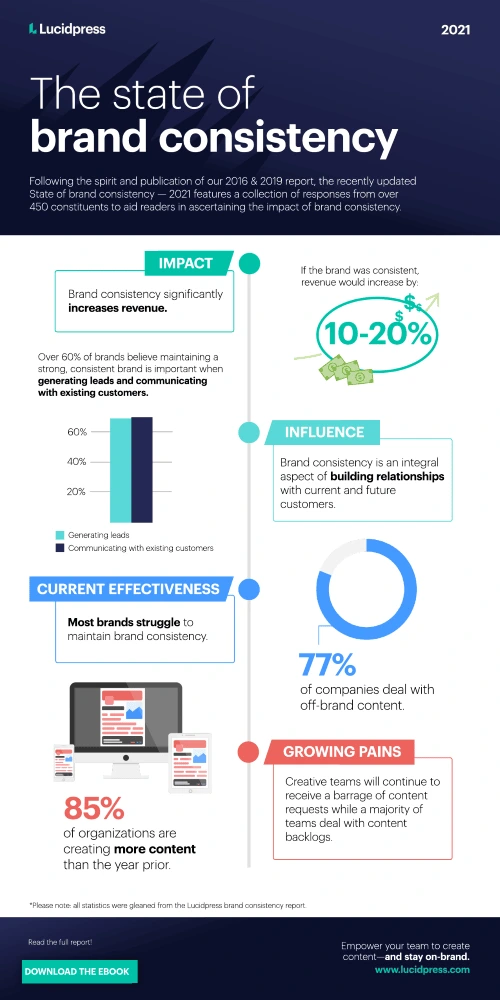
Branding is crucial to every business, but it’s so much more than a few colors, nice fonts and a fancy logo. It tells people that you care about what you deliver, that you live up to what you promise, and it shows off a glimmer of your personality — after all, it’s the make-up for your public image; an identity that people can relate to.
Managed well, branding can meet customers’ expectations and drive your authority through the roof. You’ll see a surge in new customers, leads, and conversions if you do one thing to your entire brand: make it consistent.
Here’s why brand consistency is important, and four ways you can put your business in the hall of fame for excellent brands.
What is brand consistency?
To be consistent is to be reliable — and when you’re reliable, you’re also recognizable and more likely to earn new customers or repeat ones because you’re front and center.
Brand consistency is the act of delivering the same brand messaging, voice and visual elements in every graphic, and piece of content. This ensures visibility and recognition within your target audience groups, so you stay top of mind, especially when they need you most.
Why is brand consistency important?
Think about one of the world’s largest sportswear brands. You see a check and instantly think of Nike, right?
You associate Nike and their logo because they’ve been consistent with it. After all, you’ve seen their signature tick on every piece of clothing they produce.
A brand is what people will remember most about your company, so it needs to be representative, strong, consistent and instantly memorable if you want to make a lasting impression.
You want to be their go-to company: customers should feel as though they could recommend you to friends and family, or call on you when they need additional products or services. Plus, your customers expect great design and consistent branding. For today’s customers, consistent branding and good design are key components when evaluating whether or not they do business with you.
Overall, constituents from our survey estimated that if their brand was consistently maintained, they would expect to have a 10-20% increase in overall growth, which in turn offers companies the additional revenue required to hire much-needed staff members or access to technology or software they otherwise might not have.
Ultimately, brand consistency has an extensive trickle-down effect that, when implemented correctly, can boost your bottom line, brand status, and employee morale. But unfortunately, inconsistent branding jeopardizes all that.
Impact of inconsistent brand usage
When you’re building a brand, the last thing you want to do is confuse the market. Those people could be your perfect customers: ones that drive your business’s bottom line and deliver great ROI on your branding efforts.
However, not using a consistent approach to your brand could limit your chances to generate leads or sales. That’s because people buy from brands they connect with, and brands which feel authentic. It’s hard to connect with a brand that doesn’t have a consistent appearance.
Advice from brand managers on maintaining brand consistency
How to maintain brand consistency
So, you’re looking to keep your branding consistent at every stage in your customer’s journey. But how do you do that, and which elements should you focus on?
1. Set branding guidelines for your company
Branding guidelines include details about your tone of voice, preferred professional terms and general code of conduct. Every business should have one, no matter their stage in the journey to perfect branding.
But once you’ve created them, don’t let them slip.
While 85% of organizations have brand guidelines, only30% are consistently enforced… hence why these companies aren’t seeing results. [![]() ] Not only does this mean time creating them is wasted, but staff might not understand your true brand, which will make it hard to stick to.
] Not only does this mean time creating them is wasted, but staff might not understand your true brand, which will make it hard to stick to.
Treat these guidelines like the core of your entire branding activity. It’s a central document that all members of staff should use when creating marketing materials or representing your company.
2. Give staff a branding masterclass
We can all relate to the feeling of sitting in an hour-long meeting which could’ve been a 15-minute email conversation. That’s the beauty of office life, right?
However, as soon as you’ve created your branding guidelines, you’ll need all members of staff to be onboard. You can do this by giving them a brand masterclass meeting, detailing everything they need to know about the business’ history, core values and tone of voice.
Once this masterclass is over, everyone will be on the same page. Store your brand guidelines centrally and remind staff to check back on this document if they’re unsure about how to represent your brand.
Say goodbye to a mismatch of marketing messages that confuse potential customers, and hello to consistent branding. Whether staff are speaking with a customer or crafting a blog post, each stage in a customer’s journey will be perfectly branded when staff understand what you’re trying to achieve.
3. Provide staff with branding resources
All staff have been given a branding masterclass and understand what your brand is about… but how can they maintain consistency if they need to create things for external use?
The answer: provide them with branding resources.
Think about the marketing material that your customers will see. Whether it’s social media graphics or whitepapers, branding resources can keep these consistent and avoid confusing potential customers.
In the same folder as your branding guidelines, provide staff with:
- Font names
- Logo variations
- Graphics
- Color palettes
You can also create branded templates to save time and keep a high level of consistency. Lucidpress offers a large assortment of free brochure templates, social media templates and more.
4. Think wider than your website
Did you know that the average revenue increase attributed to always presenting the brand consistently is 10-20%? You could see a huge uplift in revenue if you’re always referring back to brand guidelines—not just for your website.
Many businesses assume that a logo and a website are enough to put the cherry on the branding cake. They think a simple website theme is enough to give a great customer experience, but that couldn’t be further than the truth.
That’s because every stage in your customer experience should be branded in order to maintain consistency. So, think about the typical journey that your customer has. That might be:
- Found your site on social media
- Visited your website
- Subscribed to your email list
- Purchased from you
…But if your branding isn’t consistent across the first three platforms, a purchase is unlikely to happen. Remember how we said people buy from brands they feel connected with?
On social media, it’s easy to just rattle off a series of posts to make it look like you’ve been doing it for years. But remember: all communications need to be consistent. Consumers are savvy—if there’s an out-of-place tweet that doesn’t fit your brand, it’ll stand out like a sore thumb.
People will wonder what is going on if you don’t have a consistent voice. They won’t know the team behind your company (or trust them), leading to asked questions and cash spent elsewhere.
Key takeaway
Once you’ve implemented these five steps into your branding efforts, you’ll soon see a surge of results. From paying customers to feedback like, “I love everything about your brand!”, remember that consistency is key.
Stop changing your message repeatedly and losing your customers’ interest. You want them to remember your brand—not forget it.
For a real-life example of a company mastering their brand consistency, read about Club Pilates and their experience using brand templates here.
Want to know more about the power of brand consistency and the impact it has on your creative teams, brand reputation, and more? Download our 2021 state of brand consistency report and gain insight into helpful analytics and key takeaways to ensure your brand stays consistent and visible.
*Please note that while we provide insights and tangible takeaways, this survey and corresponding ebook are designed to shed light on the intricacies, theory, and data science behind brand consistency rather than provide hard-and-fast facts. Each company, and therefore branding, is bound to encounter unique obstacles relative to consistency.
Today’s sales cycle is complicated regardless of the product or industry. And as a result, it’s increasingly more challenging for sales reps to create engaging experiences on the behalf of the customer.
Fortunately, sales teams and organizations have sales acceleration tools and processes on hand to boost and simplify their sales cycles. And ultimately, these types of tools and processes are designed to help sales reps have better sales conversations and close deals faster.
In this article, we’ll take a comprehensive look at the definition of sales acceleration and the tools your sales team needs to close more deals and win the hearts of customers.
What is sales acceleration?
Sales acceleration is a function of sales enablement — sales acceleration utilizes data and other statistical insights to lay the groundwork for sales reps so they can navigate sales cycles and funnels more efficiently and effectively. In turn, this boosts and “accelerates” the productivity of your sales team, and of course, this accelerates the revenue of your company.
One of the most essential factors in sales acceleration is sales enablement. Rather than monitor the overall activity of sales, sales acceleration (as well as enablement) instead shifts focus to building and nurturing relationships with buyers.
Because when sales reps build relationships with customers, they’re able to identify patterns and preferences — and then translate this information into tangible data, so your customers can then be documented accordingly within your CRM, so you can deliver the best, most tailored experience.
To make your sales acceleration strategy feasible, your sales team needs integrated technology solutions that are versatile, comprehensive, and effective.
Sales acceleration technologies
To make sales acceleration effective, you need technology and software that will help sales reps close deals at a faster-than-average pace. These types of solutions ideally should provide detailed insights that both the sales and marketing team can leverage to create memorable content and customer interactions. Plus, you want the software solutions to connect the insights with customer indicators (e.g. search results, queries, or demo requests) and use this to seal the deal.
When push comes to shove and you need to select the best acceleration platform for the job, be sure to consider the following:
- Email service — One of the most invaluable tools you have at your disposal is email, and email is a crucial component of sales acceleration and automation. It’s important to know that a majority of automation software today will provide an automatic email sending service. The service itself will automate campaigns that are based on predetermined events that act as a trigger. From there, you can track all levels of engagement, and strategies can also be built and elaborated on based on the success of email campaigns.
- Research tools — While the value of quantitative data should never be underestimated, qualitative information (like research findings and supportive articles) also has its place in space. Having access to qualitative data will arm sales reps with everything they need to prepare for productive communications.
- Quote-to-cash solutions — Quote-to-cash solutions help sales reps efficiently create sales quotes based on a pre-determined pricing structure or guideline. Having a quote-to-cash solution helps reps overcome any sales-related hurdles by showing them potential customer savings early on in the sales process, removing the risk factor for slower-moving customers.
- Real-time alerts — In today’s world, arming your sales reps with real-time alerts is essential. Having something as simple as this helps alert your reps to customer events as they happen, so they can make the most of the work hours in their day.
- Lead databases — Most companies collect data in a CRM system, but nowadays you have to dig as deep as possible in order to drive future lead generation. Lead databases can help bolster your CRM system and convert more customers. Plus, this type of sales acceleration software will qualify prospective customers based on your reps’ actual, tried-and-true criteria. So once the potential customer has gone through the qualification process, the data is then double-checked and filtered so that only the highest qualified leads remain.
- Content creation — No matter who your prospect is, you want your content to look and feel as though it’s custom-made to fit their wants and needs. So you’ll need a program or tech that provides customization (without going off-brand). Because whether the content is as simple as an infographic or long and detailed like an ebook, your reps need it to reflect the customer accurately.
What is the best sales acceleration solution for B2B & B2C industries?
Keep in mind, (with sales acceleration tactics) the faster your sales reps can establish a connection and build a relationship with a prospect, the quicker the sales journey will be, which can also increase the chances of a repeat customer.
At a granular level, what’s best for your business likely changes on a daily basis. However, from a high-level overview, it’s easy to see the overlap and recognize that, well, content is king as it helps bridge the gap between communication styles and preferences no matter if you’re B2B or B2C. Content helps you build trust and reinforce your authority.
So, when it comes to choosing the best solution that will absolutely work for both business to business and business to customer sales acceleration, you should always be looking toward content-based solutions.
The best sales acceleration software
Now we are going to look at some of the best solutions when it comes to sales acceleration software. On this list, you will find everything from CRM systems to sales enablement tools. While alone these tools are great, in the hands of an amazing sales and marketing team, the possible increase in sales figures is unimaginable.
Lead Connect is a great piece of software as far as sales acceleration tools go. Lead Connect is a tool that unifies your LinkedIn workflow, and it allows you to produce leads from LinkedIn by automatically searching through the catalog of profiles. Using Lead Connect has been shown to increase productivity with sales reps as it generates warm prospects with ease.
With over 7 million users, Lucidpress is a brand templating platform that empowers teams or individuals to easily create professional marketing content and sales enablement collateral. If you are looking for a solution to develop templates and customizable content (both for digital distribution or print), Lucidpress could be the right solution for you. While the concept is simple, the solution is beautiful — Lucidpress helps reduce pressure and work requests from your creative team and really gives your content a new lease of life.
Looking at an email tracking tool that helps sales reps nurture leads? Check out ToutApp. ToutApp provides users with real-time insight and data regarding the engagement of all email campaigns. ToutApp lets you know whether the email has been opened, deleted, clicked, or even marked as spam. This handy piece of software offers analysis on client calls, calendar events, and your CRM data — and can then be converted into raw data.
Groove helps you analyze all of your Salesforce data in one location. The great thing about Groove is compact and can be easily integrated with Gmail. So you don’t need to go anywhere but your inbox to access important information.
LeadSquared takes your lead creation efforts and ensures that they won’t go to waste. The tech utilizes automation, customer relationship management (CRM) integration, and AI prediction data to help your reps make the most of the leads you’ve got. The LeadSquared software has a large suite of features, including lead tracking, nurturing, and lead management. So, if you’re looking to convert leads to sales quickly, look to LeadSquared to help you get on your way.
Xant Playbooks is an AI-application that assists sales reps by increasing their efficiency through predictive analytics. The technology uses pattern analysis and walks sales reps through a pre-set group of custom strategies. From there, reps are able to gain insights that assist them in closing — the important sales cues of who, what, when, where, and why, allowing reps to engage customers more effectively and efficiently.
When it comes to B2B selling, not all of the companies out there will fit your ideal customer profile — which is where DataFox comes into play. DataFox finds the best customer matches for your reps by leveraging artificial intelligence and advanced machine learning. DataFox searches a smattering of data sources to identify prospects that are most likely to respond to a sales rep’s outreach.
Sales acceleration: the wrap-up
Well, that was an ear-full, to say the least. But if there’s one thing takeaway you should glean, it’s that the right tools can make all the difference in ensuring the success of a sales acceleration strategy. So whether you need a brand templating platform to equalize the workload between teams (not to mention give your sales team the enablement collateral they need), or you’re in need of an AI solution to help you analyze leads, let our guide lead the way.
The digital customer experience is the quality and sum of all digital interactions a consumer encounters with a company. This includes the company’s brand, products and services.
Unfortunately, some companies are still struggling to achieve a productive digital experience. Good digital experiences can lead to more sales, more loyalty and even more customers. On the other hand, poor digital customer experiences can cause a loss of sales by frustrating customers and ultimately driving them to competitors.
With a good plan of action centered around digital customer experience and the aid of digital experience management, businesses will be better equipped to achieve growth.
What is digital experience management?
Digital experience management is the software, product or service that helps you track, monitor and analyze your customers’ experiences.
Digital experience management helps you connect the dots between the digital experience and customer expectations, and in turn provide customers with the experience and content they need.
Digital experience management platforms
The more insight you can gain from your audience, the more informed and strategic your content and digital experience can be.
So, in order to create an effective online customer experience management strategy (and therefore nurture a memorable digital customer experience), there are a few digital management platforms worth leveraging:
- Liferay DXP
- IBM Experience Manager
- Adobe Experience Manager
- Core DNA
- Lucidpress
Why digital experience management matters
Brands are struggling to differentiate themselves in today’s crowded marketplace. Consumers encounter multiple brands across multiple countries all offering the same goods or services.
Because of this, you need to give consumers a good reason to choose you over all the other players. In fact, many experts believe that successful customer experience will become more important than product quality or price when differentiating one brand from another. Keeping this expert prediction in mind, it’s clear that digital experience management matters more than ever.
Elements of a great digital customer experience
When crafting a digital experience, include the following elements in your strategy.
Consistency
When your customers open up your website, Instagram, Facebook or Twitter page, they expect to see consistency. The same message, layout, logo, etc. Customers expect this consistency no matter the location, device or channel they are using. This consistency is especially important if you are delivering rich media. Today, brands have defined “best practices” across all channels to ensure consistency in the online customer experience. These best practices can include responsive design and well-known concepts among others.
Usability and accessibility
According to Forrester, 61% of U.S. online adults state that they are less likely to return to a website if it doesn’t provide a satisfactory experience. Based on this alone, the digital experience you want to create can be your greatest competitive differentiator. Improving the usability and accessibility of your channels can maximize functionality while also positively affecting lifetime customer value. And don’t forget that no matter how sleek and shiny your design looks, if customers are stumbling along the way your pretty design won’t help provide a good user experience.
Convenience
In the digital world, consumers prefer to find their own answers rather than call someone for support — a large majority of people now expect companies to offer self-service options. Because of this, a great digital customer experience gives consumers the option to interact with your brand with little human interaction. Overall, the brands that rate the highest in terms of customer satisfaction do so because they offer self-service options along with a seamless experience when moving across channels.
With customers using mobile apps and smartphones to make payments, purchase products, schedule appointments, access information, book travel and more, self-service is more important now than ever. Consider restaurant apps like Chick-fil-A or Starbucks, customers can place an order ahead of time and also manage their loyalty points all through the app. Nearly 16% of Starbucks purchases are made through the app alone.
Personalization
Studies have shown that having a large number of options can make it harder for customers to make a decision. Accenture collected data that indicated an increase in frustration from customers’ online experiences. Their data showed that 48% of consumers have left a website only to purchase a similar product elsewhere simply due to a poor digital customer experience. Alternatively, 91% of consumers were more likely to shop with a brand that remembered, recognized and provided them with relevant recommendations and offers.
Your business can harness machine learning to better gain insights into consumers’ needs and wants in real-time. The growth of artificial intelligence (AI) in recent years has provided us with exceptional technology to better help us create digital experiences that focus on individual customers. This alone can help differentiate your brand from your competitors by providing accurate insights into your customers in order to give them a personalized and meaningful interaction. In addition to this, machine learning and big data can help ensure that your message reaches the right customer on the right channel and in the right format. It can also help you utilize insights and recommendations on consumer behavior and industry trends.
Deliverability
Another element of great online digital experiences is deliverability, better understood as the amount of effort a user experiences when navigating through your channels. The ultimate goal of deliverability is for you to empower your customers to accomplish their goals and feel good about it. Every turning point in their customer journey should be designed to deliver exceptional digital experiences centered around your brand’s promise. One survey provided statistics showing that only 11% of customers who experienced a complex transaction were likely to continue with purchasing the product. On the other hand, 68% were more likely to purchase when experiencing a low-effort transaction.
Related: 9 ways to improve the customer experience
Steps to develop a digital experience program
Along with the elements above, follow these steps to develop digital transformation through an excellent digital experience program.
Objectives then solutions
As you develop a digital experience program, begin by focusing on your business objectives first, then worry about solutions. Common objectives for many companies include:
- Deliver a better digital experience
- Understand the customer experience
- Differentiate on the customer experience
- Listen to your customers
As you look more into differentiating the customer experience, you may want to consider accessing outside help from customer experience consultants.
Omnichannel
An omnichannel approach to your program can help you succeed in providing a consistent and cohesive experience for customers across all channels. Make sure that you design your program in line with all other channels that your brand utilizes, from brick-and-mortar shops to mobile apps. By delivering a consistent omnichannel user experience you can improve your reputation and build trust among consumers.
Customer Journey
Mapping the customer journey is paramount when developing a digital experience program. In order to do this effectively, you will need to identify key turning points between the consumer and your brand that ultimately shape brand loyalty and perception.
Use the customer’s journey to localize where customers are getting stuck or where they are enjoying the experience. And don’t just do this at the end of the journey or when you’re starting to see your revenue tank. You should be mapping the customer journey often and always. Just as ecommerce continues to evolve, your own brand will need to evolve to better meet customers’ needs and wants.
Diagnose
As you map your customers’ journeys, take the time to also track and diagnose problems, existing and potential. You need to find which journeys are common and diagnose the most common problems within them. Additionally, you will need to find what resonates with your customers. Through diagnosis, you will want to capture high-level metrics such as the goal of your website or app visitors, along with the likelihood of them returning to your site.
Webinars don’t have to be a slide presentation snoozefest. In fact, they’re a great option for creating cost-effective content and harnessing the sales leads of your dreams. Hosting a webinar is fairly simple… it’s getting people to come that you’ll have to spend more time on.
We’ll tell you how to host a webinar and rustle up attendees — and we’ll give you tips for creating an engaging experience that’s good for business and fun for your guests.
Benefits of hosting webinars
As long as you’ve got a dynamic speaker and an interesting topic, there are few drawbacks to hosting a webinar.
You have access to a bigger audience
- Theoretically, you could ask people from all around the globe to attend! A webinar is a great opportunity to expand your audience — there are no travel constraints, and concerns about cost and time are almost nil. The low-commitment aspect of a webinar will draw people in like flies to honey.
It’s waaay cheaper than hosting an event IRL
- Without the cost of renting a space, putting up your guest speakers and coordinating a large event, you can instead put funds toward advertising your webinar and getting a healthy list of attendees.
You’ll generate high-quality leads
- Your attendees are basically a bundle of qualified leads. The people who come to your webinar are already at least somewhat interested in your area of expertise, and you’ll capture all their info when they register for the event. Bam! A nice, tidy list of leads to pass along to the sales team.
You can reuse the content
- Once you’ve got a solid webinar under your belt, you can repurpose it in all sorts of ways. Chop it up into choice tidbits and use the video clips in a blog, LinkedIn ads, your next email campaign… anywhere you need an extra boost of expert content.
10 tips for creating and hosting a successful webinar
Here are our top ten tips on how to host a webinar — including the little touches that will keep things on the right track.
1. Choose a platform
You’ll ideally want to pick a webinar platform that you feel comfortable navigating. There are a lot of options out there and they all offer similar features: poll and chat functions, data on attendee engagement and the ability to record. It will probably come down to price and the user interface you like best to help you decide. We like Demio, GoToWebinar and the ubiquitous Zoom.
2. Set the date
Pick a day and time that will work the best for the most people. Make sure you choose a time that’s doable for both the East and West Coast. Something like Friday at 3:00 p.m. EST would work well since that happens at noon or a little later for the rest of the country.
3. Get the word out
Drumming up a good number of attendees is where you’ll put in a lot of work. You need to effectively market your webinar and get people interested. First things first, you’ll want a landing page for the event with information about the topic and speakers, as well as your registration form.
Put together an email drip campaign to send out to prospects and start promoting the event on your social media channels. You’ll want to start marketing at least three weeks before your webinar, but a couple months in advance is ideal.
4. Polish your presentation
You’ll want to spend extra time making sure the visuals for your webinar presentation are on point. Without live, face-to-face interaction, you won’t be able to read the room and get a feel for how your audience is responding. Your best bet is putting together a presentation that you know will keep your guests focused and interested.
The easiest way to put together an eye-catching presentation is to find a perfect webinar template that’s polished and represents your brand well. We’ve got loads of customizable presentation templates that you can tailor with your brand’s logo, colors, fonts, etc.
5. Keep your audience engaged
You don’t want your presenter to just drone on endlessly. Break up the webinar with polls and interactive Q&A sessions. Most webinar platforms come with built-in tools for polls, questions and chat, so your audience can engage with the content or “raise a hand” and ask a question.
You can also create a hashtag for your event so people can discuss their insights during and after the webinar on platforms like Twitter and LinkedIn.
6. Do a dress rehearsal
With big events, you don’t want to be flying by the seat of your pants. Run through the webinar a couple days beforehand so you have enough time to fix any issues that pop up. Make sure your video platform is running smoothly, check that a test attendee can see and hear you clearly, confirm that any transitions between slides or speakers go as planned, and so on.
7. Record it
Make sure you record your webinar! This is what you’ll repurpose into future content. You can go in after the live recording and edit out any glitches or remarks that won’t be needed for a rebroadcast. You can also send out the recording to all the participants, so they can refer back to it in the future.
8. Use a mic
Get a wired headset mic for each one of your presenters. Yes, they look geeky, but it will ensure that everyone can hear clearly. Poor quality audio makes it hard to concentrate and is just plain annoying.
(And please, for the love, make sure all presenters mute their computer notifications while they’re on so listeners aren’t assailed with pings and dings throughout the event.)
9. Have someone there for tech support
The last thing you want to be doing while hosting a webinar is worrying about tech issues. Have a designated tech person on hand who’s ready to handle any problems.
10. Send out a survey after
Send a survey to participants shortly after the event and solicit their feedback. Getting input from your attendees will help you know what went well and where you can improve for your next go-round.
With the right preparation, webinars can be a breeze to plan and a boon for your business.
For help with creating a beautiful, on-brand webinar, don’t miss our free webinar templates.
In the healthcare industry, direct and immediate communication between patients and hospital staff is essential. The health of patients can depend on a clear and concise exchange of information. Too many of us may have personal instances where navigating the healthcare system was frustrating because of a lack of communication or a bad patient experience. Thankfully, we’ve seen a recent shift in the industry to a more patient-friendly approach with the emergence of online reviews, surveys that measure patient satisfaction and in-house training for better communication in hospitals.
But there are still major failures in communication between patients and healthcare personnel, along with failures among healthcare teams, that can lead to medical errors and patient harm.
Overall impact of communication failures
Current research has shown that failures in communication among healthcare professionals are one of the leading causes of patient harm and medical errors. In fact, 80% of medical errors involved informational or personal miscommunication. Additionally, 70% of sentinel events include communication breakdowns as one of the root causes of preventable patient injury. As more research has been conducted, it’s shown that ineffective or insufficient communication among healthcare team members is one of the biggest contributing factors to adverse events.
In order to improve patient safety and outcomes, healthcare organizations need to start improving communication in hospitals between professionals and patients, but especially among their own medical teams.
Ways to improve hospital communication
1. Encourage mobile collaboration
Most healthcare facilities still rely heavily on pagers as a means of communication. They are an effective way to get in contact with someone if you need to speak with them immediately, but they aren’t great for a two-way conversation that could include a litany of technical information. Many professionals also find it difficult to respond to emails as they hurry from patient to patient. A great solution is to use a mobile team communication app. Many healthcare organizations provide mobile devices to their staff as a way of bridging this gap between the restrictiveness of a pager and time-consuming email.
Over 80% of American adults own and use a smartphone, making it a convenient and effective form of communication between healthcare professionals and patients along with communication between healthcare professionals themselves.
2. Implement team huddles
A team huddle is a quick meeting between a healthcare team at the start of the day or shift with a specific focus on distributing pertinent patient information from the previous team. These mini-meetings include operational and care personnel ensuring that all healthcare providers are on the same page for a patient, ward, or department. Recent research has shown that daily team huddles have resulted in fewer interruptions during the day/shift and provide immediate clarification of issues. These meetings have also been shown to help teams identify pertinent issues of the day, giving teams a chance to prioritize and assess changes in clinical workload. Plus, they enhance staff cohesion and teamwork.
To ensure effective team huddles, follow these guidelines:
- Use a consistent location
- Set a standard time each day
- Make huddles mandatory
- Don’t sit, stand up
- Keep it short (15-20 minutes)
- Begin and end on time
- Keep the agenda limited
3. Provide communication training
According to Anthony Orsini, DO, president and founder of The Orsini Way and practicing neonatologist, communication training can achieve cultural change at hospitals by rewiring the way professionals communicate. Organizations that have used Dr. Orsini’s communication training have seen significant improvements in HCAHPS scores along with improved patient satisfaction.
Consider looking into a communication training program for your department or entire hospital staff. Pick one that includes specific training in communication techniques along with verbal and nonverbal language skills.
4. Facilitate cross-department collaboration
One barrier to effective communication especially during handoffs is the misunderstanding between professionals from different departments. Two healthcare professionals in the same field can communicate quite easily due to sharing the same jargon, experience and training. But specialists in different fields can easily miscommunicate especially in situations like operating rooms where several different types of caregivers are involved — surgeons, nurses, anesthesiologists, etc.
Cross-training and collaboration can be accomplished by having a nurse from one unit take a shift on another unit. Another way to accomplish this is to have departments learn about each other through meetings and having conversations outside of handoffs.
5. Templatize communication collateral
A final way to improve hospital communication is to templatize provider letterhead along with flyers for research studies and announcement displays. Using templates for in-house communications along with communications within the community can make it easy for doctors, nurses and other house staff to create on-brand content quickly, allowing them to maintain communication with patients and the community. With a platform like Lucidpress, healthcare organizations can provide their personnel with professional templates while also giving them autonomy to create their own content under approved parameters.
Implementing these five steps can help you improve overall hospital communication among your medical teams and between healthcare professionals and patients. Read our article about how to improve the patient experience to learn more.
Editor’s note: This post was updated July 24, 2020.
If you’ve landed on this blog post, I don’t need to tell you that striking visuals are critical for marketing your SMB. But just in case you need some convincing, consider that blogging and social media are now the most commonly used formats for content marketing.
It’s well established that blog articles and social media posts perform far better when paired with visuals, but content marketers suffer from small budgets and big expectations.
Is social media worth it?
No matter how you look at it, maintaining a positive presence on social media is an uphill battle, especially for small businesses who don’t have the resources to devote one or more full-time employees just to social media.
So, what’s the secret? Success comes from a combination of factors, including the quality of the content and graphic design itself, the underlying marketing strategies (think: giveaways and crowdsourcing), the product and timing.
When these factors do work together, social media can change the very fabric of a company’s marketing strategy. For instance, t-shirt maker Sevenly donates to charity for every shirt sold. The company teams up with multiple charities and causes and designs a unique t-shirt to match.
Their posts on social media tend to be well-shared, since individuals who can’t afford to donate can help the cause by simply sharing the post:
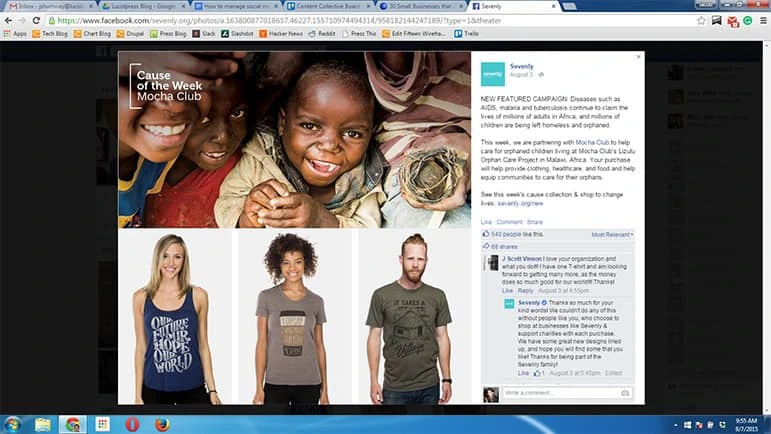
The point is that social media content will only be as effective as your business model and marketing strategy empower it to be. Once you have that strategy in place, supporting and implementing it on social media is actually the easy (and fun) part.
5 graphic design tips to get your started
1. Have a goal
Every social media account should have an overall goal, and every post should have an individual goal. Think of the account’s goal as an overall theme your followers can expect you to follow. For example, will your Instagram feed be used to showcase graphics of your latest products or to share informational content related to your brand? Or are you creating a community for your customers to interact with your brand and with each other? Define this theme along with your target audience. Each individual post should contribute to this overall theme and drive measurable metrics for your brand: engagement, clicks and purchases.
2. Be creative
Whether you’re an experienced designer or not, everyone can be creative when creating social media graphics. Incorporating storytelling techniques is a great way to do this. Think about who the main character is, what the problem or challenge is that they are facing and how they are solving it. Then tell that story visually.

Source: Pinterest
3. Remember design best practices
Social media graphic design follows a set of best practices that will make your designs pop. When selecting color, be sure the colors you choose contrast enough, so the content is easy to read. Experimenting with fonts is a great way to add some playfulness to the post’s design, but be sure it is still legible. Balance out fun fonts with a second, simple font. Overall, keep the design simple so your audience will understand the message you’re trying to get across.
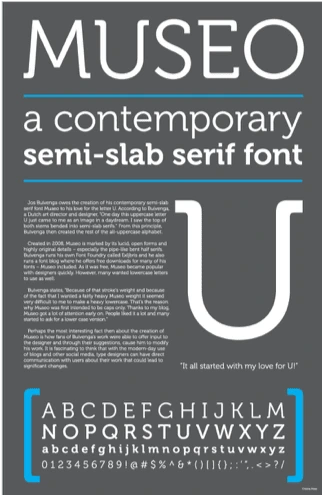
This informational poster is a great example of font utilization.
4. Be consistent
Social media is a great way to build your brand, but only if the social media designs you create are consistent with that brand. Be sure to incorporate your brand’s colors and fonts into your social media designs and avoid any content -visual or otherwise- that doesn’t accurately reflect your brand. Learn more about social media branding.
5. Use the right tools
With the right tools, even non-designers can create stunning social media graphics. Here’s how you can create awesome graphic designs for your social media sites in just minutes.
Step 1: Pick a template
After logging in to Lucidpress, click the drop-down arrow next to +Document to view our free templates. Click Social media, then pick the template that corresponds with the social media site you’ll be posting to (this ensures that the image has the correct dimensions).
Alternatively, you can save time by creating a single document, then linking back to it in each of your posts.
I’ll be building my content from this Facebook post template:
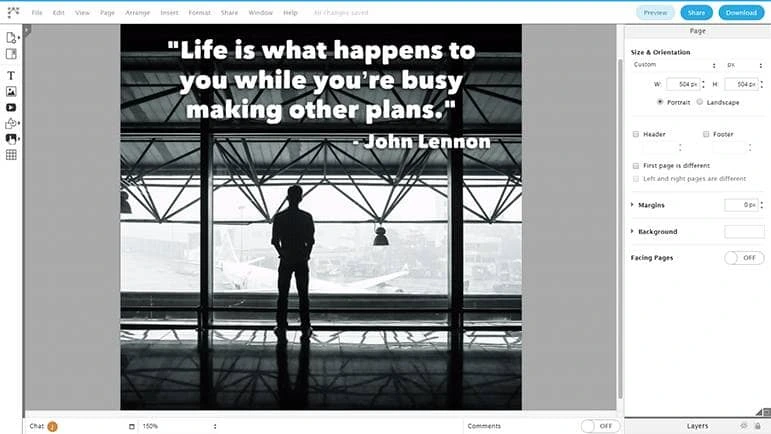
Step 2: Customize
In this step, switch out the template’s content with your own. Then, adjust effects, fonts & positioning to get the perfect layout.
Since I want to emphasize my product’s creative capacities, I’m going to make a meme about the power of imagination.
First, I double-click to replace the text with my own. I test out several fonts before selecting Hill House. Next, I delete the background photo. After dragging and dropping an image I found on Pixabay onto the canvas, I right-click it and select Send to back so it doesn’t cover my text.
Finally, I add a text box on the bottom right to include our brand. Now it’s ready:

Step 3: Publish & share
Before you can share your document on social media, you’ll need to publish it with a unique URL. Click Share in the top-right corner, then click Publish under the On the web tab. Finally, go to the On social media tab to share your brand-new content on Facebook, Twitter, Google+ or LinkedIn.
Type a short, custom description for each post you make. If you’re not sure how to adapt your post’s text for each site, consult this now-famous comparison of social media sites:
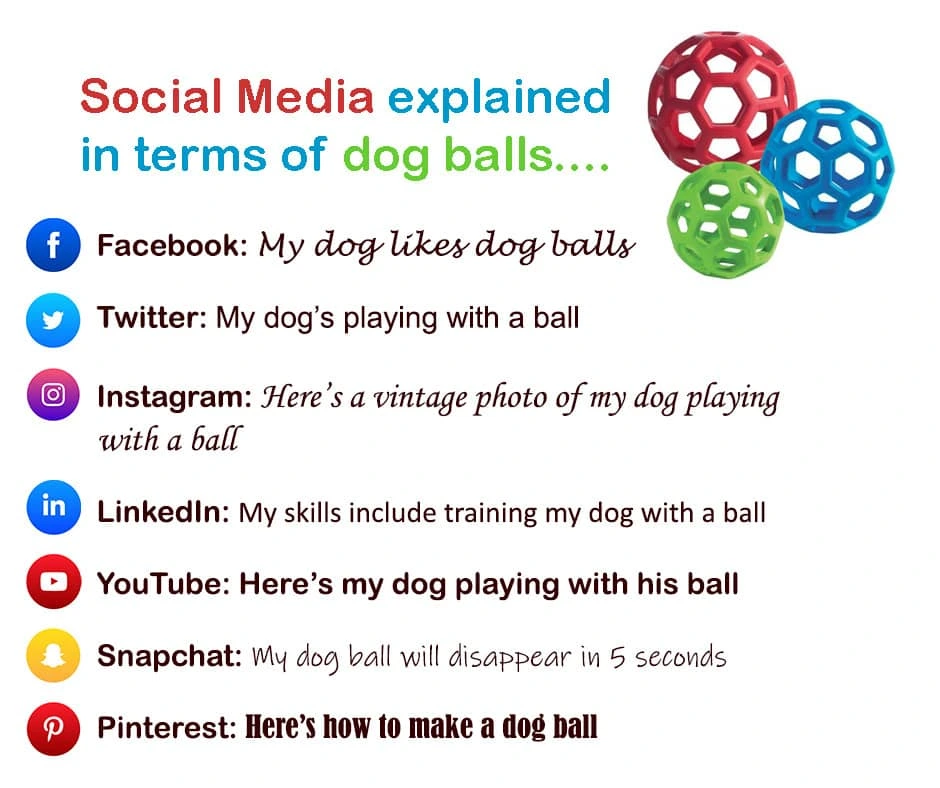
And that’s it! You’ll be creating and sharing social media posts like a pro—without spending hours in complicated design software.
Ready to make your own social media posts? These free templates are a great starting point.
When you think about Coca-Cola, what pops into your head — is it the taste? The fizziness? The dark caramel color? Maybe you think of a classic ad. If you’re like me, it’s the vivid red-and-white logo adorning the label.
Related: Is your brand outdated? When to do a brand refresh
When you think of all of these things, you’re thinking of Coca-Cola’s brand as a whole. If lots of different Coke-related images popped into your head just now, then Coca-Cola’s marketing team has done its job.

Too many people think branding begins with choosing a name and ends with picking a logo — but it’s much more than that. It affects everything.
So, when a company wants to rebrand, it’s not about just changing the logo. It’s also about changing goals, messaging, tone, voice, style and anything else that contributes to your image. It can be a tricky thing to get right, because ultimately, you can’t control what people think. But a well thought-out and defined brand is the backbone of many successful companies.
If there’s so much to it, why would anyone dream of rebranding? When is rebranding the best option?
Well, you could have gotten it wrong the first time. Many businesses overlook branding when they’re starting out and later find they need to rethink it. For some, they need to appeal to a broader audience. Others need to change tack when they decide to expand into other markets.
Long-established companies aren’t immune to the need to rebrand, either. It might be necessary after an acquisition or merger. Changing industries, attitudes and new competitors can also ignite the need for a fresh image. When a company needs to reposition or rejuvenate itself, rebranding makes sense.
Deeper issues, like an antiquated image or a negative reputation, can spur a rebrand. Sometimes, it can even come down to involvement in a damaging public scandal.
When you face challenges like these, you have two options. You can cling to the old branding that you had, or you can put together a rebranding strategy and work towards a new image.
Whatever the reason, make sure you have a strong case for the rebrand. Though there’s a lot to it, rebranding is part of the life cycle for many growing companies. Very few of us wear the same clothes now as we did in high school — so why wouldn’t a brand evolve as well?
Reasons to do a rebrand:
- You need to completely reposition your brand
- You merged with another company
- You significantly changed your product offerings
- You have a negative reputation
Reasons to do a brand refresh instead:
- You want to attract a new audience
- Your messaging is inconsistent
- Your company has evolved
- You don’t stand out from competitors
Considering the points above, it may be that you don’t need to go through an entire rebrand: Your current brand may just need some polish, also known as a brand refresh. A refresh is a much lighter version of a rebrand, and though they both entail a lot of the same work, a refresh simply updates your current brand instead of making the sweeping changes that a rebrand does.
If you’re still not sure if rebranding is right for your company, check out our rebranding questionnaire.
Rebranding strategy
Rebranding a company doesn’t happen overnight. You need a solid rebranding strategy, testing and approval, and then you need to roll it out internally before your big debut with your customers.
Here’s our advice on the five steps to follow to get rebranding strategies right.
1. Research before you rebrand
Before making any changes, you’ve got to do research to find out how your brand can improve. What do people like about your brand? How can it connect with modern consumers? There are endless questions to ask when building a new identity. The more knowledge you have, the more effective your rebranding strategy will be.
During this process, find out what attracted customers to your brand initially … or why they went to a competitor instead. Figure out the problems you need to address with the rebrand.
Coca-Cola once decided to rebrand, but its New Coke campaign flopped. Coca-Cola didn’t have any issues with its product’s taste or image, but it decided to change both. The result wasn’t an energized image but confused loyal customers. So, make sure to do your research.
Burberry’s rebranding strategy is a great example of how to strike this balance. After a century-and-a-half of success, Burberry’s image started to suffer when — through no efforts of its own — the brand became associated with gang wear and fashion for older generations. Thanks to this double punch, clubs in the U.K. wouldn’t allow entry to anyone wearing the brand’s iconic plaid.

Faced with this unsavory situation, Burberry decided to rebrand, but it did its research first. The company hired an anthropologist to rediscover its roots so that Burberry could highlight its heritage in a way that would appeal to younger audiences (while also disassociating its name from gang wear).
2. Set out clear goals
From your research, you’ll know what’s wrong, and this should help you figure out what you want to achieve. Burberry needed to disassociate its brand from gangs and build a modern youthful image.
Knowing it needed to appeal to younger audiences, the label added more modern styles to its line and recruited well-known celebrities like Emma Watson to promote them. This led to a boost in sales and an image readjustment for the brand, which once again became a luxury name.
There’s no point rebranding a business if all you change is the name. When it became The Shack, RadioShack did exactly this. The business wanted to stem the flow of losses, but a name change just didn’t cut it. Maybe if it had gotten to the root of the problem and set out more strategic goals, the brand wouldn’t continue to close its doors.
With thorough research and clear goals, your rebranding strategy will be well-informed and should make an impact.
3. Get all company stakeholders on-board
To get customers on-board with a rebrand, you’ll need to get all stakeholders involved first. Your employees are the main touchpoint between your brand and the outside world, so they need to understand the importance of your new brand. You want to make sure what they say and do is in keeping with your new image.
The CEO who led Burberry’s turnaround, Angela Ahrendts, knew there was a problem when she saw that none of the company’s managers wore the brand. How can expect your customers to love your brand when your own staff doesn’t?
If your rebranding strategy aims to address a bad rep for customer care, you’ll have to invest in training and resources to deliver better customer experiences. In situations like these, it can be a good idea to rebrand internally first.
When setting out a rebranding strategy for a client in the financial sector, consultants Spyglass Creative decided to do just this. To convince the board of management of the importance of stellar customer service, waiters with silver platters served lunch to the members and introduced the idea of “sterling service.” With a clear view of the vision for the rebrand, they supported the new approach.
4. Have a process planned out
Once you’ve got stakeholders on your side and know exactly what needs to be achieved, you can put together a plan of action. In the case of Burberry, the company was active on many fronts. It introduced new designs and bought back licenses for its classic plaid pattern, so it could protect the brand’s image and make it exclusive once again. The company also created a brand story, which it told through videos and in-store displays.
Your rebranding strategy might require you to take up social media. Or, it could impact the networks you already advertise on.
Prior to 2010, Old Spice was seen as a retro brand for older men. While its reputation was sound, it simply didn’t appeal to younger audiences. It decided to change this.
The brand set up a YouTube channel and posted dozens of fun, humorous videos featuring actor and former athlete Isaiah Mustafa.
The rebrand was a massive success, opening up the traditional product to a new demographic by making the most of new trends. Old Spice did its research, rebranded for sensible reasons and set out clear goals.
5. Build trust for your new brand
Once you’ve rebranded, don’t slip backwards. Familiarize your audience with your new brand personality by staying consistent and building trust around it.
If you have a new name or logo, don’t leave a trace of the old one around. Create new brand guidelines and make it easy for staff to implement them. A brand templating platform like Lucidpress can help by making brand assets easily accessible during the content creation process. When any files are updated, everyone will automatically have access to them, too.
Use your new brand in all your communications to build awareness of it. Use a link shortener like Rebrandly to create branded links for your emails and social media posts. This will build brand visibility and trust. Content marketing and native advertising can also build familiarity and trust in your new image. Be consistent with your new tone, and don’t flip-flop between your old brand and the new one.
Branding is an important company asset, and it can leave a lasting image in consumers’ minds. Make sure your rebranding strategy sticks, because it can rejuvenate a business and even turn it around when the chips are down.
How to rebrand a company
Follow these steps and plan how to successfully rebrand your business.
1. Define your audience
If your audience is 70-year-old retirees, you probably don’t want to alienate them with something that feels so modern it’s out of their reach. The same goes for a millennial audience. If you’re rebranding, it might be because you’re redefining your niche and ideal customer. Make sure your branding speaks as much to that ideal audience as your sales copy does.
2. Stay true to your mission
A rebrand should be a makeover, not a botched surgery. Before you begin, go over your mission and value statements. Come up with an idea of where you are now and where you want to go — without losing sight of who you are and what your customers have come to love. Project your mission and personality in your new branding so you feel like a refreshed company, not an unrecognizable one. If you’re having trouble finding your brand’s voice, try this tool.
3. Rethink your name
Name is the first and most recognizable brand element. Rebranding doesn’t always involve a name change, but it can be a powerful strategy — especially if the company is looking for a fresh start. Did you know that the infamous Philip Morris company changed its name to Altria to disassociate itself from bad press and controversy? Considering how a number of journalists reported on the obvious change, it’s hard to say whether it was successful, but only time will tell.
One more thing to consider is the possibility of alienating or losing older clients with a name change. A fresh start is a double-edged sword, so make sure you’re ready to give up your established legacy in favor of a new brand identity.
4. Revamp your tagline
Slogans and taglines often go hand-in-hand with a brand’s name. Usually, a tagline is a catchy sentence that summarizes your business and is easy to remember. If you decide to change your name, you should do the same with your tagline — especially if the business has changed. Over the years, FedEx has had several long and unmemorable taglines, so it changed to “Relax, It’s FedEx” in 2004 and “The World on Time” in 2009, both of which are simple and effective.
Rebuild your brand identity
Your brand identity is how you present your company to the world. It’s everything that customers recognize your brand for, from visual style to voice and personality. Be sure to include these key elements of brand identity in your rebranding strategy.
Logo
Since people are visual thinkers, updating your logo is the easiest way to demonstrate change to your audience. As for the logo design, you have to follow (and subvert) trends if you want to appear fresh. But, be careful with it. You don’t want to drift too far away from the original logo unless you’re trying to conceal your past. You want people to acknowledge the change but also recognize the company’s continuity.
Color palette
Color psychology is real — and different colors make people feel different things, so consider how you want your brand to make people feel. Blue is a calming color, pink is soft and romantic, black is bold and sophisticated, etc.
It’s best to go for a simple color palette with no more than 3 primary colors. You can also choose secondary colors to create your brand palette. You’ll be experimenting with tint, shade and saturation to get the look and feel of your brand just right.
Typography
Typography is truly an art, and choosing the right fonts for your brand can help you stand out and be easily recognizable. Just like colors, font styles can make people feel a certain way. You want to find a pair of complementary fonts that reflect your brand’s personality, whether that’s modern and youthful, bold and innovative, or however else you’d describe your brand. You’ll need to consider things like font size, kerning and line height, readability and licensing requirements.
Shapes and imagery
Along with colors and fonts, your other visual assets communicate who you are to your customers. Again, think about what visuals will communicate your brand’s identity, personality and feeling. Is your brand angular, rounded, flat, soft, natural, futuristic? Are you using animations, photographs, GIFs, videos? All design elements come into play here and there’s a lot to explore.
Brand guidelines
Once you have your new brand identity outlined, the best thing you can do for your rebranding efforts is create a clear and easy-to-access set of brand guidelines. This will ensure that your team can reference the new guidelines and keep your rebrand looking consistent. Without full compliance from your internal teams, it can be hard to have a successful rebrand.
Tips and tricks for a successful rebrand launch
1. Know your limit — err, budget
Creating content, running tests and paying for ads all costs money. Around 10-20% of your annual marketing budget can be spent just on rebranding efforts. Developing a well-designed content calendar will help identify where most of your money will be spent and give you an idea of when you’ll need to be prepared for these expenses.
2. Testing: 1, 2, 3
Taking the time to run tests on your content will help to solidify your marketing strategy. It’s not always a guarantee that a rebranding effort is going to be successful. The best way to prevent a failed rebranding is to test your assets before releasing them to the public. Study groups and A/B testing can uncover and strengthen any weak points in your rebranding strategy.
3. Demand consistency
Branding should be synonymous with “consistent messaging.” When you rebrand, you need to go back through every webpage, design element and evergreen brochure to update it with your fresh look, tone and feel. Don’t dilute your new branding by confusing it with the old. Get everything polished in one fell swoop. Brand consistency was important before the rebrand, and it’s even more important now. Consistency establishes company-client trust, which leads to higher revenues.
A platform like Lucidpress can be a huge help in your rebranding and consistency efforts. It gives a central place to put all your brand assets and files, providing easy access for anyone who needs them. You can put all your new colors and logos in the brand assets hub, so when people are creating content, there’s no chance of them using an old logo or font, etc.
You can create a template library with all of your rebranded and updated materials, so spanking-new content is right at everyone’s fingertips. Plus, when you decide to refresh your brand again down the road, all the content will be in one easy-to-update location. A centralized platform for branded content creation will make it easier to roll out your rebrand to internal teams, so can ensure that everyone’s up to speed before your public debut.
Is it time to rebrand your business or organization? Learn more in our free ebook: How and why to rebrand your company
So you finally made the decision to turn that brilliant idea into a legitimate business—congratulations! You’ve probably got a whole to-do list in your mind right now, including how to market your product or service, how to determine who your target market is, and how much capital you need to actually get things going.
Of course, all of these are important parts of your business plan, but have you already settled the most basic element of your brand identity, such as choosing a brand name?
Yes, we’re talking about your brand name—It’s tough to come up with a brand name, and if you’re having difficulty brainstorming or coming up with one, that’s perfectly normal. The naming process can be tricky, but a great brand name is crucial for making a positive first impression on potential customers and standing out in your industry.
Creating the Perfect Brand Name
Coming up with the right name for your brand isn’t about fitting a certain ‘standard’ but rather about establishing a strong brand identity. Every brand is unique – don’t pigeon-hole your brand name because you think it has to fit an arbitrary standard of what other businesses are doing.
Consider your brand’s position, mission, and story as stepping stones that can lead you to a natural brand name fit. Going back to these basics is a great way to get the creative juices flowing and might help you land on a few potential name candidates for a strong brand name.
And if you need extra help coming up with name ideas, these 5 tips will help you pick out a memorable and effective brand name that your audience will remember.
Gather Ideas and Brainstorm
Before anything else, we recommend starting a thorough brainstorming session. Gather your business partners (or friends and family if you’re a solopreneur) and just start throwing potential names on the page. Add in any words, phrases, or feelings that sound right – don’t worry about perfection at this stage of creating a brand.
The trick is to come up with as many brand name ideas as possible, list them all down, and slowly tick away the bad ones until you are left with the best candidates that meet your criteria. Aim for at least 20-30 potential names to choose from.
Use Clear, Descriptive, Easy-to-Remember Words
In our experience, the best brand names aren’t the super odd or out there ones, but the ones that are easy to remember (and spell when you’re looking them up online).
Try using words that can be easily connected back to your product, service, or business, the mission your company stands for, and what potential customers can expect from your brand. Stay away from made-up words or obscure names that customers won’t be able to immediately grasp or connect with your offering.
Make Sure It’s Unique
The last thing you want to deal with is a lawsuit or brand confusion, so before setting your heart on a brand name, thoroughly research and make 100% sure another brand isn’t already using it – especially in your same industry and location. Search business registries, Google, and social media to confirm no other brands are actively operating under that name.
If you get an exact name match, there might still be some wiggle room in the process to pick a name that works for your brand. For example, is the existing business operating in a completely unrelated industry or location from your potential customers? Even if there’s no risk of market confusion, we still recommend tweaking your brand name slightly (adding descriptive initials, locality, or product type) to ensure complete uniqueness.
Another important note here: As you’re considering final brand names, check domain name availability. If your team has their heart set on a certain name, you may be able to purchase the domain rights from the current owner, but you’ll definitely want to negotiate that before finalizing your brand name decision.
Skip the Buzz Words
Using trendy buzzwords in your brand name is one way to try and make it memorable or modern. It can even help you temporarily appeal to a younger target market. But at the end of the day, lingo trends come and go.
If you want your brand to stand the test of time, it needs a name that won’t lose relevance or become cringy in a few months or years. Save the trendy lingo for timely marketing campaigns and taglines instead!
Make Sure the Name Aligns With Your Brand Identity
Whatever brand name you land on should complement the rest of your branding like logos, taglines, and slogans. Brand consistency across touchpoints is critical for recognition and growth, and it all starts with an aligned brand name.
For example, if your brand name is clever or humorous, you’ll want subsequent branding elements to match – not clash with – that more relaxed, fun tone and style.
Now that you’ve got a great brand name, it’s time to start putting it out there and actively promoting your unique brand identity. Learn how to build a complete brand marketing strategy from the ground up here.
More Tips for Coming Up With the Right Brand Name
The brand naming process takes time. While coming up with dozens of name ideas is a good starting point, narrowing down your options to find the perfect name can be tricky.
Beyond the criteria already discussed, here are some additional considerations as you evaluate potential names for a powerful brand name:
Get Input From Others
It’s hard to be objective when you’ve been staring at a list of potential names for weeks. Consider showing your top 5-10 contenders to others to get unbiased input. Create polls on social media or run focus groups of people who match your target audience to help pick a name that resonates.
Listen for which option people best understand and can recall later. If multiple finalists get confused reactions, it’s back to the drawing board.
Say Names Out Loud
A name can look great on paper but be surprisingly hard to pronounce naturally in conversation. Before officially deciding, say your finalist names out loud, include them in sample ad copy, etc. If words are often mispronounced or awkwardly voiced, that’s a red flag.
Watch for Unintended Meanings
Words that seem perfectly innocent in your native language may have alternate connotations or translations elsewhere. Do some international due diligence by translating shortlisted names into major global languages. Eliminate ones with unfortunate secondary meanings.
Check URL Availability
Your brand name will become your website URL, social handles, email addresses and more. Beyond checking if a .com domain is available, also run shortlisted names through platforms like Twitter, LinkedIn and Gmail.
If the versions with your name are taken, that can limit marketing. Try adding a location or descriptor word to open up more available URL options.
Imagine Referral Scenarios
Envision how customers might refer others to your yet-to-launch company. Come up with realistic word of mouth scenarios. If the names are overly complex to accurately repeat from memory or lead to confusion, it may be challenging to gain traction.
Research Legal Considerations
Beyond trademark conflicts, ensure your name choices meet legal naming requirements for your entity type and jurisdiction. Especially for heavily regulated industries like healthcare or finance, confirm names pass necessary compliance rules first.
By going through this expanded checklist before finalizing your ultimate new brand name, you give it the greatest chance at resonating in the market and communicating what you stand for.
Examples of Effective Brand Names
Here are some real-world examples of brand names that made their business name into a powerful brand. While there are many examples and types of brand names, these companies have managed to pick a brand name that’s easy to spell, builds brand recognition, and is easy to remember.
Slack – Simple and Descriptive
Slack’s name works on multiple levels. As a messaging app designed to enable seamless workplace communication, “slack” describes both the experience it enables users to have, as well as neatly fitting the positioning as an antidote to “work chaos”. The one-syllable word is supremely easy to say and remember.
Without knowing anything about Slack’s product, you can infer it likely involves casual, back-and-forth messaging functionality simply by hearing its name. The name choice has supported strong viral growth through word of mouth, since “Slack” is effortless to accurately explain to others.
Roomba – Hints at Functionality
Roomba’s name uses a blend of made-up words and real terms to paint a descriptive picture for customers. The “room” portion gives a literal connection to the vacuum’s purpose, cleaning room-by-room. But “boomba” adds a playful element that hints at how the device maneuvers around with a mix of randomness and logic.
This blend gives customers enough context to grasp what Roombas do, while still coming across as fun and approachable. The quirky name fuels buyer curiosity while answering basic questions about Roomba’s cleaning functionality right upfront through the name itself.
Mailchimp – Friendly and Clever
One standout aspect of Mailchimp’s brand name is how the company has fully embraced the “chimp” portion through its iconic branded mascot, Freddie. This consistent tie-back gives the somewhat odd name choice an approachable, friendly face.
But on a deeper level, the name fuses together “email” and “chimp” to connect directly to Mailchimp’s initial product offering of email marketing services, enhanced through a friendly primate mascot. The name takes a basic software function and adds unique personality. And customers can immediately grasp the link back to email tools by hearing the “mail” prefix.
The alliteration makes “Mailchimp” satisfyingly fun to say aloud, with customers often referring to the company verbally in conversation about marketing solutions. In a relatively boring software space, the energized name delivers vitality.
Shutterfly – Hints at Ease and Speed
As an early dot-com era startup in online photos, Shutterfly’s name aims to fuse photography with mobility and simplicity. The “shutter” portion ties directly back to capturing photos, while “fly” gives movement and freedom. There’s also a subtle connection to memories flying by.
The smooth combination into a single word paints an effective descriptive picture for customers of what the company enables. And that clarity and resonance has allowed Shutterfly to expand over the years into adjacent categories like cards, photo books and coordinated gifting options while retaining strong consistency with its original core name and brand story.
Choose a Brand Name That Brings Your Story to Life
Finding a brand name aligning perfectly with your business goals, values, and offerings takes effort. But the investment is well worth it in the long run. An authentic, perfect brand name makes connecting with your audience intuitive and helps propel growth.
Once you’ve checked all the boxes and made your final selection, it’s time to start spreading the word. Bring your new name to life across marketing materials, signage, digital properties and anywhere customers interact with your company (shameless plug here – the Marq platform is great for this). Consistent and targeted usage of a perfectly crafted name can elevate a business from unknown startup to household brand over time.
When in doubt, don’t be afraid to enlist some external support through resources like online brand name generators, naming agencies, or brand identity consultants to help guide you to make the right choice. But make sure to still weigh all names against your core brand values, mission and identity.
The most important thing is that your brand name feels like an authentic representation of who you are and what you offer as an organization. The rest will naturally follow with a consistent, strategic brand marketing approach.
Preface: Welcome to the race—Quantity & quality of content
We work in a race. A design race.
At the root of that race lies the simple fact that the design process has fundamentally changed.
It used to look like this:

But now it looks like this:

Instead of a simple process where a single person requests a limited amount of content, many people now create marketing & sales materials on behalf of your company. Vendors, salespeople, partners and employees are all creating content across a variety of channels for an increasingly fragmented audience.
The race is about who can push out the most content and the best content. Who can innovate with design? Who can present a broad, united front across an ever-growing number of media channels? These are questions we have to figure out, and fast.
Additionally, we’re in a world where consumers have become increasingly aware and discerning about graphic design. When a popular company changes their logo, it becomes mainstream news, bringing everyday consumers in on the conversation about what makes good design.
With the higher demand for content, and a more discerning audience, how can in-house creative teams keep up with the demand to both work quickly and deliver quality content?
This situation puts in-house design teams in a pretty tough spot. In this post—the first in a three-part series—I will introduce a best practice and share three related tips to get the most from your in-house design team. Each post in the series will follow the same structural format.

The first practice: Fueling up
Your creative team is given the difficult task of being creative, original and inspiring on demand every single day. It’s essential that they’re able to turn on their creativity when it counts.
To do this, creative teams bring a level of practical science to the table. They’re trained on hierarchy, grids, typographic theory, best practices, and so on. But to find those truly creative “lightning in a bottle” solutions, your design team will need a full tank of ideas, concepts, jokes, random facts and insights to pull from. This tank is what puts creativity on tap, ready to go at a moment’s notice.
Here’s how you help them fill it.

Tip #1: Hone their craft
One of the biggest traps creatives can fall into is becoming complacent, using the same techniques and ideas over and over again. The world of design is rich and deep. One could spend a lifetime learning the ins and outs of all the different designers, movements and techniques, but the demands of work can stunt this learning.
Encourage your team to expand their knowledge base. This can be done through tutorial programs like Skillshare, Lynda or Udemy. On Netflix, there are many documentaries about design worth watching. There are also plenty of free tutorials and documentaries on YouTube. And even though it’s not a visual medium, podcasts can be a great source of inspiration. Finally, you could offer to purchase books about graphic design, so the designers have a small library on-hand to help bust through the occasional creative block.
Another way to help your design team develop new skills is to send them to conferences like Adobe Max, HOW Design, AIGA and Brand New. There, they can hear from key figures in the industry and mingle with their peers. They can keep a pulse on the state of the industry, and often, it is a much-needed morale and creativity boost.
If you don’t have the time or budget to send them to those bigger conferences, there are often local meet-ups that offer many of the same experiences. Check out Creative Mornings or your local AIGA chapter to get plugged in.

Tip #2: Break out of the design box
For design teams to stay sharp, they need various inputs channeling new information into their creative tanks. Keeping this tank full of fuel is essential to solving creative problems at a moment’s notice.
One way to help is by encouraging your team to stretch in ways not directly related to their day job. They could learn a new hobby, try out a new sport, or seek a new cultural experience. Push your team members to get out of their comfort zones. There are a million suggestions you could make: learn to rock climb, weld, or change a car’s oil. Adopt a dog. Listen to new kinds of music, travel to a new part of the world, volunteer at the local food bank. Read the collected works of an author, join a book club, take improv classes. The possibilities are, as they say, endless.
Here’s the catch. The creative tank requires a natural ebb and flow of work, rest, exploration and collection. You can’t get the best work out of your design team if they’re stuck staring at their computers all the time. This requires you, as the creative director, to limit the amount of time you’re demanding them to be in the office. Much of the creative field demands a huge commitment of time, late hours and constant connection. But the best work isn’t going to come from exhausting your team members—it comes from letting them momentarily step away from their ongoing tasks.

Tip #3: Connect with the customer
During my time here at Lucidpress, I’ve been able to attend various conferences with our sales team.
In 2017, I traveled to conferences with AIGA, HOW and Adobe. I sat in on a bunch of sessions, which was fantastic—a critical part of practicing my craft and learning new skills, right? But to be completely honest with you, the best learning experiences came from manning our booth and meeting potential customers.
As a creative director, sitting at my desk all day, I’m far-removed from the experience of our users. But after interacting with potential customers, answering questions, hearing their frustrations and connecting with them, I’m better able to inject empathy into my work. I’m more motivated to serve them, and I make better decisions by knowing where our customers are coming from.
Make sure to connect your creative team with your customers. Bring in a few clients for an interview session and lead a “design thinking” workshop. Include your design team in meetings with clients, and send your creative team out with your sales team when it makes sense. It will be immensely helpful for them to hear all the questions, complaints, praise and criticism first-hand. You’ll soon find that your team members are more invested and bring better solutions to the table.
Key takeaway
The first step towards getting more output from your creative team is to keep their tanks full. Don’t make the mistake of letting them run dry when there are so many opportunities to refuel.
The second practice: Streamline your process
All the creative fuel in the world isn’t going to help your team if you have a lot of inefficient drag that’s slowing them down. Drag isn’t unique; our research on design team processes shows that creative teams spend a significant amount of time doing mundane work and revisions.
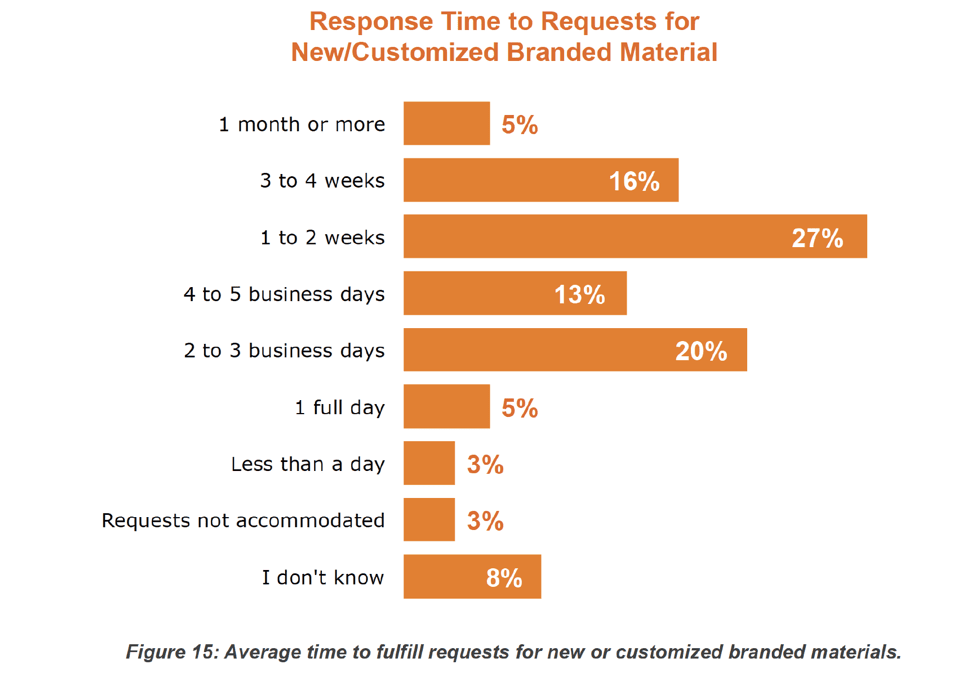
We’ve also found that for virtually half of the organizations we studied, the turnaround time needed to complete a request was at least one week, with 19% saying it would take 3 to 4 weeks or even longer. That’s crazy-in this design race, we have to move faster and be nimbler than that. So, what can we do?

Tip #1: Clear goals
As a creative director, your job is to make sure your team don’t start working on a project without clear goals that are well-defined. But clear goals can be surprisingly hard to narrow down. It takes having one vision and one voice. Give your team a single, clear objective to work towards. You can’t expect them to read your mind, or the mind of anyone else in the company. Be very explicit in what you are trying to accomplish.
Without clear goals on a project, the creative work will suffer. One of the most common errors marketers make is trying to pack too much information into a single piece of collateral or ad. It’s tempting to try hitting every selling point, feature and competitive advantage, but all the messages cannibalize each other-ultimately making the piece less effective. If you don’t have a clear goal, your design will be full of dense text boxes competing with each other for space on the page.
Even worse than cluttered design, without clear goals, there will be arguing and disagreements about the point of the project. And as you know, in this situation, creative teams will bear the brunt of endless revision cycles. Clear goals prevent this waste of time and talent.
To sum up, the best goals are short, punchy and narrowly focused.

Tip #2: Clear ownership
Any given project probably has a number of interested parties, and they’re usually more than happy to offer their input and thoughts. Some of these parties can be pretty demanding.
It’s up to you as the creative director to cut out all the different voices and determine the person who will have final approval, then focus on them. Others may have good ideas and valuable insights, but if they try to influence the decision-making process, they will only be in the way.
If clear approvals and ownership are not established, the design process can get bogged down-or worse, become a proxy power battle among different egos in the company. You’ll probably find some individuals pulling you aside or emailing you directly to make requests. Push back at those attempts. For the benefit of the creative team, and the company, there can only be one person who has final say.
Demand to know who that is before any work begins.

Tip #3: Clear creative brief
The creative brief is the next step after clear goals and clear ownership are established. We all know that creative briefs are essential, but often, they’re not implemented or are implemented poorly. The best creative brief is just that: brief. The worst is long and hastily thrown together, and no one considers it binding. Distilling all of the available information, competing goals and differing opinions into a succinct document is the magic that makes creative briefs powerful.
The distillation process forces everyone involved to really think through the project, to voice their opinions and make hard decisions. Any disagreements about the direction of a project should come up at this stage, before any design work starts.
At the end of the distillation process, the brief becomes a sort of contract. All parties involved should agree to the contents of the creative work, and all creative work should be compared to the brief. Is the creative work meeting the needs and goals outlined in the brief? If it is, great; if not, back to work.
For you and your design team, the brief becomes especially important if and when disagreements arise. Then, you can point to the text and say, “We are completing what was agreed upon in the brief.” It becomes a shield to protect your designers from being jerked around or wasting time. [![]() ]
]
So, if your account manager, sales team or marketing team gives you a bad creative brief, it’s your job to talk to them about how to make it better. It can be an awkward discussion, but in the end, a strong brief saves headaches, revision time and frustration.
Put the work in to make your briefs powerful. In the end, it’s the only sure way to cover your ass.
Key takeaway
Your creatives can be fueled up and ready to make great work, but without a streamlined process, they will soon burn out with frustration. It’s up to you to make sure they can work supported and unhindered.
Now, there’s one big thing we’re still missing. Even with those significant improvements, there’s still a snag-and that’s the inescapable fact that creative teams are a bottleneck.

How often has this happened to you: Your designer takes on a new project, she’s excited to get started, and, using a strong creative brief, she comes up with a good design solution.
She exports a PDF and emails it to the account manager for review.
The account manager has a few revisions and shoots an email back.
Your designer happily makes a few changes and sends it back for approval.
This time, the account manager sends it to other interested parties, and guess what-legal has some changes, the marketing manager has changes, and one of the partners has changes. Oh, and some of these changes conflict with one another.
Legal has printed out the document, written illegible notes in the margins, scanned it back in and emailed it to the designer. Now she has to sort through all the different changes, decipher legal’s notes, and try to harmonize the conflicting edits.
Meanwhile, new projects are queuing up, and your team member is feeling pressured to get this project out the door, stat.
Oops, now there’s miscommunication between legal and the partner, and the marketing manager feels miffed that his changes got lost in the mix. After nearly endless revisions, conversations and confusion, your creative is burned out and everyone’s feelings are raw.
This scenario plays out almost every day in the corporate world. The problem is that the design process repeatedly routes through a single person: the creative.
The big question here is how do we eliminate this bottleneck, take extra workload off the creative team, and make the entire process more efficient?
Integrate your design process
The answer starts by changing how we think about the role of creative teams in a company. We need a new design process: one that is more inclusive, efficient and smart. A silo-busting process that works across disciplines. One that recognizes the need for speed in today’s environment while keeping creative teams firmly in the creative driver’s seat. We need creative team members to break out of their isolated roles to better create, collaborate, and control their content.
Here are three tips to help your creative team break out of that deadly cycle of revisions.

Tip #1: Informed, collaborative, integrated design
We’ve already established that the best work comes from strong creative briefs that all interested parties agree with. Now, let’s take that one step further. Rather than the creative team being the only one who cares about design, what if everyone from the creative team to HR to legal and especially to the executive team were invested, educated and involved in the design process? I call this integrated design.
Integrated design means everyone in the company is:
- Educated on the brand’s standards
- Committed to enforcing compliance
- Prepared to participate in design revisions
Integrated design means the creative team can engage everyone involved in an effective, collaborative way, greatly reducing the amount of revision time.
To be clear, I’m not suggesting design by committee. Design by committee happens when people believe they have authority over the design process, or parts of the process that shouldn’t involve them. That’s the last thing your creative team needs. Instead, integrated design elevates the process into a business essential, putting creative team members in control so they’re no longer the bottleneck.
Host a short, smart training session to review the brand standards and why they matter. Show examples from competitors of how their branding is succeeding or failing. Paint the picture for your company that a strong brand is essential to success. Then, get commitment from everyone to help enforce brand standards. That way, your creative team will feel less pressure to constantly police everything your company puts out.
Show the best way for employees to give feedback. Do they need to be trained on certain software programs? Do they need to learn a little design vocabulary? Since you’ve established that strong branding and design are essential, everyone will be open to learning a new process.

Tip #2: Rev up your brand guidelines
To reduce the time design teams spend on recreating work, you need to set up strong brand guidelines. And by strong, I mean that they are thorough and easily accessible.
Branding isn’t just a set of colors and typefaces. It’s a system based on a company’s core values and traits. [![]() ] Pointing out the logical connections between company values and branding will strengthen employees’ commitment to using the brand guide.
] Pointing out the logical connections between company values and branding will strengthen employees’ commitment to using the brand guide.
Equally important as having strong guidelines is making sure they’re accessible. What good is a brand guide if no one can use it?
A PDF with your brand guidelines is a good start, but it’s limited because it has to be emailed back and forth, and, if it is ever updated, you run the risk of employees referencing old guidelines. An even better solution is to have a living brand guide. A living brand guide is a centralized, dynamic system that lets your creative team update the brand standards (which instantly updates them for everyone else).
One of the reasons I love Lucidpress is that it serves as a powerful living brand guide. It stores brand logos, colors, fonts and other assets, making it super easy for creative teams to set the standard and keep everyone on track.
Designers can set brand assets as the default settings for each new document in Lucidpress, making it super easy and convenient for employees to design with the right brand elements from the start. Since Lucidpress lives in the cloud, designers can make updates on the fly and sync them company-wide.

Tip #3: Do it once, do it right
One more story. How often do you have small, recurring design requests? For example, maybe your sales team needs a flyer updated every time they go to a convention. It’s a simple change, but for the creative team, the time adds up.
What if you need to make promotional materials for all of your franchise locations, and your creative team has to spend a ton of time simply switching out addresses and hours? This is a huge waste of time and talent. Your creative team should be focusing on delivering great creative work, not sorting through countless edit requests.
One solution is to give everyone in the company access to Publisher or InDesign… but then the creative team has no control over the brand standards. Plus, everyone will be sending files back and forth, managing their own fonts, and losing track of assets. Once again, your design team becomes the bottleneck.
The key to freeing them up is through cloud-based, lockable templates. Lockable templates empower employees other than creative team members to create and update branded content.
This is a special feature we’ve built for Lucidpress. Creative teams can make templates, then lock down the fonts and colors, the position of text boxes, logos and legal copy-whatever you don’t want others to change. Because it’s all cloud-based, creative teams can easily manage, update and find all the files different employees are working on. Anyone can customize the content to their needs without adding to the creative team’s workload.
This is a huge breakthrough in the design process, and our customers have enjoyed great success in real-life applications. An art director from Reinhart Realty told us this:
“Some agents didn’t feel it was necessary to include the Reinhart logo on their content. But now that we can lock down our brand assets on the templates, agents and brokers can’t accidentally mess things up.”
The results are pretty stunning. Both Reinhart admins and agents agreed that Lucidpress saves them about 2 hours of work per week. With 160 Reinhart employees using Lucidpress, that’s 320 hours of work saved per week-or 16,640 hours saved per year.
That is the real result of an integrated design process.
Wrapping up
As a creative director, your designers are one of your greatest assets. Focus on fueling them up, incorporating an integrated design process, and providing the tools to create great, on-brand materials. It’s the only way you can win this big design race we’re in.
The lure of the hip advertising agency is becoming outdated as more creatives move in house to meet the demands of nonstop content. In 2018, 78% of members of the Association of National Advertisers used some form of in-house agency services. This is up from 58% in 2013 and 42% in 2008 — so you can see where the trend is heading.
What qualifies as an “in-house agency”?
A lot of businesses have internal creative teams, but how is that different from an in-house creative agency? As you can imagine, an in-house agency is bigger in every capacity and more complex than a creative team.
Internal creative teams are often specific to a department, so different departments will have their own teams who all answer to a different manager (and this setup can lead to siloed creative work).
An in-house agency operates as its own department that the rest of the company turns to when any creative work is needed. It also has its own management structure.
In-house agencies differ from external agencies in a lot of ways, but the primary difference is that external agencies service a bunch of different companies and brands, while an in-house agency has only one client.
What are the benefits of an in-house creative agency?
Among the many benefits of having an internal creative agency, Digiday found that 75% of brand marketers think moving services in house improved speed and agility, and 68% say it reduced overhead.
When you keep things in house, you’re eliminating the middlemen, and the fewer people you need to relay information to, the faster your turnaround. Because of this, your projects are also less likely to suffer from the “telephone effect” where the message or outcome gets further and further skewed from its original intent.
But the biggest benefit? Your in-house agency is focused on only one thing: your brand. It’s going to be far more knowledgeable and more invested in your company than any external agency could be.
What are the challenges of an in-house creative agency?
According to a study from the In-House Agency Forum (IHAF), 78% of agencies report having a “clear mission, purpose and/or objective,” yet 42% of marketers report they don’t know what their agency’s mission is. Clearly, those numbers don’t quite add up.
On top of that, in-house agencies are often missing the specialized talent to get the job done. “Three in four IHAs (79%) say specialty talent and capabilities need to advance internally over the next two years, with video, digital, social media and analytics skills topping the list of what’s needed.”
Only 31% of corporate marketers saying IHA leadership is “highly” effective, and 53% think it’s just “somewhat” effective, showing room for improvement in leadership.
There are also challenges with scaling marketing efforts. Growing content needs and edit requests can overwhelm in-house creatives, especially if there’s not enough budget to hire more people.
Tips for building an effective internal agency
So how can you set up an in-house agency that thrives? Here are the basics:
Know your brand
This goes for pretty much any endeavor, but the more clearly you can define your brand, the clearer your mission will be and the better your agency will understand its goals.
Know what you need (and what you don’t)
Not every agency is going to need a team of videographers or savvy social media mavens. Do you want account executives? Producers? Media buyers? A PR team? Your agency can be as simple or complex as you need.
Expand where you need to and don’t skimp on the roles whose specialties will make great work possible. But save where you can by knowing what will and won’t give you return on your investment.
Hire the right people
Diversity is king — especially when you’re working in a creative field. To make your agency dynamic, you want to have people with different backgrounds and professional experiences.
You also want to invest in good leadership. The right leaders will steer your brand in the right direction and keep your staff happy.
Focus on a culture of creativity
Once you’ve got things in place, the work’s not over. Agency culture is extremely important, and you want to make sure your creatives feel like they have the freedom to pursue big ideas.
Encourage out-of-the-box thinking and risk-taking. It’s also beneficial to regularly give employees time to explore creative pursuits that are tangential to their roles.
Building a successful in-house creative agency will take vision and an inspired sense of leadership. For more tips on how to master creative leadership, check out our free guide How to manage creative teams, where you’ll find advice on advocating for and building a good rapport with your team, as well as info about leading with a creative vision.
A marketing brief is the blueprint that keeps your team aligned from the start of any marketing campaign, big or small. Unfortunately, these briefs don’t always feel like the superhero that makes your life easier, rather, they tend to feel like a complicated task that takes too long to put together.
But hey! It doesn’t have to be that way. It’s time to ditch the traditional document that can be too complicated. In order to get you to a more efficient starting point, we’re going to outline how to write a marketing brief like a champ so you can get the ball rolling on success.
Why you need a marketing brief
Marketing briefs give creative team members, along with stakeholders, a foundation for the marketing strategy for each and every project. They provide a hard outline of what everyone needs to know to carry out your campaigns for advertising, communications, websites, public relations, etc.
With the right things included in the brief, you’ll get down to the nitty-gritty, like the target audience and budget for any marketing campaign. With a good marketing campaign brief template, you can also clarify roles and objectives so everyone you work with on the campaign knows exactly what you want and how you want it done.
It’s important to note that a marketing brief is different from a creative brief. A good marketing brief example is as follows: it explains the purpose of a marketing strategy, identifies the goals and audience of the campaign, sets timelines, and establishes measurements for success. Essentially, it’s the instructions for the agency or team you’ll be working with.
A creative brief is a separate document used for campaigns or projects that require creative strategy. A creative team uses it to outline aesthetic elements and address any other problems through a creative strategy. A creative brief can include your target audience, correct logo use, brand colors, etc.
What to include in a marketing brief
To make things easier for yourself in the future, create a simple marketing brief template. We’ve outlined the most important things you should always include in a marketing brief below. There may be some projects that require more information than what we’ve included, but this outline will be a great starting point to build off of.
1. Goals and Objectives
Use this section to outline exactly what you want to achieve with the campaign or project: Increase brand awareness? Gain 10,000 new subscribers? Generate $20,000 in new online purchases? Be as specific as possible. This section is also a good spot to highlight any potential risks associated with the project.
2. Background
This section of your marketing campaign brief is meant to help team members understand the significance of the project. Providing background context for why the work is being requested will influence their decisions and help the project reach its goals.
3. Audience
In every marketing brief template, you’ll find a section with information on the audience or target market. This is one of the most important sections because it will explain exactly who you’re trying to reach. The more specific you can be, the better.
4. Deliverables
Clearly list out what finished products are expected to be included in the campaign. This may include ads, designs, logos, social media posts, landing pages, etc.
5. Channels
Where are the deliverables going to live and how will they be distributed? Outline which channels you’re currently using and if you want to experiment with new channels. This will be influenced by your target audience.
6. Timeline
No matter how big the project is, you need to outline the timeframe for work expected. Include hard and soft deadlines and whether they’ll fall within a quarter or particular sprint. Break down every step as much as possible. Remember to include when the campaign will launch and end.
7. Budget
Remember to outline your budget for the campaign. You can start with a range and then map out expenses once the full execution plan is decided on. You may either need to scale back or have some wiggle room when comparing your final budget to the initial range.
8. Tracking and Measurements
A marketing brief template would be useless if it didn’t include a section for tracking and measuring success. At the end of every campaign or project, be sure to collect any necessary data to determine if the campaign was a success, to measure marketing performance, and to see if your initial goals and objectives were met.
A marketing brief template that includes these eight sections will provide any potential agencies you work with the right background to put together a plan that can achieve your marketing goals. Overall, your marketing brief is meant to help define, plan and evaluate the overall campaign or project. When you think about it, it’s really just as simple as outlining what all stakeholders involved need to be doing, how they need to do it and when they need to do it by.
Check out our free marketing brief template for help getting started.
So you’re wondering how to how to design a brochure that will impress. Dealing in the medium of brochures is a tricky thing, because they’re all just one step away from the garbage. But don’t worry, this post will show you how to make a great-looking brochure that’s not destined for the recycling bin. You’ll learn how to master the 2 most important components of brochure design: the copy and the photos.
For a brochure to be a success, your copy and images should be an integral part of the design, not just an addition. The finished product should also be consistent with your brand. Let’s jump in.
Related: How to make a travel brochure that looks stunning
Brochures are a powerful sales tool and have been around for decades. Today, anyone can make their own. But what is a brochure, really? Let’s review standard layouts, sizes, folding options, and suggested brochure content.
What is a brochure?
A brochure is a folded document that presents information in a segmented, easy-to-digest way. Brochures are similar to other printed documents, but with key differences. Like pamphlets, they are informational, but brochures are designed to advertise a particular brand, product or service. Unlike flyers and posters, brochures are folded into sections, so they can retain their size but present more information.
In previous decades, making a brochure was far more complicated, requiring long lead time and cross-departmental cooperation to bring together photography, hand-drawn elements, and typography. A design would go through several physical drafts before the final version was painstakingly created. Changes weren’t easy to implement, either. Today, one person can create a brochure from scratch using modern design software, and the brochure can easily be tweaked and edited to perfection.
When to use a brochure
It’s not uncommon to wonder when it’s appropriate to use a brochure rather than another format, like a flyer. The answer lies in the **buyer’s journey**. Flyers are great for attracting attention, building awareness, and sharing a short message. But brochures are far more effective down the road, when a prospect is gathering the information needed to make a wise purchasing decision. Brochures provide more information about a company, its products and its services, at a deeper level than a flyer can. For that reason, they’ve remained an essential marketing tool for many companies and organizations. Here are 12 excellent examples of when to use a brochure. There are many, many more, but these will give you an idea of the possibilities. +
Direct marketing — Brochures can easily be included in a marketing campaign like direct mail.
Financial — Banks can provide brochures in the lobby to explain their account options, loans, and other money-related services.
Food service — Restaurants can create catering and to-go brochures that patrons save for later. The best ones will include a full or simplified menu, along with contact information.
Healthcare — Doctors and hospitals can introduce themselves to a new community with a brochure explaining their services. Brochures are also handy for patient education on a variety of illnesses and other health concerns.
Marketing — Marketers can hand out brochures to interested visitors at trade shows and expos.
Offices — Offices with heavy foot traffic can provide brochures about their services in the waiting room. Visitors can read them while they’re waiting, and the staff won’t have to spend as much time explaining their services to each person.
Personal care — Spas and salons can use brochures to list all of the different services they provide, as well as their prices.
Politics — Politicians can use brochures to inform voters about their platforms and stances on important community issues.
PR — Public relations managers can include brochures in press releases and media kits, so the news media can craft better, more accurate stories about a company.
Retail — Stores with heavy foot traffic can provide brochures at the front of the store. A brochure of popular product highlights is far less expensive to produce than an entire printed catalog.
Sales — Salespeople can hand out brochures to business associates, partners, and potential clients after a demo or presentation.
Travel — Airlines and travel agencies can use brochures to advertise exotic destinations and affordable vacation packages.
Standard brochure sizes

5.5″ x 8.5″ Often called a half-fold, bi-fold, or statement. This layout is created by folding an 11″ by 17″ sheet neatly in half, so that it opens and closes like a book. Commonly used for menus and event programs. If you fold it in half again, you can create a quarter fold brochure with 8 miniature panels.
8.5″ x 11″ You’ve likely seen many brochures of this size, since businesses often use them as sales and marketing pieces. This is the most popular size because it can be folded into several useful configurations that fit easily in an envelope. A tri-fold creates 6 long panels, and we’ll discuss the different tri-fold layouts in the next section.
8.5″ x 14″ Slightly larger than its predecessor, this size also makes for great tri-fold brochures. More space means more folding options, such as double gate or parallel folds. In fact, a double parallel fold creates a slender brochure that has become a staple in tourist information racks.
11″ x 17″ Larger brochure sizes are most helpful as visual aids. This size is often used for amusement parks or other tourist attractions, because there’s enough room for a map. It’s a great size for showcasing travel destinations as well.
11″ x 25.5″ The largest standard brochure size. What it lacks in portability, it makes up for with visual impact. Brands who depend on gorgeous, detailed photography benefit from the extra space. For example, real estate agents can show off their properties with full-color photos of a house and its rooms.
Custom If you’re hoping to make something unique, you can always talk to your printing partner about custom sizes. Just be prepared to discuss pricing, because custom printing will be more expensive than sticking to the standard. For some creative inspiration, check out this Pinterest board of unique brochure designs.
Popular brochure layouts
Bi-fold
The simplest brochure layout is a bi-fold, where a single sheet of paper is folded in half. This results in 4 consecutive panels that can be read from left to right like a magazine. The vertical layout is more popular, but a bi-fold can be oriented horizontally, too.

Tri-fold
The most popular layout is the tri-fold, a single sheet of paper folded into thirds. Tri-folds are versatile, giving you multiple folding options. Even though they each contain 6 panels, how you fold the paper will determine which panels end up where.
- C-fold — A C-fold resembles the letter C when open. When closed, one third of the paper is nested between the others, like a spiral.
- Z-fold — A Z-fold resembles the letter Z, opening and closing like an accordion.

French fold
A French fold is created by folding a sheet of paper vertically and then horizontally. This separates the paper into quarters, resulting in 8 panels overall. With a French fold, your brochure is small and portable, but it expands to the size of a flyer or poster. If you want to present a large design across multiple panels, this fold can be very effective.

Gate fold
Sometimes called a window fold. Though this is technically a tri-fold, it does not result in 6 equal-sized panels. Instead, the right and left sides of the paper fold in to meet in the middle. This makes the center panel twice as large, creating more space for visual design inside the brochure.

Double gate fold
To make a double gate fold, follow the steps above to create a gate fold brochure. Then fold it in half again, vertically. This creates a central fold down the center panel, resulting in a slender brochure that can fit more easily into envelopes and other narrow spaces.

Double parallel fold
A double parallel fold requires two vertical folds. Take a sheet of paper and fold it in half, then fold it in half again. That way, half of the sheet is nested within the other. In the end, you’ll have 8 panels. Depending on the size of the paper, the resulting brochure might be narrower than a typical tri-fold, or it could be roughly similar in size but with the addition of 2 panels.

Spiral fold
Lastly, our standard set concludes with the spiral fold. It’s similar to a C-fold, but with more panels—typically 8 in total. The spiral effect is achieved by folding each panel inward so that they nest inside one another. Because of this, the inner panels should be slightly smaller than the outer panels, so that the brochure lays flat when folded.

Designing for your fold
If you’ve chosen a layout but are unsure how to design it, try folding a blank sheet of paper and numbering each panel. That will make it easier for you to keep track of where each panel goes while you’re designing onscreen. It’s a handy reference tool!
Templates
Templates are the brochure maker’s best-kept secret. It doesn’t make sense to start from scratch every time you need to create a new brochure, especially when many software tools provide free brochure templates designed by professionals. If you have no idea what you want your brochure to look like, templates can provide inspiration and samples to work with. If you already have a vision, the right template can save you loads of time. For examples, take a look at our gallery of free brochure templates.
Essential brochure elements
Because brochures are most often used in advertising, it’s important to consider what your brochure should inspire the audience to do. Like many marketing materials, a good brochure will be visually interesting, tell an engaging story, and prompt the reader to take a certain action—like purchasing a vacation package, for example.
When you layout your brochure, make sure the following elements are well represented.
1. An alluring cover
This is the first (or only!) chance your brochure has to give a strong impression, so make it count. The cover is a promise, so it should reflect what’s inside. A high quality, relevant image combined with a brief, easily legible headline will provide your reader with a strong understanding of what your brochure is about.
2. A compelling offer
Details aside, what you’re really providing with a brochure is opportunity. It shows the reader a whole new world of possibilities to improve their life. No matter what your product or service is, whether it’s catering plans for a wedding or security alarm systems for an office building, your brochure needs to offer just enough to make readers want to know more.
3. Valuable information
Brochures offer limited space to communicate your message, so prioritizing which information to include is critical. Dedicate space to the features and (more importantly) benefits of your offering, and consider other details like prices, dates and times, if applicable. The best rules of copywriting apply here: be clear, be concise, and tell a good story that makes your reader the hero.
4. A strong call to action
You can build a beautiful, convincing brochure that makes your audience feel exactly the way you want to… but it’s useless if you don’t provide the next step. A strong call to action will prompt the reader to call, visit, or connect with you in some way, so that the relationship can proceed further. Sometimes this means making a purchase, but not always, so think about what you want your audience to do after reading your brochure—and direct them accordingly.
5. Detailed contact information
Goes hand-in-hand with your call to action. Not everyone will make a move right away. In fact, many people hold onto brochures to reference later, when the time is right. Don’t make them search for ways to get in touch with you. Make it easy by putting your name, phone number, email/web address, and physical location on the back. Some companies even put a simplified map to help people find them. That might be a little old-fashioned in the age of GPS, so you could include an interactive QR code or other helpful tidbit instead.
Other ideas to consider
The 5 elements listed up there? Those are the basics. If you really want to knock it out of the park, here are some tried-and-true brochure sections that you might not have considered before.
Answers to FAQ
It’s likely that your readers share similar concerns, resulting in frequently asked questions. Save time and overcome objections early by including a FAQ section in your brochure. Don’t dive too deep; a brochure should be brief and present your brand in its best light. But for concerns that can be quickly and easily resolved, a helpful FAQ section is worth its weight in gold.
How-to guides
Knowledge is power, which is why information is valuable. Sharing helpful information with your audience builds trust, and a how-to guide is a great example. Empower readers to spot or solve a problem on their own by breaking down the process, step by step. It could be instructions on how to test your product, but it doesn’t have to be.
For example, if you’re a pest control company, you could offer tips on how to identify the presence of certain insects or rodents. If you’re a photographer, you could include tips on how to dress for an outdoor photo session. Take a few moments to brainstorm about your brand, and an idea will likely present itself.
Testimonials
No one can speak to how your brand improves lives the way your customers can. They know because they’ve experienced it firsthand in a way you cannot. That’s why we, as consumers, trust friends, family, and online reviews more than any slick sales proposal. Including testimonials in your brochure adds a layer of humanity and credibility that can reassure your readers that they’re making the right choice.
How to make a brochure
Here are the basic steps involved in creating a brochure. If you’re ready to learn more, we have a longer, detailed article that covers each step in depth. Visit our guide on how to make a brochure to learn more.
- Consider your layout / size. Before you can start designing, you have to decide how big or small you want your brochure to be, as well as how it should be folded.
- Write compelling copy. Brochures don’t offer a lot of space, so each word should be purposeful. Make your message consistent, easy to read and easy to understand.
- Provide visual interest. Illustrate your message with visual elements, including high quality photos, that make your brochure more interesting to the reader.
- Choose your colors. Color is closely tied to emotion. Using colors effectively in your brochure will enhance your message and emphasize specific points.
- Test-run the print version. Before you print (or order) hundreds of copies, it’s critical to test-run it first. Verify that the finished product meets your expectations.
Want to design beautiful brochures online? Lucidpress makes it easy. With our intuitive drag-and-drop online brochure maker, you can select a template and customize it with fonts, colors, shapes, images and more. It only takes minutes to create a high quality brochure that you’ll be proud to print and share.
The copy
Words. We throw them around every day, but how often do you carefully consider what you’re saying? When it comes to brochures, word choice is paramount. Remember that your objective is to entertain, persuade, and inform. Here’s how you do it:
1. Check your grammar and spelling
Read your work twice, then have someone else look it over. A misspelling or grammatical mistake can slay your professionalism and doom your brochure to the open jaws of the trash can.
2. Make evergreen content
You don’t want to create a quality brochure only to make a new one next year because the content is out of date. In copywriting, a principal objective is to make sure your content is evergreen. This means that your content will (theoretically) always be relevant. So, you might want to avoid including references to upcoming holidays or this year’s Super Bowl winners.
3. Be international
Your copy will potentially be read by people from many countries and cultures. Every culture has idioms and colloquial expressions that may not transfer well. For example, if you talk about killing two birds with one stone to someone who speaks English as a second language, they might call the animal cruelty hotline.
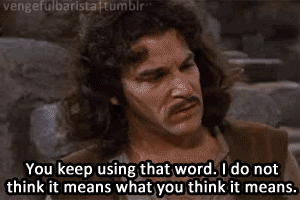
Of course, using colloquial or idiomatic language can humanize your brand and keep things lighthearted. It becomes a problem when you use so much culture-specific language that your writing is unintelligible to someone who has a different background. Knowing your audience will help you strike the right tone.
4. Know your brand and stick to it
Every line you write should align with the larger brand experience of your organization. This creates a consistent experience for your customers—and helps potential customers know what to expect. Just like we speak differently in different social settings, the copy in your brochure should adjust to your brand.
Yelp’s Eat24, an online food delivery service, has settled nicely into a brand that really works for them. The tone is playful and lighthearted; for an example, check out this messaging from the Eat24 website:

This copy is clever and it also matches the overall feel of Eat24’s site. The humorous, slightly sarcastic branding of Eat24 could work for your brand, but you also might need to take a different approach. Imagine if you saw an ad from your bank that said, “We’ll watch your money for you. Probably.” Customers would be confused and concerned, so again, know what’s acceptable to your audience.
For more examples of standout copy, check out this post from Hubspot’s marketing blog.
The photos
Just like your copy, the photographs in your brochure send a message. You’ll want to make sure that message is professional and interesting. Before we get any further, I think I need to make one thing very clear:
Beware of stock photography.
Millions of Americans struggle with stock photography every year. You know it when you see it—models with unnatural facial expressions, dressed in stereotypical clothing, all bathed in lighting that even a moth wouldn’t fly toward.
Just thinking about it makes me shutter (get it?), and I don’t want you to feel the same pain. Luckily, there are alternatives. What follows is a list of my favorite sites for free images that aren’t awful (in no particular order).
1. Unsplash

I find myself visiting this site most often. I think the images are gorgeous, and they’re always very high quality. All the images are free, and no attribution is necessary. It’s a pretty great deal, and you also don’t have to sign up for anything to download the image.
2. Pixabay

Pixabay has a ton of images on their site, and, like Unsplash, there is no attribution required. There is a pretty diverse range of photos on Pixabay, though the quality does vary. You can find some great stuff though!
3. Stocksnap.io

Again, no attribution required here, and there’s a great selection of high-quality images. Many of the images are comparable to Unsplash, and sometimes the two overlap a bit. Stocksnap.io has definitely come in handy for me.
4. Flickr

Flickr has a lot of great stuff, you just have to be aware that not all of it is free for commercial use. You can filter your searches to only include photos that are open to commercial use and modifications, and you’ll usually have to credit the image to the original creator and link back to the source, just as I did on the photo above.
There are a few more options out there, but those are a good place to start. Fantastic photos will draw your brochure readers in and stay their trash-tossing hand.
Ready to get started? Choose one of our free brochure templates and dive in!
Does your creative team struggle to make deadlines? Are they working way too many hours, or are they constantly stretched thin by production demands? These are all signs that your team may not be as efficient as they could be, and the answer isn’t necessarily more tech or more people — it’s creative operations.
What is creative operations?
Creative operations (or “creative ops”) is a means of improving the way work is done on creative teams. Think of it as pairing the left brain with your creative right brain, the marriage of Don Draper with Henry Ford. It’s a framework that optimizes productivity and manages deadlines by bringing metrics, process and structure to the creative process. It requires looking at the creative process as a supply chain to figure out where you can optimize each step and produce more with what you currently have.
Creative operations also covers things like:
- Creative briefs
- Project management
- Project intake
- Communication with clients and project owners
- Communication within your team
- Status updates
- Delivery
- Distribution
- Asset storage
Creative ops vs. project management
Although a creative ops position will have some overlap, it involves much more than project management. In the simplest sense, the difference between creative ops and project management is depth: project management requires organizational skills, whereas creative operations management requires a strategic mindset to find better solutions. Creative operations managers need to understand the cross-functional tasks of different creative teams and bring them together to work in collaboration.
Why creative teams are adopting creative ops
The overall goal for creative ops is to reduce costs and eliminate waste, which is why an in-house agency may adopt creative operations. Creative ops management is all about operationalizing the process, which ultimately causes you and your teams to be more productive and efficient. In addition, there are four other major reasons why more businesses are adding creative ops to their management system: the increased demand for creative assets, complex processes, process inefficiencies and marketing compliance.
Benefits of creative operations
Data-driven decisions
Many business decisions made on creative teams have been driven by best guesses based on prior experience or last-minute creative deadlines. Through creative ops, you can collect data that will empower your team to make more accurate projections and more sound decisions about their projects. With this collected data, they can also provide better reasoning behind requests for hiring, new work, budget or additional resources.
Increased collaboration
Creative operations alleviates issues that arise from workers avoiding difficult situations. It will encourage better collaboration in design by gathering data and identifying where issues are stemming from. This will give employees the space to take accountability for their actions and improve.
More accurate project forecasts
Through creative operations, you’ll be able to define project measurements and give stakeholders access to data from past projects to help project the performance of current or future creative work.
How to implement creative operations
1. Hire a creative ops manager
The first step to implementing creative operations is to hire a creative ops manager. You should be looking for someone with a strong creative background along with excellent management skills in addition to the following skills:
- Strong process-orientation and problem-solving skills
- Proven experience in providing project solutions across multiple disciplines
- Conceptual and strategic thinking
- Experience in developing simple, efficient processes for a set of complex activities
- Knowledge of all aspects of digital creative and production workflow
- Understanding of cross-channel marketing and its interdependencies
- Ability to prepare and present high-impact business cases and recommendations to executive team
Along with other typical management responsibilities, your new creative ops manager will be responsible for:
- Marketing and creative process innovation
- Ensuring process optimization and scalability
- Developing, documenting and maintaining creative and marketing processes
- Overseeing PM teams to work in conjunction with marketing PM teams
- Advocating on behalf of creative quality
2. Review creative workflows
Once you hire a creative ops manager, you should review creative workflows and identify common issues like slow turnaround time, too many mundane creative requests, or content getting lost, going unused or needing to be re-created. Weed out the stumbling blocks for your teams in their creative workflows.
3. Develop new processes
When you’ve identified issues in your creative workflows, it’s time to develop new, better processes. If your creative team has been overwhelmed with content requests, a platform like Lucidpress that offers brand templating and digital asset management could be a good solution. Brand templating streamlines the creative process by empowering non-creatives to customize their own content. It also ensures content is easy to find and use by organizing a library of templates connected to a digital asset management system.
Curious about brand templating? Check out how the creative director from Club Pilates uses Lucidpress to avoid marketing mishaps:
https://fast.wistia.com/embed/medias/f7e3ghotto.jsonphttps://fast.wistia.com/assets/external/E-v1.js
Creative operations is a huge shift in work philosophy, but it shows a commitment to continuously improving the workflow of your creative teams. This new commitment will take time and effort to make sure everyone is on board with a new approach to their work. If you’re looking for extra help in managing your teams, check out our guide to managing creatives.
As a marketing manager, you’ve got a content vision, and you’ve got a content strategy — and you know what kind of content you want to offer. And you’re also committed to establishing a system of content intelligence to inform content decisions.
But executing all of this may be more of a stumbling block than you imagined. Plus, it’s come to your attention that your content may be suffering from misuse or ineffectiveness. So what’s missing? How can you better connect the dots?
There’s a growing discipline called content operations, and it may be your missing link. It can help you sustain and scale your implementation while ensuring effective and efficient work from your team.
What are content operations?
Content operations are defined as the people, processes and technologies that empower an organization to implement its content strategy to produce and deliver content effectively. It’s considered the behind-the-scenes work of managing content activities.
Unfortunately, content operations are not often the priority for companies. Too many organizations justify scrambling once or twice a month to throw content together. If this sounds familiar, you might need to rethink your content work. To be able to sustain and scale effective content, you need to develop mature content operations.
Why pay attention to content operations?
It may feel like that monthly scramble is good enough for your creative and content marketing teams, but there are several benefits to implementing content operations at your org.
Ultimately, implementing content operations better aligns your backstage activities with your content vision and strategy, so you reduce the risk of failure while repeating or scaling success more quickly.
In more specific terms, content operations will help you make the most of your content assets by:
- Creating or streamlining repeatable processes with content playbooks
- Putting the right people in the right roles
- Distinguishing between content maintenance and ongoing content innovation
- Choosing the right tools and tech to support your operations
Content operations also help your organization avoid these costly growing pains:
- Duplicate efforts on content
- Conflicting or inconsistent content
- Off-brand voice or tone
- Gaps between customer needs and your content marketing
- Failure to grow content capacity and supply chain to meet demand
- Failure to optimize processes to create, deliver and manage content
- Purchase of duplicate or incompatible content-related technologies and tools
These aren’t the only things you can improve with content operations. A content science study found 51% of participants were scaling content operations across business functions. In that same study, it found that 65% of content goes completely unused by sales reps. Content operations can curb the production of unused content by guaranteeing that it gets used because it’s effective and fulfilling your team’s needs. Additionally, content operations offer a better ROI for your content along with unified customer experiences.
How to get started with content operations
That’s all well and good, but where do you go from here? If you feel your team and organization could benefit from implementing content operations, then let’s go over how you can get started.
Get the right talent on your team
Your team won’t be able to thrive if you rely solely on one content rock star. Your team needs to consist of content gurus who can make your content operations shine.
Consider hiring people who can tackle a variety of content jobs, such as these roles: content analyst, content strategist, content engineer and content designer. For your more basic or entry positions in content marketing and writing, make sure you look at people with these qualities: high output, curious, systems-thinking, considerate and competent in their content skill or role.
Implement brand templating
Brand templating has myriad benefits for content teams. When it comes to content operations, templatizing content helps reduce the costs of wasted and unused content. Templates can be stored in a central location and therefore accessed by all members of your team — and you can even give access to other members of the organization.
Because, realistically speaking, a lot of people are involved in the content creation process (even beyond your team), so giving access to templates ensures that branding and prospective customer engagement are consistent. It also gives people more autonomy with the knowledge that they are producing content in line with your content strategy and goals.
Empower analysis and evaluate the performance
Having access to data will help your team to make decisions around your content more effectively. It will also enable you to assess past content decisions and marketing performance, and ultimately providing your team with deeper insights and intelligent content. Innovation helps your organization push beyond the status quo of content.
You don’t have to rely only on metrics, though. Feedback from your team can be a great place to find recommendations. Including your team in the process will help boost morale and encourage innovation.
Make content a core competency
Content can and should not be siloed — it needs to function as a core competency in your organization. This competency will cut across business functions just as competencies like design and information technology cuts across business functions such as sales, product, marketing and support. By not elevating content to a core competency, you may end up suffering problems that cause your content to be ineffective while making its operations inefficient at scale.
A few ways to make content a core competency in your business are to hire a chief content officer or executive, empower content coaches and advocates, and create a center for content excellence.
Where there are content operations, there’s effective content
Now that you know what content operations are and how to start building yours, you’re ready to move forward. If it feels overwhelming or you’re stuck on a budget, unable to hire new talent, focus on one of these steps and then move onto the next as time and finances allow. Don’t try to implement them at once, as you may overwhelm your team and yourself with so many changes. Your first step could simply be to check out our ebook on creating effective content.
If you’re working in marketing, you need a content strategy plan. Full stop.
Having a content strategy plan in place is one of the best ways to ensure your content is effective, personalized and organized. It’s possible that you currently have one you’re working with, but is it doing what you really need it to?
If you have a strategy for content creation, it’s wise to periodically give it a once-over to make sure it’s garnering the results you want. So to help you outshine your competition, we’ve outlined content strategy basics, why it’s important and the steps needed to create an effective strategy.
What is content strategy?
A content strategy is a marketing plan that outlines what content you’re going to create and the goals you want it to achieve. Your strategy will include the who, what, where and how of your content so that everyone involved in creating and distributing content is on the same page. A clear content strategy will provide a foundation for all decisions around your content while also providing a means for management and organization of it.
Implementing effective content into your business model can lead to better brand awareness, higher lead generation, strong customer relations and so much more. By creating content, you provide your customers with a content experience that in turn strengthens your rapport and encourages a personalized and meaningful customer experience.
Creating effective content won’t be accomplished in a single day. Whatever resources you end up implementing, focus on content personalization to ensure your content is reaching your audiences in the right way and at the right time.
Oh, and speaking of time — when is the right time to implement a content creation strategy? Generally, always. Your strategy should be an ongoing part of your business, no matter what industry you’re in.
For instance, if you’re in the fashion industry, it’s wise to be present on Instagram. Working in insurance? A blog is a great content channel to utilize since readers often search for topics in your subject area. You may not need to be accessing every content channel, but you should be utilizing the ones that make the most sense for your area of expertise. There will also be times throughout your organization’s lifetime when you hit the gas on your content, like during a rebrand or product/service launch, but there are too many benefits to the customer content experience to not always have it running in some form.
Content strategy as a product
Content impacts so many different aspects of your business, from lead generation to inbound marketing to brand image and beyond. So what would happen if you treat your content strategy as a product instead of a project?
By understanding content as project-based, you limit those involved and even the potential growth it could have. By fitting your content strategy into your business model just as you would any other product or service, you’re setting yourself up for real growth. Flipping your view of content from project to product is simple: consider each channel you post content to as a product, and then go from there as you “build” and “launch” your content product.
Content strategy is for everyone
Everyone in your organization should know what your content marketing strategy is. By offering access to your content strategy, you’ll lower the risk of off-brand creations and duplicate efforts.
When your content strategy is available to all, you also make sure everyone is on the same page and working towards the same goals. However, you don’t need to share absolutely everything with everyone if they’re not stakeholders. A targeted summary will work, and in other situations, you can simply offer content templates.
Of course, you may need to have someone in charge of your content strategy, like a dedicated content strategist. A content strategist will need to be proficient in copywriting, content presentation, delivery, campaign experience, multitasking and organization, content monetization, and traditional leadership skills.
Your content strategist will be the one implementing your content strategy on a day-to-day basis through their work with C-level execs down to junior copywriters. Hiring someone into this position isn’t the only option though. Through proper content management (e.g., editorial calendars, content tools, templates, etc.), everyone promotes your content strategy without requiring one sole person to shoulder the full weight.
Creating a content strategy
A content strategy isn’t one-size-fits-all, and what goes into yours will depend on a few factors. You can create the best content strategy possible for your business by evaluating each of these areas.
Set goals
What’s the point of your content? Why do you want to produce it? Answering this question first will steer the rest of your strategy in the right direction. Before all else, define what you want to accomplish with your content by examining what you stand for and your marketing objectives.
Here are some ideas for goals your content plan may address:
- Building customer loyalty
- Increasing brand awareness
- Supporting customers
- Retaining employees
- Converting leads
- Driving traffic to your site
Your goals will change as your organization grows, so revisit them and assess what needs to change to keep your content plan aligned with your business needs.
Know your target audience
Detail who your content is being produced for and where they’re most likely to consume information. And remember that different types of content can help you reach different audiences. Knowing how each of these groups behaves, their lifestyles, what issues they face and more will guide you towards the right content formats. It’ll also guarantee you’re using the most effective content for that audience.
Do competitive research
Checking in on what your competition is doing can help you see what is working and what isn’t. You may find there’s a gap to fill with something no one else is doing that you believe could work to draw customers in.
Tell your brand story
Your brand story is what makes you unique, and this needs to be highlighted to set you apart from others. Your company probably isn’t the only one out there doing what you’re doing, so why should someone buy from you? What makes you the better option? This is where you need to highlight your strengths and everything that makes you better than the other guys.
Your brand story should influence and guide all of the content you create. For example, at Lucidpress, our brand story focuses on helping businesses put their best foot forward with effective content. All of our content acts as an extension of that, from blog posts about content strategy to advice for creative teams.
Identify content channels
Because content comes in different forms, you’ll need different channels to publish it on. This section will be influenced by your audience, where they spend their time and what formats of content you’ll be using. Here are a few examples of different channels and when they’re best used:
- Homepage: This is your online storefront. What you post here will teach potential customers what your product is and how it benefits them. Your website is best used as a starting point for the buyer’s journey.
- Blog: People seeking information are bound to wind up on a blog. Your blog is an ideal spot for showing off industry knowledge, giving expert advice and offering product tips. You can cast a wide net and appeal to all sorts of people, from current customers to those who’ve never heard of your brand.
- Social media: Social media platforms can be used for paid ads but also for posting your own content on your page. Social media is a great place to show off your brand’s personality and build relationships with current customers.
- Newsletter: Newsletters are beneficial for retaining customers and keeping them engaged with your brand. You can target different audiences to share current news from your industry or upcoming changes or new releases from your product.
- Influencer marketing: Influencers build brand awareness through their word-of-mouth referrals. Influencer endorsements are a great way to drive traffic and generate interest in your brand.
- Pay-per-click ads: Ads are an easy way to get your brand in front of as many audiences as possible. You can use pay-per-click ads on sites your audiences frequent to build brand awareness.
- Forums: Use forums to increase customer loyalty through tech support or even chatting about new ideas. Forums can also be used to generate customer feedback to build customer relations.
- Guest posts: Guest posting can be a useful tactic for building brand awareness, breaking into a new market or getting your product in front of people who haven’t heard of it.
Determine your budget
If you view your content as a product, your current budget is most likely going to change. Just as companies pad traditional production budgets banking on prototypes and trial-and-error periods, it’s a great idea to do the same for your content.
For example, your first content marketing plan may include hosting a regular podcast, but with time you may find this is a flop and need to move on. Will you be prepared to deal with the loss? Or will you continue to maintain something that’s possibly hemorrhaging money? Start with estimates, then determine what you already have at your disposal.
Measure your success
No content creation strategy is complete without a way to measure marketing performance. The best way to measure your performance will be based on your goals. Below are a few ways to determine your metrics.
- Word-of-mouth referrals
- Views, likes, shares and mentions
- Traffic
- Conversions
- Click-to-open rates
- Reduction in support calls or time spent on calls
- Customer retention
- Revenue
Plan your content calendar
A content calendar details what content you’ll be putting out. You can use one big calendar to include all content formats and channels or have individual calendars for each channel (this may help if one channel uses several types of content).
There are several different forms content can take, and which one you use may depend on your topic or area of expertise. Here are the most common types:
- Blog post
- Video
- Social media post
- Infographic
- Whitepapers
- ebooks
- Podcast
- Landing page
- Newsletter
- Case study
Content strategy examples
Your job is to make sure that content conveys the essence of your brand efficiently and effectively. You want your brand not just to be known, but to be memorable.
Here are some proven ways to do just that.
1. Use surveys to tell readers about themselves
There’s a power in data that no amount of convincing copy can match. It’s no wonder, then, that original research is one of the most sought-after forms of content. Compelling data backed by strong market research and insightful analysis is a surefire way to grab an audience’s attention.
Online surveys—via your website, email or social media platforms—are a great way to collect first-hand data from users at little to no cost. By gathering this data, you’re not only laying the foundation for the report you’re building; you’re also getting your users more invested in your brand. Once they tell you things about themselves—what they like and dislike, what they think, what they want—they’re keen to learn more about your brand and whether you can customize products to their liking.
Take subscription retailer JustFab for example. Every customer is quizzed about their style preferences, and a personalized style brochure is created for them based on their inputs.

These personalized recommendations are the secret behind JustFab’s success as a billion-dollar unicorn at a time when other retailers are faltering.
2. Ceaselessly educate your audience
Rewind back to high school. Was English your favorite subject? If so, I’d bet $20 that you remember your favorite English teacher in vivid detail. Replace English with history, chemistry or whatever your favorite subject might’ve been—you get what I’m saying.
When you learn something new and exciting, you’re likely to remember who taught you about it.
Sharing things that your users love to learn about will attract new customers to your brand like heat-seeking missiles.
From YouTube videos to well-researched whitepapers, the form your educational content takes is entirely up to you and your readers. A detailed step-by-step post (with pictures) is my favorite way to quickly learning something new. As an avid iPhone fan, I turn to Apple forums for news and information on all my iDevices. What these niche sites successfully demonstrate is that you don’t have to burn a hole in your pocket to create great content. In fact, you can record your iPhone screen and turn it into a quick video tutorial of your product.
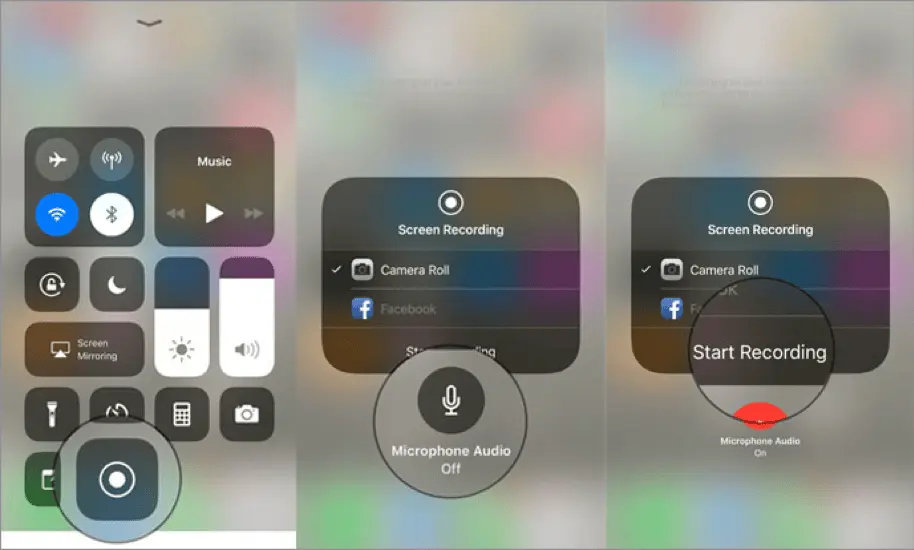
But, it’s not just the format of your content that matters. It’s also the platforms you use to share it on. For example, with the rise of Instagram, it’s easy for me to reach out to my audience with short informational videos that showcase my skills and educate the user.
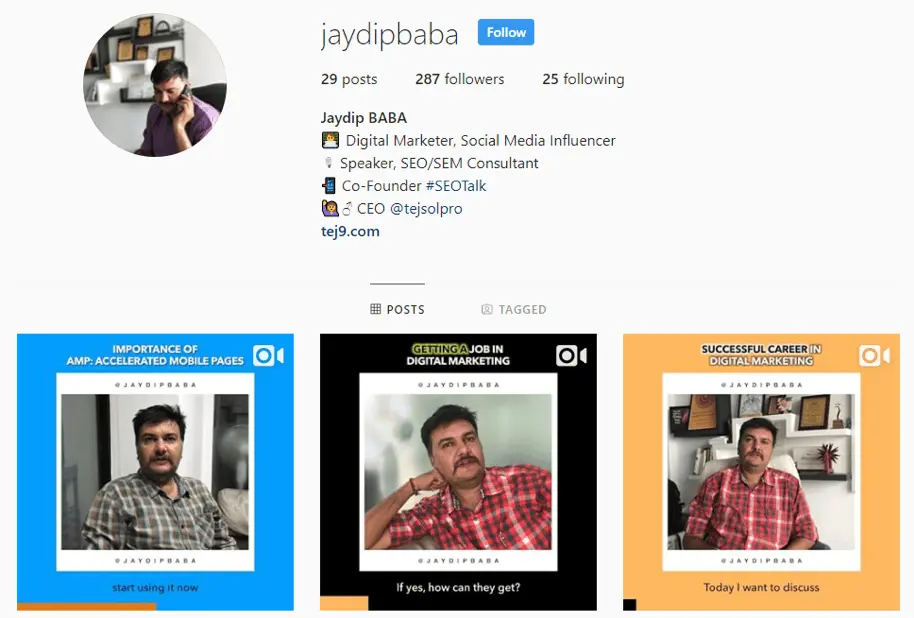
3. Support a cause you believe in
One thing we know about the millennial generation is that they care deeply about causes that matter to them, and they support brands who support those causes. With millennials now wielding the most purchasing power, it’s a good time to dig deep into your brand’s heart and discover the cause that makes it skip a beat.
Specialty retailer BoxLunch is a wonderful example of a brand that lives by its principles. For every $10 you spend with BoxLunch, the company donates one meal to the charity Feeding America.

Mind you, this is not an exercise to start today and forget a few months from now. Consumers can smell fakes a mile away, and your actions go a long way toward building your online reputation. A positive online reputation is the foundation of a strong brand image, which ultimately improves the ROI generated through branding.
For this reason, make sure you pick a cause that truly means something to your company, so it becomes a long-term investment rather than a quick win.
4. Keep in touch with your followers
Each year, brands spend billions of dollars to stay top-of-mind with their target audiences. After all, mind-share equals wallet-share.
But, the best ways to stay top-of-mind have been evolving. From outdoor media, print & television to their digital counterparts, the way consumers connect with brands is changing.
According to a survey by Adobe, 61% of consumers prefer to connect with brands via email. (The next preferred channel? Direct mail.) Audiences love email for its efficiency and capacity for personalization, which makes it feel like the message was directly meant for them.
Social media can also help you stay connected with followers while crafting a brand image that reflects your values. Asking customers to follow you on social media opens up a free, highly engaging channel that they already spend big blocks of time on. And, it offers several benefits that you definitely don’t want to miss out on.
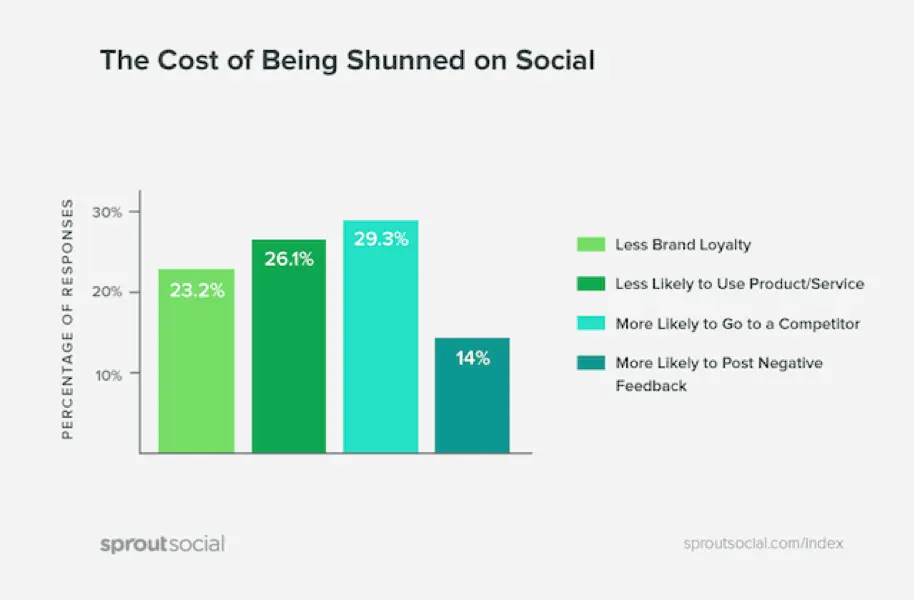
Source: SproutSocial
Beauty brand Glossier features its users on its social channels as a way to build closer bonds with them.
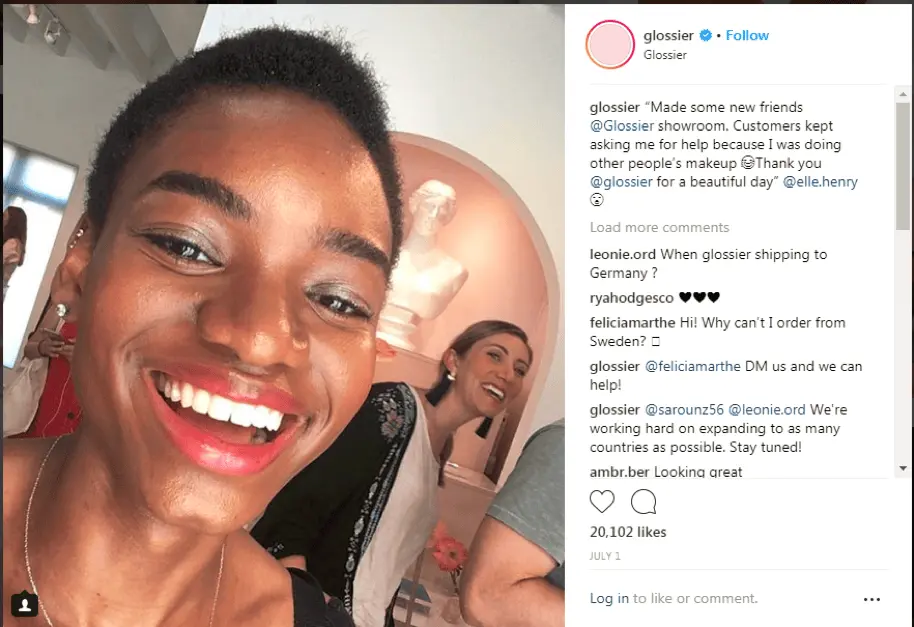
Not only do they share real users using their products (hello, user-generated content!), they also engage each user on a 1:1 basis, bringing their brand into their users’ intimate social circle.
Dig into content management
It’s smart to have a central hub where your content can be found and used quickly. A content marketing platform or management program can help you keep track of the who, what, where, and when of your pieces.
Set up a system where you can create, manage and measure your content all in one place. One bonus to a management system is the ability to keep your content relevant and on-brand through brand templating. Templatized content allows you to lock down brand elements, guaranteeing that brand logos and colors are used properly and not changed willy-nilly. Templatized content also gives you the option of sharing with everyone in your organization, freeing up valuable time for your designers.
As you create your content strategy, you may experience some hiccups along the way, but don’t get discouraged. It’ll take time to get your content and its strategy to where you want it, but each of these steps will build a foundation that you can revisit at any time. And if you need a few ideas on how to create the best content experience for your readers, check out our content experience ebook for more tips.
Securing more sales may seem like the obvious way to increase sales revenue. However, as the old adage insists, more is not always better. Improving sales effectiveness is a frequently overlooked component of creating better sales performance.
While many companies push for more ambitious quotas year after year, Salesforce reports that 57% of sales reps failed to meet the defined metrics consistently. The secret sauce to creating a more productive sales pipeline for your sales team may not lie in pushing for more prospects but increasing sales effectiveness.
What is sales effectiveness?
Sales effectiveness and sales efficiency sound similar, but these two terms encompass different aspects of sales performance. Sales effectiveness is your sales reps’ ability to convert prospects into customers or clients at various stages in the sales funnel. Sales effectiveness metrics can involve several actions your sales team takes during each step of the sales funnel to secure a conversion.
Sales efficiency refers to the speed of those conversions and how quickly they lead to a return on investment. Sales efficiency is often expressed as a factor of the revenue your sales team generates relative to the cost of converting those leads. This is referred to as the sales efficiency ratio and is calculated by taking current-quarter new revenue annualized and divided by prior-quarter sales and marketing expenses. In many cases, decreased sales efficiency metrics signal an issue with your sales process or an opportunity for better sales effectiveness.
Sales effectiveness metrics you should measure
Now that we’ve identified what sales effectiveness means and how to calculate sales efficiency, it’s worthwhile to discuss which sales effectiveness metrics you should measure. Keeping tabs on these metrics will help your sales team monitor progress towards better sales effectiveness and sales enablement.
Focus on revenue insights
Tracking revenue quarterly and annually is a good start, but identifying sales effectiveness requires digging into the details. Demonstrating how much of that revenue comes from new business versus existing customers is critical to evaluating the effectiveness of the sales pipeline. It’s also worthwhile to consider applying the Pareto Principle to focus your sales process. This economic principle has many applications, but in sales it implies that 80% of your revenue should come from 20% of your customers.
Identify what percent of your sales team is meeting quotas
The beauty of this sales effectiveness metric is that no matter where you land on the spectrum, it can tell you something about both your sales quota and your sales team. A high percentage of sales reps meeting the quota could indicate it’s not a motivating milestone. Quotas that simply scoop up low-hanging fruit could leave money on the table in terms of potential revenue. A low percentage of sales reps meeting quotas could mean your goals aren’t realistic and may be contributing to morale problems on your sales team.
Define the win rate
Let’s face it: No sales team closes every deal. But defining how often you win versus how often you lose can be a good benchmark to focus on improvement over time. Some wins and losses are also more crucial than others because they have greater impact on the bottom line, so be careful to take that into account when evaluating win-lose ratios.
7 ways to boost sales effectiveness
Now that you’ve got a handle on how to measure sales effectiveness, let’s take a closer look at ways to improve sales performance and zero in on a better sales process.
1. Set clear goals and KPIs
Make sure to use the principle of SMART goals to set clearly defined sales KPIs for your sales team. Here’s how to shape SMART goals to apply to sales performance and sales effectiveness.
Specific: It’s hard to hit a target if you don’t know what it is. Make sure your sales reps have goals tied to specific benchmarks that are clearly articulated.
Measurable: Define what success looks like by creating goals that can be measured, such as percentage increases in quarterly revenue or improved sales efficiency ratios.
Achievable: Creating achievable goals is a careful balance between striving for something ambitious while still keeping the KPI realistic. Think motivating but manageable.
Relevant: Not all measurable outcomes are relevant to the work your sales reps do, so strive to identify goals that are within your sales team’s sphere of influence.
Time-Bound: Just like projects without deadlines, goals that aren’t tethered to a specific timeframe tend to get put off. Set a reasonable timeline for accomplishment given the scope of the achievement.
2. Invest in sales technology and tools
Modernizing the tools and technology available to your sales team can drive sales enablement and align your sales process. A more efficient process means sales reps spend less time getting prospects through the funnel, resulting in a shorter sales cycle and the kind of increased productivity that can accelerate sales performance.
Some tools that can contribute to sales acceleration through increased sales efficiency include lead databases, automated email services, and content management systems like Lucidpress.
3. Identify bottlenecks and align your sales team
A close inspection of your sales process can turn up redundancies and inefficiencies that produce bottlenecks. Streamline the following daily activities among your marketing and sales team to ensure a well-aligned and efficient process that benefits everyone.
- Prospect outreach
- Customer engagement
- Product/service pitching
- Customer follow-up
- Creating awareness
Even activities that are part of your sales team’s daily routine, such as route planning, can be more efficient with a little collaboration and attention to detail.
4. Perfect your sales process
The sales process is the steps a prospect or lead travels through in the sales funnel to become a customer or client. Learning more about that journey from the customer’s perspective can help your sales team create a blueprint for a better sales process.
Part of perfecting the sales process involves helping sales reps get a handle on who customers are, the problem they’re trying to solve, and why the product or services your sales team offers are the ideal solution. It’s also important to note that the sales process doesn’t end with a sale but should continue through gathering feedback and customer follow-up.
5. Know your audience
Part of sales effectiveness is focusing not on more prospects but on the right prospects. In other words, work smarter not harder. Getting your hands on data to identify the best leads is a good start, but you’ll have to sift through that information to decide who is most likely to convert and what they want to hear.
Start by helping sales teams to clearly define their audience through actionable buyer personas that identify who your ideal customer is, where they’re located, and what their pain points or needs are.
6. Make sales collateral easy to find and customize
When you ask your sales reps how they spend their time, you may be startled to discover they’re usually chasing down product information, drafting email communication, or performing tasks that could be automated.
Using a brand templating solution like Lucidpress not only helps you level up your content creation but can also streamline sales collateral and make it easier to find for both sales and marketing teams.
7. Engage your sales reps with sales coaching and sales training
Many companies have an onboarding process of some sort but don’t take time to build ongoing coaching into their sales training approach. Sales managers that continuously support and engage with sales reps reinforce best practices and keep the sales process efficient and effective.
Investing in sales management and coaching allows sales leaders to stay on top of industry trends and adapt sales approaches to ensure the kind of sales effectiveness that benefits your entire team.
Nonprofit fundraising is the heart of every successful charitable organization. And it’s not just because fundraising is the primary income for most nonprofits. A steady stream of donations and events also raises awareness within the community and keeps donors mission-focused and engaged. In 2020, Americans gave $471 billion to charitable organizations, with an increase among individual donors compensating for a decline in corporate giving.
Fortunately, building a successful nonprofit fundraising machine to leverage that momentum doesn’t need to be a herculean effort. Creating a flurry of social media activity and organizing events can seem exhausting and expensive, but there are ways to generate charitable donations that don’t have to break the bank. The goal of a nonprofit fundraising strategy is to build a donor base that efficiently and consistently equips your army of volunteers with the tools and resources they need to make a difference.
Creating a nonprofit fundraising strategy
The fundraising strategy for some charities seems to amount to little more than picking random fundraising ideas for nonprofit organizations from a hat. To see consistent success, follow these tips to build a nonprofit fundraising strategy that’ll tick all the boxes for potential donors.
Refine your brand story
Your nonprofit organization’s ability to fundraise is directly tied to the enthusiasm and engagement it generates among potential donors. Start by building a compelling, nonprofit brand story and make sure every stakeholder and volunteer can articulate your mission clearly and simply.
Set fundraising goals
Before you design a nonprofit fundraising strategy, it helps to set goals. Think of your fundraising goals as the destination and your fundraising strategy as the roadmap for how to get there. Focus on SMART goals that are specific, measurable, attainable, relevant, and time-based.
Find a fundraising team
Some of your board members, employees, and volunteers are going to be better suited to fundraising efforts than others. Build your fundraising team out with people who are not only passionate about the mission but have a natural affinity for organizing events and feel at home on social media.
Know your donors
In business, knowing your customers can help hone a sales strategy that connects. In the nonprofit world, knowing your donors has similar benefits. Draft a few donor personas based on what you know about the individuals and businesses most likely to support your work. Use these donor personas to direct your outreach and refine your fundraising messaging.
Design a nonprofit fundraising plan
Implementing a careful and thoughtful nonprofit fundraising plan can help organizations raise revenue ethically. Take time to define the tactics you’ll use to fundraise, the methods you’ll provide to receive funds, and what sort of nonprofit marketing you’ll engage in to raise awareness.
Produce consistent, on-brand messaging
Once you’ve solidified your nonprofit brand story, it should be sprinkled liberally into everything you do, from social media posts to online fundraising and in-person events. Research shows the biggest driver of donations among millennials is a compelling cause, so make sure your nonprofit brand story is front and center.
Build donor trust
Transparency is important to any business, but it’s vital to the health of nonprofits. Your donors need to trust that your organization is investing money in ways that matter. Be transparent about how donations are spent and report back to donors so they can see the outcome of their charitable investment.
Follow up with a thank you
Circling back to donors to express appreciation may seem perfunctory, but it’s an important part of creating rapport and community. Donors who require receipts for tax purposes will appreciate the outreach, but it’s also an opportunity to build in a little donor loyalty. More than 15% of annual revenue came from recurring donations for nonprofit organizations who followed up by offering the option.
Nonprofit fundraising ideas
While there are a lot of ways to raise money for a nonprofit, types of donations fall into two distinct categories: individual donors and corporate giving. The kind of nonprofit fundraising ideas you pursue may depend on what sorts of donations you’re hoping to attract.
It’s also worthwhile to consider diversifying your fundraising so you don’t rely too much on one channel. The goal is to reach donors where they are, whether that’s direct mail, online, or on social media platforms. Here are a few fundraising methods to consider:
- Personal fundraising: Lean into your network and use it to advance a cause you believe in. Friends and family are more likely to give when they have a personal connection to the organization.
- Online donations: From email campaigns to those donate buttons on websites — this is the primary method most nonprofits use to solicit donations.
- Event fundraising: Who doesn’t love a party? Encourage board members and volunteers to host silent auctions, charity galas, and more to solicit donations.
- Direct mail fundraising: Pamphlets and mailers are a great way to grab the attention of donors. In a digital world, it can be refreshing to get mail that isn’t a bill.
- Crowdfunding campaigns: Partner with a crowdfunding platform to promote your nonprofit organization with a specific call to action.
- Social media campaigns: If you want to solicit donations, it helps to go where people hang out, and increasingly, that’s on social media. Allow influencers to do a takeover of your account to amplify campaigns and grow your audience.
- Mobile and text donations: When you make it convenient, you give donors fewer reasons to say no. Swipe, text, scan and give everyone more ways to give on the go.
Last but not least, consider corporate giving as an opportunity to grow your organization. In 2019, The National Philanthropic Trust estimated corporations donated over 75 billion to charitable organizations. Partnering with businesses not only generates a good chunk of revenue but also grows awareness among employees for your nonprofit. Corporate giving can take many forms, including matching gifts, corporate grants, employee events, and even in-kind donations like supplies, products, or equipment.
More fundraising ideas for a nonprofit organization
Now that we’ve discussed both fundraising strategy and methods, let’s start digging through a treasure chest of practical ideas you can implement to generate revenue. Nonprofits have faced some significant challenges recently in soliciting donations due to the pandemic, so we’ll divide and conquer with both in-person and online events designed to engage donors.
In-person nonprofit fundraising ideas
Turn these events and thoughtful activities into a windfall of donations for your charity or nonprofit organization. The community goodwill you build is just a bonus.
Get active
- 5K walk, run, or skate
Run laps around other nonprofits with a 5K fundraiser that earns money through entry fees, sponsors, and teams competing to solicit donations. You can even spice it up with relays, roller skates, or themed races complete with costumes. - Bowl-a-thon or dance-a-thon
You won’t strike out with events that encourage all ages and abilities. Ask participants to secure pledges and use the event to promote additional fundraising opportunities. Northwestern University earned more than half a million during their annual dance-a-thon in 2021. - Golf tournament
Take a swing at throwing a golf tournament complete with corporate sponsors. In addition to the main event, you can create mini-courses, hold skills workshops, and sell nonprofit branded merchandise. - Football, dodgeball, or basketball tournament
If golf falls flat, you might score with a basketball or football tournament or even a dodgeball showdown. If you can’t snag a local celebrity athlete or a dunk contest, you can still have fun with flag football, dribble contests, and free-throw standoffs.
Be creative
- Silent auction
This is a popular charity standby for a reason. Getting local businesses to donate products or other loot and then soliciting bids is an easy way to make a little extra revenue. Think outside the basket with weekend getaways, classes, and tickets to seasonal events. - Talent show
Encourage the community to strut their stuff and earn some donations into the bargain. This can be fairly low-key with some local musicians or a more industrious endeavor complete with a battle of the bands. Talent shows are also easy to turn virtual. A high school sophomore recently earned $5,000 for charity with her virtual talent show. - Art or fashion show and auction
The beauty of events like these isn’t just in the eye of the beholder. In addition to generating revenue through ticketed sales to attend the show, you can hold an auction and ask local artists or clothing boutiques to donate their entries to the highest bidder.
Offer a taste
- Bake sale
Nobody turns down cupcakes. Call down the phone tree and get everyone involved in contributing to raise some serious cash for charity. You can even have chefs from local eateries judge the goods and hand out awards for best in each category. - Master chef competition
Partner with a few local chefs and get this competition cooking for charity. You can focus on challenging ingredients or have themed cooking competitions such as BBQ showdowns or even brewmaster contests.
Game it up
- Board game tournament
Gaming nerds assemble — it’s finally your turn. This charity event can be held with prizes for different age groups and a slew of different kinds of games, including cooperative or role-playing games. - Casino night
Gambling-themed fundraisers are so much fun your donors won’t even mind losing to the house. Go full Vegas with roulette, blackjack, or poker and encourage everyone to wear their high-roller outfit. Just be careful to consult local laws about gambling before you roll the dice on this idea.
Build community
- Yard sale or clothing drive
Yard sales and clothing drives pull double duty as a public service by encouraging everyone to clean out their closet. All you need is a parking lot, a little organization, and a small army of volunteers willing to gather, sort, and price. - Movie night
Host community cinema in the park for charity. Sell tickets to screen a popular movie and get local specialty shops to provide some samples as snacks or sell your own treats for a profit.
Online nonprofit fundraising ideas
While you can take most in-person nonprofit fundraising ideas and turn them into virtual events, here are a few tried-and-true solutions for opening donor’s pocketbooks online.
- T-shirt or product design contest
Solicit designs for a t-shirt or other apparel or gear for your nonprofit and then sell the winning design on various merchandise. This does double duty as a built-in advertising opportunity for your organization. - Product fundraisers
Every school has tried its hand at product fundraisers because they work. Whether the community buys gourmet popcorn, cookies, magazines, or gift cards, you’ll get a cut of the profits. - Virtual classes
Turn talents among your board members or volunteers into a serious revenue stream. Offer ballroom dancing, yoga, or even coding. You can pre-tape like Masterclass does or offer a live session for the fundraiser via virtual signups. - Video game tournament
It’s called esports now, and everybody’s doing it. Try your hand at an online gaming tournament either using a common console like Playstation or a popular game like Among Us or even Minecraft. - Online raffles
Giveaways are often part of an in-person event, but online raffles work too. Contact businesses and solicit donations, then capture pics of the goods and post them online. When it’s time for the giveaway, you can stream it live on your social media channels. - Trivia nights
Fortunately, you don’t have to contact some seedy dive bar to host one of these fundraisers. Throw a trivia contest and level up the competition by making sure the questions align with your mission.
This deep dive into nonprofit fundraising ideas proves that raising money for charity doesn’t have to be a chore. Whether you hold in-person or online events or some combination of both, make sure your organization is registered as a nonprofit and follows guidelines for soliciting donations.
Qualifying a lead is a multi-step process, and on average, it takes a minimum of six to eight touches. During this time, sales reps evaluate a prospect across four important aspects: budget, authority, need and timeframe (BANT). A prospect who checks all these vital criteria is deemed worthy of persuasion.
Related: 7 types of sales collateral that convert
And this is merely the beginning of the sales process. Once a lead has been qualified, they move through four stages of engagement before being converted into paying customers. These stages are popularly called AIDA: awareness, interest, decision and action. There’s also a fifth step (satisfaction) which happens after the transaction is complete.
Creating awareness, generating interest and building a desire to buy does not come easy. To build a successful sales team, it’s important to not only train your sales team but also equip them with sales enablement content that can trigger the right response from a lead. [![]() ]
]
Identify the assets required
The first step in the process of creating sales enablement content is building a requirements sheet. Salespeople require a unique list of assets at each stage of the sales process. For instance, assets presented during the Awareness stage would mostly deal with information about your business, the founders, investors, products and services, and so on. In the Interest stage, assets mostly deal with product demonstrations. Decision is generated through testimonials and peer reviews that validate your legitimacy and remove any hurdles that prevent your lead from converting.
Types of sales enablement content to consider:
- Explainer videos
- Ebooks
- Webinar recordings
- One-pagers
- Product demos
- White papers
- Case studies
- Customer testimonials
- Blog articles
Once you identify the objectives of each of the different stages of the sales process, building assets to fit your agenda becomes easy.
Create sales enablement content assets
The success of the content creation process is determined by how engaged your customers are during sales outreach. A tool like Lucidpress streamlines the creation of various content assets — like brochures, sales proposals and case studies — with consistent branding. You might also create interactive content like videos and slideshows that are proven to offer high engagement and message retention among viewers.
The question, however, is what kind of content you must create to build better engagement for your brand. Here are a few tips to take note of.
Sales and content marketing need to work together on sales enablement
Sales enablement is a joint effort between the sales and marketing teams. To create the most effective content, marketing needs to be in tune with sales and understand what types of collateral they need most.
Getting together on a regular basis (may we suggest a monthly sync?) to chat about aligning goals will ensure that sales is clear about what they need and that they’re not missing out on any content that’s already available and could be useful for their prospects.
Measure client dropout rate
In any sales process, only a small fraction of the qualified leads you reach out to eventually become paying customers. The rest of the leads drop out at various stages of sales. Identify the dropout rate at each stage of the sales process. The stage where the most clients choose to part ways is the one where your content needs more attention.
You don’t have to use your existing sales enablement content as a benchmark if you don’t want to. In fact, it’s fine to start from scratch to build new content. Hold an internal meeting with all stakeholders (sales, marketing, and product managers) to build a list of features and ideas that could deliver maximum value. This brainstorming session could also include benchmarking your content against the competition’s. This will give your team a good idea of what’s missing and how your content could be made more engaging for prospective customers.
Build a sales enablement content library
The next step is to translate the ideas from your team meetings into actual assets. It’s worth remembering that too much information can clutter your sales deck, so new assets should be organized into a content library instead.
If you plan to use content management or knowledge management tools to handle this, make sure you pick a service that features a “learning path” or curriculum. This will help you organize your content into distinct folders for every stage of the sales cycle, which can be handy during the testing process. As we’ll see in the next steps, it’s vital to experiment with various combinations of content assets and compare the conversion rates.
Make content customizable
If you need to really make the most of your sales enablement content — and who doesn’t? — you’d do well to invest your energy in making templates. Templated content allows anyone to create a customized piece of collateral to meet their specific prospect’s needs.
Instead of a sales rep making a content request from the creative team, they’d simply pull from a library of sales enablement templates that had been designed for this purpose. They’d find a template for a brochure, or whatever piece they need, and then fill in customizable text and image fields to make it personalized for their prospect.
Templated design saves both the sales and marketing teams time, and it can make sure content is as targeted and effective as possible.
Multivariate testing
The next step is to test the effectiveness of your content assets on the conversion rate. The ideal way to do this is to build a handful of different content assets that could be pitched to clients in the same stage of the sales process. For instance, one deck could focus on charts and graphs, while another could use videos and interactive graphics to sell the product.
Make sure that every sales rep pitches at least one client with each of the various assets. Have the performance metrics of the original deck in hand before carrying out this experiment.
At the end of this stage, build an aggregated report of how each of your content assets performed and how they all compare against the original deck.
Secondary multivariate testing
Once you’ve identified the content that performs best from among those tested, the next step is to experiment with more assets of the same kind. For instance, if videos and interactive graphics worked best, then you could work on creating new decks that feature such content. The idea is to find the sweet spot that maximizes engagement and conversion. Once you have a handful of different assets ready, experiment one more time with a new bunch of leads to find the highest performing content deck.
Rinse and repeat
Creating highly engaging sales enablement content is a never-ending process. Once the best performing deck has been identified, the next step would be to look at other stages of the sales cycle where dropout rates are high and repeating the process. Doing this for each of the sales stages will help build a content library that converts higher than ever before.
Learn how you can lead your organization to creating an effective sales enablement program with consistent storytelling across your sales org.
Patient engagement is touted in both healthcare marketing plans and clinical settings as a strategy to produce better health outcomes and, ultimately, a better patient experience. But a close inspection of the intersection of marketing strategies and patient engagement shows that in many healthcare settings, the effort to become patient-centric has not produced effective patient engagement.
Let’s take a closer look at what patient engagement means, why it matters, and how to create patient engagement strategies that connect to better outcomes, reduced costs, and more fulfilling experiences for both patients and clinicians.
What is patient engagement?
Patient engagement is defined as a patient actively engaged in their own healthcare decision-making. At its best, patient engagement is a partnership between patients and clinicians in which they share information, foster healthy behaviors, and craft treatment plans to manage conditions and produce desired health outcomes.
Patient engagement should not be confused with patient satisfaction. While engaging patients in their own care may lead to better satisfaction with the patient experience, the two terms are not interchangeable.
Why patient engagement strategies in healthcare matter
Studies have consistently shown that patients who are actively engaged in the management of their own care and treatment plans achieve better health outcomes. Patients benefit from responsive providers who are willing to engage in the kinds of ongoing dialogues that foster trust and transparency in the healthcare decision-making process.
This kind of relationship-building and communication can be hard to come by in clinical settings for a variety of reasons. In a 2017 survey, 555 healthcare leaders and clinicians cited an inability of the healthcare team to invest time as the largest obstacle to integrating patient engagement strategies into care delivery plans.
5 tips for fostering patient engagement in healthcare
Helping patients become more involved in their own care reaps benefits for everyone involved, including healthcare professionals. Here are five ways to foster patient engagement throughout the patient journey.
Educate patients for better health outcomes
Educating patients can take many forms and extend far beyond the traditional pamphlets providers send home after a visit to the clinic. Consider expanding patient education initiatives to include more detailed information about prescriptions and dosages, newsletters on healthy habits, and reminders regarding overdue preventative screenings and tests. Studies have also shown that accessible communication is the key to successful engagement, so avoid medical jargon in patient educational materials.
Invest in the relationship between clinicians and patients
A 2019 study found that other than a scheduled visit, 70% of respondents had not heard from their primary care provider in the last two years. It’s difficult to build a relationship or foster trust without communication, and healthcare settings are no exception. Clinicians need to be aware that patients may hesitate to reach out for fear of seeming troublesome or difficult, so checking in periodically can reassure patients and help concerns surface.
Better patient engagement is about empowering the patient experience
It can be easy to get patient engagement and the patient experience confused. In fact, the two are closely related. Empowering patients to make their own decisions throughout the healthcare journey can have a profound impact on the patient experience. Every step in the journey, from making an appointment to following up on aftercare, is a chance for a clinician and the rest of the healthcare team to provide the best possible resources and encourage patients. After all, every patient is a critical stakeholder invested in their own health outcomes. As stakeholders, patients should be kept fully informed about their healthcare “investment” and given every chance to help it be successful.
Personalize healthcare experiences with custom content
Encouraging patient engagement can come off as formulaic. Often patients may just take that aftercare or at-home treatment pamphlet they’ve seen five times before and toss it in the trash. That’s why healthcare marketing materials and patient education digital assets need to focus on effective, customizable content. Forms that can be personalized to include notes from the appointment, information about integrating treatment into a busy lifestyle, or advice about overlapping conditions create personalized content that won’t end up in the dustbin.
Use technology and telehealth tools to drive patient engagement
Patients and providers have more tools than ever to connect and communicate. Electronic health records, telehealth tools, and patient billing portals allow patients to coordinate their own care. By encouraging patients to leverage the online tools and technology at their disposal, health professionals can foster greater levels of engagement. Multiple studies confirm the ability to coordinate treatment between healthcare teams remotely and the use of telemedicine tools to monitor outcomes can have far-reaching benefits for both patients and clinicians.
Fundraising is often the primary focus of a nonprofit organization, and for good reason. Donors empower your mission and enable volunteers to do meaningful work. And the secret sauce to keeping those financial gifts coming is not only to recruit new donors but also to incentivize donor retention. This is why drafting a thank you letter to donors that makes them feel appreciated can become a cornerstone of your nonprofit organization’s fundraising strategy.
Why it’s important to write a thank you letter to donors
While you may have your hands full managing a nonprofit marketing strategy or a social media campaign blitz, it’s critical not to overlook the simple things. Small gestures of gratitude for your existing donors do more than create connections and foster a sense of community. The best donor thank you letters allow your nonprofit organization to demonstrate proof of your impact and serve as a springboard for recruiting new donors.
How to write a donor thank you letter
Donor thank you letters may sound intuitive, but there’s an art to producing and sending these missives of gratitude. Research has shown that senders of thank you letters often underestimate the positivity their gratitude generates, so investing a little time to get these notes right pays dividends. Here are a few tips for writing a thank you letter to donors that’ll impress.
1. Practice genuine gratitude
This may sound obvious, but saying thank you without an ulterior motive is paramount. Don’t try to tack on another ask or use the opportunity to amplify your current fundraising campaign. Find a way to express your gratitude with language that is heartfelt but avoid producing formulaic messages that feel trite. Crafting a tone that feels professional but not perfunctory takes time, so sketch out a few drafts until you get it right.
2. Demonstrate impact
The simplest way to frame nonprofit fundraising is that donations are investments donors make in your mission. Demonstrating the value those donations provide gives proof their money is being invested wisely. When demonstrating impact in a thank you letter to a donor, it’s best to be specific and connect the donation to real-world examples. Flashing stats that reflect progress towards a goal is great, but putting a face on the work being done also helps humanize your organization’s efforts.
3. Be personal
Keeping the language vague might allow mass production of donor thank you letters, but you’ll lose the ability to connect on a personal level. Instead, include names whenever possible and make sure your donor thank letter is signed by a real person within your organization. If it’s feasible, handwritten thank you notes are an especially nice touch.
4. Timeliness matters
Sending a thank you letter to a donor months after the initial gift guarantees your gratitude will get lost in the noise of daily life. Aim for sending your thanks within 1-2 days of the actual donation, especially if you’re sending a note via snail mail. If you plan to send a thank you email, take steps to craft the subject line to ensure it doesn’t get caught in a spam filter.
5. Recognize both repeat and first-time donors
Taking the time to shout out a first-time donor or recognize a loyal, consistent supporter helps your thank you letter to a donor feel both relevant and personal. Just a few flourishes that reflect upon the excitement of getting involved with something meaningful or a track record of generous gifts shows the kind of attention to detail that is a credit to your nonprofit organization.
6. Keep it short and simple
Once you’ve incorporated the above advice into your donor thank you letters, take a moment to edit your work for grammar, punctuation, and brevity. You want to strike the right balance of thoughtfulness without veering into a rambling thank you letter that encourages skimming. It may help to stick to a template like the ones available from Lucidpress to keep your formatting and length consistent.
Examples of the best donor thank you letters
Tips are tremendously helpful, but there’s nothing like seeing guidance in action. Gathered below are examples of the best donor thank you letters that exemplify both authentic gratitude and effective nonprofit fundraising at work.
Get specific about the impact of the donor’s gift
If you want to see the gold standard of effective nonprofit marketing, Charity: water is it. Its mission to provide safe, clean drinking water to every person on the planet is funded by millions of donor dollars that power water projects around the world. Below you’ll see a thank you letter to donors filled with details about the current project in Rwanda, including specifics about what is being funded, how many donors it took to reach the goal, and the number of people directly impacted by the project.

Focus on donor retention by sending a personalized packet
The best donor thank you letters are also opportunities to inform and connect people with your work. This example of a thank you packet from Great Rivers Environmental Law Center includes their current newsletter, a typed letter with details about how the donation will be used, a receipt for tax purposes, and a handwritten thank you note. You’ll notice the letter specifically calls out that this donation was a first-time gift and comes straight from the desk of the president of the nonprofit organization.

Sending a donor thank you video puts a face to fundraising efforts
If letters and emails seem a little old school for your tastes, try making a video thank you letter to donors. All it takes to produce passable video content these days is a decent quality smartphone camera and a steady hand. Susan G. Komen, one of the premier breast cancer fundraising organizations in the world, did exactly that by asking one of the leaders in their organization to put a face to a personalized video message. If you’re not comfortable with video, try to at least incorporate visuals into your thank you letters to donors that speak to the work you do or the people it benefits.
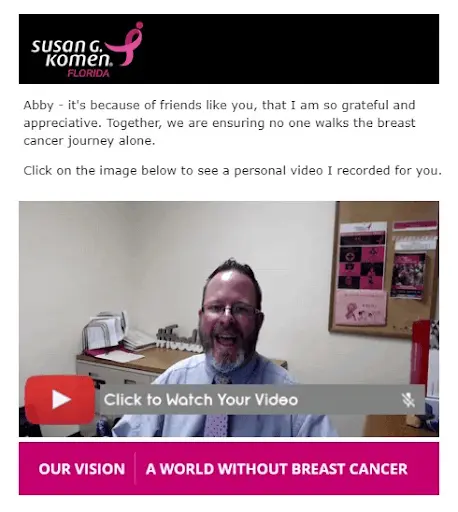
Social media donor spotlights demonstrate the value of your nonprofit organization’s mission
Donor shoutouts on social media require careful planning, but they can pay off by helping you reach new audiences. Spotlights like the example below from Kramden Institute can live on either your social media timeline or website and serve as a way to highlight the contributions of donors. Of course, you’ll need donor consent to produce this content and the ability to create professional photos to showcase on your social channels. But the payoff of putting a face to your community of support is that it can encourage others to become part of the work you do.

Take these examples to heart and produce a thank you letter to donors that compliments your fundraising approach and cultivates a mindset of gratitude. You’ll discover that your nonprofit organization will reap the benefits with increased donor retention and a culture of positivity that gives back to both your organization and the community.
Learn more about the best donor thank you letters and how to amplify your mission with our free nonprofit messaging guide.
Sales operations play a vital role in the efficiency and effectiveness of modern sales teams. More organizations are increasingly realizing the advantages of having a dedicated sales ops team. The most recent LinkedIn State of Sales Operations Report indicated sales operations roles increased 38% between 2018 and 2020, about 4.8 times faster than opportunities for sales positions overall.
Let’s take a closer look at sales ops and answer questions about what is sales operations and how you can turn your organization into a sales and operations planning powerhouse.
What is sales operations?
Sales operations is quite simply managing the operations of the sales team. But the scope of what is sales operations and what is sales enablement can be different in every organization. Sales operations roles are usually defined by using analytics and data to drive sales and operations planning.
If you’re still unsure of sales operations is, think of it this way. Your sales teams are the reps on the front lines engaging directly with customers, while the sales enablement team works behind the scenes to ensure the sales process runs smoothly. Because sales teams and sales enablement are in the trenches, the sales operations team needs to have a bird’s eye view of the entire process and apply data to steer the sales strategy on the ground.
How to build out a sales ops team
Sales operations professionals are the glue that holds sales teams together. Once you’ve defined sales operations and sales enablement, it’s critical to identify sales operations roles. Below are a few suggestions for how to structure sales operations teams and the sales operations roles that are crucial to success.
Sales Operations Specialist and Support
Specialists on the sales ops team work on administrative and technical tasks to keep sales operations and planning moving in the right direction. In essence, they support the day-to-day work of sales reps. Their priorities include lead generation and transactional and contractual support for sales teams.
Sales Operations Analyst
Sales operations are driven by data, but someone has to translate those numbers into reports that can be used for sales operations and planning. Compiling analytics from various platforms, producing reports, and even forecasting sales are some of the primary responsibilities of a sales operations analyst.
Sales Operations Manager or Director
A sales operations manager should be a sales operations professional with a wealth of experience and an in-depth understanding of your organization’s sales process. Their role is to develop strategies and coordinate initiatives based on data-driven insights. Because this role involves cross-functional collaboration, sales operations managers also serve as advocates for the sales team in strategic business planning.
Depending on the organization, sales operations may take on other integral sales and operations planning responsibilities such as defining sales territories, directly managing sales team reps, and facilitating ongoing training for the sales team.
Sales operations best practices
Once you’ve assembled your team, it’s important to sift through a noisy sales process and distill some sales operation best practices. Below are a few tips that can help sales operations teams hit goals and exceed expectations.
Create clearly defined sales operations roles
Take a close look at how your organization defines sales operations roles. Make sure your sales ops team isn’t taking on sales enablement tasks and is focused on sales operations and planning. An easy way to accomplish this is to shift your sales operations team from tasks that create buyer awareness to a focus on more advanced stages of the buying process, such as purchasing.
Set clear and measurable sales ops goals
It’s difficult to develop a roadmap if you don’t know the destination. Everyone on the sales operations team should have clearly defined and measurable goals that pertain not just to sales performance but also to their specific responsibilities. These goals should be documented and refined quarterly or annually to ensure they stay relevant.
Foster collaboration on sales and operations planning
While it’s critical to separate responsibilities of sales enablement from those of sales operations, it’s equally important that neither team works in a silo. An effective sales and operations planning strategy requires alignment to produce maximum impact. From working together on a mission statement to holding regular meetings to collaborate, the sales operations teams should be in close communication with the rest of the sales team and have a firm understanding of pain points and challenges.
4 things to include in your sales operation strategy
A solid sales and operations strategy should reflect the broader goals of your organization. For your sales ops team, this may mean speeding up the sales process, streamlining lead generation, or a multitude of other priorities. Here are a few sales operations strategies that should be spelled out as part of your sales playbook.
1. Sales operations mission statement
Missions statements may seem like performative exercises. Certainly, in some organizations, they end up being little more than an opportunity to sprinkle vague platitudes with buzzwords. However, when mission statements are the result of thoughtful intent and collaboration among your team, they can become a guiding force that shapes sales and operations planning and strategy.
2. Sales ops goals
As part of sales operations best practices, measurable and well-articulated goals are essential. But it’s worthwhile to point out these goals should be a documented component of your sales strategy. Each part of your strategy should have a connection to a specific sales operations goal and a clearly defined approach that demonstrates how the goal will be met.
3. Sales team metrics and measurable KPIs
Sales operations goals should be closely tied to sales team metrics and sales rep KPIs (key performance indicators). It’s easier to keep these KPIs realistic and relevant if they are focused on measurable outputs of productivity and efficiency. Here are a few sales team metrics to consider:
- Sales quota benchmarks
- Win rates
- Sales cycle length
- Selling time
- Lead response time
Once the sales team’s KPIs are specified, then sales operations can identify overarching sales operations goals that will be influenced by those metrics, such as forecasting accuracy or pipeline efficiency.
4. Sales process optimization
One of the core responsibilities of sales operations is to improve pipeline management and optimize the sales process. This can be done in a myriad of ways, from scaling processes to leveraging technology. The tactics being used to improve the sales process should be a documented part of the sales operations strategy. This allows performance to be assessed and the approach to be tweaked to achieve improvement over time.
Sales operations tools you should use
To enable better sales and operations planning, you need the right tools for the job. And while there are a ton of technologies out there that can keep your sales teams informed and efficient, these platforms and software are essentials that should be in your sales operations toolbox.
Sales enablement or CRM platform
If you don’t already have a sales enablement or CRM (customer relationship management) platform, don’t delay getting one. CRM software enables businesses to store customer or prospect contact info, track interaction with sales and customer service, and generate reports. Sales enablement platforms can broaden the scope of a CRM by including marketing and service information to reflect the entire sales lifecycle.
Data analytics software
Most organizations have more data than they know what to do with. Data analytics can help make sense of all that information, but not all data analytics software is created equal. From self-serve analytics like the ones SAS Business Intelligence offers to data visualizations tools like Tableau, the right fit for your company may be a combination of software approaches that best meet your business needs.
Email automation
Most organizations rely heavily on some form of email automation. These technologies may be internal or external or both, but they provide more than an efficient means of communication. Email automation tools allow you to track and assess the effectiveness of communication and to fine-tune your email marketing and sales strategies for better conversions and more effective sales processes.
Sales enablement content management
And last but certainly not least is a platform that allows the organization and storage of up-to-date sales enablement content. This has historically been a huge challenge for sales teams, but solutions like the one Lucidpress offers keep branded, professional sales content just a click away.
Communication tools
In addition to needing tools to communicate with customers, your sales team needs the technology to communicate effectively with one another and the sales operations team. Whatever solution your organization employs, be sure it encourages collaboration and data sharing.
Putting together a sales operations strategy doesn’t have to be a daunting prospect. And the wealth of data-driven insights sales operations professionals bring to the table makes building a sales operations team a solid investment for any organization.
Learn how to create branded sales enablement materials that will help your organization reach sales operations goals with our free e-book.
If you’re trying to figure out how to create an ebook without getting overwhelmed, you’ve come to the right place. While ebooks may take a little extra effort to produce, learning how to create a branded ebook can provide a lot of bang for your marketing buck.
Statista analysis indicates ebooks are still nibbling steadily away at the dominance of print books, with an expected growth of 5% in the coming year. Businesses that have invested in creating their own ebooks discover they are a powerhouse for lead generation, search engine optimization, and establishing brands as thought leaders within an industry.
One of the clear advantages of learning how to write an ebook comes from the in-depth content it provides and the way it establishes your organization as a voice of expertise in the field. Ebooks are also great ways to gain external links and visibility among your competitors, generating buzz and amplifying your brand. And while there may be an investment of resources up front in learning how to make an ebook, they are low-cost to produce and easy to templatize.
How to create an ebook in 10 steps
If learning how to create an ebook is the current project on your plate, you may feel you’ve bitten off more than you can chew. The idea of writing an entire book can be overwhelming no matter the topic, but it’s much easier to tackle with a plan of attack in place. We’ve captured the steps for how to write an ebook below, but if you’re already familiar, you can jump over to our ebook creator and get started.
1. Identify your ebook topic
Chances are, if you’ve already jumped into the deep end of how to make an ebook, you have a topic in mind. But it’s worth exploring a few different ebook ideas to ensure the one you’re leaning into is the best fit for you or your organization.
Part of picking a topic is not only making sure the topic is of interest but that it supports the kind of deep-dive an ebook provides. And if your main goal in learning how to create an ebook is to generate leads, consult with your sales team to make sure the topic you’re writing about will turn up the kinds of leads they’re looking for.
Before you start throwing darts at a list of potential ebook titles, take a moment to identify the type of ebook you want to create. Here are just a few general categories of ebooks to consider.
- Research and surveys: Conducting your own research and sharing your findings can become the basis of an ebook and provides additional value to your readers.
- Case studies: These types of ebooks can be powerful tools for B2B marketing because they show your products or services in action in the real world.
- Interviews: Because a single interview doesn’t provide enough fodder for an ebook, partner with a few industry leaders to create an ebook based on their insights.
- Product demonstration: If you have a complex product or service, learning how to make an ebook that encompasses all aspects of that product is a good place to start.
- How-to guide: Learning how to create an ebook that is a step-by-step guide can take many forms, from stringing together a series of long-form blog posts to using a shorter piece of popular content as a launchpad for a deeper dive.
And for now, don’t worry about the title. Just get lots of input from inside your organization and from customers about what’s of interest to them. Generate a list of potential ebook topics and then pursue those that have the most potential.
2. Outline your ebook
While there are no hard and fast rules about how to create an ebook, usually the structure is similar to that of a novel or a textbook. Many ebooks choose to utilize chapters to organize content, or at the very least sections, that segment the information into subtopics. Outlines usually begin by breaking down your topic and deciding how granular you want to get in each section.
Most ebooks also contain an introduction that frames the topic, supporting images throughout, and a resource section or footnotes. One of the advantages of thinking intentionally about how to write an ebook is that creating an outline allows you to identify quotes to highlight or feature. It can also spark ideas about how to utilize or recycle blog or website content for your ebook.
3. Plan your ebook visuals
Thinking ahead about how to make your ebook doesn’t mean you have to know the exact layout right now. But you should consider what visuals you want to include in which sections. Some images in your ebook may serve to break up text and create a more visually appealing page. Others may specifically complement or enhance the text, such as charts, infographics, and more.
As you outline, consider creating a list of assets you’ll need, from stock photography to graphic design elements. If you do need some charts or infographics, consider if those resources already exist or if you’ll have to create them. Gathering other marketing tools such as a brand style guide can also be helpful so you can choose visuals and other design elements that align with your branding.
4. Draft your ebook
This can be the most intimidating step in the process of how to write an ebook, but at some point, you simply have to sit down and write. Tackle a section at a time and work through your ebook outline point by point. Focus on simple language that conveys your meaning effectively, and try to keep your approach to each section consistent.
If you’ve decided to recycle some content from your blog or website, focus on making sure it aligns with the rest of the ebook both in terms of formatting and tone. Transitions can be especially tricky, so pay attention to how the segways between paragraphs and sections are written. Reusing some phrases or word choices from previous paragraphs can help smooth transitions for readers, but take care not to sound too redundant.
5. Edit your ebook
Editing is an essential piece of how to make an ebook one your customers will want to read. As Ralph Waldo Emerson once said, “Let the reader find that he cannot afford to omit any line of your writing because you have omitted every word that he can spare.” If your first draft was too wordy or rambled, editing is the chance to clean it up and make it concise.
While some writers find they can edit their own work, it’s best to get a second, third, and even fourth opinion. Even if you use editing software such as Grammarly, you’ll discover there is still plenty of room for error that the eye of an experienced editor will catch. Remember to allow some additional time in this step of how to create an ebook so you have the chance to incorporate plenty of feedback.
6. Design your ebook
If you’ve got your content written and visuals identified, now is the time to start bringing those elements together to design your ebook. In this step of the process, Lucidpress ebook templates are your best friend. Look to download one that supports the type of ebook you want to publish, and then start customizing.
One of the crucial parts of ebook design is to focus on readability. Break up long paragraphs into shorter ones that are easier to scan. Create more dynamic pages by featuring pull quotes or statistics as design elements. And remember that graphic design is as much about what isn’t on the page as what is. Strive for a balance of both blocks of text and visuals that won’t overwhelm your reader.
Here are a few other design elements to consider as you create your ebook:
- Make sure font, size, and color for subtitles, header, and body text is consistent
- Keep similar formatting, spacing, and margins throughout
- Maintain consistent spacing between and around visual elements
And last but not least, don’t forget page numbers, and remember to place them in the same spot on each page.
7. Brand your ebook
Once you start customizing an ebook template, you’ll be surprised how quickly it starts to reflect your brand. One of the first places to start is with the color scheme. Identify both a primary palette that is part of your branding and a secondary palette that plays well with those colors. Then begin using your color palette to full effect on each page and in the graphic design elements of your ebook template.
If you’re stuck on how to create an ebook cover, remember there’s a lot of visual real estate in the first few pages. Consider incorporating your logo and other elements of your style guide on the cover, or feature pages of the ebook for maximum impact. As you put final touches to your branding, don’t forget to include contact information for your organization and specific calls to action.
8. Format your ebook
It’s tempting to hang a mission accomplished banner once you’ve gotten to this point, but there are still a few more steps to take in learning how to write an ebook. One of the most important is formatting your ebook. Ideally, you want readers to be able to download it in a file type that will work on whatever device they’re using.
While you probably can’t satisfy everyone, there are a few common ebook file types that’ll cover most of the bases for compatibility, including the following.
- PDF: The most well-known file type, PDF is best for ebooks you’ll read on a computer desktop.
- EPUB: Electronic Publication files are a flexible ebook format that’s helpful for reading on smartphones.
- MOBI: If you want to make sure users with Kindles and other e-readers can read your ebook without issue, MOBI files are the way to go.
- IBA: This file type is proprietary and specifically for Apple Books and is not compatible with other e-readers.
Offering your ebook in a few of these file types will satisfy the majority of potential readers and devices.
9. Publish your ebook
Now that you’ve formatted your ebook, the next step is to publish it. Have your team give your ebook one last lookover, including trying it on different devices. You’ll want to make sure to work out any formatting kinks before the link goes live.
Most of the time, the best way to publish an ebook is to give it a dedicated landing page on your website. This allows you to link directly to it in promotional campaigns and control and track downloads. You’ll also be able to measure analytics such as clicks, time on page, and conversions. Many organizations also choose to gather email addresses or other sales leads as a prerequisite for downloading ebooks.
10. Promote your ebook
You’ve hit publish on your ebook, so you’re done, right? Not so fast. You’ve got one last step to make it a success. Promote your ebook on social media, via email campaigns, in your newsletter, and across as many channels as you can manage.
Go live on Facebook or do an Instagram story announcing the launch of the ebook. Create a blog announcement and email your subscribers to make sure they know the moment it hits. You can even create a pop-up for your website encouraging visitors to download the ebook. Make sure you have a promotional campaign complete with digital assets ready to go when you hit publish so you can maximize the momentum of your ebook launch.
Ebooks may seem like daunting creative endeavors, but like any project, they’re manageable if you stage them a step at a time. Invest in the tools and templates to learn how to create an ebook today and watch your sales and marketing team reap the benefits of those downloads for many tomorrows.
Even if you’re not in the fashion industry, your small business might be the perfect candidate for a lookbook. Lookbooks are just what they sound like: collections of photographs that draw the eye and showcase products in sumptuous detail.
But with the advent of fashion digital lookbooks, your audience can do more than look. This post will show you how to create a lookbook that can be shared anywhere, from your website to your Facebook page. Plus, you’ll be able to boost sales by linking readers directly to a website or online store.
Related: What makes good design & why it matters
How to make a lookbook
- Step 1. Source several quality photographs
- Step 2. Combine photos and design elements
- Step 3. Put your lookbook to work with links and videos
- Step 4. Publish your lookbook and spread the word
What is a lookbook?A lookbook is a compilation of photographs that showcase a designer’s collection. They’re frequently used to market a line of clothing and show how to style the pieces.
Are lookbooks a good fit for my business?
Before we get started, I want to address a question that many of you are asking.
Should I really make a lookbook?
The answer, of course, is yes. Because a lookbook is nothing more than a catalog, or in a broader sense, an advertisement. So if you sell something that people can either touch or experience, lookbooks are a good fit.
People can touch things like apparel and accessories, jewelry, beauty products, baked goods, crafts, pottery ware, tools and furniture. And what people can experience is an even broader category: housekeeping, catering, plays, museum exhibits, festivals and more.
1. Source several quality photographs
It’s critical to have great photos that highlight your product or service. A good rule of thumb is to have at least two photos for each page of the fashion lookbook. This is one area you shouldn’t skimp on—good product photos will serve you well for years to come. So either book a professional photographer or follow these tips on how to capture your own lookbook photos, which I’ve summarized below.
- Choose a clean, neutral backdrop.
- Position the product in good light and clear focus.
- Draw inspiration from style sites like Lookbook.nu, Trendtation, and even Reddit.
- Iron out all the details, from polishing your leather goods to touching up the model’s lipstick.
If your fashion lookbook includes models:
- Make sure their poses look natural.
- Position them so your product is front and center.

2. Combine photos and design elements
Once you have enough images, upload them to Lucidpress. It’s a free service for creating print and digital documents. Just sign up for a free Lucidpress account, click +Document, and choose from a blank canvas or a pre-made template. I recommend choosing from the digital magazine category.
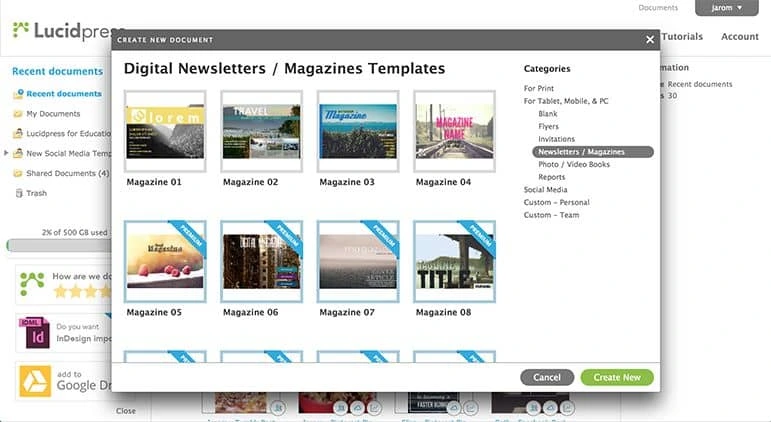
To upload your first image, click the image icon from the left-hand toolbox. You’ll notice that the panel on the right side—the context pane—has all sorts of image editing options. Play around until your photo looks just right.
I’m going to build a lookbook for my (imaginary) bridal shop, so the first image will show off my new dress collection.
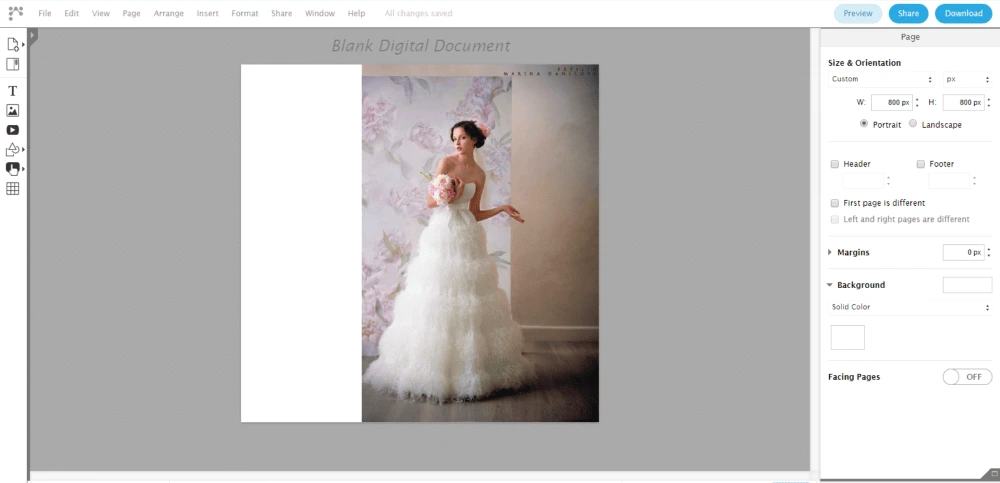
Now it’s time to add design elements. Even if you’re not a professional designer, Lucidpress makes it easy. Just drag and drop shapes from the dock, customize them with the context pane, and add text as the finishing touch.
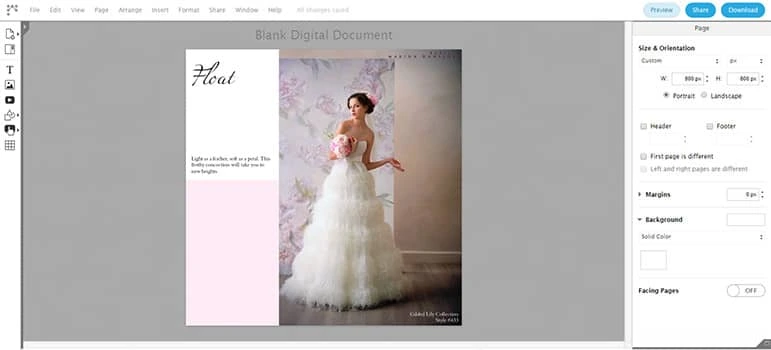
To add more pages, click Add Page from the dock.
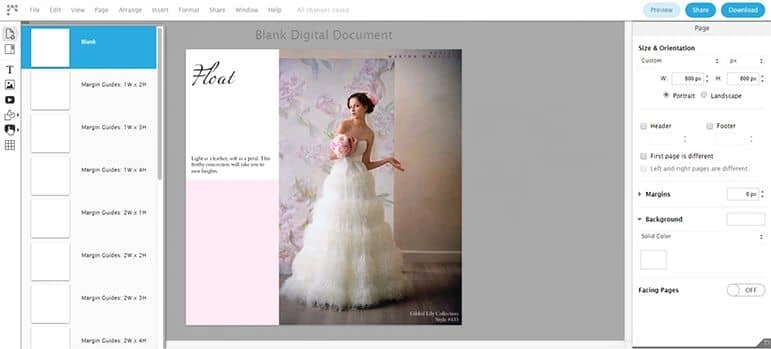
Remember, no need to add flashy design elements—the photos will speak for themselves. With a few geometric elements and carefully chosen fonts, this lookbook manages to set an elegant mood. Click Preview at any time to see the lookbook through your customers’ eyes.
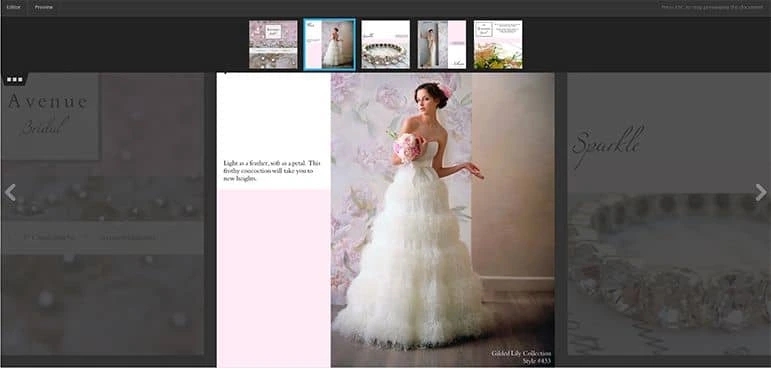
3. Put your lookbook to work with links and videos
It’s important to capture leads as soon as your viewers are intrigued, so be sure to add relevant URLs. For example:
- This lookbook includes a call to action that prompts readers to schedule a free consultation.
- I’ve made every product photo clickable, so readers are directed to that exact item in my online store.
- And I’ve added a video that emphasizes our personal service and industry know-how.
Each of these actions boosts engagement and increases the likelihood that lookbook readers will become customers.
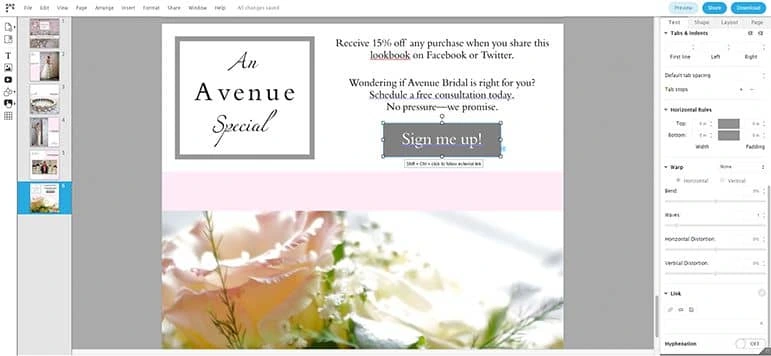
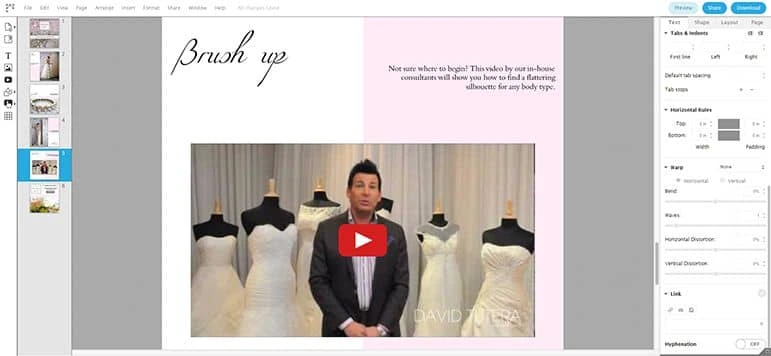
4. Publish your lookbook and spread the word
To publish the finished product to the internet, click Share, then choose On the web. Make sure you check the box that allows you to include social sharing icons. This makes it easy for viewers to share your lookbook with all of their followers. If you haven’t titled the lookbook yet, you’ll be prompted to name it now. Choose a title that will capture your audience’s attention and persuade them to click.
This option will create a digital presentation of your lookbook, accessible through a URL link.
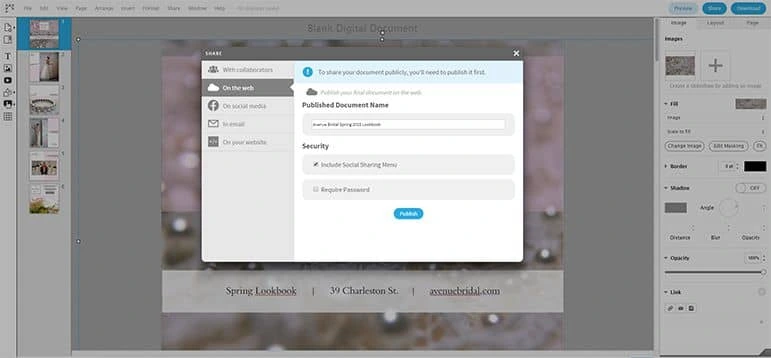
Are you looking for more publishing options? You’re in luck!
- Download > PDF will create a PDF with searchable text, which might be important for your viewers or for your SEO efforts.
- Download > PNG (or JPG) will generate static images, which are great for sharing on Pinterest. You can even link the image to your digital lookbook (instructions above).
- Share > With Collaborators will enable others to edit your draft. Don’t worry—you decide who’s invited and what they’re allowed to do.
- Share > In Email will give you code to insert in your email client. When you send the email, a clickable thumbnail is displayed.
- Share > On Your Website also gives you a snippet of code. Add it to your website and an embedded version of the lookbook pops up. See below for an example.
And there you have it: a stunning digital lookbook that can be shared anywhere, any time. We’d love to hear how you use lookbooks for your brand—share in the comments.
Create your own digital lookbook today with a free template in Lucidpress.
Lookbook examples for your inspiration
Looking for the perfect inspiration for your lookbook? Check out the gorgeous examples below. Want to use one as a template? Simply click on the link beneath the viewer.
Boutique lookbook
The product is the star in this lookbook example with full-page images and small sections of supporting copy. The letter from the owner personalizes the lookbook, and the images are a mix of style combinations, product closeups and glimpses of the boutique itself.
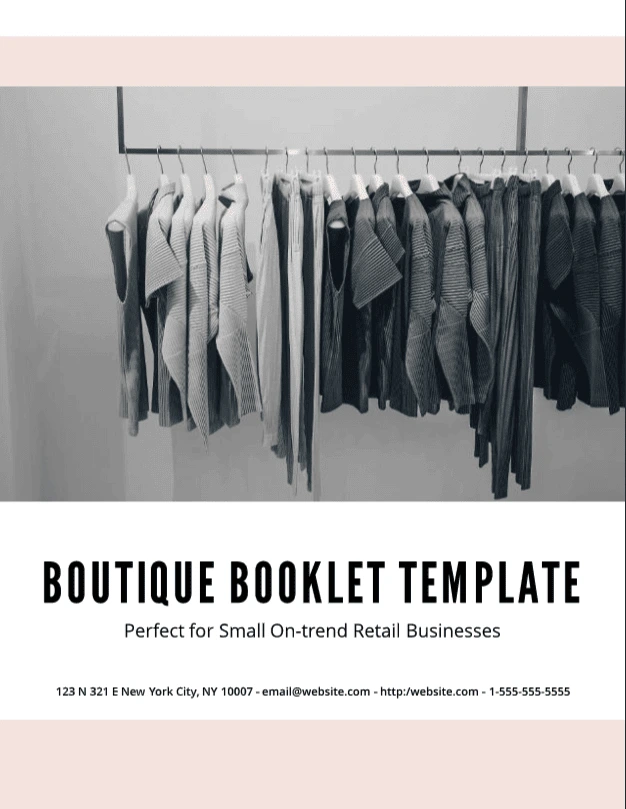
Modern portfolio lookbook
This lookbook is a great example of an interior design lookbook. Stunning photography captures the possibilities of what a home or office could look like. The portrait of the owner helps connect the reader to the owner and build trust. A brief listing of services and pricing at the end provides a nice call to action for the reader.

Slate graphic portfolio template
Photography lookbook
A lookbook is a great way to curate and display samples of your photography. This lookbook captures the essence of the photographer’s style beautifully with photo collages, simple color hues and a modern font. By combining human faces with still objects the photographer showcases their diverse skill set.
Femme fatale portfolio template